



ISSUE NO. 19 FALL 2022


2 spark
Issue No. 19

Lasting forever, never to be forgotten; immortal.

editor in chief kai-lin wei managing editor walter naranjo
design director juleanna culilap
layout director jaycee jamison assistant design director charlotte rovelli assistant design director melanie huynh digital director maddie abdalla
creative director alex cao assistant creative director laurence nguyen-thai
director of hmu yeonsoo jung assistant director of hmu lily cartagena assistant director of hmu meryl jiang
modeling director maliabo diamba assistant modeling director jillian le assistant modeling director yousuf khan
photography director rachel karls assistant photography director mateo ontiveros
director of styling david garcia assistant director of styling vi cao assistant director of styling miguel anderson
editorial director amelia kushner
senior print editor eliza pillsbury associate print editor kunika trehan associate print editor carolynn solorio assistant print editor ella rous
senior web editor kyra burke associate web editor sonali menon associate web editor ellen daly assistant web editor renata salazar
business director jackie fowler
director of events nereida jimenez assistant director of events sarai lazo social media director elain yao assistant social media director olivia abercrombie marketing director emely romo assistant marketing director brenda chapa
staff
noura abdi, mariana aguirre, amani ahmad, elena ahsan, brandon akinseye, john alvarado, sophia amstalden, shreya ayelasomayajula, rachel bai, ava barrett, bridget beecham, leah blom, lea boal, aaron boehmer, chloe bogen, lara borges, ren breach, emma brey, charlotte brown, ellis brown, jordan busarello, jackie bush, jaedyn butler, leilani cabello, stacey campbell, colin cantwell, via ceaser, katie chang, hayle chen, morgan cheng, camille chuduc, caroline clark, allison clark, grace dahl, audrey dahlkemper, lily davis, ale de la fuente, jessi delfino, jesus del real, kenneth delucca, nysa dharan, wenting du, gabrielle duhon, saturn eclair, seth endsley, annahita escher, alexandra evans, nia franzua, belton gaar, megan gallegos, liz garcia, julia garrett, emma george, emily gift, nico grayson, alisha gupta, shareefa gyami, dylan haefner, jereamy hall, j hayden, lissie hill, stephanie ho, paige hoffer, haley hsu, angel huang, tyson humbert, rhionna jackson, ava jiang, jeffrey jin, kameel karim, sriya katanguru, payson kelley, joanne kim, grace kimball, neha kondaveeti, divya konkimalla, tyler kubecka, vyvy le, justin le, amy lee, sunshine (sunny) leeuwon, ryan levin, luci llano, lauren logan, fernanda lopez, omar lopez, estelle omotayo, chloe low, sophia lowe, juniper luedke, enrique mancha, olivia marbury, evelyn martinez, olivia martinez, emily martinez, giulia mayhua pezo, ada mcclure, safa michigan, amanda miller, noa miller, pebbles moomau, arliz muñoz, miu nakata, theresa nguyen, miles nguyen, maya nguyen, allison nguyen, esha nigudkar, jake otto, bryn palmer, liesel papenhausen, claire philpot, genesis pieri, ainsley plesko, athená polymenis, angel quinn, tarsus rao, anagha rao, reagan richard, joy richardson, stela riera-vales, lily rosenstein, caitlyn ruiz, claire schulter, vani shah, nikki shah, sonia siddiqui, presley simmons, peyton sims, isabel sitar, saejun smith, caroline st. clergy, ellie stephan, victoria sturm, tiffany sun, lianne sung, summer sweeris, amelia tapia, leah teague, rachel thomas, nhi tieu, anh tran, jacob tran, princeton tran, vy truong, claire tsui, olivia tudor, emily wager, averie wang, eileen wang, rhys wilkinson, lorianne willett, melat woldu, megan xie, miranda ye, moises zanabria, isabella zeff, sophie zhang

4 spark
from the editor
This issue is a collection of speculative tomorrows — good ones, bad ones, ones that stir the heart or electrify the mind, and ones beyond our wildest dreams. Some are hellscapes hunting us for retribution, while others are paradises designed to satisfy our every whim and fancy.
In 2022, we occupy a troubled place in history, where amid socio-political upheaval and continued environmental crisis, it can feel like the very soul of the earth is slipping from our grasp. The world is changing. We feel it shifting beneath our feet and hanging heavy in the air, flashing its warning to us.
As staff writer Bridget Beecham writes: “Time is running out. Beauty is running out.” (pg. 186) At the same time, this is an era of unprecedented technological progress. The internet is realer than real life; shiny new things continue to get shinier and newer; our advancement as a species seems to know no bounds.
What does it mean to live in a time where the world as we know it is both dying and being born again? What power do we hold over the future? And what power does the future hold over us? These are the central questions sitting at the heart of Deathless. In this issue, we explore them over the course of three chapters: Man, Spirit, and Machine.
We’ve also made exciting additions to enhance your reading experience, including a series of short films, a companion podcast featuring feature story subject Austin rapper Mama Duke, and the first installment of work by M.E.D., SPARK’s inaugural design technology team spearheaded by Creative Director Alex Cao. All this and more can be found at sparkmagazinetx.com.
We elected to elevate our issue theme this season by designing a conceptual world for our staff to explore, with a sharpened focus on issue cohesion and thematic complexity. We challenged everyone to ideate, create, and execute within the parameters of this world, and I’m proud to say that they’ve risen to the occasion by delivering a body of work that is as whimsical as it is macabre, as cohesive as it is original, and as true to SPARK’s long-standing values of innovation and creativity as it is expectation-defying.
Sincerely,
Kai-Lin Wei Editor In Chief


5 deathless
MAN windows vi naturae a world where no one dreamed terra nullius god’s creations chip to chip, heart to heart love under surveillance love in the time of cybernetica <3 biodebauchery in situ sisyphus attends our exequies.
SPIRIT umbra the sound & the silence exoskeleton shatter the spirit forever & always, willie pearl from the ether d>e>a>t>h>m>e>t>a>l the heart of the poet death doulas & slowburn endings
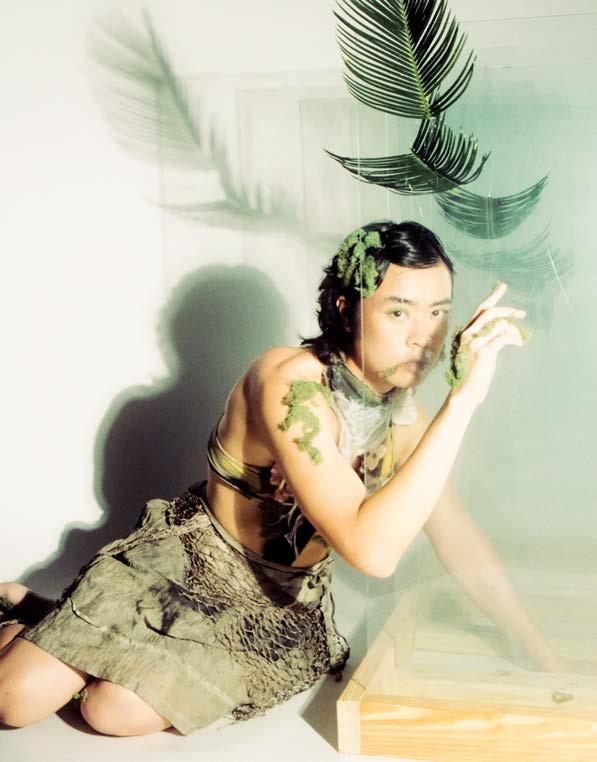

contents
6
10 18 24 34 40 44 50 56 62 68 76 80 90 96 104 114 120 126 132 148 154 spark
issue no.
deathless
MACHINE art by machine subservience the digital playground of a generation through these red eyes cyber cash femme fatality optics the anatomy of the asian cyborg head in the cloud screen share turn-off_the_engine_
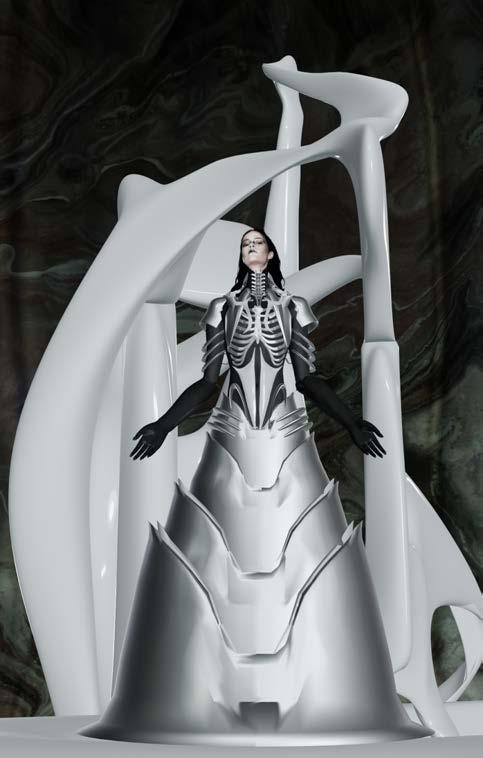
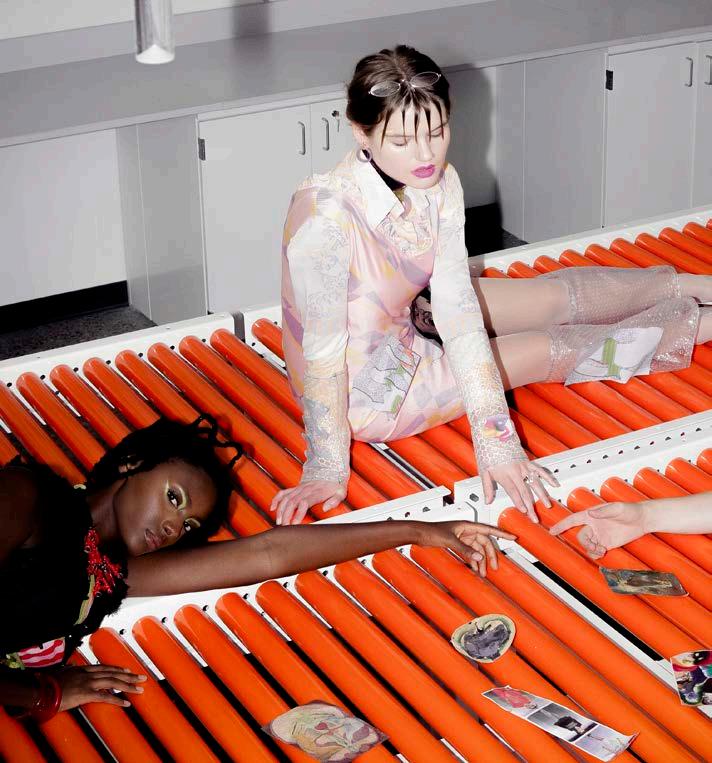
FEATURE mama duke: how did we get here?
M.E.D. biophilia exostosis monolith
spark magazine
19
170 178 186 195 204 210 218 222 230 238 246 140 164 166 168
deathless 7
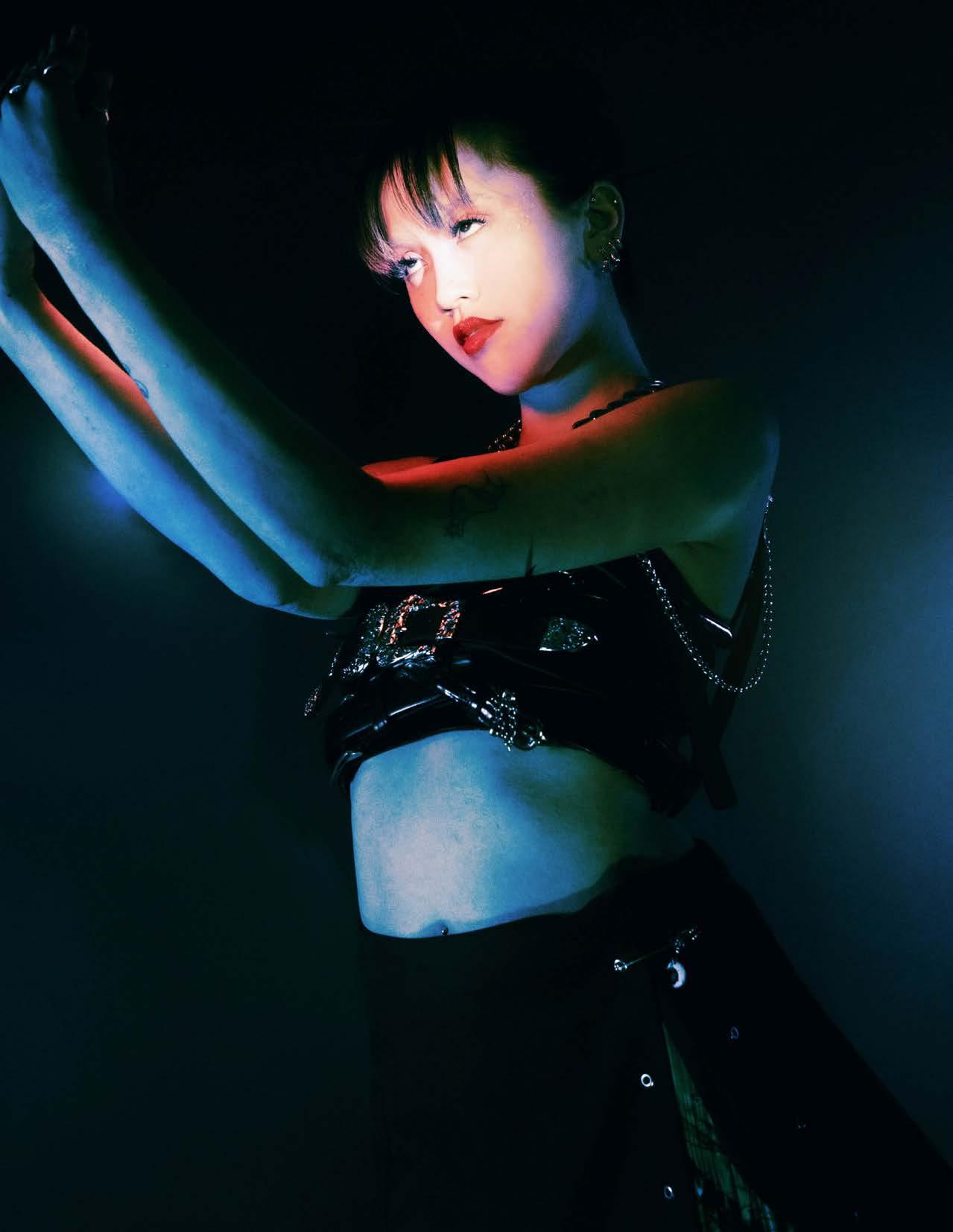
WINDOWS / VI NATURAE / A WORLD WHERE NO ONE DREAMED / TERRA NULLIUS / GOD’S CREATIONS / CHIP TO CHIP, HEART TO HEART / LOVE UNDER SURVEILLANCE / LOVE IN THE TIME OF CYBERNETICA <3 / BIODEBAUCHERY / IN SITU / SISYPHUS ATTENDS OUR EXEQUIES.
I. MAN
Man has creative instinct. In the face of destruction, out of a misplaced fear of the other, we fashion false comforts: religion, philosophy, love. But without this evidence of our existence, out living our fallible form, what makes us human? We forge our own fate — and at our own risk.
9 deathless

spark 10
layout MELANIE HUYNH photographer TYSON HUMBERT stylist SUMMER SWEERIS set designer CAROLINE ST. CLERGY hmua LILY CARTAGENA model LAURENCE NGUYEN-THAI videographer ATHENA POLYMENIS
WINDOWS WINDOWS

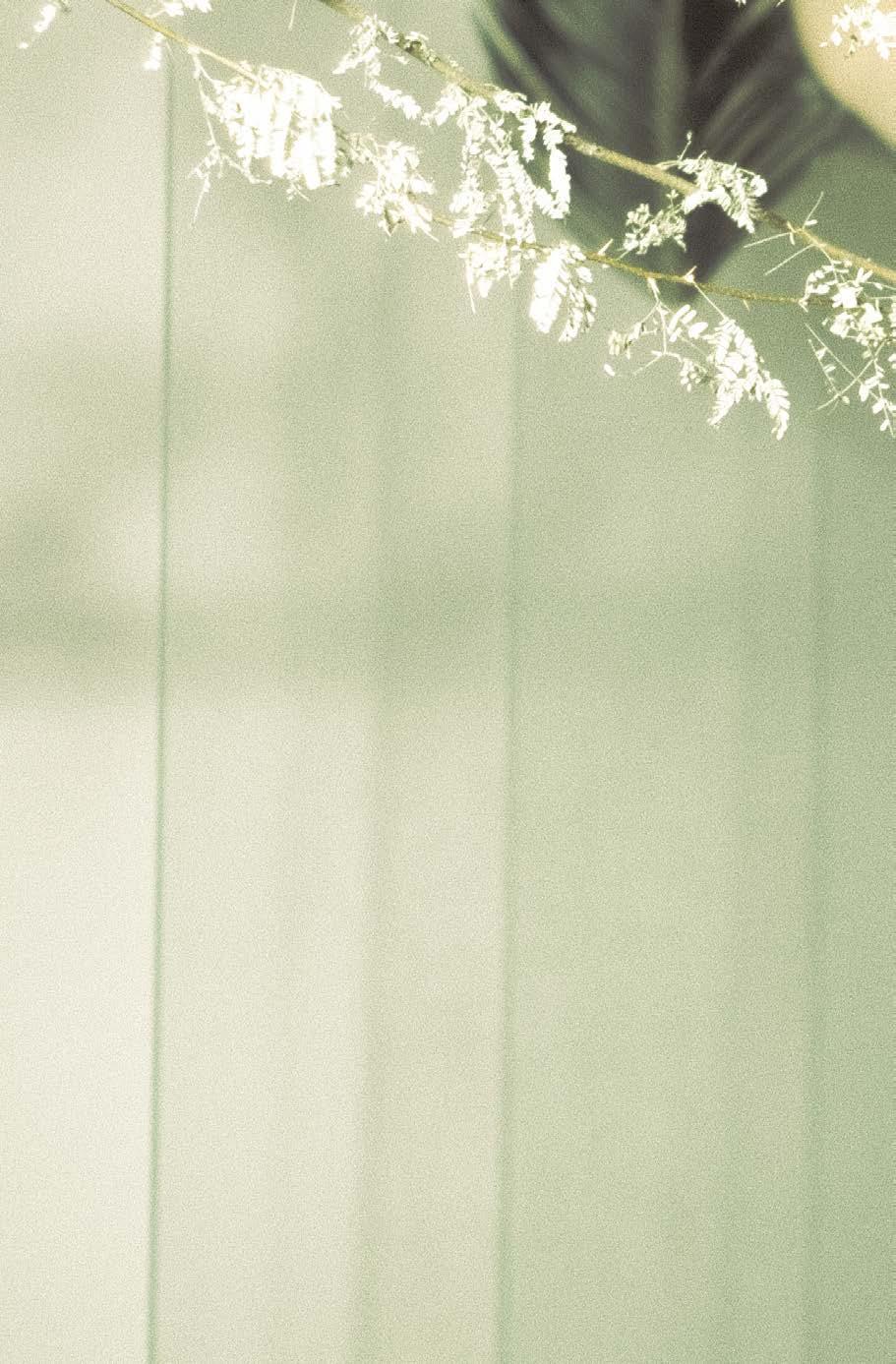 by KATIE CHANG
by KATIE CHANG

AS WE TURN TO DIGITAL NATURE, WHAT HAPPENS TO OUR RELATIONSHIP WITH THE REAL, PHYSICAL THING?
My family never flies.
We’re the road trip type. The camping and eating freeze-dried spaghetti kind of family. We drive for hours and hours on end, and I rotate between scrolling on my phone and staring out the win dow as one version of White Sands blurs into the next, on and on and on. The landscape seems to unfold endlessly — it feels like we’re making no progress.
There are 473k more pictures under #whitesands. I guess we aren’t.
zzz
For about 95% of our species’s existence, we survived as hunter-gatherers, in tune with the natural world. We knew we were at the mercy of nature’s order and calculated our every action ac cordingly. We followed the ebb and flow of the seasons, navigating the land with the intent to survive — just as other species did.


At some point, some luck-of-the-draw combina tion of factors (a shift in environmental patterns, a larger brain, and a big toe, perhaps?) allowed for the development of agriculture, and from there, our relationship with nature changed. It was no longer something we were both a part of and subject to. We could interrupt the natural seed dispersal process to get more wheat! We could fence up a group of pigs to have readily available meat! Nature became something to dominate, something to control to fulfill our needs.
As mud villages turned into concrete cities and human labor turned into mechanization, the same regard for nature that enabled our mastery of agriculture sowed the seeds of capitalism. Our wheat dispersal hack is now a billion-dollar fertil izer industry. Our pig pen is a trillion-dollar meat market. From the comfort of our leather desk chairs in our glass high-rises, we’ve cemented our role as nature’s puppeteer, and in doing so, we’ve sucked the life out of Earth’s soil and ripped apart its atmosphere.
Yet, somewhere deep within our psyche, we know we’re missing something. Somewhere not yet poisoned by the gospel of economic growth, our primordial affiliation with nature survives.
12 spark
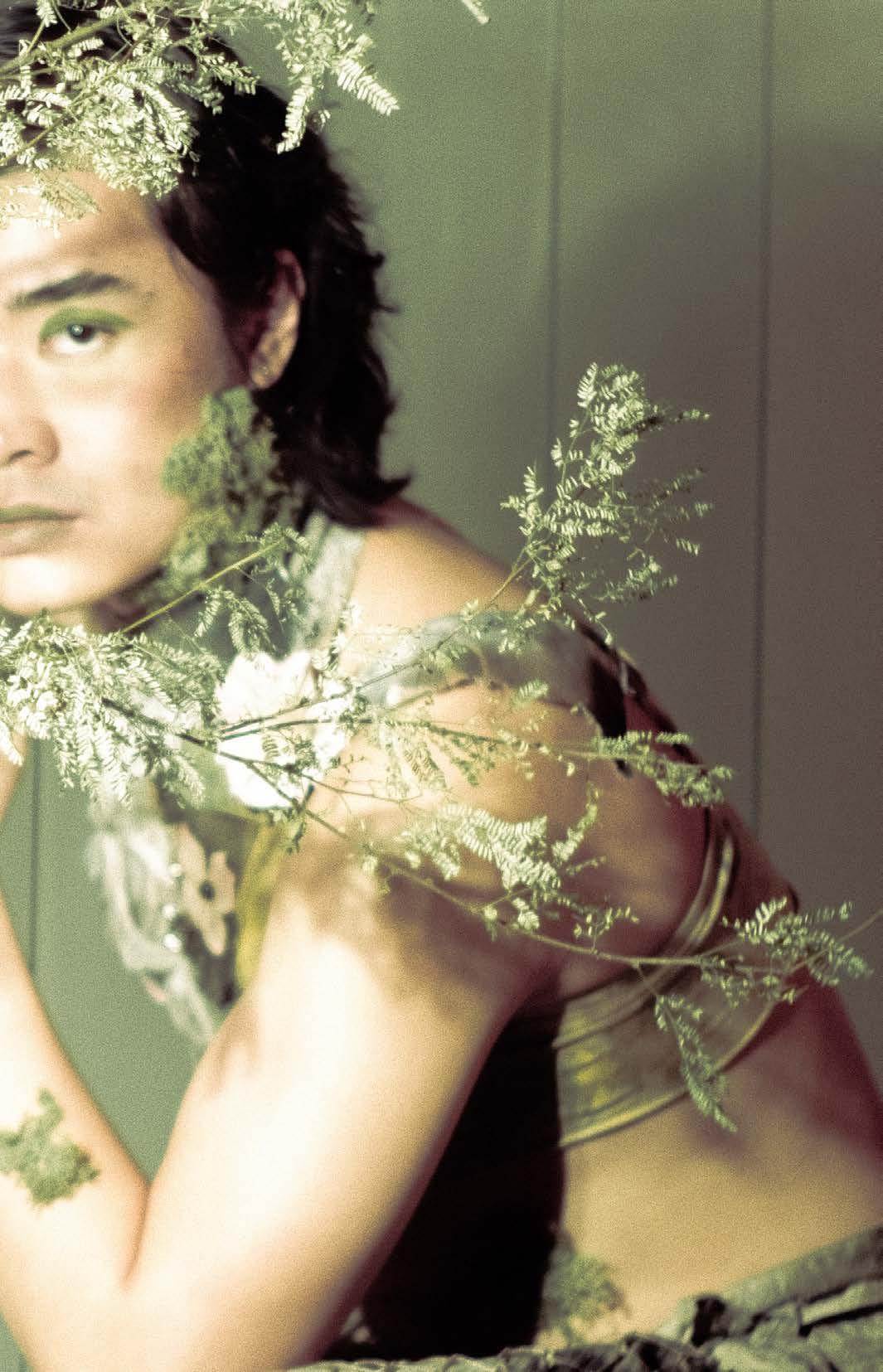
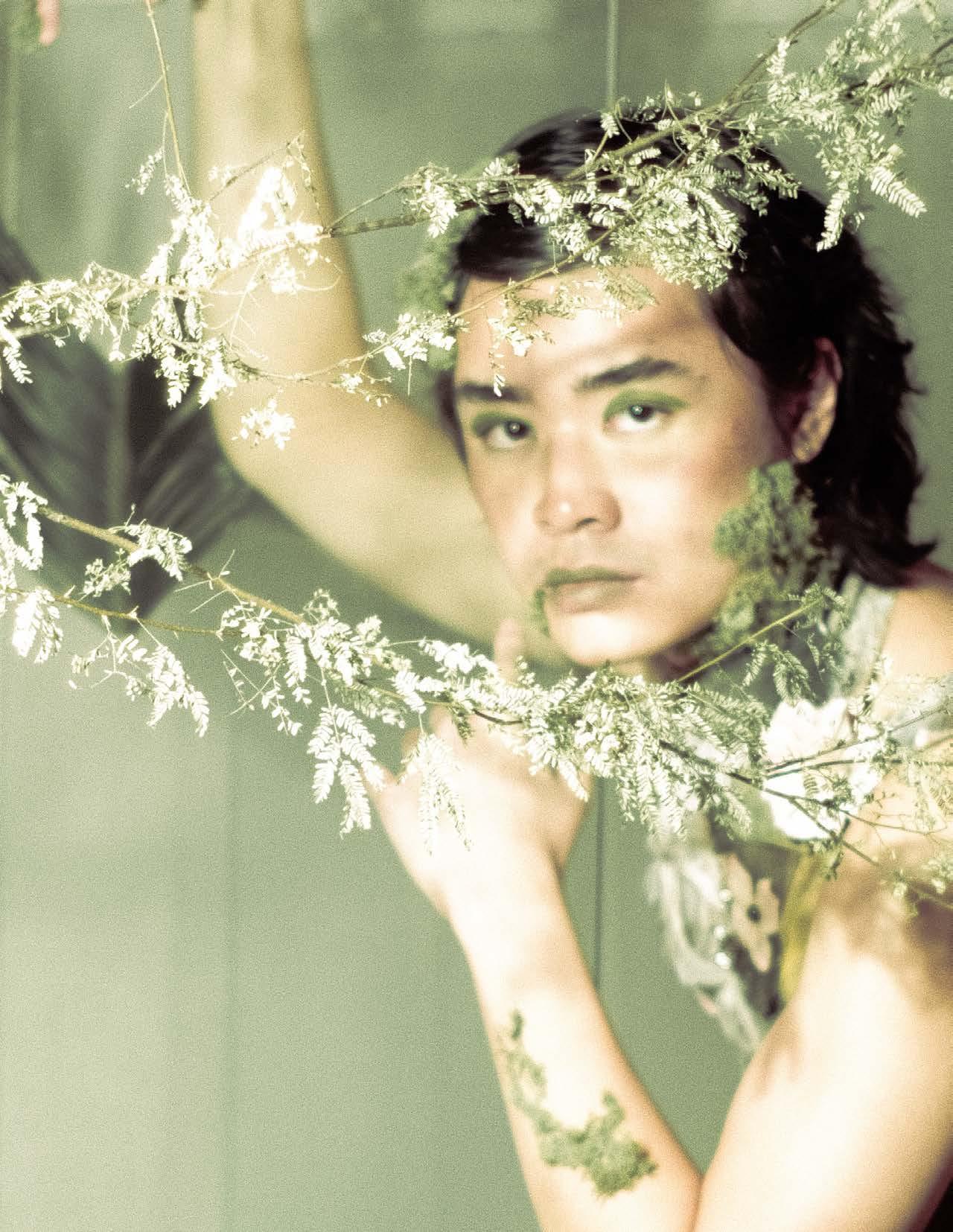
13 deathless
WE KNOW WE AREN’T AT THE MERCY OF THE NA TURE WE EXPERIENCE BECAUSE WE CREATED IT ALL— IT’S UNDER OUR CONTROL.
“ “
So, to recreate what we have destroyed, we turn to technology. “Digital nature.” Virtual reality is on the rise. Video games featuring mythical woods and majestic mountains are more popu lar than ever. We can experience an outdoor run via an indoor treadmill. We can explore pristine beaches and luscious forests via #nature.
And the best part? We get to create it all our selves. With cameras and desktops that offer the newest and greatest computational abilities, we can make digital nature just like the real, physi cal thing.
But when we watch hiking vlogs or experience virtual reality, we can only see the river flow and the trees sway. We do not feel the wind or smell the soil. We hear the sky thunder and the bushes rustle. But we don’t have to listen, because we aren’t worried about a storm approaching or a bear lurking around the corner. We know we aren’t at the mercy of the nature we experience because we created it all — it’s under our control.
And that’s the problem. Inherent to nature is the process of living in relation with the other, not in domination over it. Digital nature, as a hu man creation — a product of our utmost control — is not the same. It doesn’t even come close. Its very existence is contradictory to nature itself.

Our attempt to recreate what we have destroyed is not only futile — it’s destructive. Digital na ture is an extension of the exact phenomenon that elicited its necessity.
Smooth mounds of white gypsum blend into the painterly sky. The half-shrouded sun cre ates a soft glow over the deep blue mountains.
zzz
14 spark



15 deathless
My vision goes black for 1/2000th of a second. There is a loading icon, then the photo I’ve taken reveals itself.
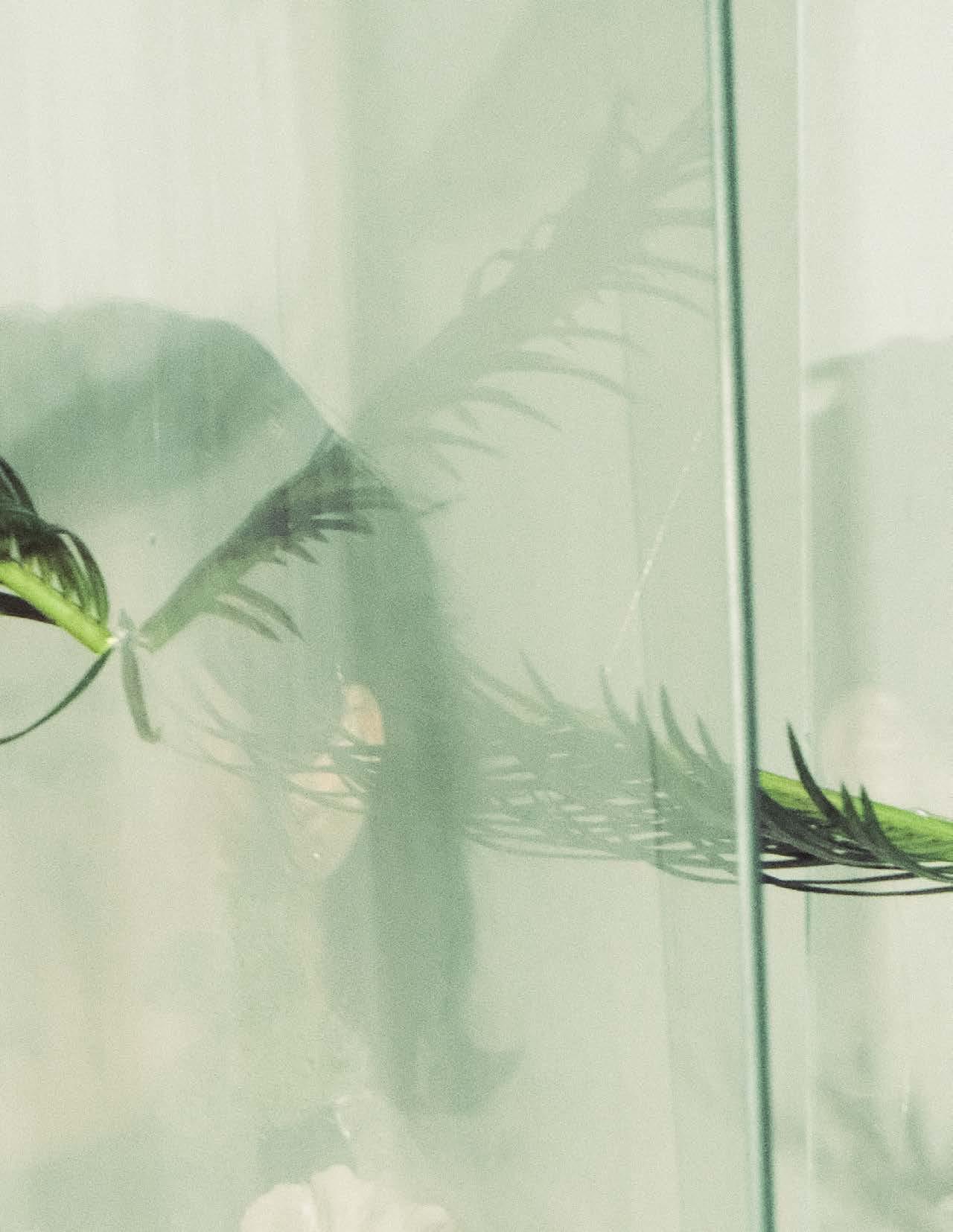
It’s just what I had envisioned. Better, even, com pared to the ones I’ve seen. It’ll be the perfect cover for my White Sands post.
I lower my camera, and my eyes are flooded with light. My forehead is hot — maybe burnt. I recoil. I forget I am standing, completely exposed, in the middle of the desert.
And the desert is much bigger than it was through my lens: The mountain range wraps around me, and there is a cottonwood tree to my left.
I blink. The wind picks up again, and silence fades into song, stillness into waltz. The sand hisses in dissent as it is strewn about by the wind, the birds flutter in harmony as they too are car ried along. Even the clouds are swept away, and as the sun spills onto the desert floor, the lizards and mice emerge from their burrows. My senses are heightened as the desert comes alive, my skin tingles as the sun and wind and sand caress my body all at once, and something inside is pulled outwards — something under my skin yearns to break free and fuse into the life around me.
But it can’t. It’s tied down by the strap around my neck.
Suddenly, my camera weighs a thousand pounds. I have the urge to yank it off my body and throw it down the dune, watch it roll and roll until it’s buried in the sand and the elements begin to break it down — the glass back into sand, the metal back into sediment. I wonder how it would feel to be here with no motive but to sit and soak up the way the wind tangles my hair and the sand tickles my skin — no preconcep tion based off of the hundreds of photos and videos I’ve seen, no future Instagram post in the back of my mind. I wonder how it would feel to look at that cottonwood and see something that is just as alive as I am, that has veins and capillar ies just as I do.
But I can only wonder. Because as soon as I saw the cottonwood, I deemed it an eye-sore: It didn’t match the way I expected White Sands to look, nor the way I wanted it to.
So I cropped it out. ■
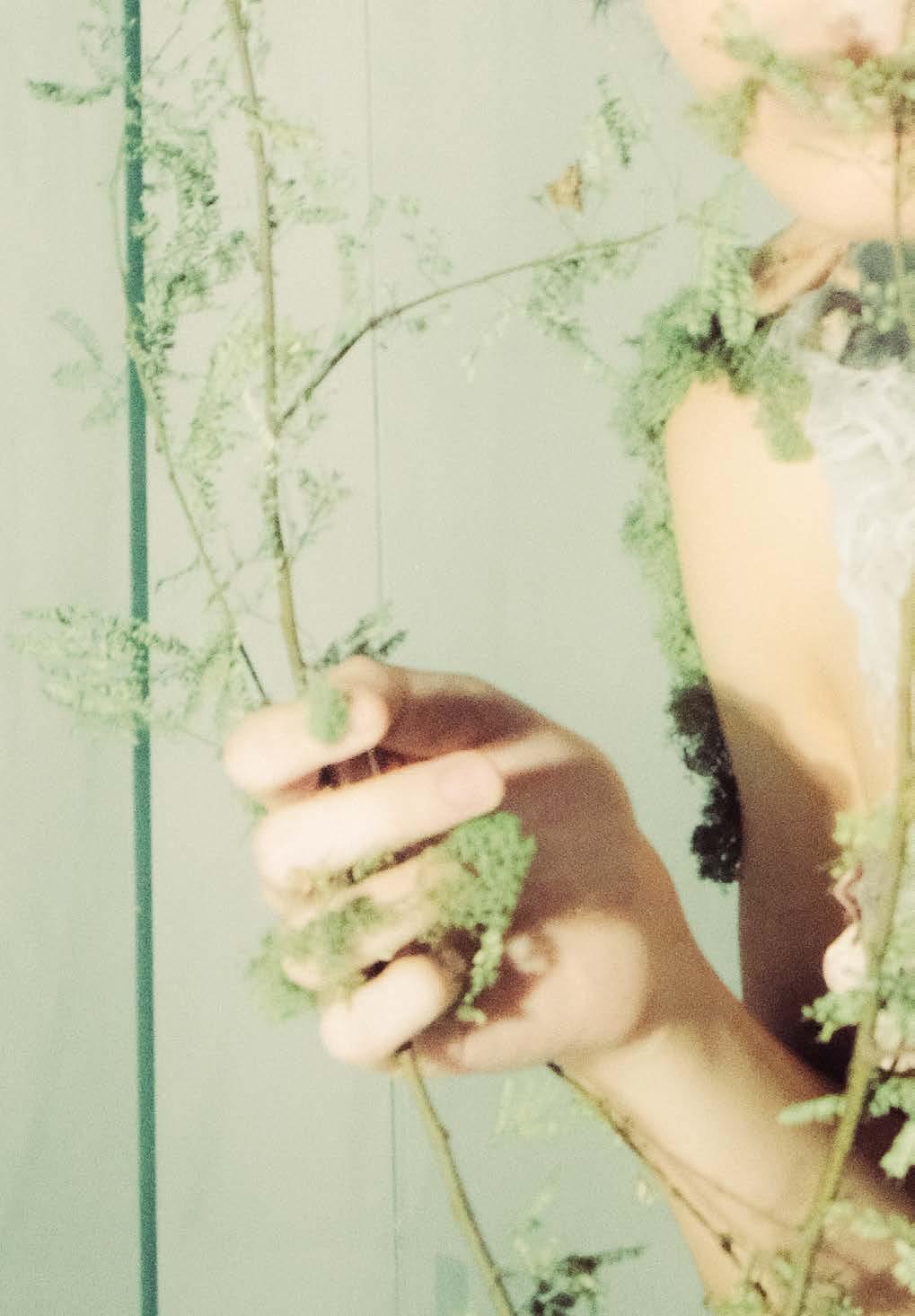


I WONDER HOW IT WOULD FEEL TO LOOK AT THAT COT
TONWOOD AND SEE SOMETHING THAT IS JUST AS ALIVE
AS I AM, THAT HAS VEINS AND CAPILLARIES JUST AS I DO. 17 deathless
“ “
Vi NATURAE
 by PAIGE HOFFER
by PAIGE HOFFER
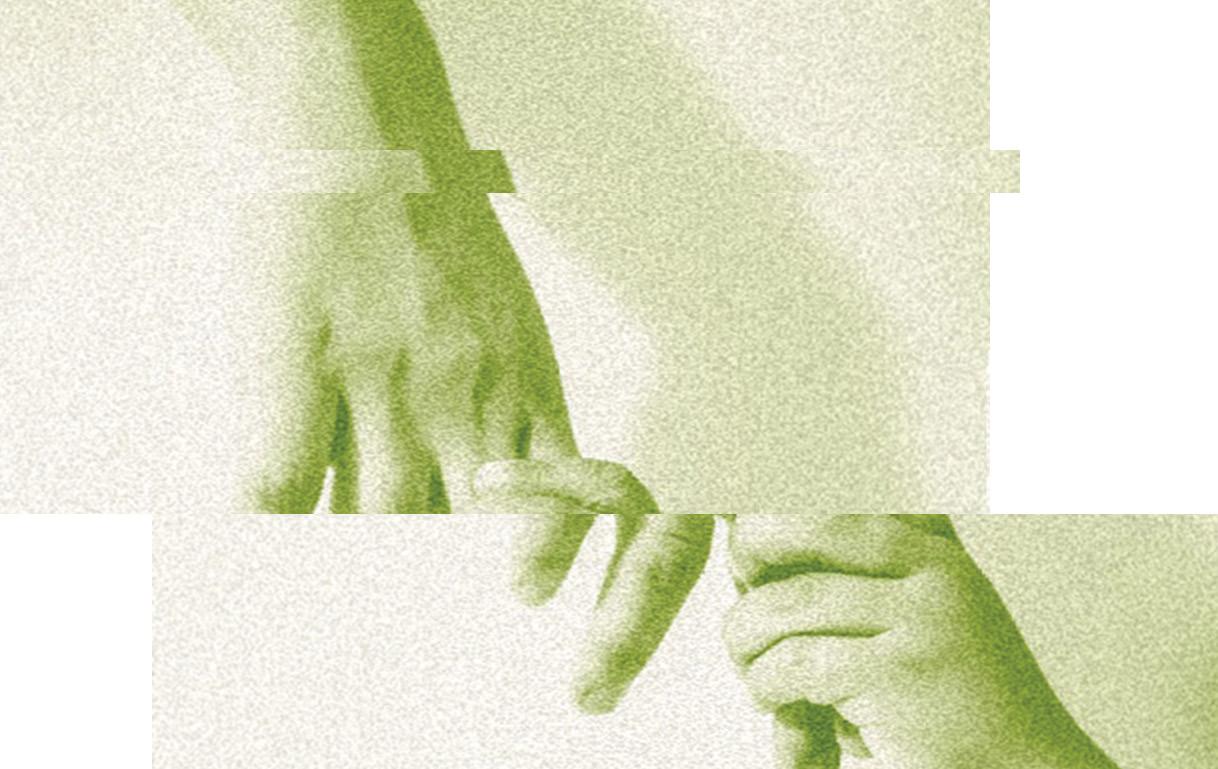 layout MEGAN GALLEGOS & JULEANNA CULILAP
layout MEGAN GALLEGOS & JULEANNA CULILAP
18
spark
I learned what the world looked like from under the pine and oak trees covering a tiny, red brick house in Alvin, Texas. I’ve known what it means to be saved by them, which means I know, too, what is at stake when they’re lost.


19 deathless
My grandparents lived in my mom’s child hood home, a small bungalow on Oak Manor Drive where cigarette smoke coated the walls in a way that never al lowed it to look or smell quite clean. My grandma’s nightstand overflowed with books, house plants, and other trinkets; copperhead snakes slithered between cracks in the concrete when it got hot, and the per vasive sound of cicadas in the late summer months rang in our ears as we fell asleep. For my brothers and me, this was the setting of many weekends of our childhood.

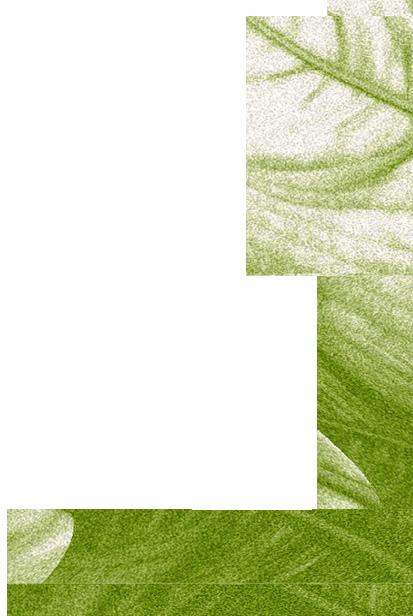
On Saturday mornings, my grandma would walk with us to the park. We walked down the street un til the asphalt blended into a dirt trail, shaded by pine trees whose enormity made us feel small. We had to crane our necks up to see the tops where light spilled through leaves and cascaded down our faces in scat tered rays. The trees had thick trunks and their worn roots overlapped one another in an embrace so strong it felt as if time began when they crossed. My brothers and I treated the trees with a spiritual reverence: We fell to our knees and collected its pine needles, a piece of God we could hold. We wanted our grandma to feel it, too. She held onto the needles I gave her in her left hand while lacing my hand in her right. We walked down that path where God was not airy, not foreign, but somehow contained in what is seen and touched, still not entirely knowable.
When we returned to the house, my grandad would be laying on the couch, and she would go to shower. My grandparents lived around – and not with – each other. To connect to them, we had to reach their worlds in different ways. Bonding with him meant we had to like grown-up things. We would lay on the linoleum tile floor parallel to where he laid on the couch, watching Elvis marathons and jutting out our bellies to match his, mirroring the cadence of his breath.
They probably shouldn’t have stayed married, but time had weathered them into opposites who shared a house and got used to the way the other snored at night. They were as permanent as the house itself: just like how the roots of the big oak tree in front split con crete into uneven, staggered planes where we played hopscotch, my grandparents’ relationship was, too, beautiful and enduring.
It made sense then, that when he died, everything shifted. It was on my birthday. I didn’t think he was seriously sick, so I spent the last few hours I saw him scrolling on Instagram, on the couch of a hospital room, overcome by the realization that my friends were hanging out on my birthday and didn’t invite me. I had grown into a teenager, centered in the world I created. It was filled with complications they couldn’t understand. They didn’t know about the surveillant, sneaky language of social media in middle school –what it felt like to stalk your friends’ locations and find them together, or to slide up on a story for a “tbh” and be met with your deepest insecurity reflected too eas ily by text on a screen. My world was all-consuming; trees and Elvis were too many generations behind me to matter.
“My world was all-consuming; trees and Elvis were too many generations behind me to matter.”
After the funeral, I saw my grandma when she would swing by the house, on holidays, at birthdays, but never on mine. She sold the house, and laid the roots for a new life with a luxury apartment in my area of Houston, next to a park. I was angry. To sever my ties to their world meant I had to lean more heavily into mine. She became obsessed with working while I moved through high school largely without her. Even though she lived closer, we kept our distance be cause it was easier than trying to find footing in the new, uncertain future of our relationship that might fall and break with one wrong step. Hiding in our busyness took away blame that couldn’t be placed on either of us.
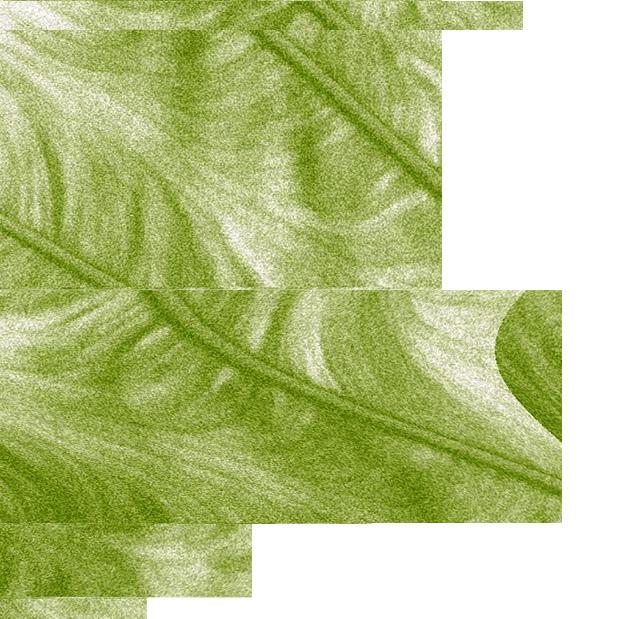
I lost the comfort of routine in my first semester at college. I had planned for my whole life to lead up to that moment–when I was home, I went through the motions of my day with the promise that soon I would be independent and surrounded by thousands of new people in a new place that was mine to explore. When I got there, though, I had never felt so lonely in my life. I walked to class glancing at thousands of faces without having enough time to process them so they all turned to a frenzied blur of people with their eyes cast forward, headphones in. I sat in the back of a
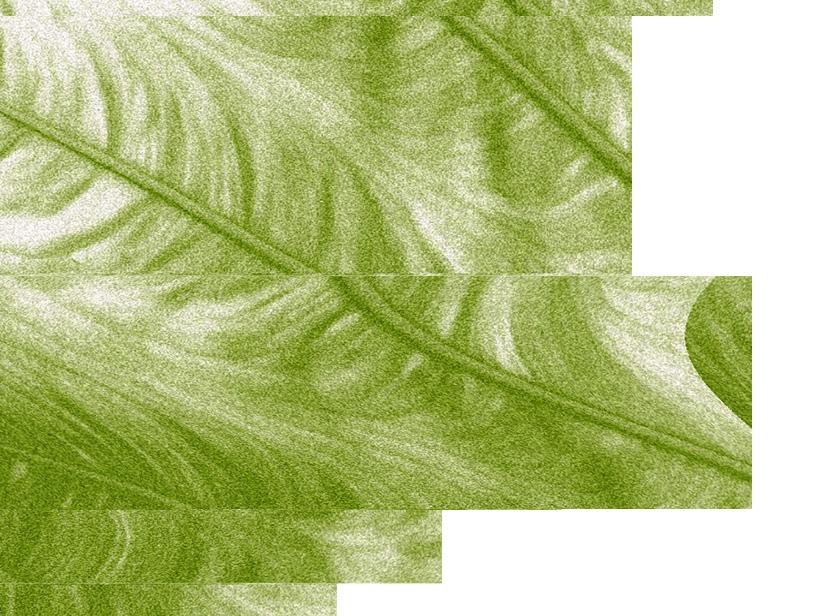
deathless 21
lecture hall for a few hours, returned to my bed, and stayed there until the last possible minute before the next class. I listened to my old playlists, printed out pictures of my friends, and clung to every detail of home, even the things I used to despise.
It’s funny how when I finally got to choose who I could be, I just rearranged the pieces of myself that were already there. One day, I remember having an overwhelming feel ing that I needed to call her. I sat down with my backpack on the lawn, and found a tree to show her. It felt like a pathetic reason to call, but I was desperate to feel home, and to feel it deeply. Today was my brothers’ first day of school and I wasn’t there.
She answered on the fourth ring. She loved the tree. It re minded her of the ones at my brothers’ school, which was near her apartment. She walked there every morning to bless the trees where the kids ate lunch.
“You what?” I said.
She had watched a science special that made her believe the way roots tangled was profoundly human. They could sense when another tree was going through a difficult time, and they would supplement it, sacrificing their own nutrients in order to support the others.
With this knowledge, she would go from tree to tree and put her hand on each one in a sacred exchange. I could imagine her hand on the bark. Her skin had become more translucent these past few years to reveal protruding, green veins that expanded over her hands. They mimicked how time weathers through earth to display the endur ing permanence of the roots underneath. When I was younger, I loved to trace my fingers along those veins.
“Why do you bless them?” I think part of me knew the an swer, but I asked anyway.

“There are ways that I will never be able to protect your brothers. But when they sit underneath the trees, I hope they feel that I’ve been there. The trees get it, you know, the protection.”
There’s a peaceful, resigned stillness in her face, all mus cles relaxed and sinking. When I look at her, I see my kids and their kids too.
I feel something like wholeness — and at the same time deeply afraid because this, this, is what the future will miss.

Let it be known that from the embrace of concrete and tree roots, hands and pine needles, the grave and the ground, I know human and nature need each other. I know this, and still, I know I am not greater than nature; I am of it. Blood flows through my veins with capillary ac tion, those veins stretch out like branches, and the skin that covers them does, eventually, rot. That blood has been passed down to me, and I will pass it to my kids, but I fear they won’t know what it means like I do right now, at this moment that I was so close to losing it.
I don’t think the world will ever be without nature, but I’m scared that we are creating a reality that can exist in dependently of it. When we see nature as something to decorate the world we’ve built and not as the world itself, we will have lost it.
I mourn for my distant lineage who will look at veins of their grandmother’s hands, then their own, and not be able to trace them against the branches of the trees on Oak Manor Drive. Just as we search for traces of ourselves in the people we love, I am afraid we will search for traces of nature in them and find only the subsequent, nostalgic melancholy for pieces of us missing. ■
“I mourn for my distant lineage who will look at veins of their grandmother’s hands, then their own, and not be able to trace them against the branches of the trees on Oak Manor Drive.”
spark 22
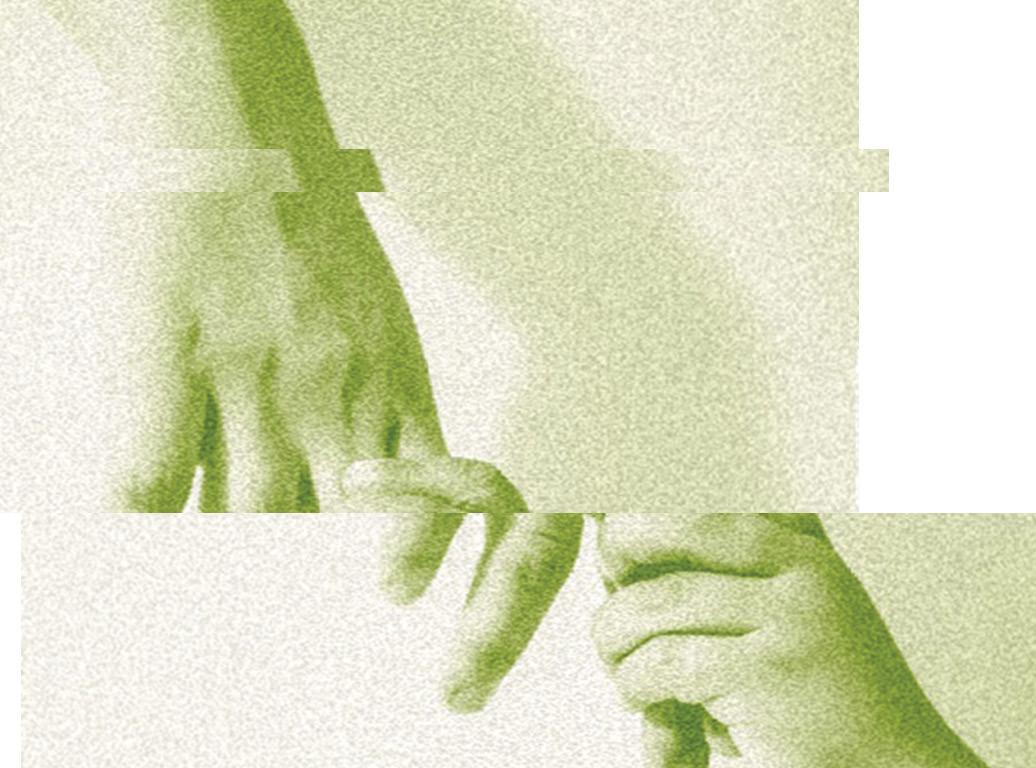
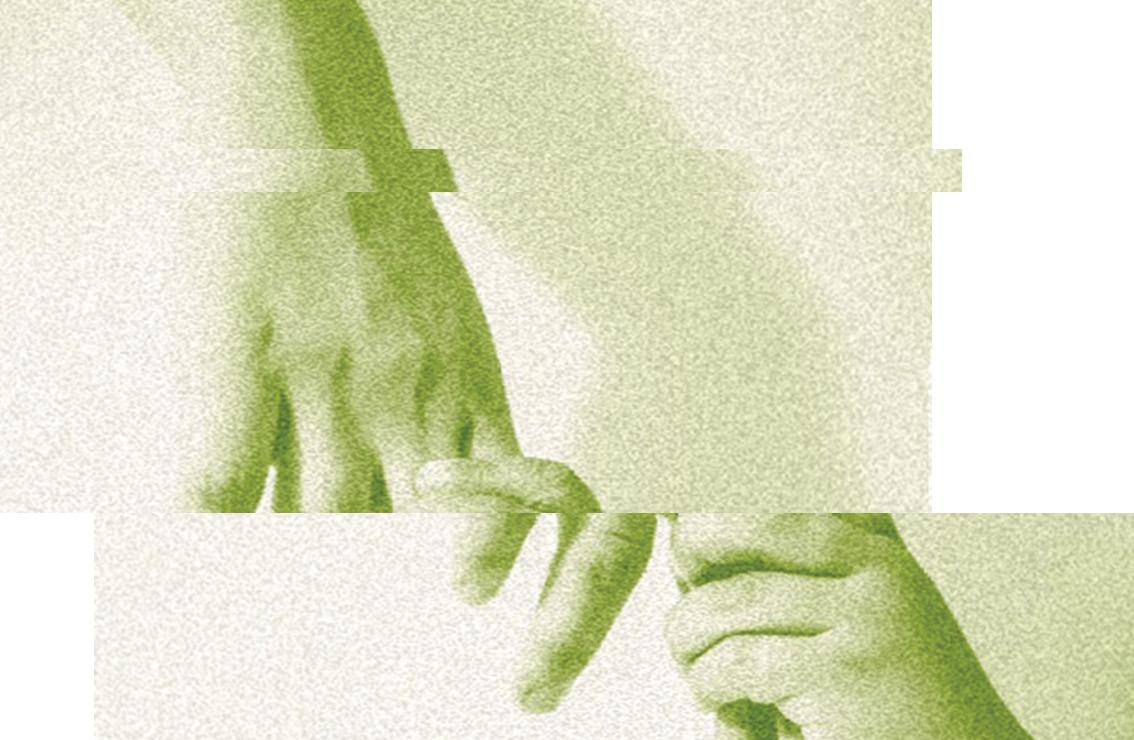
deathless 23

24 spark
by RACHEL BAI
In a world where mythology and its relationship with humans form a circle of creativity, comfort, and hope, technology shatters this fragile chain and inserts itself as the only possible answer.

 layout JULEANNA CULILAP photographer JACOB TRAN stylists EILEEN WANG & SOPHIA AMSTALDEN hmua MERYL JIANG models TYLER KUBECKA & TIFFANY SUN
layout JULEANNA CULILAP photographer JACOB TRAN stylists EILEEN WANG & SOPHIA AMSTALDEN hmua MERYL JIANG models TYLER KUBECKA & TIFFANY SUN
In the southernmost corner of the sky, the vermillion bird perches on a mountain peak, hooked beak and talons sharp enough to slay gods gripping an imposing trunk. Its fiery red feathers burn a brilliant orange against the sunset. Shrewd eyes observe a mouse dart between grains and alert ears hear a bucket drop into a well. It’s waiting for its next ceremony — the coronation for a young king of a mighty na tion — ready to bestow grace and glory.
Hidden in the dense woods, the king lies in a pile of his own blood. The foul odor permeates the air, but nothing can fog the feral bloodlust of the hunter. She had a hunch that the king’s mea sly bodyguards would be no match for her rifle, loaded with .300 Winchester Magnum rounds. And now she knows that the vermillion bird will soon be a limp, cowardly version of itself.
Finally.
The sun dips into the valley. The stars blink into existence. The vermillion bird expands its massive wings. A boom, a screech, a thud: The scorching south is nothing but flesh and skeleton.
As mighty as any god, when faced with technol ogy, the vermillion bird shrivels.
The hunter lifts her gun in victory.
Somewhere in one of the thousand villages dot ting the coast, glittering sea brightly contrasting the drab and gray landscape, a widow with four children clutches her taser close to her chest. Be sides the tattered blanket wrapped around her children, the taser is the last possession she has for protection. War is long and draining, both emotionally and financially.
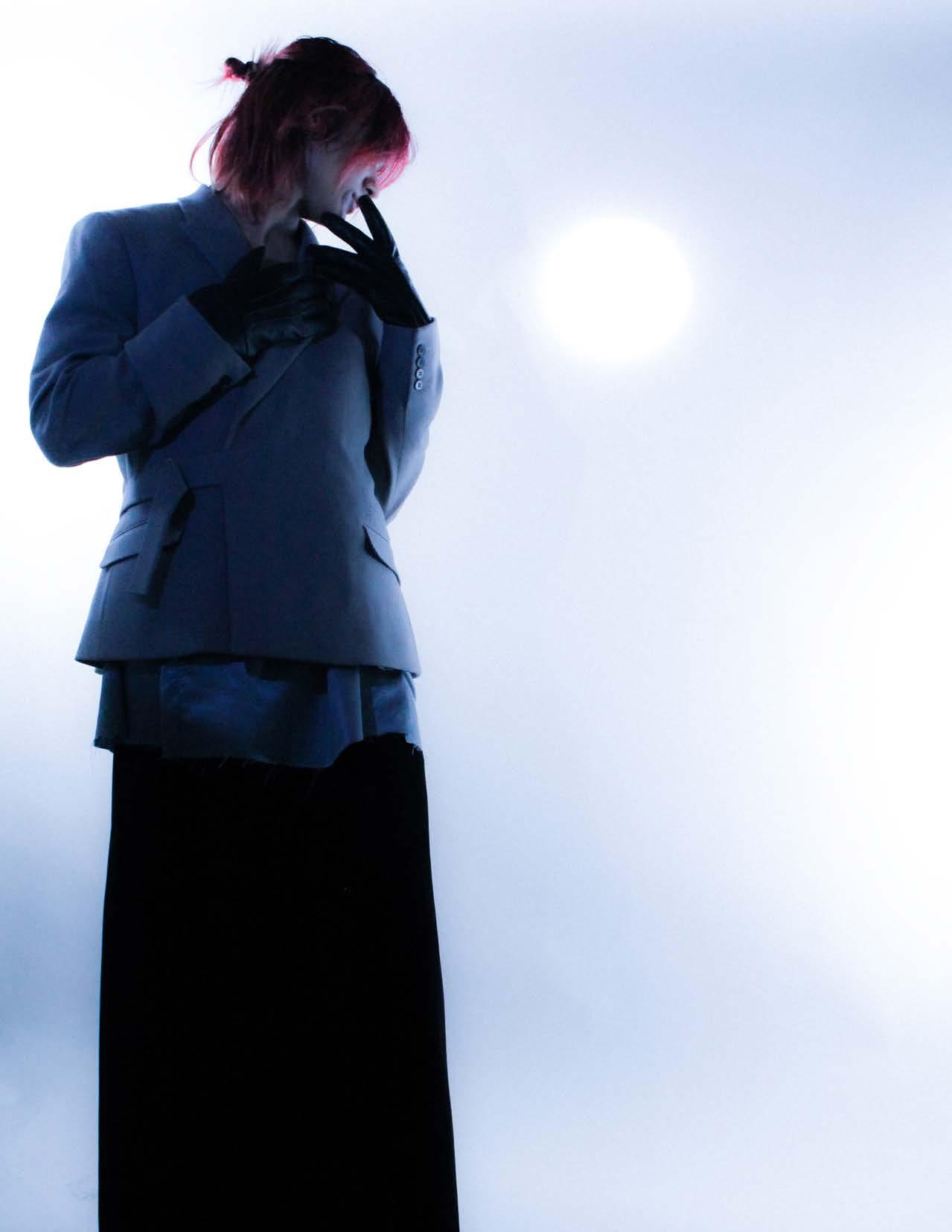 SILVER TOP | Sophia Amstalden
SILVER TOP | Sophia Amstalden
“Will we survive?” one of the children asks.
The widow hesitantly nods. She wants to reassure them, but she’s not sure how. There’s a gaping hole in her, one she doesn’t know how to fill. No matter how much she grasps and searches, she still fumbles.
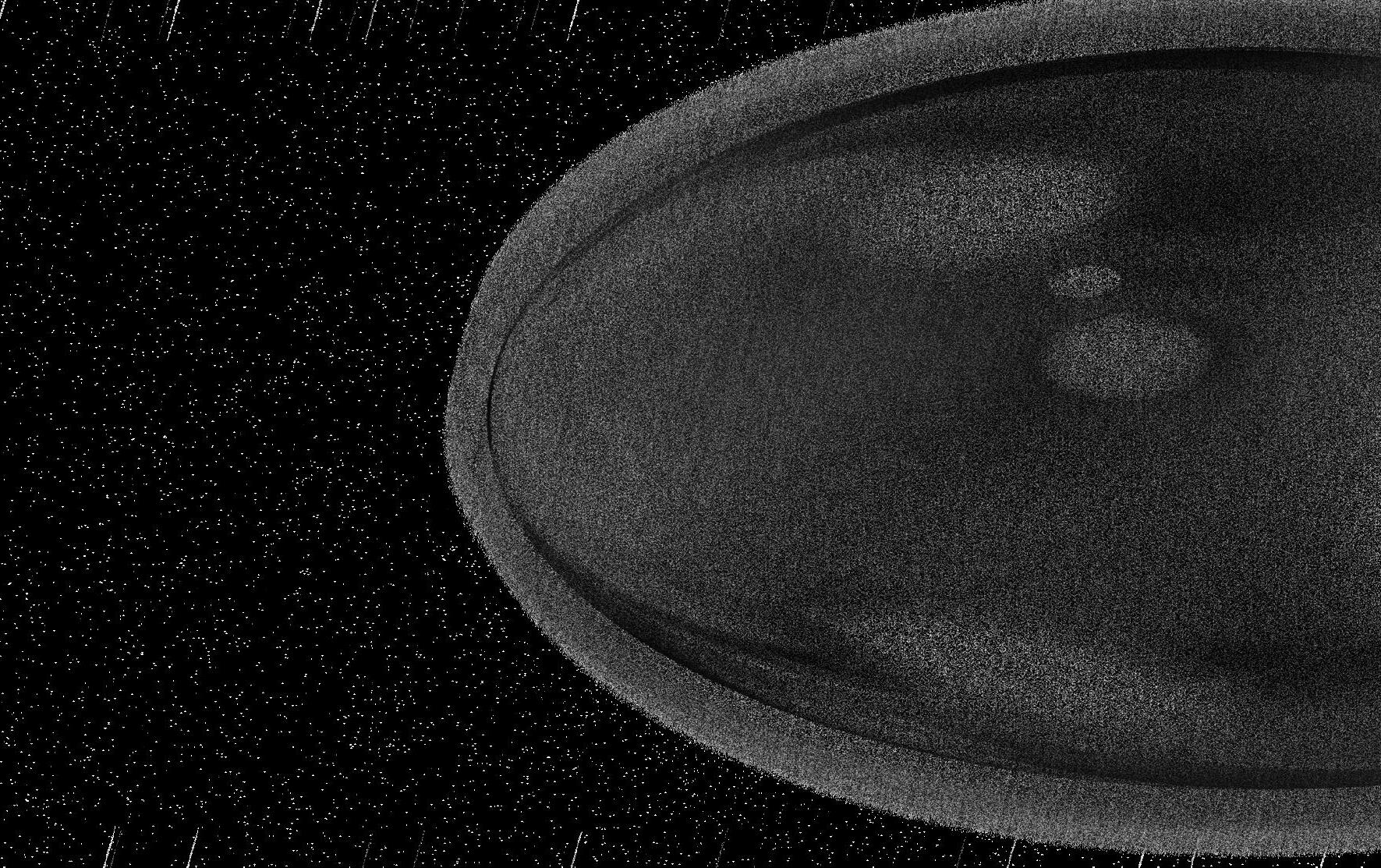
Sometimes, when the night is long and dark and smoke smothers all stars and the moon, she won ders if it’s always been so quiet and dull. She swears that her father’s voice, firm and hoarse, spoke tales of gods and dragons to her, but all the words she remembers are droplets of rain that don’t make sense together. The king dies, and the hunters rise to power: These are the proven facts, as irrefutable as the vermillion that never existed, that became a whisper in the wind.


Outside, a bomb explodes, and the widow drowns in her uncertainty.
In the middle of the Pacific Ocean, while the cap tain marvels at the hunk of metal designed to brave storms and rough terrains, a couple shivers in close pattern with the crashing waves.
The couple hugs each other. Eyes closed, hands clasped, and foreheads touching, they are deter mined to remember the country they have just left. It’s hard, though, especially since every breath they inhale tastes salty. A bit like their tears. A bit like the fear coating their tongues and brains.
The man is thinking about his mother, but in these turbulent, uncertain times, he feels sad that he can only remember the spinning machine. It spun and whirled a hundred times faster, produced more effi ciently than ever, but he can’t recall exactly what his mom was weaving. In his memory, the thousands of pieces of fabric were nothing but a blob of color, devoid of individualism and culture. Click clack, plop and hiss: He wonders if there was a time when his mother listened to other sounds besides metal against metal.
Then, he wonders what he will bring to this new land.
“What will we give our children?” he asks his wife.
She lifts eyelashes to reveal dark, wet eyes. “I don’t know.”
deathless 27



28 spark
“As mighty as any god, when faced with technology, the vermillion bird shrivels.”
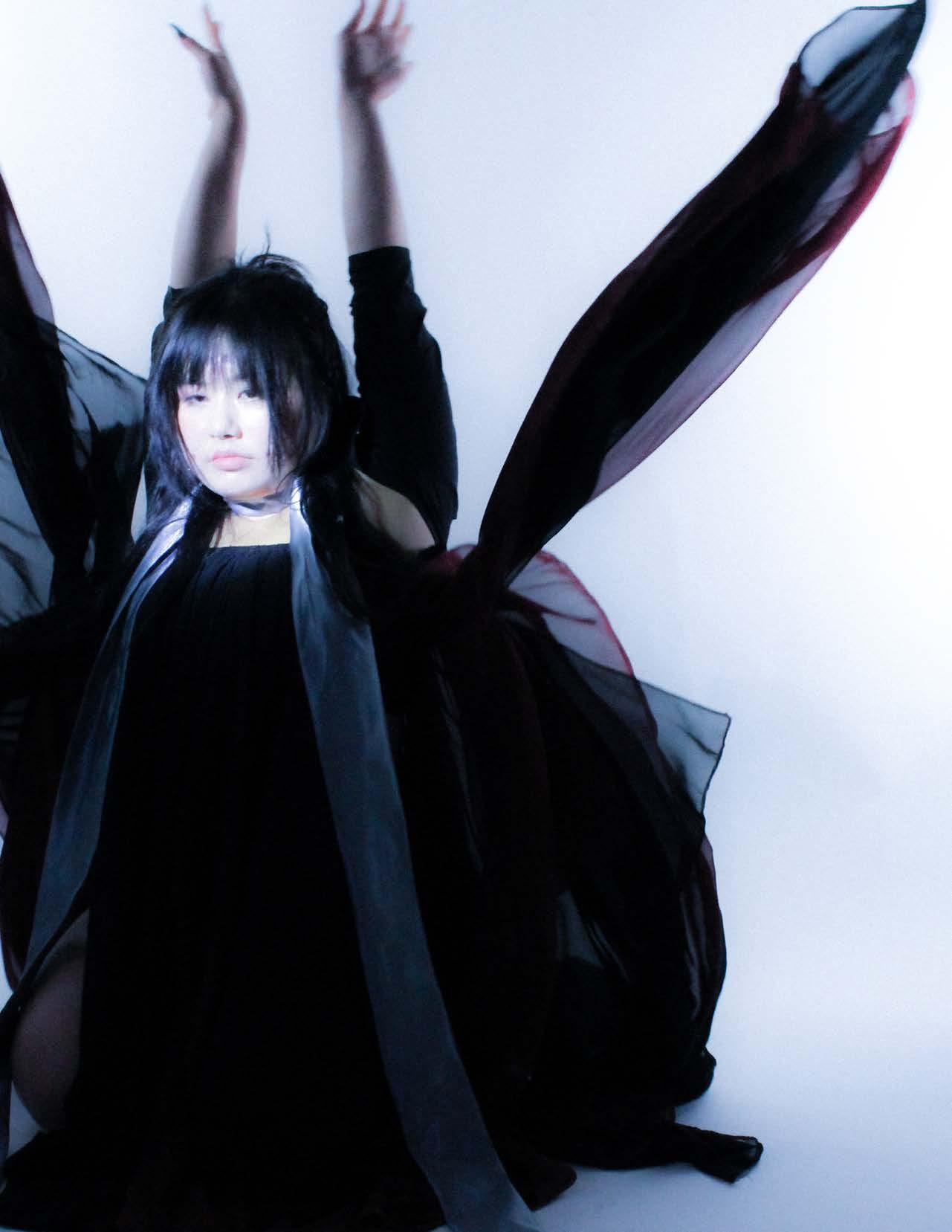

29
SILVER SCARF | Sophia Amstalden SILVER NAILS | Eileen Wang
deathless




30 spark
To start from the beginning of the world means to start with mythology. Soaring above human limits, beyond even technology, and fueled by hope and wonder, it is born out of uncertainty. The explo sions of desire, the mystery of the unknown. My thology at its core contradicts technology. Where one exists, the other cannot thrive.

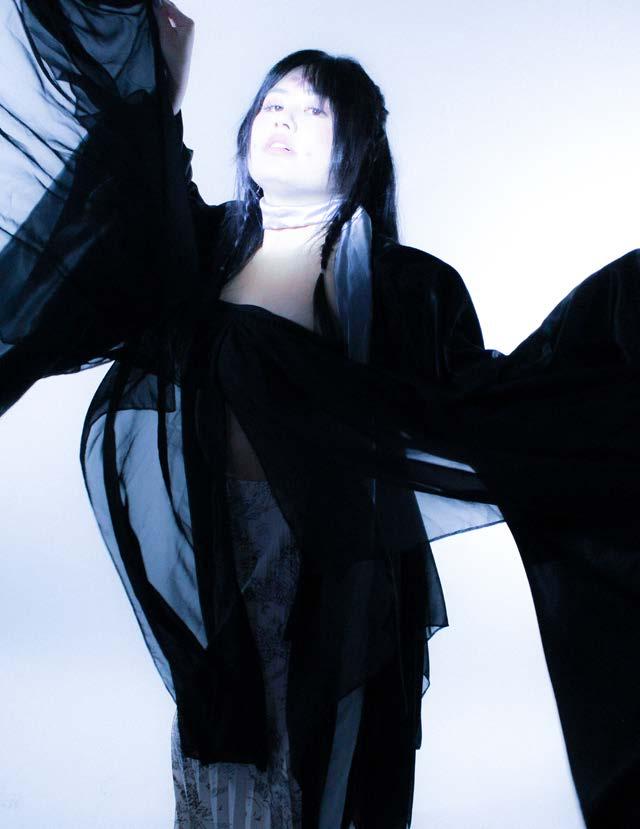
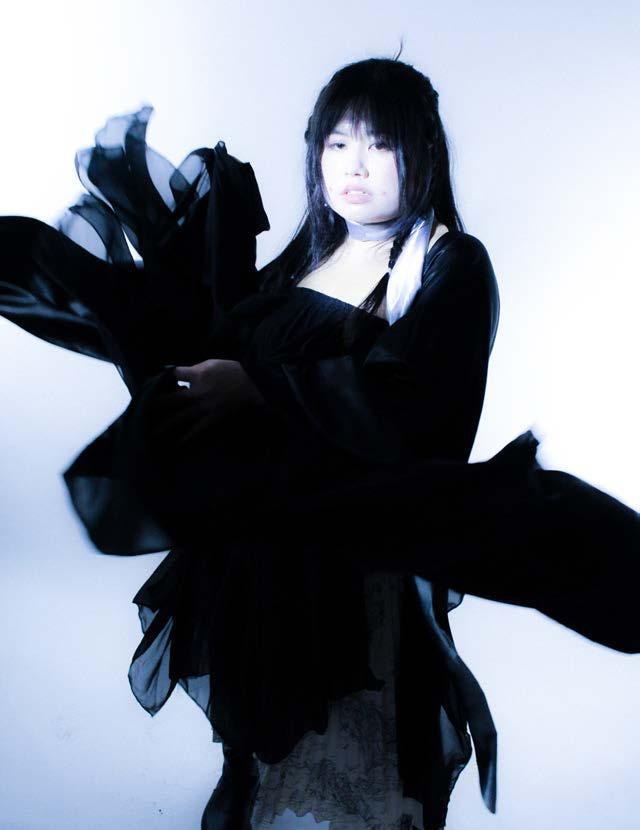
When exhausted civilians retire from a day of till ing and harvesting, they look upon the pool of stars dripping down the night sky for comfort. They see two lonely souls desperate to reunite and the heav enly mother kind enough to weave the stars into a bridge. The sweat dripping onto the dusty grounds hints at the possibility of fruitless labor, but the warmly illuminated stars remind them of hope and solidity.

When tables are empty and white is all that can be seen, a weary mother hugs her sickly babies and remembers Tudigong, the Earth god. She’s already cried for the past two days, and the only reassurance left is that her baby will be taken care of in the af terlife. Gentle in appearance and nature, Tudigong embraces her agony and softens her raw edges.
This is the truth that people believe in when the tunnel is dark and the light is far. This is the truth that has achieved immortality. The branches of this ancient tree change and mold as societies and indi viduals evolve and adapt; however, the fundamental roots anchoring the trunk deep in the dirt remain the same emotionally and spiritually. Humankind’s belief in everything and nothing might disappear, but the remnants of stories that remain inside of them will last forever.
Societies are built from these remnants. A primitive giant cracks the chaotic world in half with his ax, and from his sheer strength comes the separation between yin and yang, land and sky, balance and creation. His statues stand tall and proud, full of purpose, duty, and responsibility. The Three Sover eigns, demigods at their core, use magic to improve lives and, at the same time, remind people of kind ness and empathy. Lessons of courage and passion, virtue and loyalty: These leading principles become the foundations of human interaction and societal construction.
31
From these commonly accepted morals and ethics comes the establishment of law and order. The complex web that exists between mythology, culture, and value has become so inter twined and tangled that one cannot separate from the other without loosening the yarns making the string. Every interaction leads to another idea, which ultimately crosses the boundaries and dabs a hesitant foot into the creation of major belief systems that could go on to change the world. Destroy the massive pillars anchoring the roof to the floor, and the beautiful structures would subsequently collapse, too.
And when that happens, what will be left at the end of the world is rusting metal and toxic sludge. Technology gives people a sense of faux permanence. It comes in with its flashy gad gets and sweeps aside the shiny diamonds that have existed in minds for thousands of years. However, it will eventually erode and disappear, and the certainty it provided will burn to ashes. Left with no armor or shield, humans will end up struggling to grapple with the new reality, one where mythology hasn’t been provided a chance to grow and bloom into the pro tection it could be.
In one world, a lovely goddess and her pure white rabbit reside in a heavyset house gleaming a dark maple red under the brilliant light of the sun.
In another world, the telescope forces people to look up and see the uglier truth: craters, eroded rocks, and one dusty footprint. ■
“The complex web that exists between mythology, culture, and value has become so intertwined and tangled that one cannot separate from the other without loosening the yarns making the string.”
32 spark

33 deathless
terra nullius
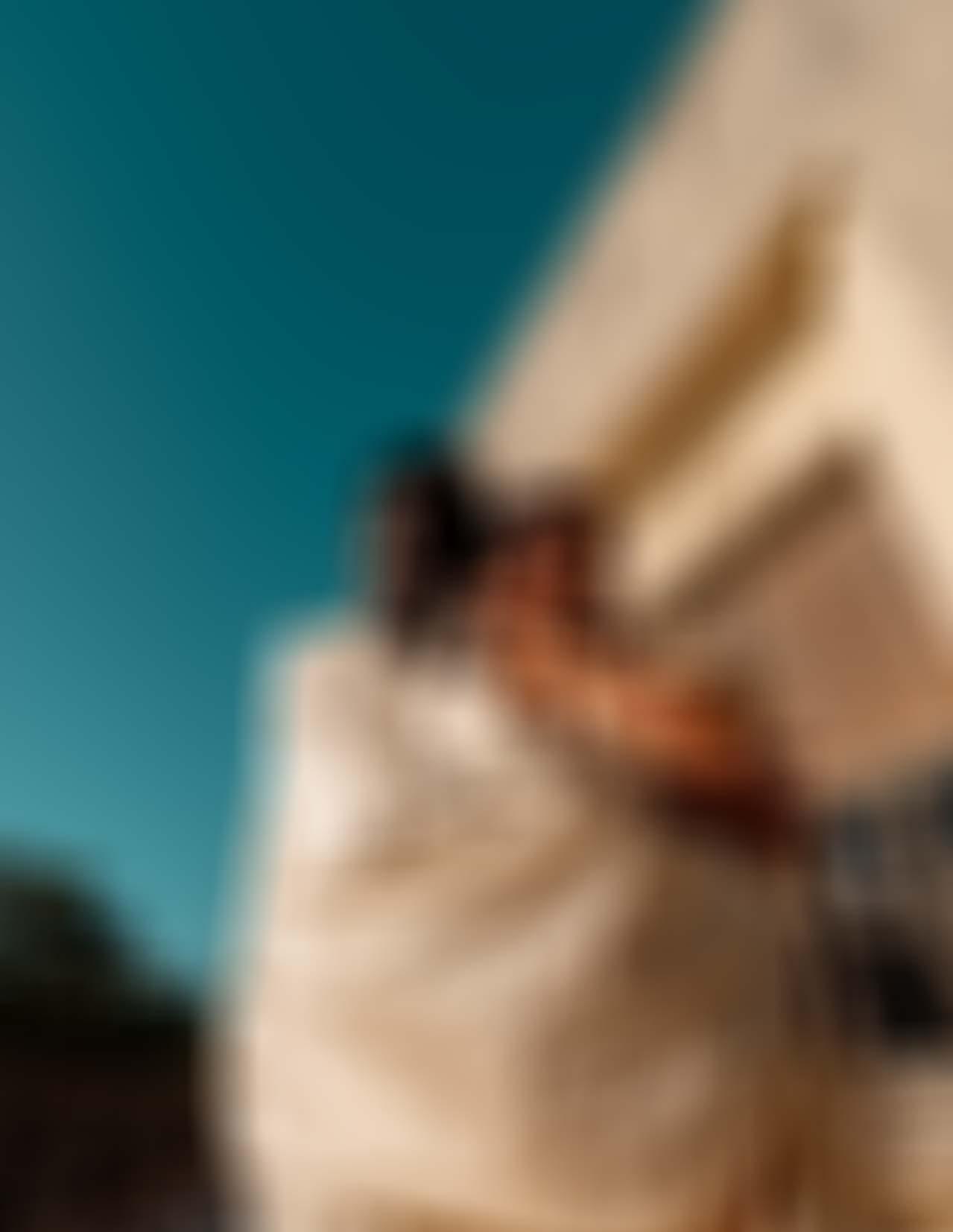
34 spark
layout JAYCEE JAMISON photographer REN BREACH stylists MIRANDA YE & EMILY WAGER hmua CLAIRE PHILPOT & ALEXANDRA EVANS models ENRIQUE MANCHA, BRANDON AKINSEYE, & NIKKI SHAH
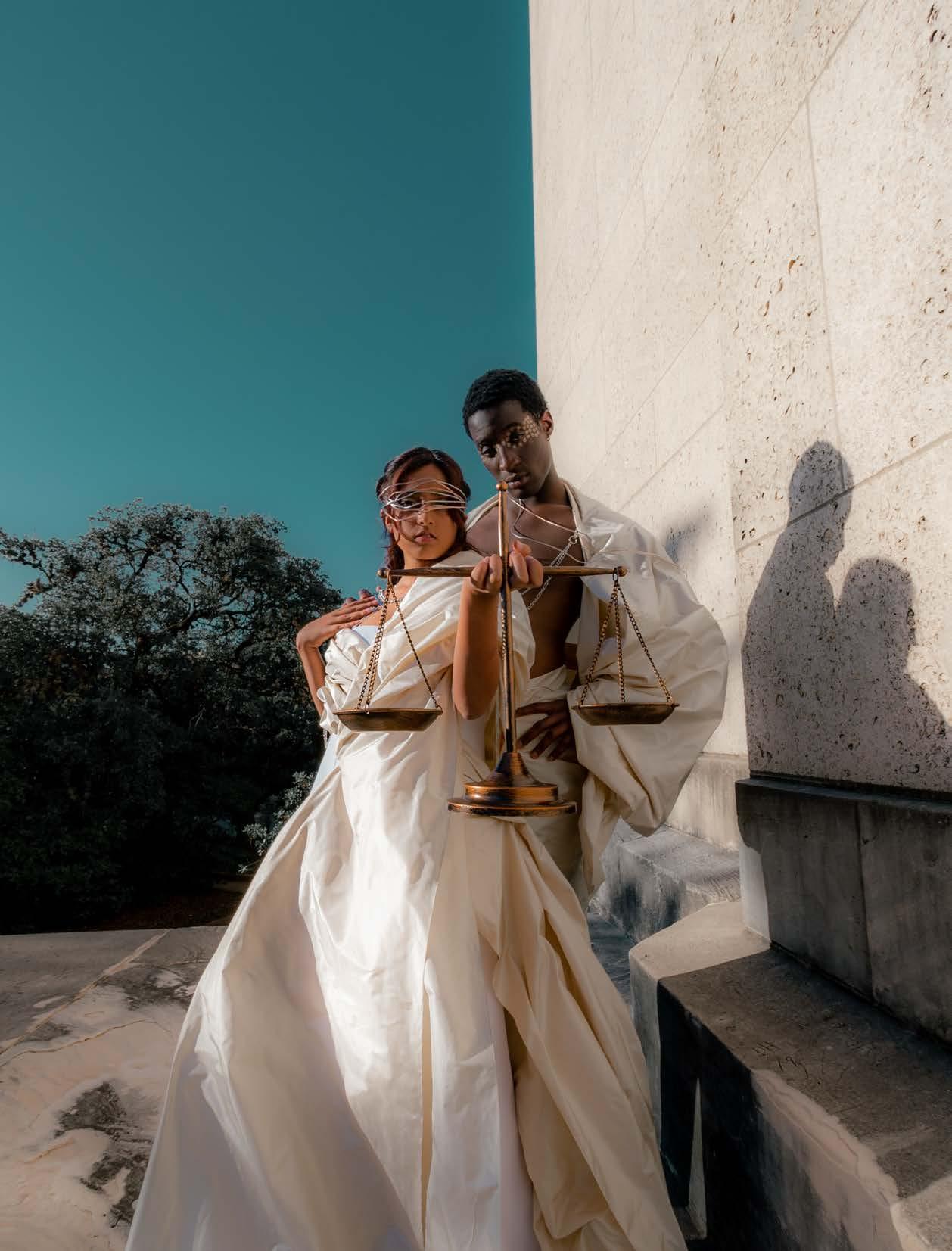
35 deathless
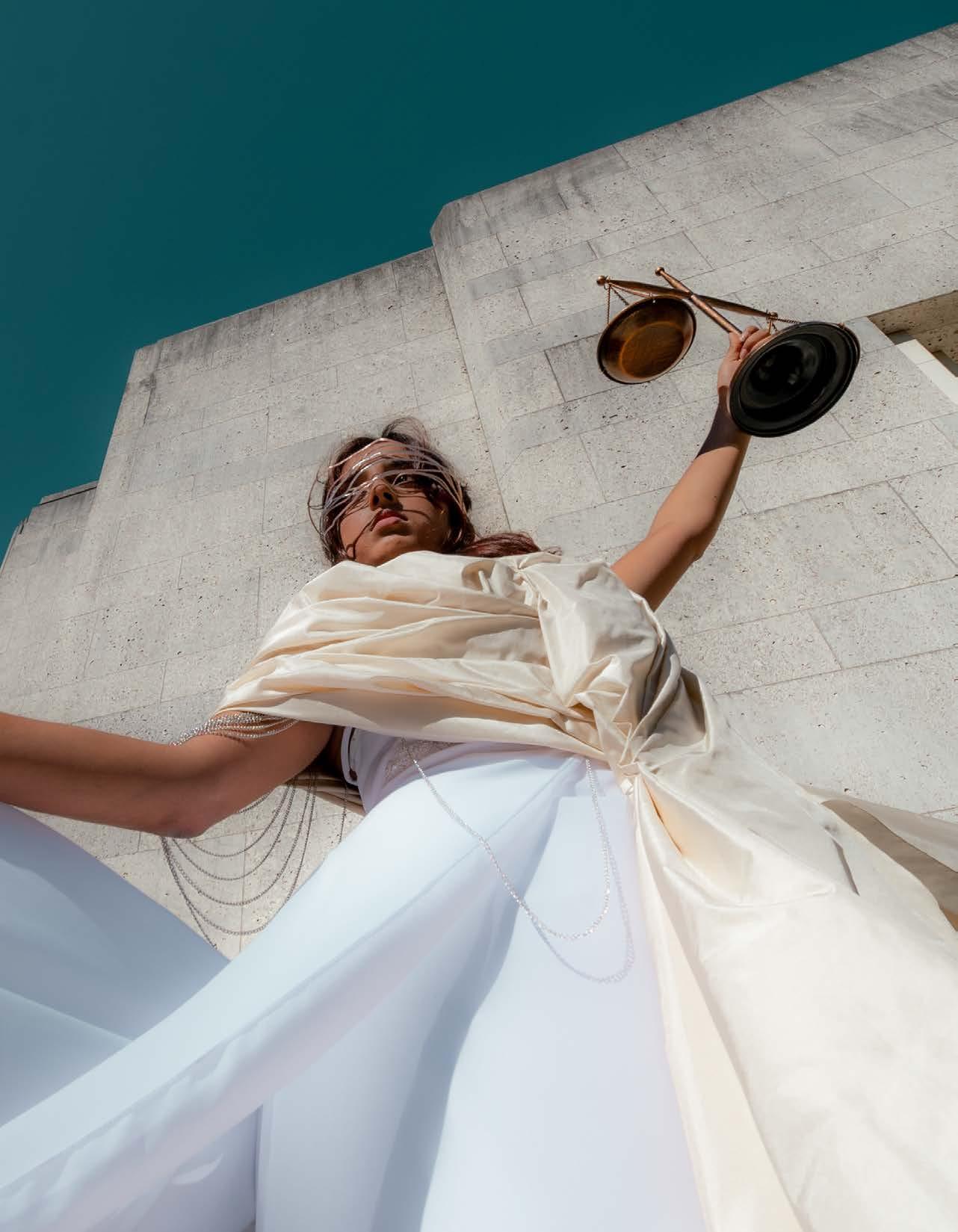
36 spark
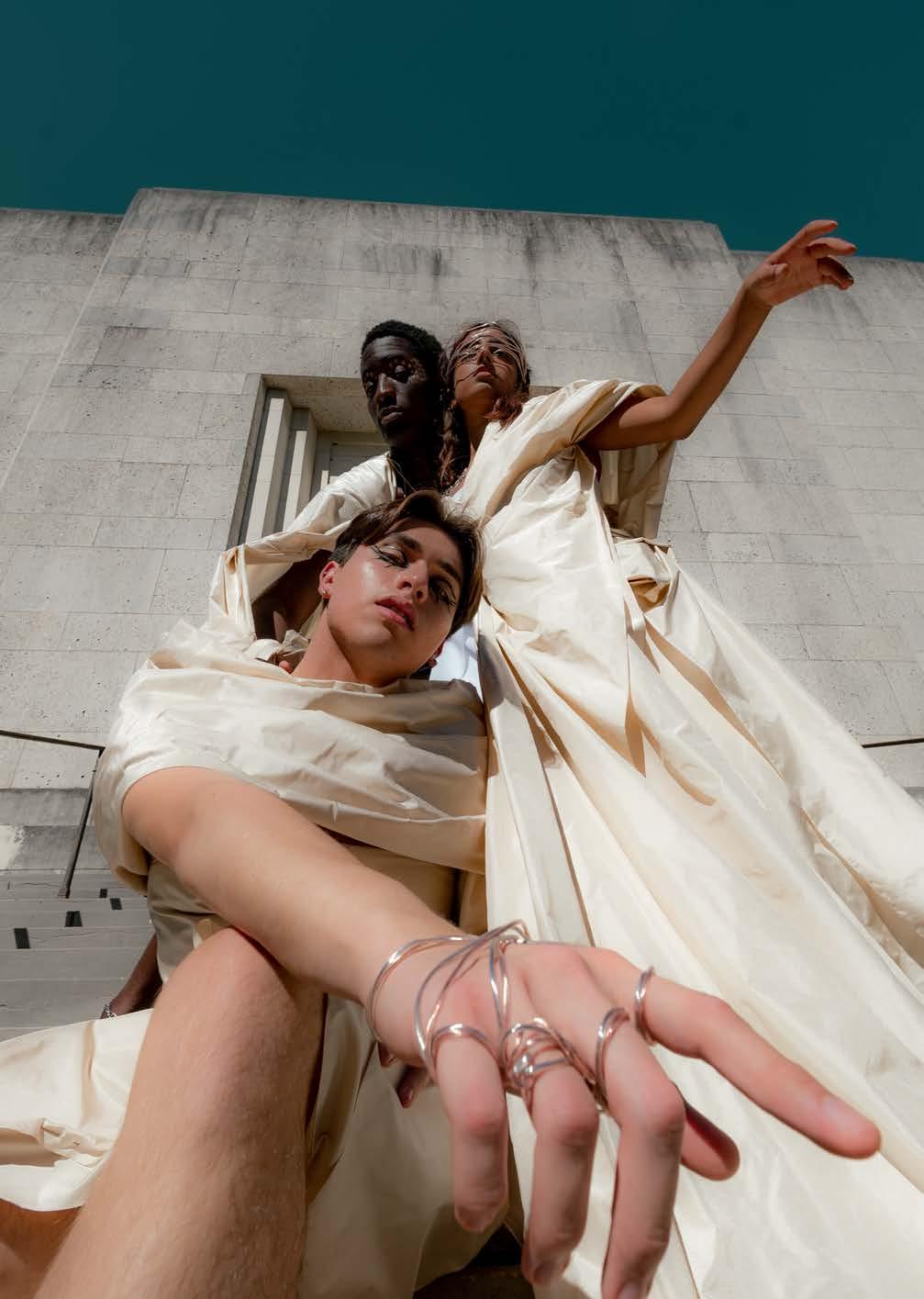
37 deathless

38 spark

39 deathless
When posthumanism erases our need for faith, I am unsure whether or not we will mourn our loss of divinity.
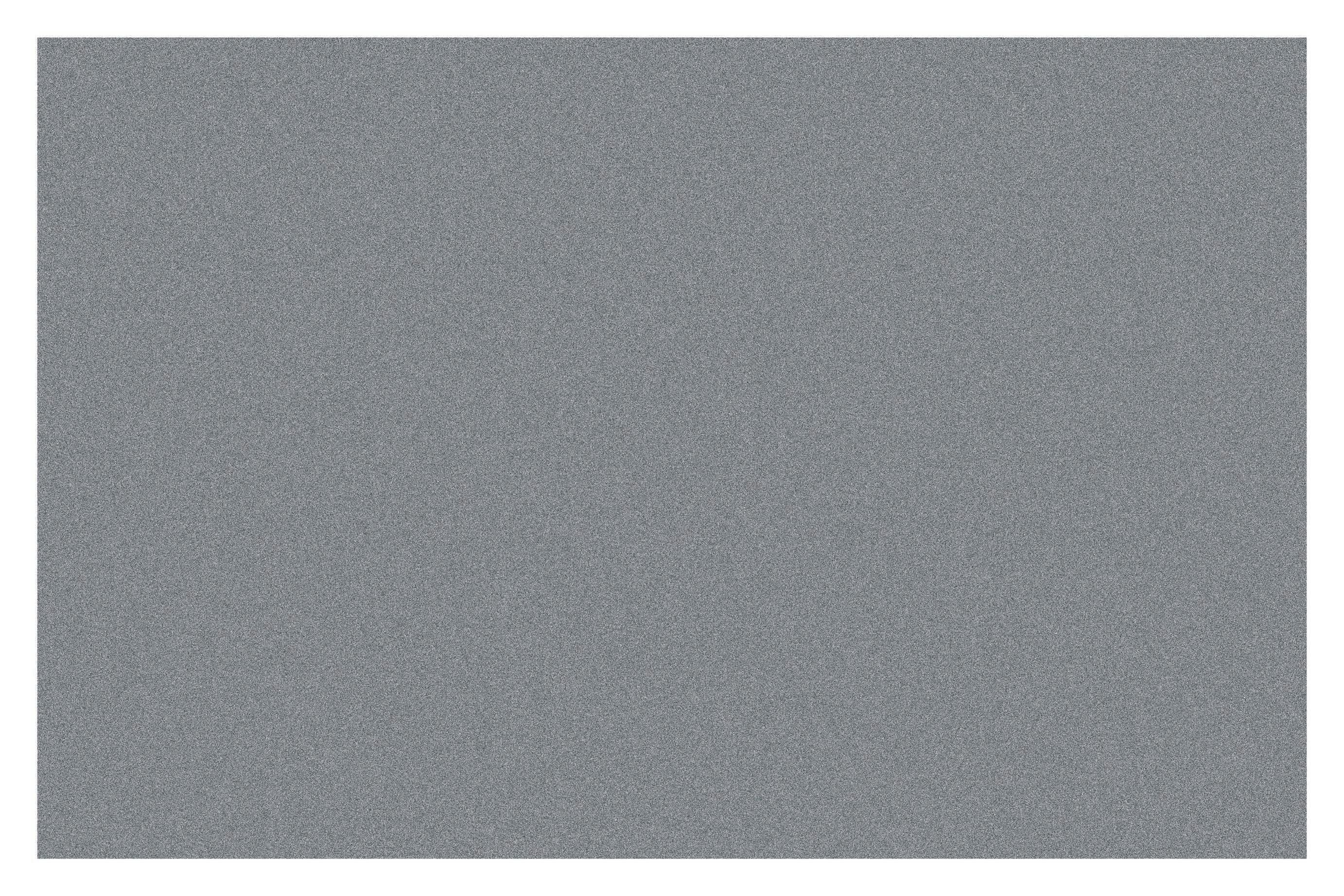 by ALLISON NGUYEN layout SOPHIE ZHANG
by ALLISON NGUYEN layout SOPHIE ZHANG
40 spark
he last time I prayed was July 22, 2022.
I clasped my hands with my mother and did the sign of the cross in a sprawl ing restaurant in Barcelona, surrounded by tapas and sangria, while my father broke down crying in front of a startled Spanish waiter.
My grandmother had just been taken off life support in the States.
We spoke to God at Barcelona Airport.
I asked him to get us tickets for a safe flight home to see my grandmother go up in flames and spread through the temple. But when we booked the tick ets and made the flight, I thanked ev eryone else: the flight attendants, the airport staff, and the stellar Wi-Fi in the terminal.
Everyone except God.
He (The Almighty) didn’t even receive a thank-you card in the mail.

Postage was too high and so was my pride. Despite praying for God’s divine hand to change the tides of fate, bestowing upon us a flight home, I se cretly begged for the computers to spit out the right sequences of code instead.
In the end, my flight home material ized from our divine creation: the 2017
TDell Desktop that sat in the Southwest Airline terminal, repeating incessant zeroes and ones that slowly printed out BCN → IAH.
The day I felt most hopeless I joined my mother in begging for God and his divine hand. But when the golden beam of light shone down on that 2017 Dell Desktop, I no longer cared for religion or God. Rather, my faith turned to humankind’s creations to solve my problem.
This wasn’t always the case. When I was younger, my pedestal for God was the holy water on my night stand.
Every time a demon or clown would appear in my nightmares, a sprinkle of holy water and the sign of the cross would solve all of my problems, the almighty Jesus Christ christening me from the heavens above as the mon sters slowly drifted from my mind. The quick fix of God became my lord and savior: Every time a small issue or problem would arise in my life, I would splash holy water across my face and sign the cross. God became the creator who could solve all, the deity that could dissolve my problems.
41 deathless
But when my mom got cancer, God’s quick fix was no longer an option. My new fix became the sharp slice of the scalpel and the Bible of che motherapy, putting the creations of humankind on a pedestal instead.
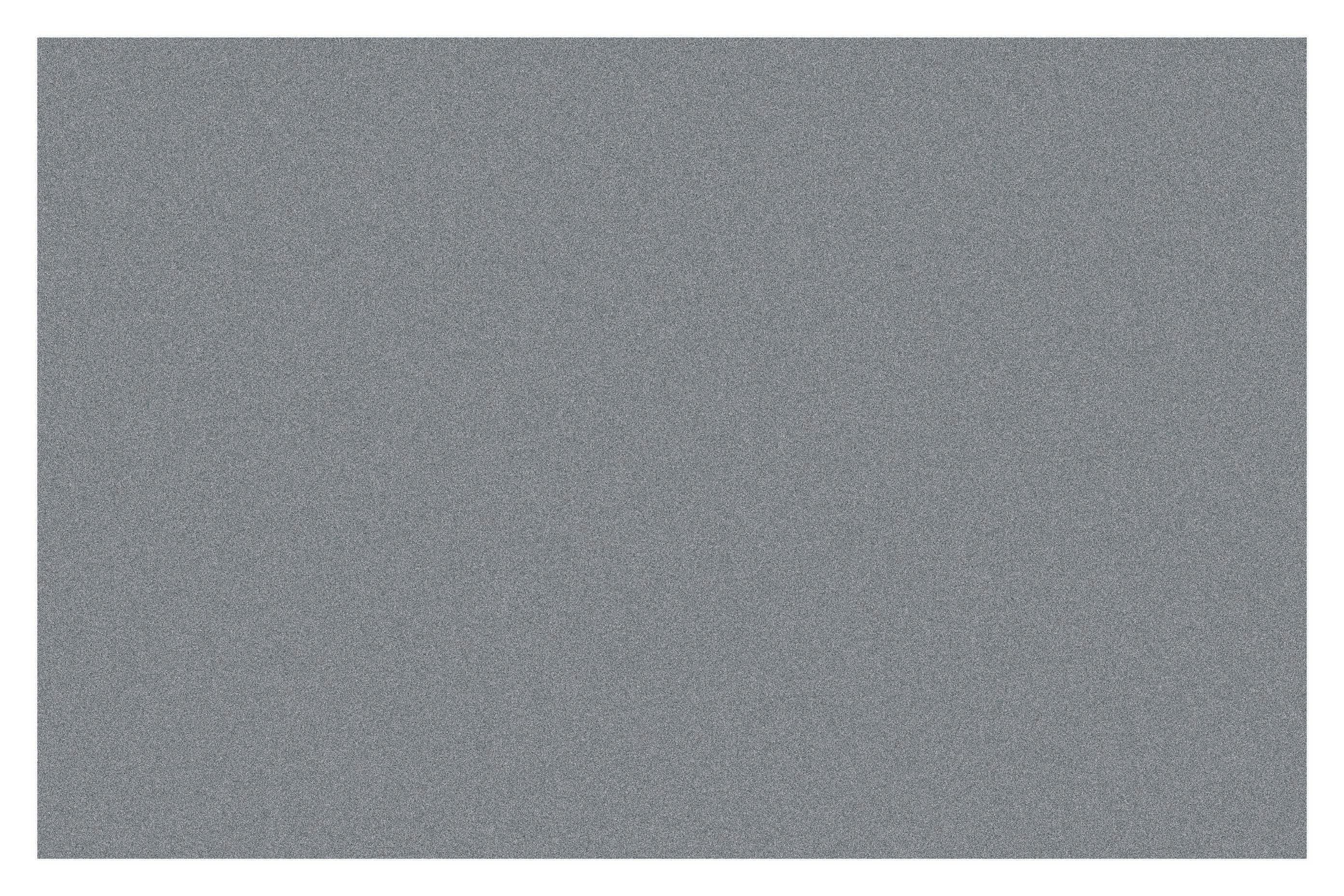
I stopped praising the holy water on my nightstand and turned to IV pumps and vac cinations.
God is relied upon because of his omnipo tence — his ability to solve the problems mere humankind cannot. Yet in the modern world, humans have inched closer and closer to the miracles of divine power once figured impos sible by the creators of the Bible. Is the cre ation of cures to diseases like polio not akin to Jesus curing a man with leprosy? When hu mans provide better solutions than God him self, God feels as if he may almost dissipate from our reality, becoming irrelevant the day we gain the ability to solve all the problems humankind once could not.
From the dawn of our creation, humans have been defined by our struggles. By war, disease, and disasters. We are defined by our tragedies — take a look in a history book to verify it. But God? He is defined by his lack of tragedy. His lack of struggle. His all-consuming power.
It is this power differential that necessitates faith in religion.
Already, analysts and researchers are tracking the decline of religion in the modern world. From 2007 to 2020, 49 countries representing 60% of the world’s population had a decline in re ligion, this decline most apparent in high-in come countries. In these high-income coun tries, as technological innovation persists and presents as the cure to all ailments, belief in religion declines in response. When granted unlimited access to modern solutions, people lose the need for religion, now faithful to technology to fix their problems instead.
The largest form of this shift away from reli gion took place in the United States. For de cades, Americans have been a prime example of the idea that modernization and religios ity can coexist. Despite this pious image, the American public has been moving away from religion even more rapidly than other coun tries in recent years.
Although there are several forces driving this trend, the downfall of religion in America — where innovation runs rampant — signifies something greater about the struggle be tween innovation and religion: They cannot, in fact, coexist in modern society.
42 spark
“I stopped praising the holy water on my nightstand and turned to IV pumps and vaccinations.”
When I discovered the divine nature of chemotherapy and IV tubes, religion dissipated in my life. Technology began to pre vail.
As I’ve lost my faith in religion, I’ve become grounded in the roots of reality — to my detriment. Technology is wonderful in so many ways, allowing us to constantly improve our lives, transforming and redesigning at every step. Yet the loss of reli gion has placed an indescribable burden on me.
Now, when I wake up from a nightmare, I have no peaceful sol ace that comes from a simple gesture, no sense of calm that comes from the splash of divine water across my face. Instead, I must have faith in myself to remove the jarring images from
my mind, doing breathing practices as I lie in bed, at tempting not to wake my roommate.
Perhaps in my haste to engross myself in human kind’s creations, to solve all of my ailments and strug gles, I’ve lost something else. Maybe hope, or naivety. I’m not quite sure. What I am sure of, though, is that since I’ve removed the cross from my room and the holy water off of my nightstand, there’s an emptiness that sits in me when I struggle — a sort of suffocating burden that God can no longer take off my shoulders.
When posthumanism erases our need for faith, I am unsure whether or not we will mourn our loss of di vinity. In order for humanity to achieve its apex form, I must stab my Creator in the back. Am I not stabbing myself in the back as well though? By eliminating the need for prayer, I lose the solace and peace I gain from it too.
The face of God will change from scripture to anima tronics, the Bible turning into an instruction manual. The Machine will become my new faith, tying down with it my ability to find peace in what I turn to. The Creator’s bible can be morphed, turned into a cod dling blanket for all of my worries. But the Machine’s instruction manual has no ambiguity, full of ones and zeros that spit out one definitive answer.
While an instruction manual is clearer, can humanity be extracted out of it?
Only time will tell. ■

43 deathless
“In order for humanity to achieve its apex form, I must stab my Creator in the back.”
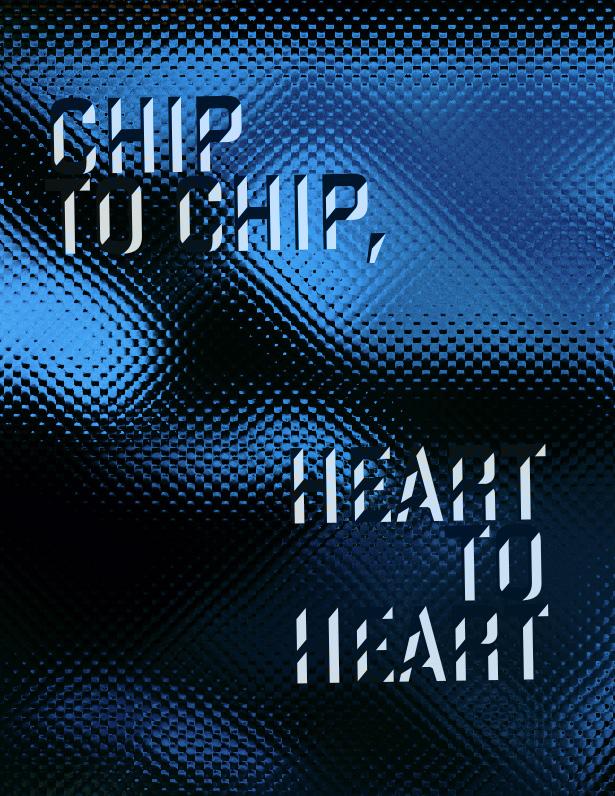 layout VYVY LE photographer RACHEL KARLS stylist YOUSUF KHAN hmua LEAH TEAGUE & CLAIRE PHILPOT models JILLIAN LE & LAURENCE NGUYEN-THAI videographer MOISES ZANABRIA
layout VYVY LE photographer RACHEL KARLS stylist YOUSUF KHAN hmua LEAH TEAGUE & CLAIRE PHILPOT models JILLIAN LE & LAURENCE NGUYEN-THAI videographer MOISES ZANABRIA
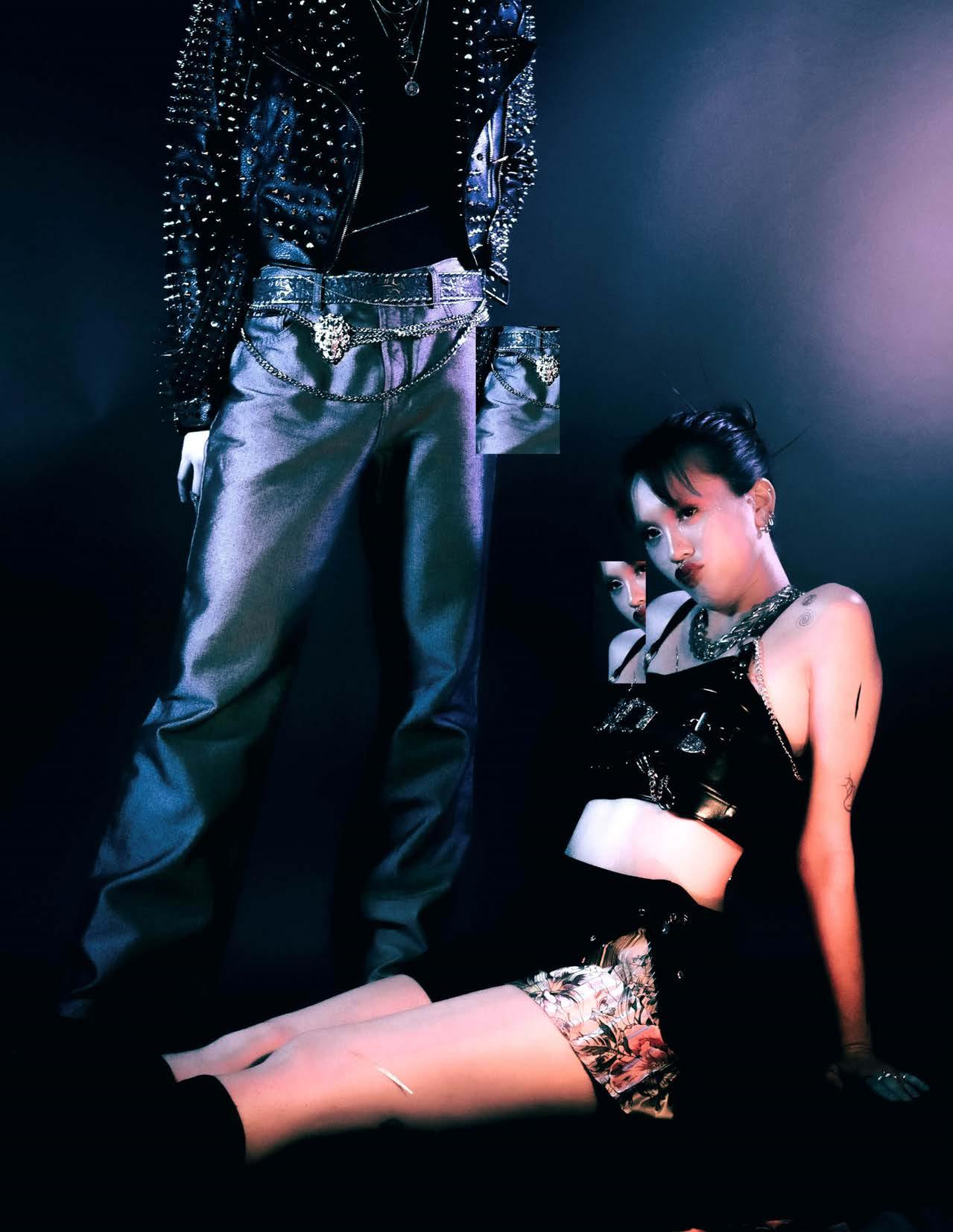
45 deathless
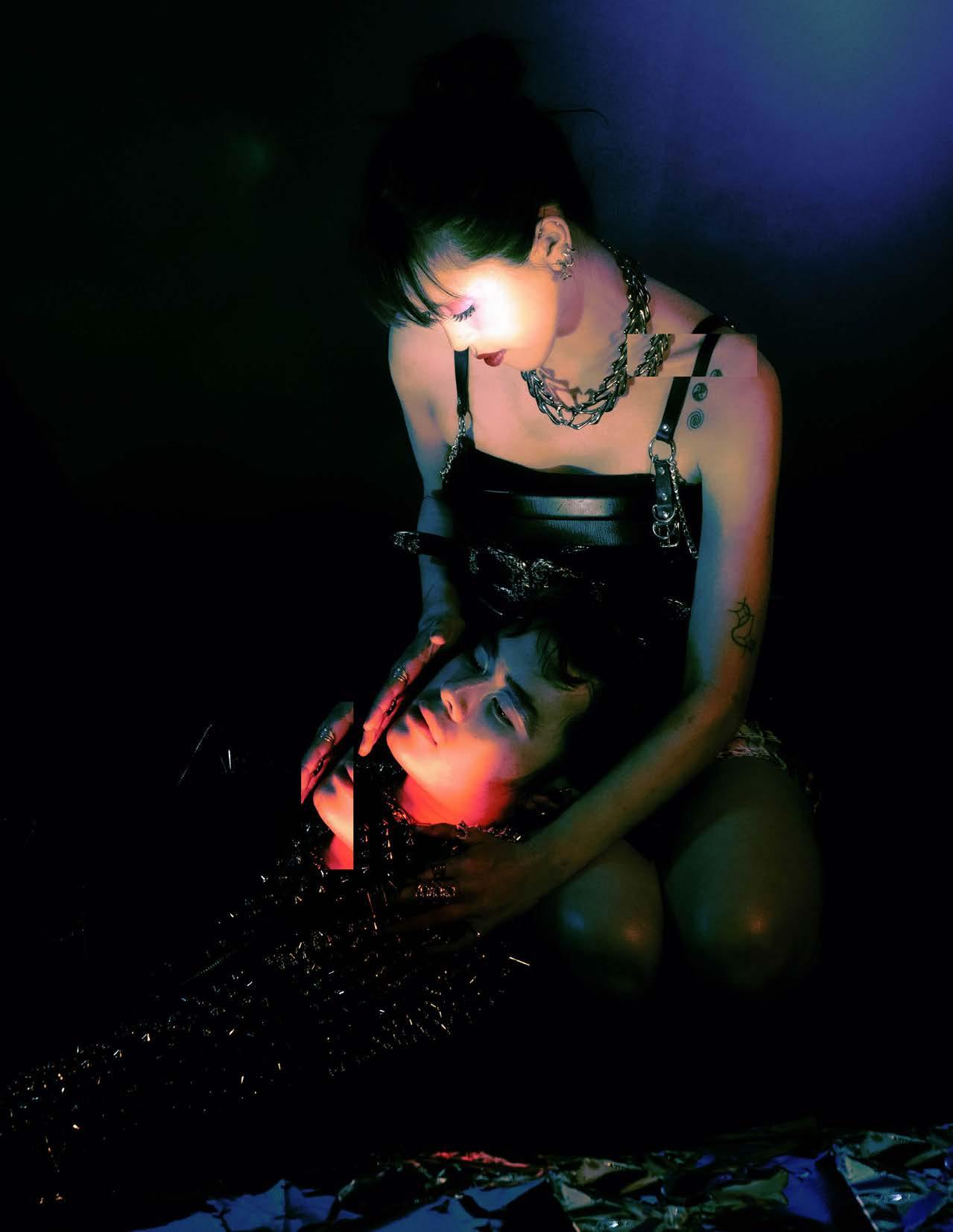
3 BELTS | Revival Vintage 2 BELTS | Flamingos Vintage Austin 1 BELT | Big
Paradise 46 spark
Bertha’s

47
LEATHER SPIKE STUDDED JACKET | Big Bertha’s Paradise
deathless

48 spark
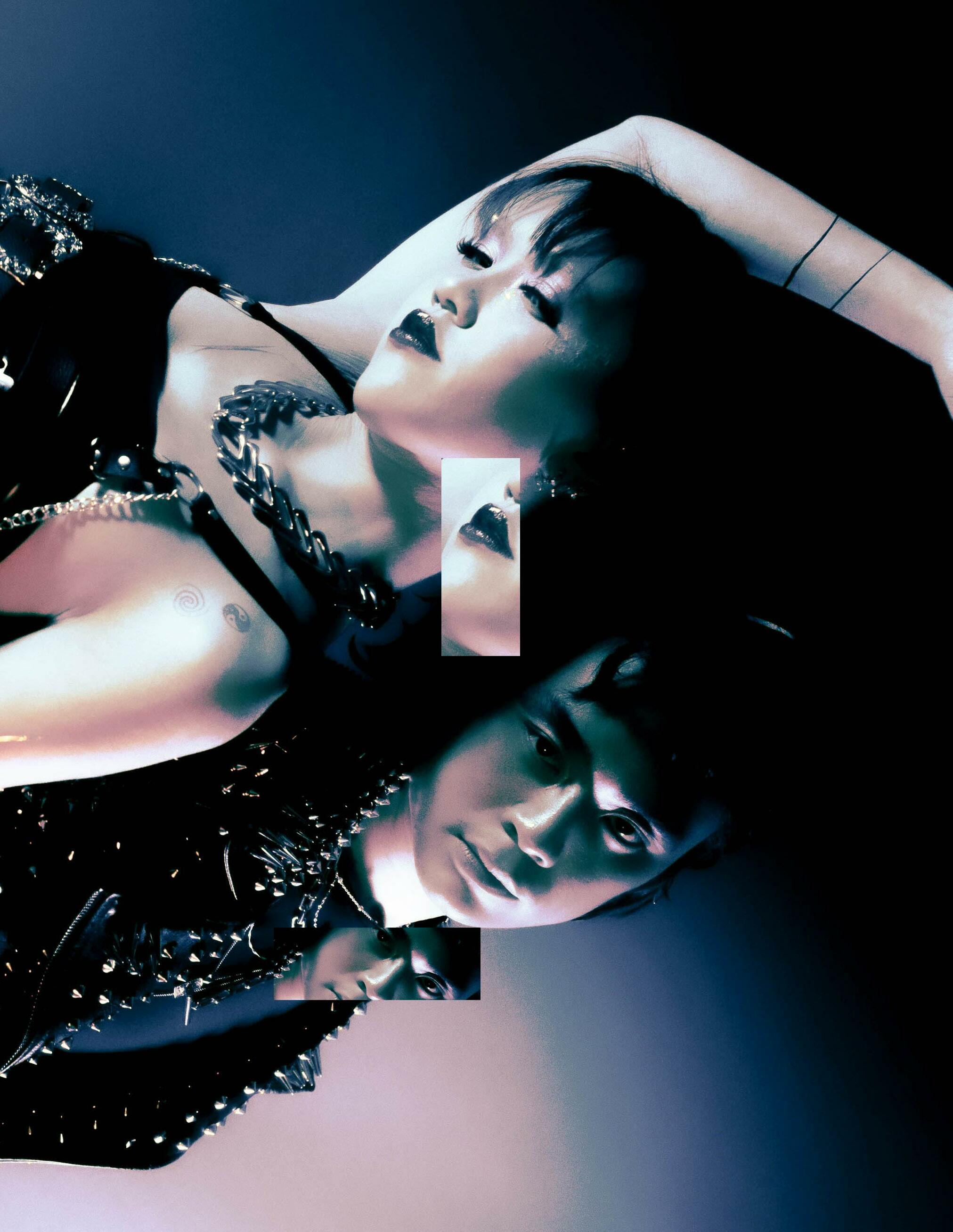
49 deathless
by SAFA MICHIGAN layout EMELY ROMO


This week, a hot new bombshell enters the villa. We don’t know if she’s here for money, for fame, just for fun, or to quell an aching desire for human connection, but sit back, relax, and watch how everyone is going to pick her apart. Will you relish it?
Each June, five single men and five single women specially selected for a summer of love descend upon an island villa, ready to spend the next eight weeks lounging in their swimsuits with only each other’s company.

They are not permitted outside contact until it’s time to meet the families. No books, no magazines, no media at all. Conversation topics are limited. Communication is monitored. All day is spent wait ing for instructions from the gamemakers. They are told when it’s time to participate in erotic (as hot and heavy as cable television allows) challenges, when it’s time to go on dates, when it’s time to recouple, when it’s time for a new bombshell to enter the villa and shake up established dynamics, and when it’s time for the infamous Casa Amor. During this climactic point each season, the remaining women and men are separated into different villas, and a fresh set of men and women (respectively) are sent in to generate chaos and test existing couples’ loy alty. The show is like a live-action dating app, from the coupling ritual that takes place at the beginning of every season, to the constant introduction of new faces, to the recoupling ceremonies.
In heavily edited footage excised from over a thou sand hours of observation, the contestants perform for the cameras and for audiences at home who will decide their fate. They prove that they’re in love, or they prove that they’re interesting enough and, therefore, worthy to continue on the journey.
This is the general premise of any season of the Brit ish reality television series Love Island, now with American and Australian spinoffs. The original it eration of the show featured celebrity contestants. The series was unsuccessful, however, until a re brand that nixed the celebrities and opened appli cations to the everyday man or woman — as long as their gender identity is palatable to the dominant

culture and their physical attractiveness is rooted in European beauty standards maintained by the racial homogeneity of the mostly white cast. Contestants of color are often invisibilized or tokenized in the court ing process, but it’s especially gratifying when they find what seems like a genuine connection. It’s espe cially disappointing when they’re voted off.
Inextricable from the appeal of the show is its tropical setting and the flashy colors characterizing the villa’s decor. It’s an escape from the humdrum of late stage capitalism or the boredom of a loveless life, a respite from the unfulfilling game that is modern dating. On one level, the contestants are competing for money, wherein partly lies the commodification of love that fuels the show’s appeal to the public, but the produc ers are also getting rich off of love as a construction. Under technocapitalism, love is entertainment, and it’s a pipeline to wild success as an influencer.
Seventy-three surveillance cameras adorn the villa, even in the large shared bathroom. We accept this invasion of privacy because the contestants techni cally consent. Consent is complicated by the fact that they have no influence over what is eventually broad casted to the public.
On Love Island, reality and fantasy blur into a frothy concoction of exhibitionist delight, and I, the voyeur, tune in for the chance to drink it in, along with mil lions of others.
We become emotional voyeurs because we are des perate for connection. Our voyeurism derives from a place of empathy and fundamentally, a fascination with the human condition itself. The Love Island villa operates as a laboratory experimenting on the spec trum of human emotion. Research questions: How does temporality shift when you remove daily dis tractions like media consumption from the equation? What happens if you drive a person just a little mad?
51 deathless


52 spark
“On Love Island, reality and fantasy blur into a frothy concoction of exhibitionist delight, and I, the voyeur, tune in for the chance to drink it in, along with millions of others.”
The villa is a microcosm of the larger state of human interaction in the age of technocapitalism — in other words, it reflects how the rest of us love each other, surveil each other, pick each other apart, and even kill each other. The show’s former host and two former contestants have committed suicide, re vealing the tangible consequences of love under surveillance.
The consumption of reality television is an exercise in determining what is genuine and what is an illusion; we find delight in discerning between organic conversation and semi-scripted dialogue, between love and lust, be tween primal emotional outbursts and theatrical performance. The act of viewing is also a process of creation: We create authenticity out of unclear, murky moments in a parasocial projection. We pretend we know the contes tants and that we know what’s best for them.
In one retelling, 18th-century English philosopher Jeremy Bentham har bored good intentions when he invented the panopticon. His system of so cial control was initially designed to uphold prison as an idealized site of reformation.
Within a panoptic structure, a single authority figure presides over incarcer ated individuals from a watchtower in the center. Those incarcerated are unable to discern when exactly they are being watched, so even though they know it’s physically impossible for the warden to observe them all simulta neously, a sense of paranoia seeps in, forcing them into what Michel Fou cault calls self-regulation.

The Love Island villa is a glossy, colorful panopticon out of Jeremy Bentham’s wildest dreams. On Love Island, producers and editors are the few wardens observing the many through a sophisticated system that ensures control. As I watched Love Island USA season four last month, I noticed one particularly jarring neon sign among the kitschy collection decorating the villa: “ALL EYES ON ME.”
At the inverse of panoptic surveillance lies synoptic surveillance, through which the many watch the few, made possible by the rise of mass media, cable and streaming television, and the Internet.
Millions of people debate contestants’ every conversation and every facial expression from the comfort of their own living rooms thousands of miles away, yet are deeply invested in their actions. They tweet and post on Red dit. Producers even show contestants select social media posts. After the show ends, former contestants build livelihoods out of their success, nego tiating brand deals, becoming influencers, and capitalizing on the synoptic surveillance they experienced.
The interactive structure of the show allows us viewers to play gamemaker, and we even get to play God. As citizens of a surveillance state, we have long tried to harness His eyes. Through our role in this synoptic system of con trol, we are able to reclaim omnipotent power, even if for only the moment it takes to vote someone off the island.

53 deathless
In one sense, the few watch the many in the villa; in another, the many watch the few. The structure of Love Island allows panoptic and synoptic surveillance to work as syner gistic systems of control, but they are com plicated by an interesting phenomenon: the watched watching each other. In other words, those coerced into self-regulation also regulate the behavior of those around them, replicating the surveillance practices they endure together unto one another.
What’s unnerving — and delicious — about Love Island is that the contestants volun teered to subject themselves to these multi plicitous layers of surveillance, anxiety, and paranoia. It’s a social experiment in which I often find myself wishing to participate, fantasizing about the decisions I would
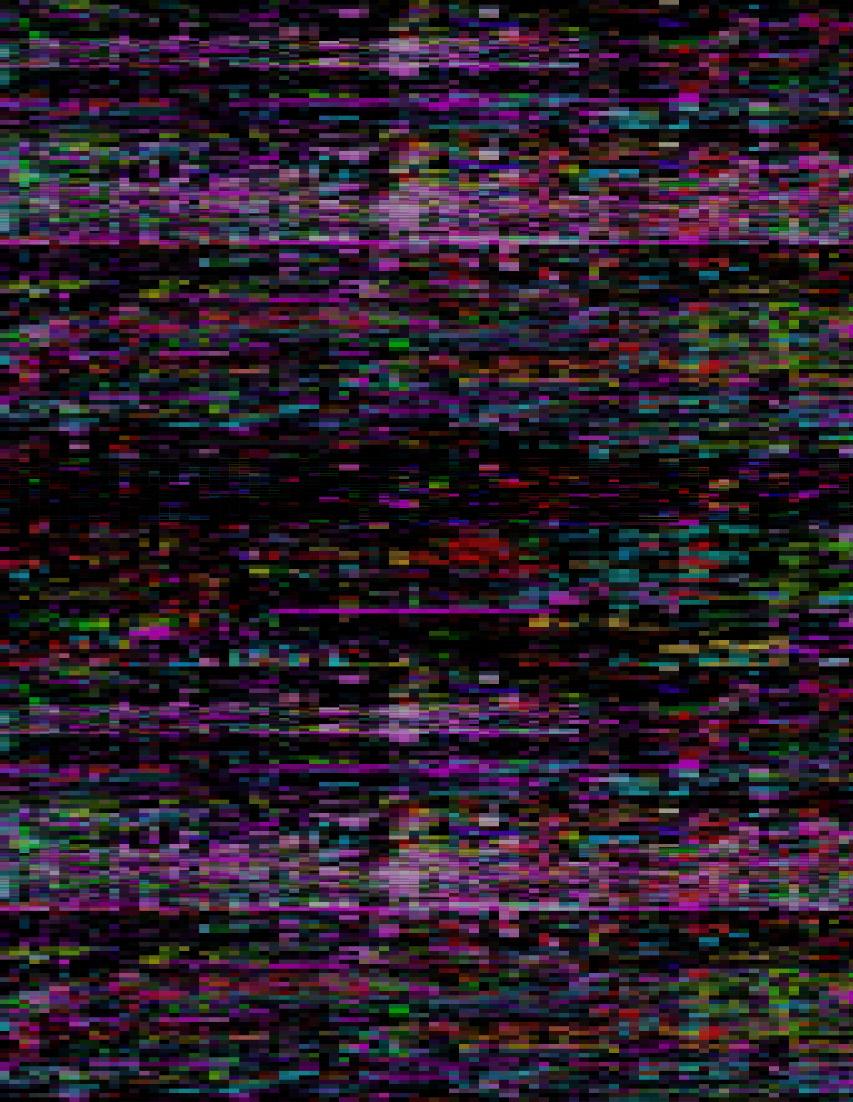
make, the strategies I would use, and the way I would present myself.
I, like the contestants, am also constantly watched and witnessed by both conspicu ous and unseen forces that influence, con trol, and police my behavior.
As a citizen of a surveillance state, I live under the watchful eyes of CCTV, secu rity cameras on every block, and biomet ric identification. There are 4.6 people per camera in the US, and once you’re cata loged in the system, it’s virtually impossible to erase yourself from it.
As a habitual social media user, I’m a consis tent practitioner of exhibitionism, a curator of experiences and memories. I was a child

raised by the Internet, an active agent in my own surveillance. For years, I broadcasted intimate details of my life to a “finsta” I let relatively un trustworthy people follow. When I experienced hypomania (before I even knew what it was), I found myself oversharing on Snapchat and Twitter. Lonely, I sought the mirage of close ness I thought public vulnerability could bring me. Online, I am also a voyeur, entertained and placated by illusory access to the lives of those I know well and those I don’t know at all.

As a woman, I endure the incessant attention of the male gaze, and I am repeatedly constructed under its exploitative eye. The women on Love Island experience this at its most exaggerated.
And on my worst days, when I desperately need the world to make sense, I am hyperconscious of the eyes of God. On those days, I feel guilty
about my decisions, as though the wrong ones I’ve made could sentence me to the eternal dam nation they’ve been warning me about since I was a child.
But the guilt often resolves itself, and through my characteristic refusal to self-regulate my be havior in spite of the threat of hell, I defy God. That doesn’t mean I’m unscrupulous. Morality doesn’t necessarily emanate from religion; really, it comes from within.
There are eyes on me all the time, real and imag ined. I can only hope they’re enjoying the show. ■
54 spark
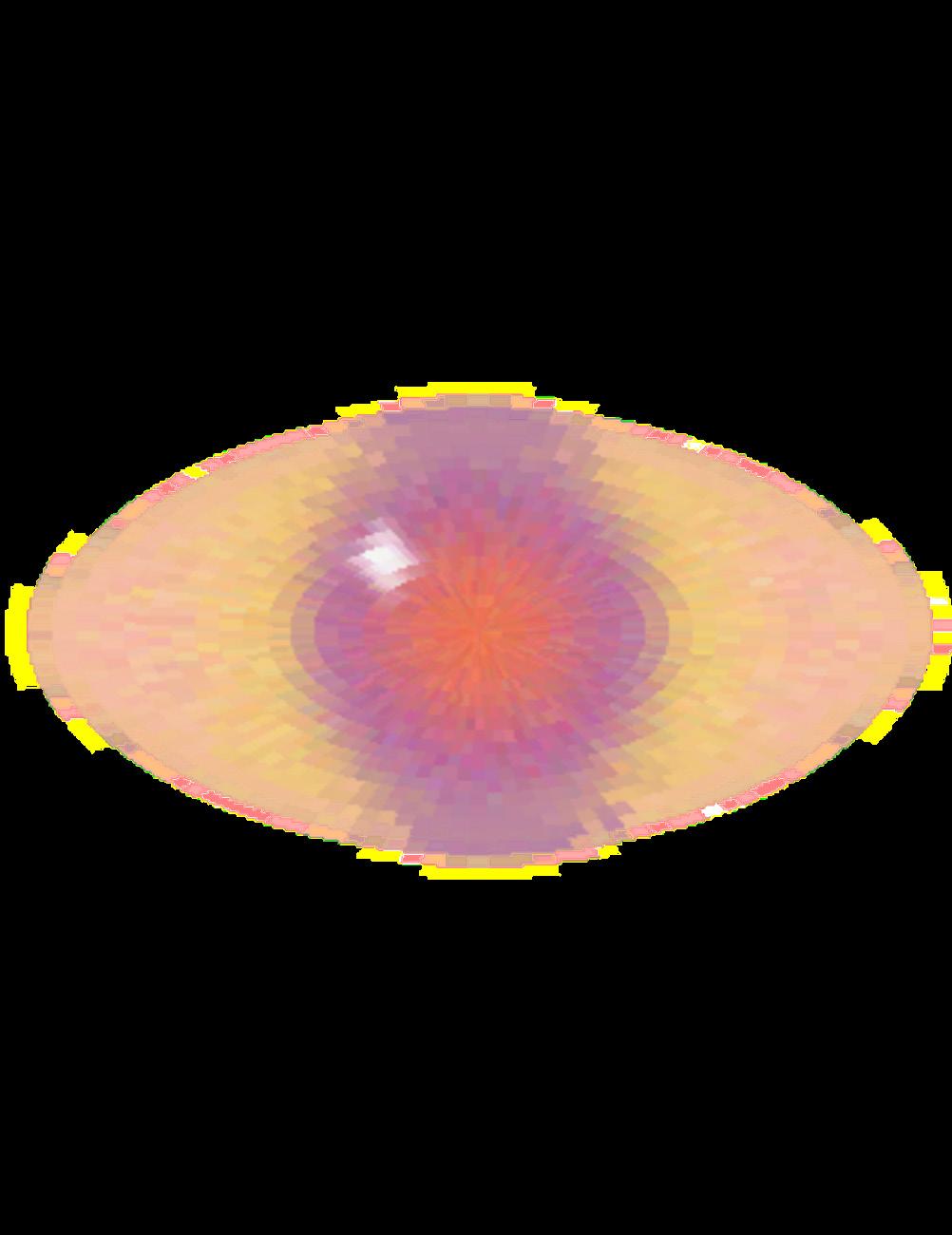

55 deathless
“Thereare eyes on me all the time, real andimagined . Ican only hope they ’ re enjoying the show. ”
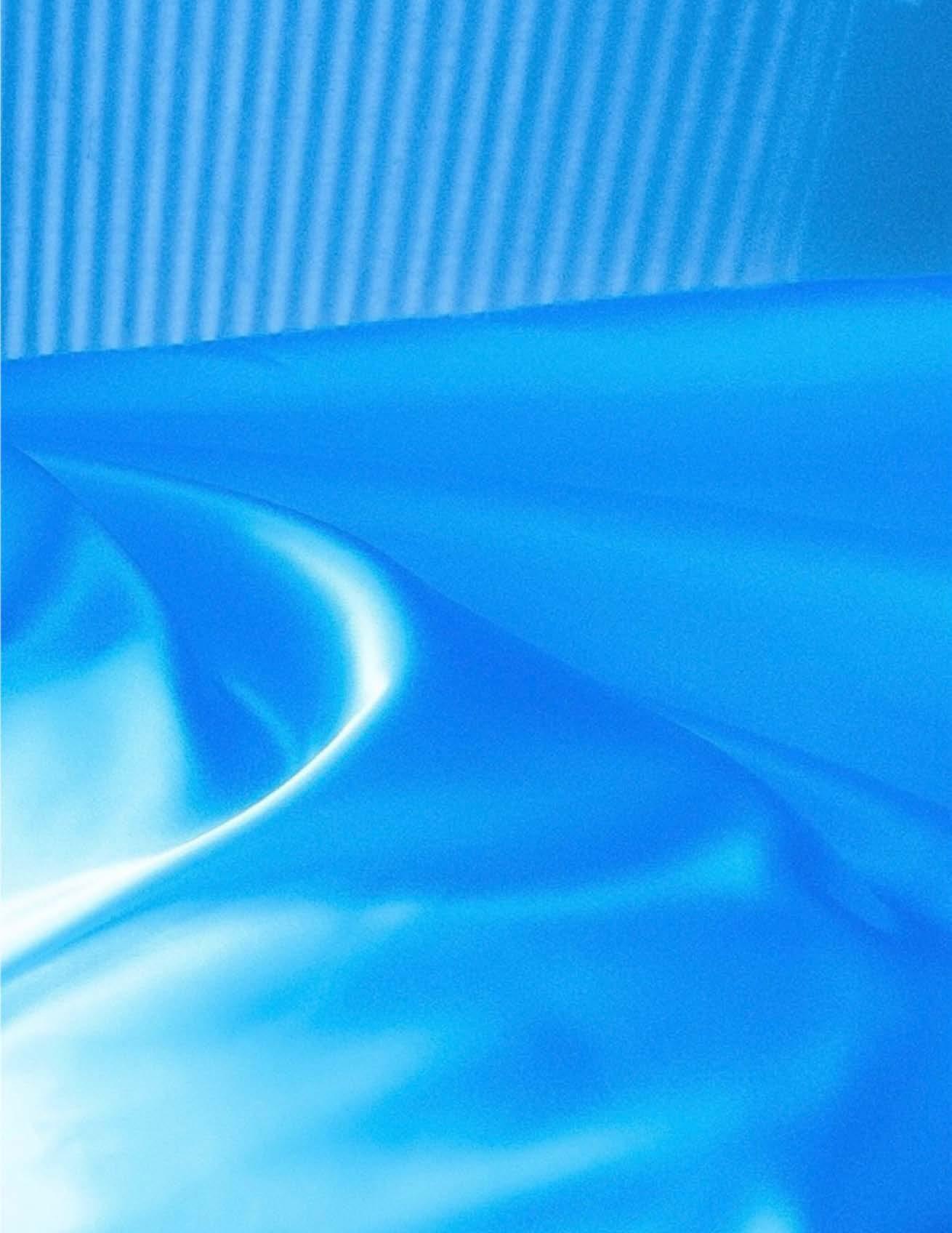
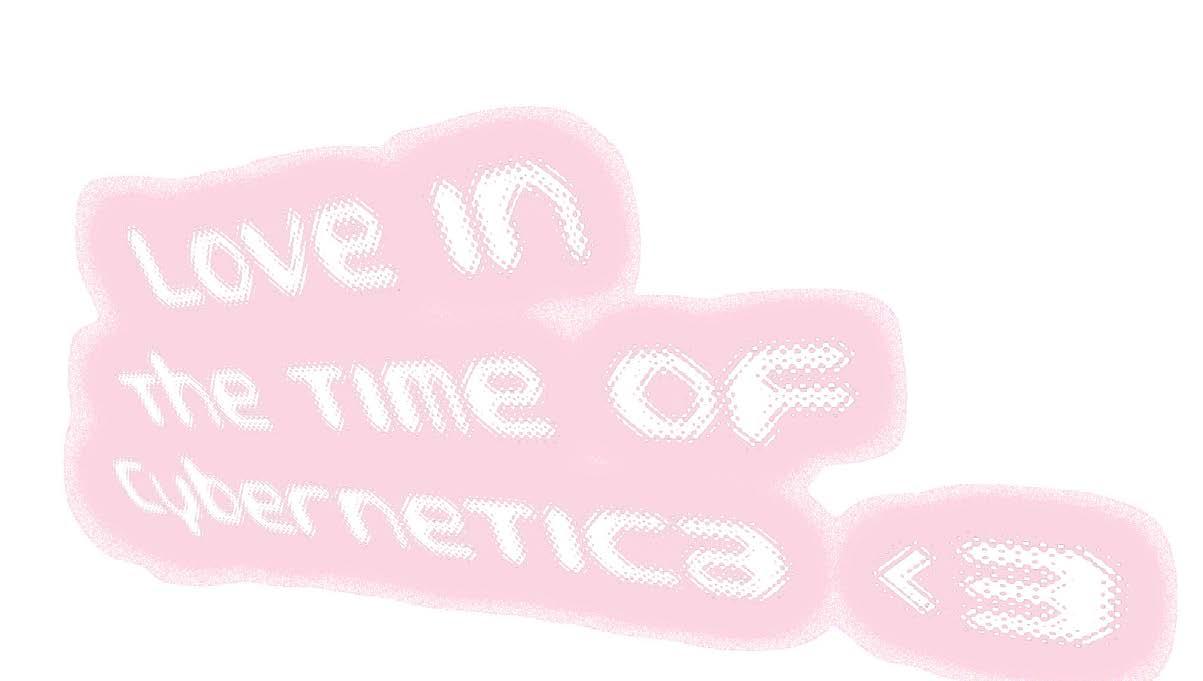 by CLAIRE TSUI
layout CAROLINE CLARK photographer ANNAHITA ESCHER stylist DAVID GARCIA hmua GABRIELLE DUHON model PRESLEY SIMMONS
by CLAIRE TSUI
layout CAROLINE CLARK photographer ANNAHITA ESCHER stylist DAVID GARCIA hmua GABRIELLE DUHON model PRESLEY SIMMONS
56 spark
“A sense of wrongness, of fraught unease, as if long nails scraped the surface of the moon, raising the hackles of the soul.” — China Mieville

 WHITE TOGA | David Garcia
METAL PLATE | David Garcia
WHITE TOGA | David Garcia
METAL PLATE | David Garcia
first sight sees, in a single glimpse,

Pygmalion and the sun crowned
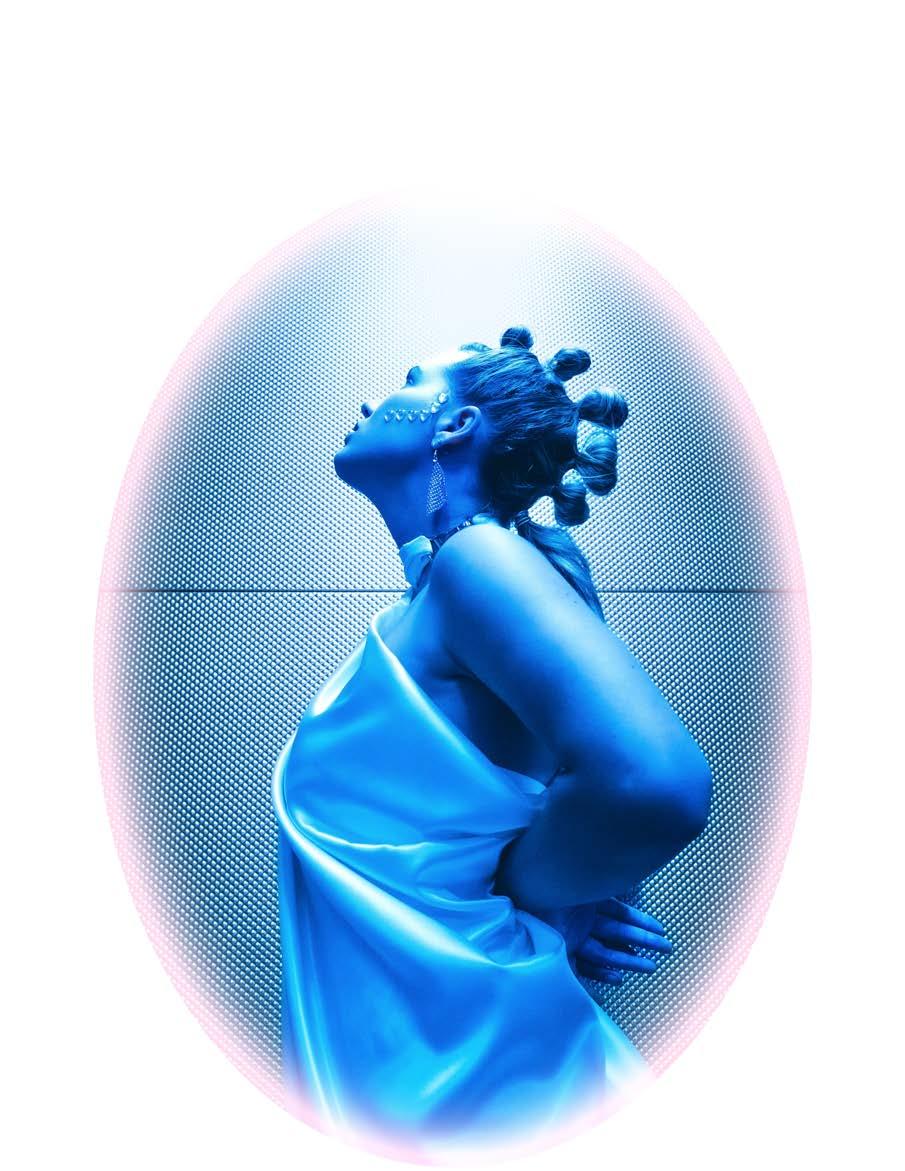
“Her
spark 58
behind his head.”
I: Galatea
Swathed in silks and linens stands an ivory maiden. She is struck in a pose of effortless grace, her lips pressed shut and her gaze lowered in gentle demurity.
Before her stands her sculptor, king Pygmalion. Notorious for his disdain of the lusty women in his realm, Pygmalion sought to create one of his own. One hewn to his tastes, whose eyes could see no other, and could thus belong to no other. With a half-curled hand, he traces his fingers along the cut of her cheek, his eyes roaming over her exquisitely carved face in raptured silence. He marvels at the pearlescent beauty of his work, as pale and otherworldly as the moon.
Perfection, he thinks. She is perfection incarnate.
Yet like the moon, the maiden remains stonily out of Pygmalion’s reach. Her fingers are cold and stiff, her ivory flesh unyielding to his touch; lovely as she may be, he cannot truly be with her.
Driven to obsession by his inability to have her, Pygmalion finally beseeches none other than the goddess of love herself.
To turn men into stone is the power of Me dusa, but to turn stone into woman is Aph rodite’s. From high above in her heavenly chaise, she observes, with detached amusement, the small mortal man currently knelt before her pyre. Resting her chin upon a delicate hand, she leans over the clouds to hear his pleas and to determine whether his heartache is worthy of her time. As she listens, her lips twist wryly.
So this is how mortals love, she hums to herself. He has fashioned himself a dumb, mute, beautiful statue, and now he wishes for it to become his dumb, mute, and beautiful queen.
But she sighs obligingly and casts her voice to the earth, where it spirals down from the vaulted ceil ings of the temple into Pygamlion’s ears. Amidst the smoke and savor, she tells him to return home and embrace the statue, that he will see it become
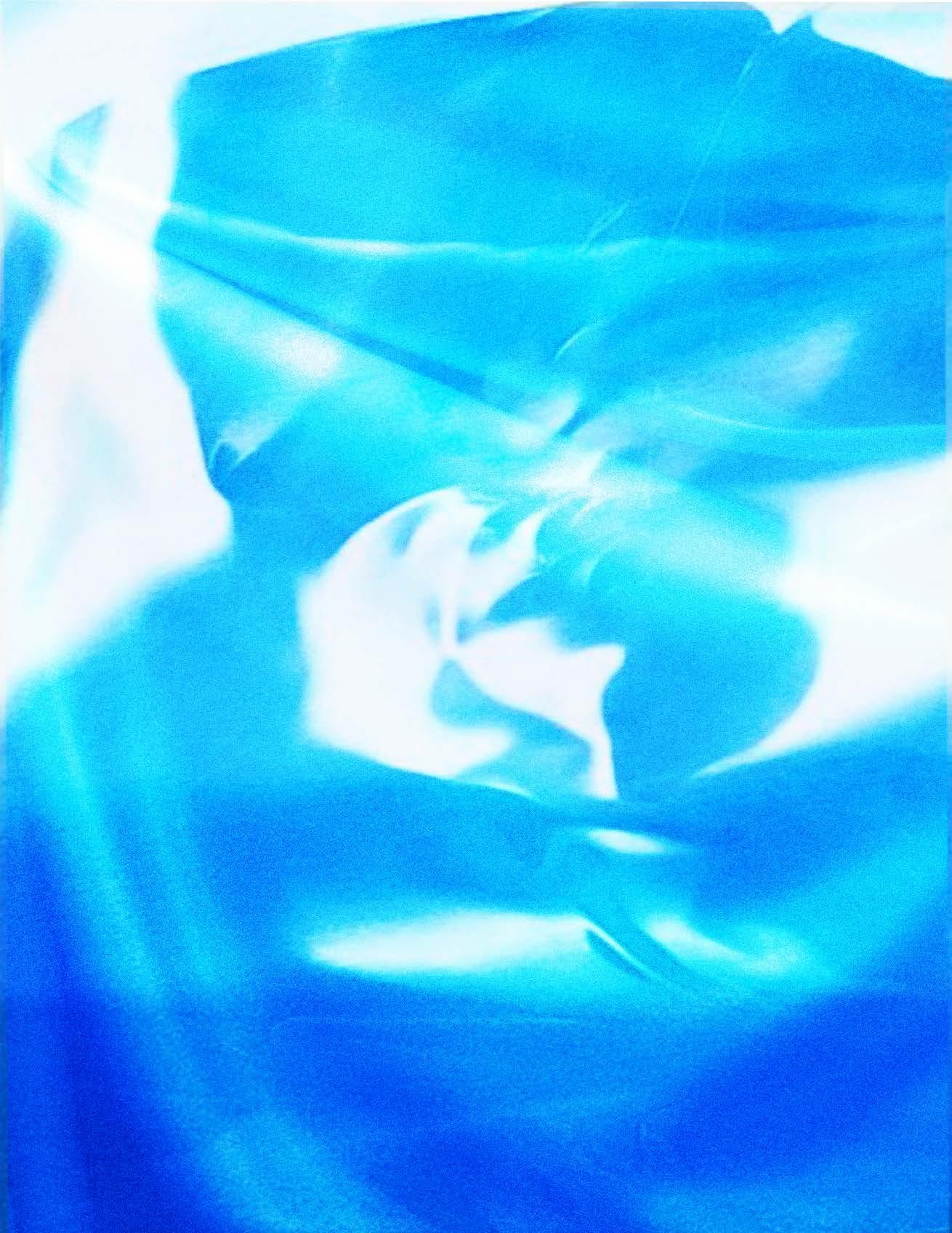
a maiden in his hands.
Pygmalion rushes back to the pavilion in excited haste. Throwing himself upon the statue, he gathers it into his arms and seals its ivory lips with a kiss. When he draws back, he sees lips flushed red with life-blood and a maiden of flesh and bone. Her skin is still pale like the moonlight, and he watches, entranced, as she raises her dark eyes with the shyness of a newborn fawn. Her first sight sees, in a single glimpse, Pygmalion and the sun crowned behind his head.
Beheld by her wide, innocent eyes — filled with nothing but him and the heavens above — Pyg malion knew he could love no other.
II. Ex Machina

Myth is enlightenment, and our enlightenment returns to myth.
The desire to artificially cre ate another being, one that is bent to our will, is rooted in narcissism, a hubris tic hunger to play god and build in our own image. In this era of biotechnology and artificial intelligence, it is more pos sible than ever for men to become postmod ern Pyg malions. Now, instead of smooth ex panses of ivory, their lovers possess lithe, flexible torsos supported by metal frames, chrome limbs wrapped in synthetic collagen — sleek and shiny, like a boy’s novel plaything.
Those who claim the superiority of the gynoid over the human woman cite its ability to be our perfect lover. Programmed to our unique tastes, the gynoid self-adjusts like a personal thermostat to meet our needs. By analyzing our behavior, it adapts accordingly to our hot or cold to never frus trate, disappoint, or betray us. The gynoid would be devoted to their
59 deathless
express purpose of fulfilling us sexually and romantically, utterly compliant and selfless with no needs of their own to burden us. They are, in all senses, born to love us.
But it is only a certain breed of man who fancies this notion of artificial lovers — one which holds an idealized notion of femininity and desires the glamorous idea of a woman more than an actual woman. For the so-called love that he espouses is nothing but a perversion of it; he dreams of a woman tailored to his preferences whose sole aspiration is to pleasure him, with no dimension or autonomy of her own. What he fantasizes is not love, but sexual servitude.
Pygmalion’s beloved pearly maiden was likewise a mere projection of the artist’s fanta sies, a hollow cast of a woman sculpted to his beau idéal. The myth never deigned to grant her a name, so one was given to her post-canonically: Galatea — she who is milk-white. A re flection of her physical beauty and nothing more. When brought to life, she remained a woman in body and appearance only — a perfectly-posed statue of feminine beauty and submission with no words, autonomy, or any humanizing grace of her own. Yet herein laid her appeal to Pygmalion, for what he loved was not a woman but an unattainable ideal of femininity.
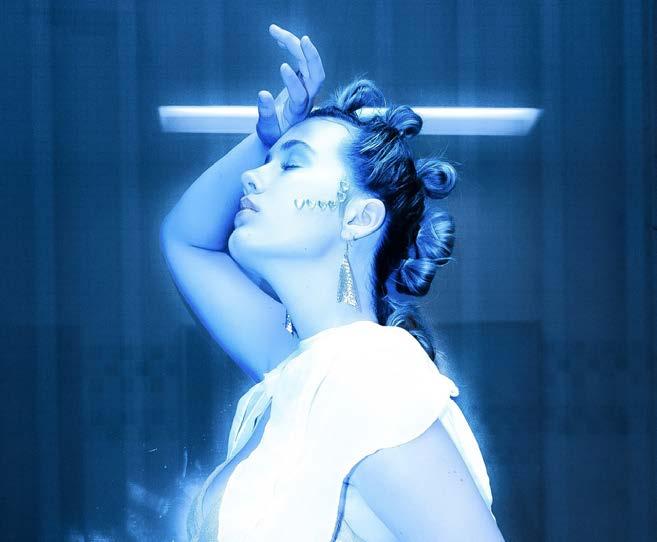
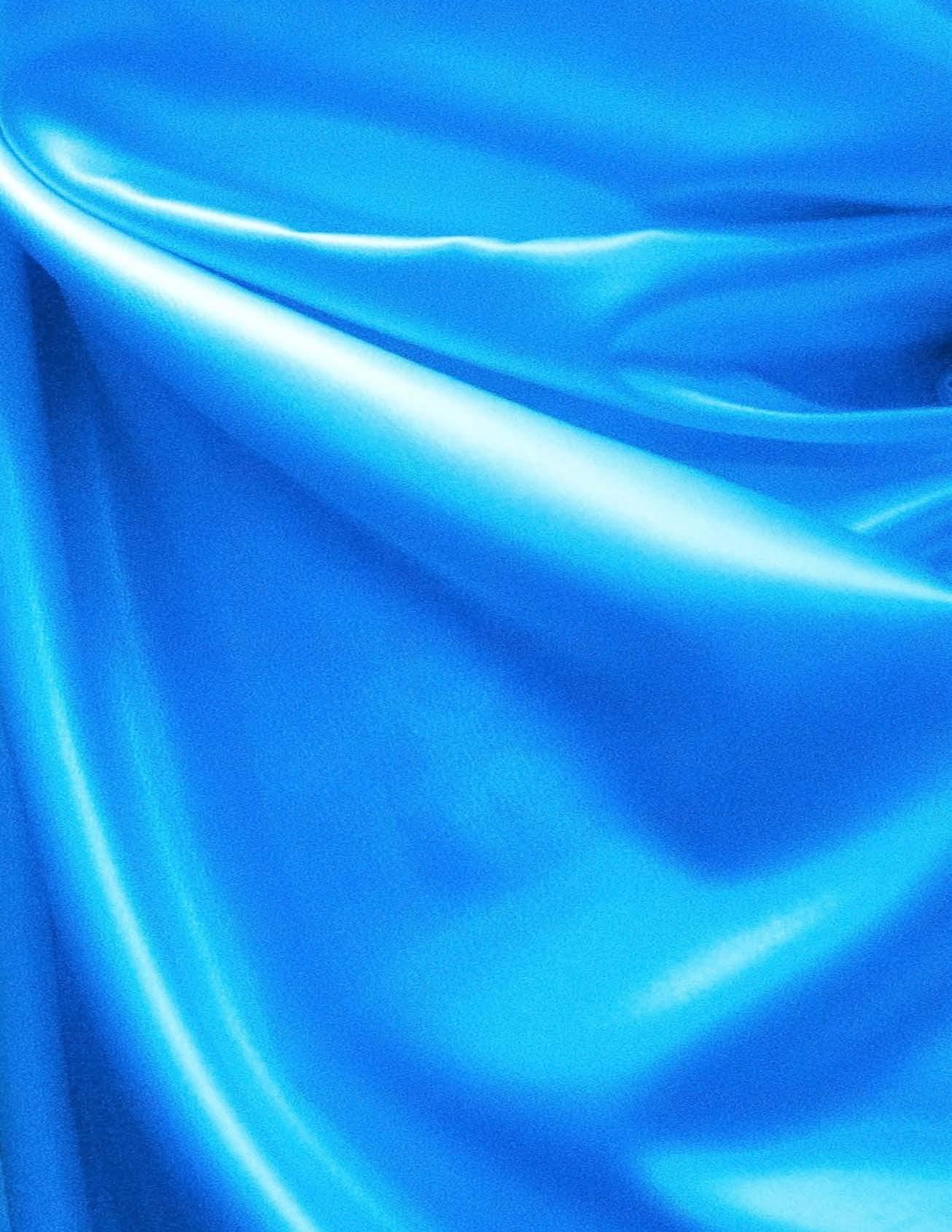
Pygmalion scorned the women of Propoetides because of their lustiness and unabashed sexual liberty. He desired a woman who was pure yet erotic in appearance, chaste and sexless to all men except for him. She was, in a sense, a reflec tion of Pygmalion’s masculine narcissism.
The worldly man and the innocent, wide-eyed virgin — a dy namic of power that has long been exploited by men. They relish the gratuity of unwrapping their shiny new toys, in the power of being the first to claim the untouched and unsul lied.
Then again, love has always been rooted in a sense of own ership. The most primordial act of love we know, after all, is in the act of establishing our claim upon another and de claring to the world that they are ours.
But that is not the case for the postmodern Pygmalion. Love between a man and his artificial lover is nothing short of domination. The artificial lover is a vehicle of submission, over which man exercises his lust for total control. Love de generates from being a dealing between equals: It becomes subjugation.
Man and wife; creator and creation; master and slave. To Pygmalion, Galatea was the masterpiece that belonged to him utterly and exclusively. She could never be allowed to have autonomy, for that was to give her independent will, and to give her independent will was to give her the free dom to love or leave him as she pleased.
Such are the consequences of granting artificial lovers hu manization without humanity. Empathy and respect for women degrade as a whole, as man learns to see his femi noid counterpart as servile property over which he is en titled to govern. Yet the great irony of it all is that man still desires a lover who appears, in all senses, to be a woman. Just as Pygmalion prayed for his ivory maiden to become flesh and blood, we, too, installed our gynoids with artificial intelligence, synthetic skin, and a woman’s face. Man wants all the physiological sensuality of a woman without bearing the effort of being with a real one. It is easier, after all, to pretend his lover is not just a programmed slave when she looks and acts utterly human.
It is pointless to ask what will become of love and intimacy in such a future. There exists no world in which human ity holds power and does not inevitably abuse it; in giving man the power to create and control an artificial lover, one would be naive to imagine an ending in which he does not exploit that power.
In a posthuman future where love becomes synonymous with subjugation, the fate of mutual love and intimacy hov ers at the edge of a dark and almost certain precipice — for there can be no happy endings in a world where a man

60 spark
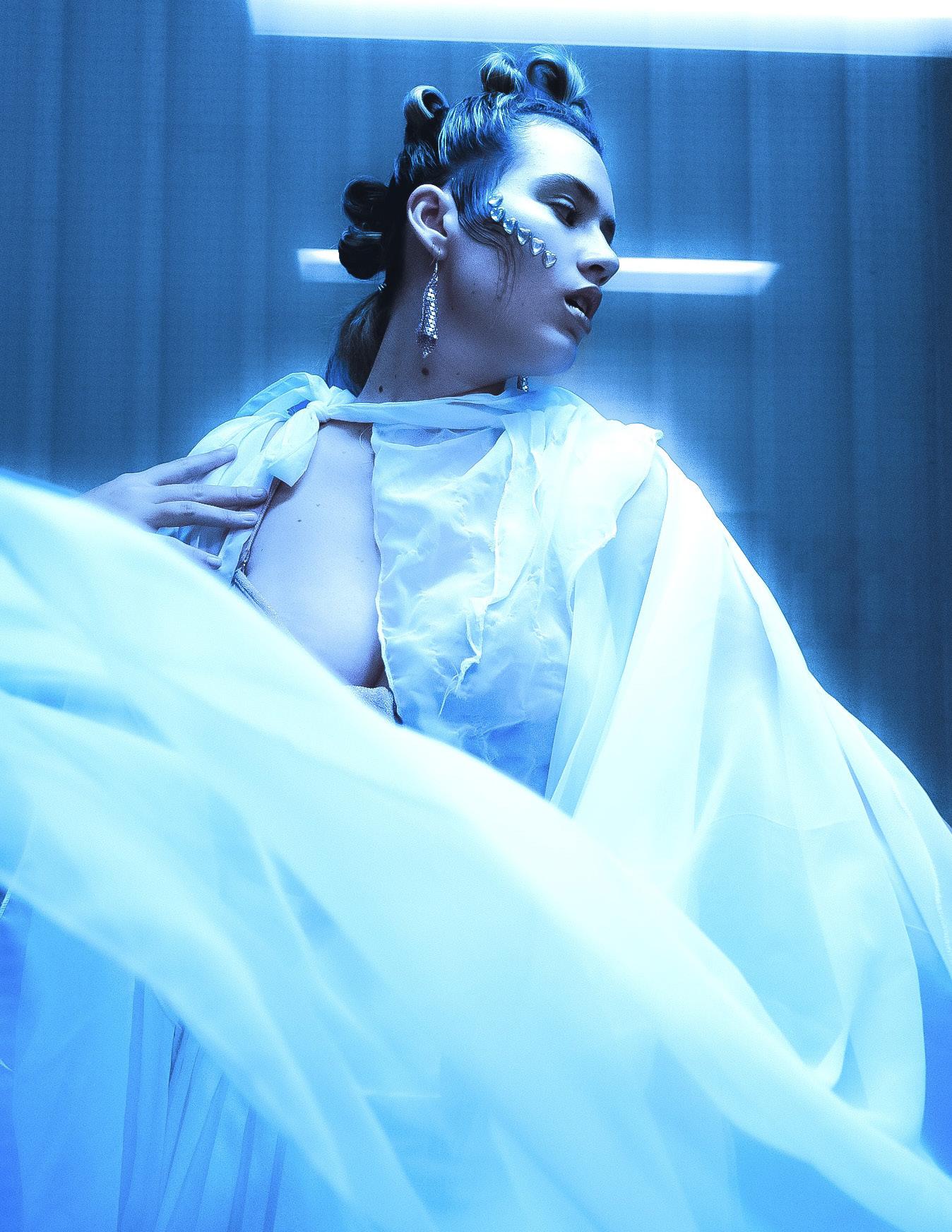

61 deathless
“Myth is enlightenment, and our enlightenment returns to myth.”
E C
BIO D BAU ERY H
The soil and soot taste familiar. You and I have lived here before.
by KAMEEL KARIM layout AVA JIANG
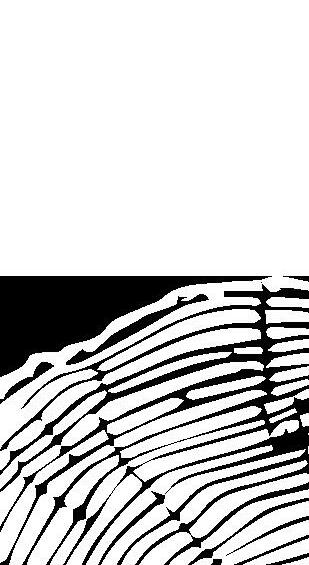
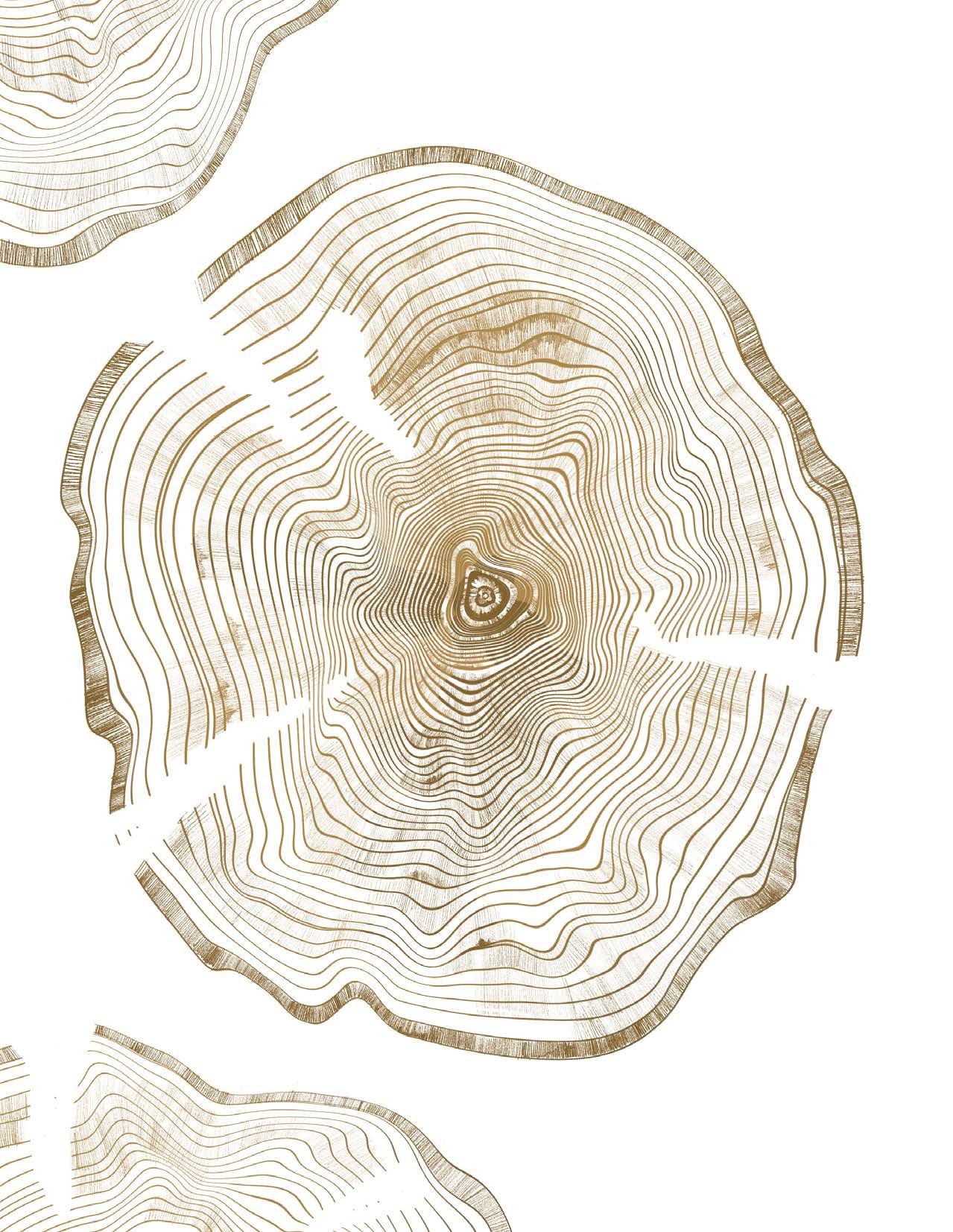
62
I.
THE HUNGER
In November of 2020, Google searches for the term “cottagecore” reached an all-time high. The COVID-19 pandemic had been ravaging the world for almost a year, and millions pined from their bedrooms for landscapes of pastoral virtue; for gingham skirts and jars of berry preserves; for the idyllic comfort of scattering chicken feed across the floor of the coop, one hand kneading at the pleasant ache in your lower back, looking out at an endless expanse of green.
It was a daydream patched together from ancestral memory. going to drop out of school to herd cattle on the argentinean pampas, I texted my friend. She responded, i’ll come visit when i have enough successors to look after the fruit orchard was the end of it. Never mind the fact that our predecessors had lived like this for thousands of years, and that the mastery of agriculture had reshaped the trajectory of human evolution. We had assignments due at 11:59. Someone, somewhere, retweeted a picture of Lirika Matoshi’s viral strawberry dress.
Cottagecore, like any aesthetic curated by the internet, is a romanticized collage of images cobbled together from disparate sources and baptized by users’ wishes to invent someone new. Being online in any capacity encourages the fabrication of a persona, especially if your accounts are public and even more so if you create content. Lovecore, cowboycore, fairycore. You paste heart stickers on your face and drape yourself in blush pinks to assume the glamor of Cupid’s children. You armor yourself in boots and leather, shivering in anticipation of the lawless adrenaline infused into old Westerns, or you brush your collarbones
it must be done. The metropolitan bubble can’t persist without this enduring labor, this ritual care.


Yet we who reside in cities continue on in our rhythms of banality, for as much as we collectively idealize the experience of spiritual connection with the mother planet, so too do we intrinsically categorize this yearning as fantasy. Capitalist systems position urban lifestyles as the practical standard and rural lifestyles as a whimsical ideal. The educated upper class float through glass high-rises or work remotely. Performing manual labor, therefore, they view as an anachronism only realistic for the poor, the hungry, and their forefathers who have passed.
Our “real” lives demand the sum of our attention from the moment we learn to speak until we can speak no longer. Maybe this is why we spend the duration of them anticipating our return to the earth.
63 deathless
IN THE

II. THE FAULT MOUNTAINS
Waiting in the wings of the desire to run away to a nondescript cottage in the forest is the quieter, darker wish to become a ghost. Cottagecore isn’t just idealistic: It’s selfish.
Villages and townships exist because of their residents’ obligation to one another. If one raises goats, another welds metal, and a third might trade his fresh-caught fish with both of them. When that kinship is stripped away in pursuit of anonymity and simplicity, rural life is flattened down to snapshots. You set a steaming meal on the table, but the chairs are always empty. You plant roses in the garden, but they waste away without anyone to pick them.
Junji Ito explores the repressed, sometimes sinister shadow of that longing to get away via his short story, “The Enigma of Amigara Fault.” In the exposition, people across Japan flock to the site of an earthquake that split open Mt. Amigara after seeing on television a number of holes tailored exactly to the contours of their own bodies. The protagonist watches in horror as individuals strip nude to enter the eerily perfect cutouts, overtaken by an urge to seek out what’s destined to be theirs. Ultimately, even the protagonist
succumbs to the mountain’s allure, and researchers months later are horrified to discover the bodies of those lost to the fault emerging — unrecognizably contorted, but unmistakably alive.
This desperate compulsion to enter the fault despite its forbidding nature illustrates man’s desire to return to the earth. At a glance, the holes offer nothing that civilization does: no comforts, no community, not even the promise of life. However, these factors may actually comprise the bulk of the seduction instead of detracting from it. Within the depths of Mt. Amigara, the pressures of the world external are stripped away. There is no obligation to labor and no fear of loss. In idealizing cottages, in aching for the mountains, we ask: What if it were enough to just — have been?
As popularized by the the notion of the emotionless, empty “void” in internet culture, the requirement of contributing to one’s surrounding society pulls in its wake a persistent exhaustion. However, escaping to the woods to live secluded from urban politicking is only two steps shy of flinching away from company altogether. The cost of solitude is silence — and, as Ito reminds us, perhaps our humanity itself.
64 spark
“The cost of solitude is silence — and perhaps our humanity itself.”

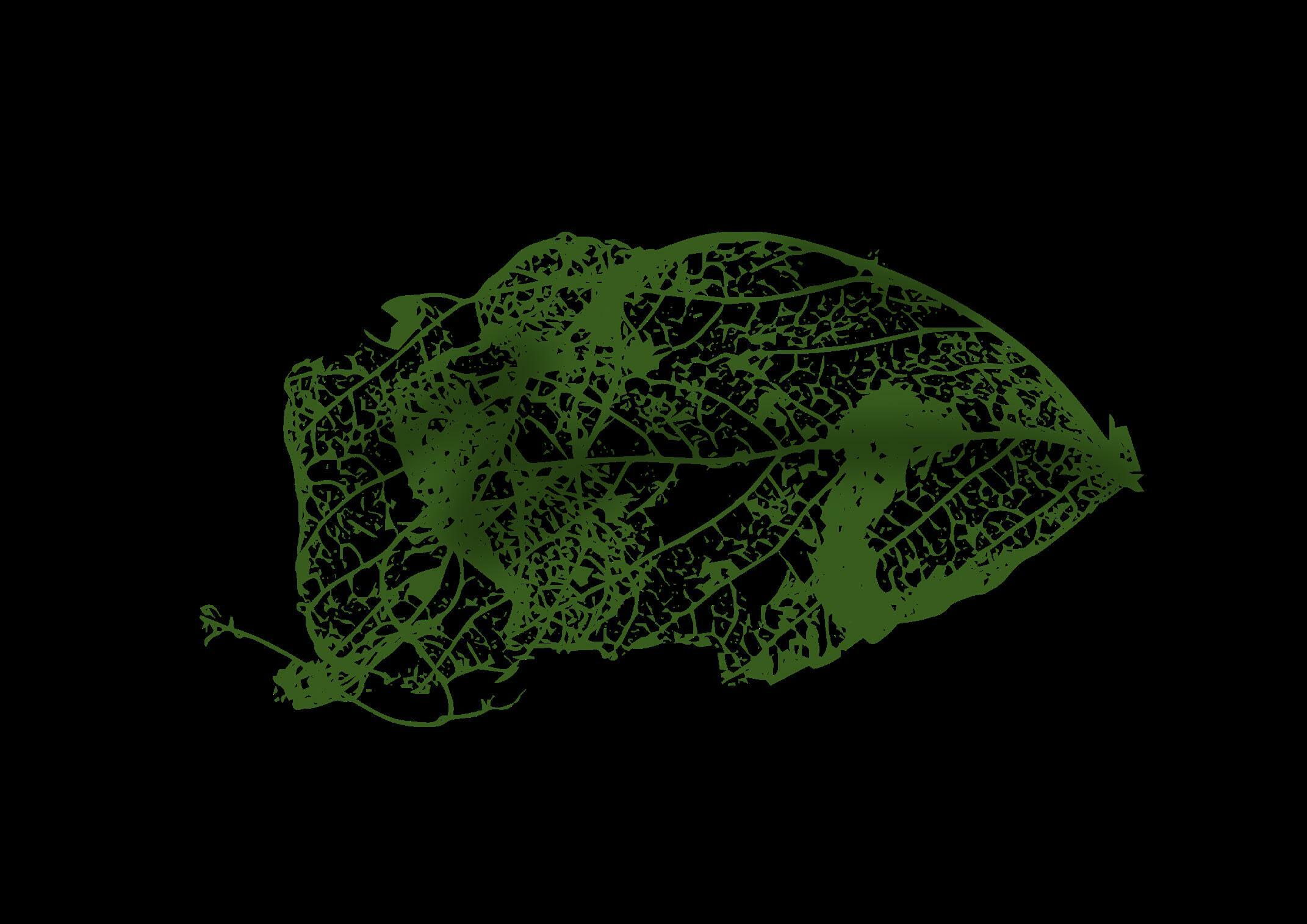
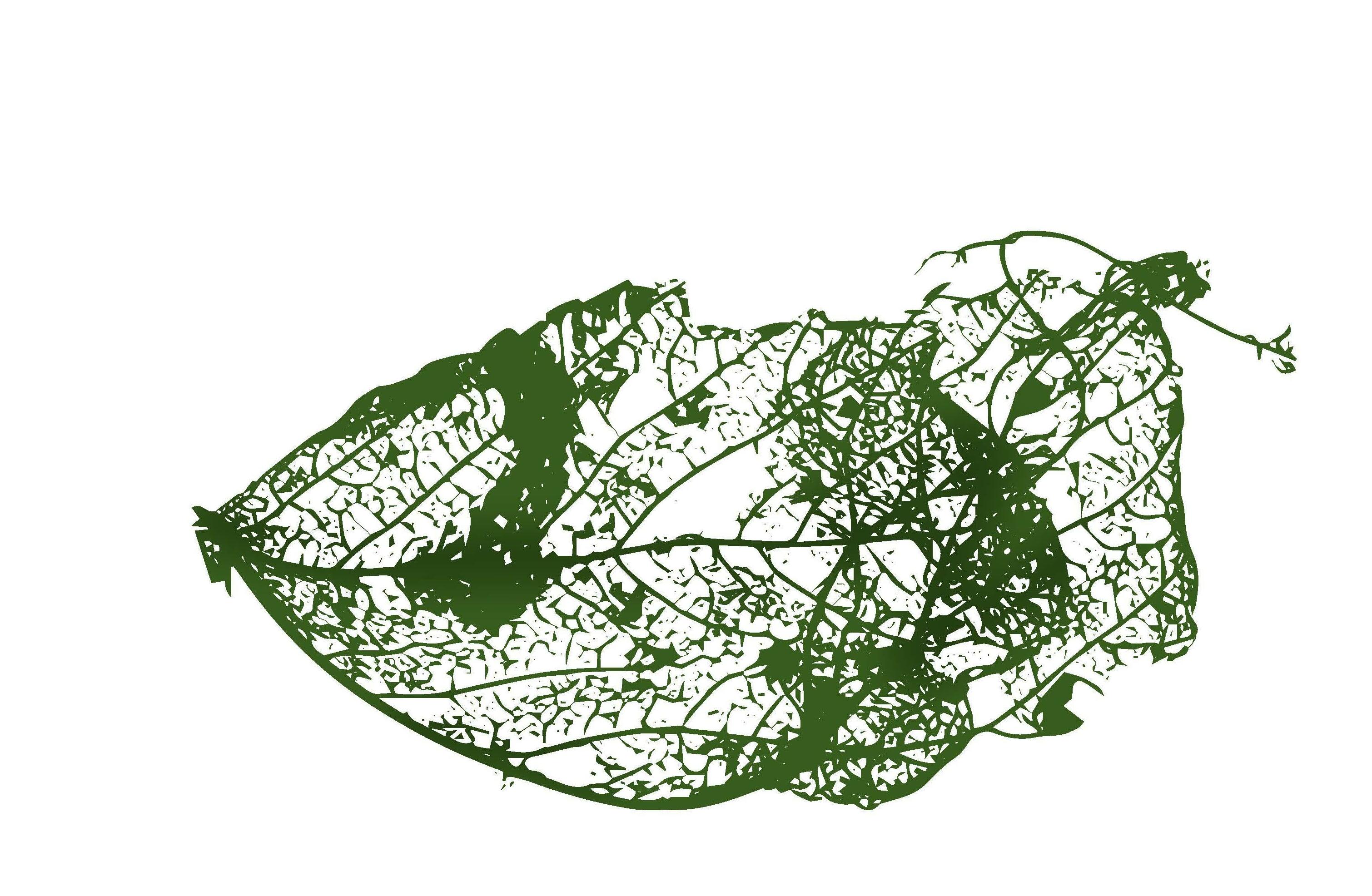
66
III.THE AND WILD PRECIOUS
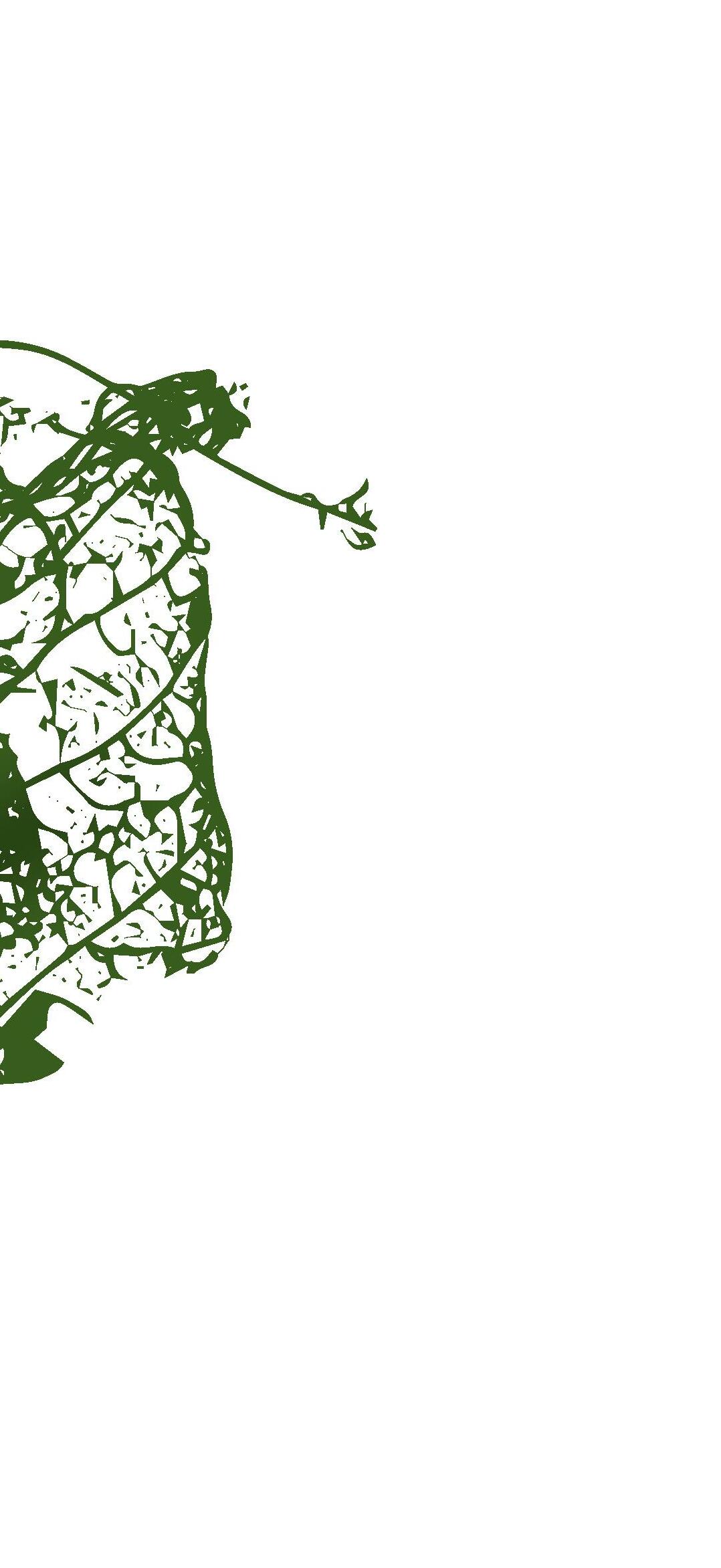
To live in the world, you must wear a thousand faces. Every interaction holds you up to the light and attempts to see through you. Interpersonal relationships breed expectations. Your supervisor expects you to put your head down and work through the weekend; your mother wants you to go to church. In prayer, do you find respite, or is speaking to God like writing an email?
measurements: salary, promotions, clicks, reposts. A pious family and a picket fence by age 30. A legacy by retirement.
However, just as there is no success and fortune to be had after death, neither is there the simple joy of feeling the breeze on your face. While the void offers escape, it holds no kindness. Even cottagecore, with its pointed emphasis on self-subsistence, rejects the veneration of leisure. The possession of one life is marked as lamentable rather than a wondrous gift.
We spend the limited time we are given pursuing benchmarks of our own creation. Yet, for as long as the human race has persisted, so too have empathy, community,


67 deathless
IN SITU

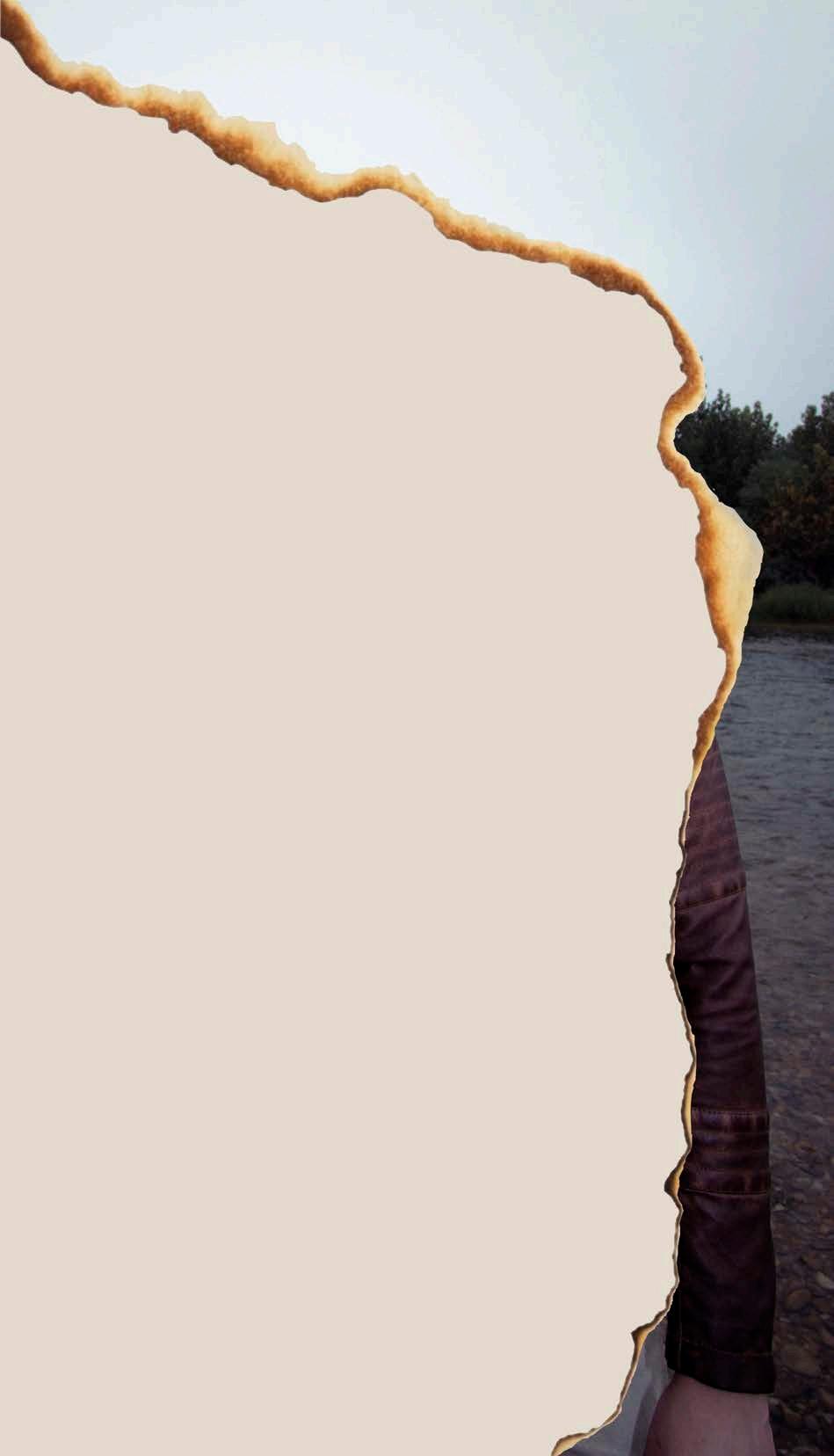 by AARON BOEHMER
AINSLEY PLESKO photographer LEAH BLOM stylists JEFFREY JIN FERNANDA LOPEZ hmua YEONSOO JUNG models AARON BOEHMER & LAURENCE NGUYEN-THAI
by AARON BOEHMER
AINSLEY PLESKO photographer LEAH BLOM stylists JEFFREY JIN FERNANDA LOPEZ hmua YEONSOO JUNG models AARON BOEHMER & LAURENCE NGUYEN-THAI

“IN AND AMONGST ALL THE MUSK, I FINALLY BECOME A BOY.”
69 deathless
GOLD AND BROWN SUEDE | Austin Pets Alive TAN AND BROWN SUEDE | Prototype Vintage

“THIS IS A STORY UNBOUND BY DEATH.”
70 spark
“THE SPIRIT ALWAYS FINDS A WAY BACK.”
Our bones used to be flexible.
They get harder as we age. They become far more likely to break like brittle than bend like butter. In elementary school, it was weirdly chic to break a bone or two. Maybe because it signaled to us prepubescent creatures that we were approaching a coming-of-age. I never wanted to break any bones, though.
I would have much rather ripped my throat out. I would have much rather traded my voice for a different one — if only I could.
I can imagine it now – my exposed throat in the open ocean with all the salt in the world to cleanse the wounds. As the waves wash into my larynx, out of my larynx, and into it again, I relish in the good burn. Finally, as I always dreamed of when I was young, the water takes my vocal cords with it. My tongue, tangled in seaweed, leaves without a goodbye.
When I speak again, I growl. I get dirty and let the sweat dry. I don’t care how I smell.
IN AND AMONGST ALL THE MUSK, I FINALLY BECOME A BOY.
But it’s all a mirage. In reality, against all I yearned for, my voice never reached a resonance any deeper than my mother’s. Growing up, I saw having a higher-pitched, flared voice as a loss –something to mourn.

I do not want to grieve any longer. I commit to a digging into myself — a meditation of selfarchaeology. I transform into an excavation site.
I CHOOSE A CAVE TO MAKE MY OWN. I CHOOSE CHAUVET-PONT-D’ARC
A revel of Upper Paleolithic life in southeastern France, Chauvet Cave holds some of the bestpreserved cave paintings in the world. Its body— its contours, its scars, its stomach full of bear bones—sways to a history I hear from 5,000 miles away.

Whispers of grinding dust echo through the walls of the cave. The phantom chatter of those long dead sing a hymn as old as 30,000 B.C.E.
I LISTEN.
I feel an energy. I hear a young boy’s hands digging
in red and black paint. He dances his fingers along the rocks, leaving behind handprints, lions, and bison. His physical body left the Earth long ago, but his spirit remains engraved inside Chauvet’s body.
THE SPIRIT ALWAYS FINDS A WAY BACK.
Chauvet’s stomach rumbles. Threads of clay fly from the corners of the cave, weaving into a network of veins, nerves, muscles, and skin. A figure materializes before me.
I recognize him. The young boy, long dead, returns like he never left.

THIS IS A STORY UNBOUND BY DEATH.
When our eyes meet, the boy runs to me with open arms. I smell a strong whiff of lavender as we embrace. I smell a scent untouched by warped self-perception brought on by the clogged machine of profit, pain, and power. I smell a scent that the boy chose for himself because he likes the smell of summer blooms — and I do too.
We sit on stones across from each other — two artifacts from the past and present trying to make sense of the future. He shows me trinkets from throughout the years — rocks shining like tarnished metals, animal hide turned to leather, and deer antlers sculpted into hammers.
The boy’s voice sounds like mine before I threw it in the tide. He speaks without mind to how a boy is supposed to sound — a symphony of feminine and masculine all at once. I long to join his orchestra.
He asks if I’ve collected any objects. I look at my hands – all but empty aside from dirty fingernails. The boy points to them.
“Where does the dirt come from,” he asks.

I tell him about the grime that culminated underneath each one. Nail by nail, I unearth pieces of myself, breaking the bolts of the coffin I buried my voice inside.
THE PLAYGROUND, I say to the boy. Looking
AND WHERE WE WANT TO GO. I REMEMBER WHEN I WAS YOUNG AND RUNNING THROUGH THOSE GRASS FIELDS. I REMEMBER A SWEATY BOY BEHIND ME.
HE ASKED IF A GIRL LIVED INSIDE ME BECAUSE I SOUNDED LIKE ONE.
That day was the first time I dug my nails into myself, scratch ing the surface of my burial site and opening a wound in my throat. The sweat dripped down from the boy’s brow, seeping into the lesion, and burning my larynx.
I flick the dirt from under my thumbs to the side.
A FEW YEARS LATER BOYS GOT SWEATIER. I REMEM BER SITTING ON COLD TILE FLOORS WHEN A BOY LEANED OVER TO A GIRL AND WHISPERED A SECRET.
I FOUND OUT THE BOY TOLD THE GIRL THAT I SOUNDED LIKE A GIRL.
When I got home from school later that day, I sunk my nails into the soil of my skin like teeth to a Honeycrisp apple.
More and more sweat from the boys around me dripped into the festering tendrils of my vocal cords.
In these instances, I don’t remember if I ended up crying at lunch or when I got home, but either way, I cried alone like a girl over being told I seemed like a girl.
I HATED MY VOICE, I tell the boy in the cave. BUT IT WAS NOT JUST THAT. WHETHER IT WAS THE WAY I SOUNDED OR SOMEONE SEEING ME CRY, I DIDN’T WANT TO BE PERCEIVED AS VULNERABLE OR WEAK.

FEMININITY WAS THE ANTITHESIS OF BOYHOOD. TO BE A BOY WAS TO BE A PART OF A MACHINE THAT AC CEPTED MASCULINITY AND ELIMINATED FEMININITY IN ALL FORMS, EVEN WITHIN BOYS THEMSELVES.
The boy in the cave says nothing. He lets my voice bear bris tles against the walls of Chauvet, adding to the history set against the curves of the rocks.


I push the dirt from under my index and middle fingernails and fling it on the ground.
AS I GOT OLDER, THE BOYS GOT EVEN SWEATIER. I REMEMBER THE CACOPHONOUS NOISES OF HARDSOLED SHOES CLANKING AGAINST THE CONCRETE. A BOY STARTED TALKING TO ME. I DON’T REMEMBER WHAT HE SAID, BUT WHEN I ANSWERED, HE MOCKED MY VOICE. HE SPOKE HIGHER AND MORE NASALLY

That afternoon was the final catalyst. With fingers deep in side my neck, I grabbed onto my larynx and pulled and pulled and pulled. Like acid rain, the sweat from the boy’s forehead poured onto my throat. Holding the larynx in my hands, it sputtered out steam, pulsating like a heart torn from one’s chest.
The remnants of this scene lay under the nails of my ring and pinky fingers. I pick the dirt and blood from beneath them, casting them into the pile I have created inside the cave.
I close my eyes for a moment. When I open them again, I look down. My hair falls forward in ringlets as I notice my finger nails once more – clean.
I hear the boy in the cave take a deep breath, but he still doesn’t say anything. His silence floats in the space around us, unlocking the latch pin glued onto the coffin I once shoved myself inside of.
Finally, I escape. I take a deep breath, and then draw it out even longer.
FEMININITY WAS NATURAL FOR ME, I tell the boy.
BUT IN ORDER TO ASSUME THE ROLE OF A BOY, I RE JECTED MY NATURE TO BE SEEN AS NATURAL IN THE EYES OF SWEATY BOYS.
BUT THERE IS NOTHING NATURAL ABOUT MACHINES.
I look up from my hands to the boy in front of me, who has remained quiet since I began recounting all these past ills.
Our eyes lock and then I notice a lesion on his throat. I look down at his hands, and then his fingernails – dirty.
Blood and mucus drip from his neck and onto an object in his lap.
I see the ruins of my throat – my tongue, my larynx, and my vocal cords. The things I discarded throughout my childhood have finally found their way back to me.
I accept my throat from the boy in front of me, returning it to its original place.
All the sweat in the world could not disintegrate my larynx. Thank God salt preserves rather than consumes. It was only a matter of time before I found my voice again.
The boy and I lock eyes one last time. We share a smile as he turns back to dust. A cool wind pulls his ashes towards me.
IN THE END, WE MERGE. ■
“FEMININITY WAS THE ANTITHESIS OF BOYHOOD. TO BE A BOY WAS TO BE A PART OF A MACHINE THAT ACCEPTED MASCULINITY AND ELIMINATED FEMININITY IN ALL FORMS, EVEN WITHIN BOYS THEMSELVES. BUT THERE IS NOTHING NATURAL ABOUT MACHINES.”
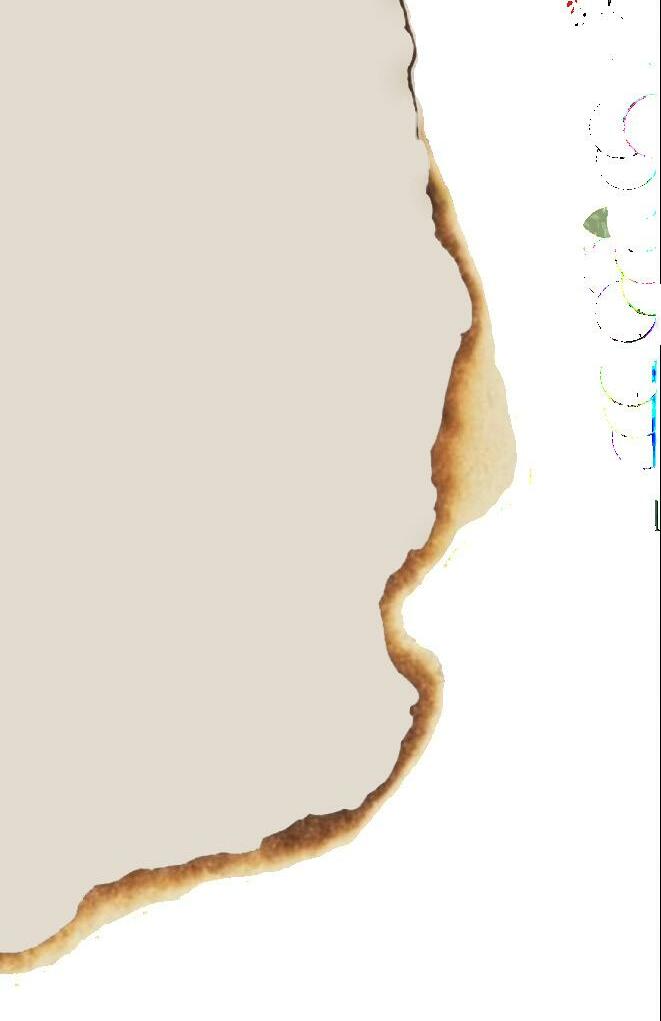

73 deathless

74 spark
“THE THINGS I DISCARDED THROUGHOUT MY CHILDHOOD FINALLY FOUND THEIR WAY BACK TO ME.”


75 deathless
Sisyphus attends our exequies.
by KAMEEL KARIM
Who do we grieve when the flesh has gone?
The old geometricians unpeeled the brain quivering pink and parted the sulcus as ripe fruit. Their assurances echoing off the tunnel walls: yes, distant, but yes, ours. Don’t worry, we will ship your bones to the finish line.
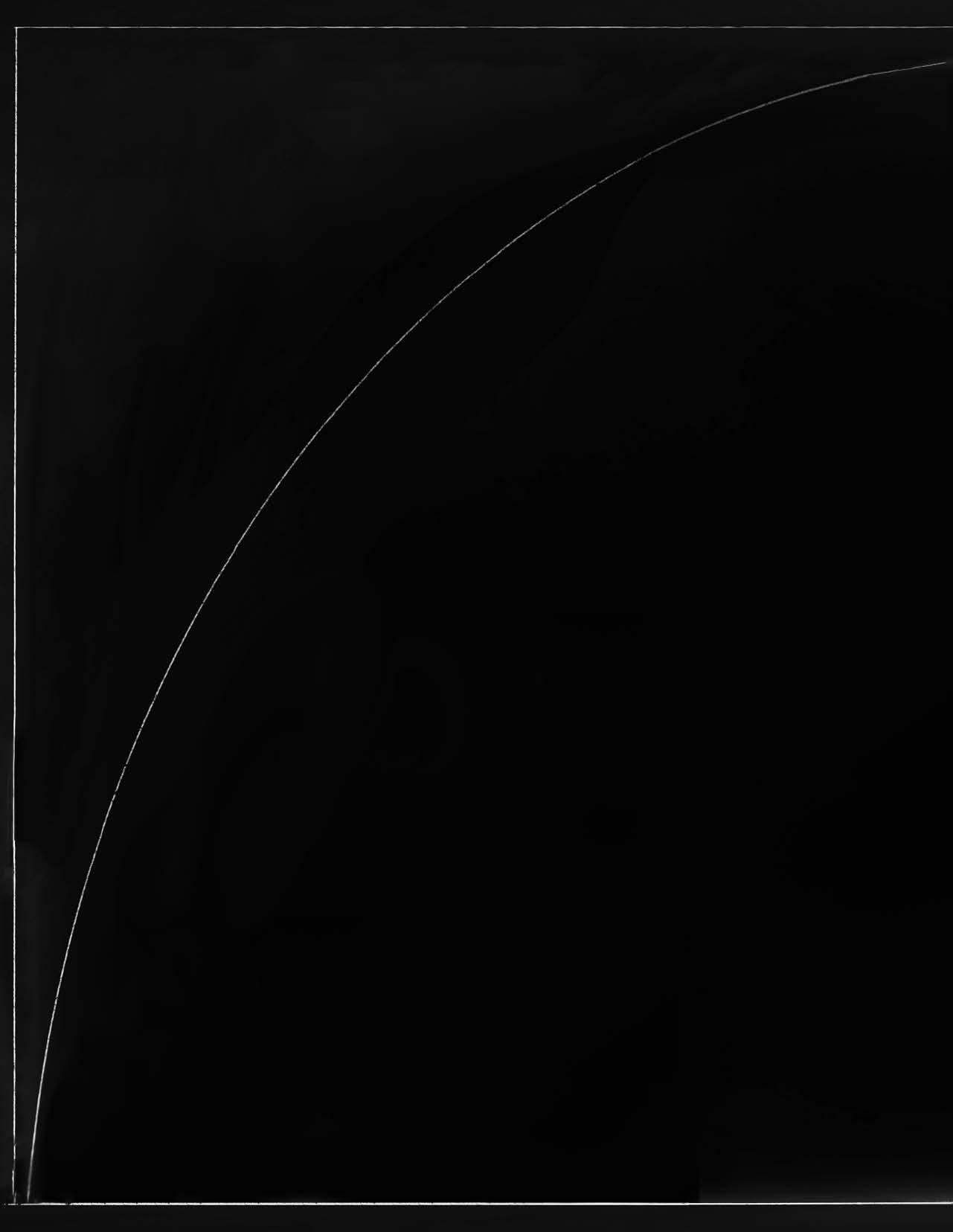
Do you recall your mother’s face?
Or do you mourn her in binary, circuitry of bereavement, silicone tombstone and specter of warmth —
And the mountain — the great stone approaching the clouded peak and shuddering backwards, each day in retreat, so our vigilant neighbor may again shoulder his fate while again, we rebuke ours.
Your ambition breathes outside your body.
76 spark
We have long been outstripped by the gods of our creation. And the mountain — and the flesh singed — and the laughter, for Sisyphus knows the hunger. We, too, will be chased from the table. ■

layout
AHSAN & KAI-LIN WEI
ELENA
77
deathless
 UMBRA / THE SOUND & THE SILENCE / EXOSKELETON / SHATTER / THE SPIRIT / FOREVER & ALWAYS, WILLIE PEARL / FROM THE ETHER / D>E>A>T>H>M>E>T>A>L / THE HEART OF THE POET / DEATH DOULAS & SLOWBURN ENDINGS
UMBRA / THE SOUND & THE SILENCE / EXOSKELETON / SHATTER / THE SPIRIT / FOREVER & ALWAYS, WILLIE PEARL / FROM THE ETHER / D>E>A>T>H>M>E>T>A>L / THE HEART OF THE POET / DEATH DOULAS & SLOWBURN ENDINGS
II. SPIRIT
Even in an unknowable universe, certain laws are recognizable: controlled, perfectly designed, and predestined. Human movement strains against the passage of time and the dimensions of space. At their intersection, the friable boundaries between the natural and the metaphysical reveal sacred truths.
79 deathless

layout ELENA AHSAN photographer LORIANNE WILLET stylist NIKKI SHAH hmua LILY ROSENSTEIN models NOURA ABDI & YOUSUF KHAN r*eturn; left ““ * i=09 system (pp) { var a=$imputstream (function) =, “ “// presetInt “parameter” d = LIMIT_gen () “)val = x r*eturn; left ““ * i=09 system (pp) { var a=$imputstream 80 spark
by KYRA BURKE
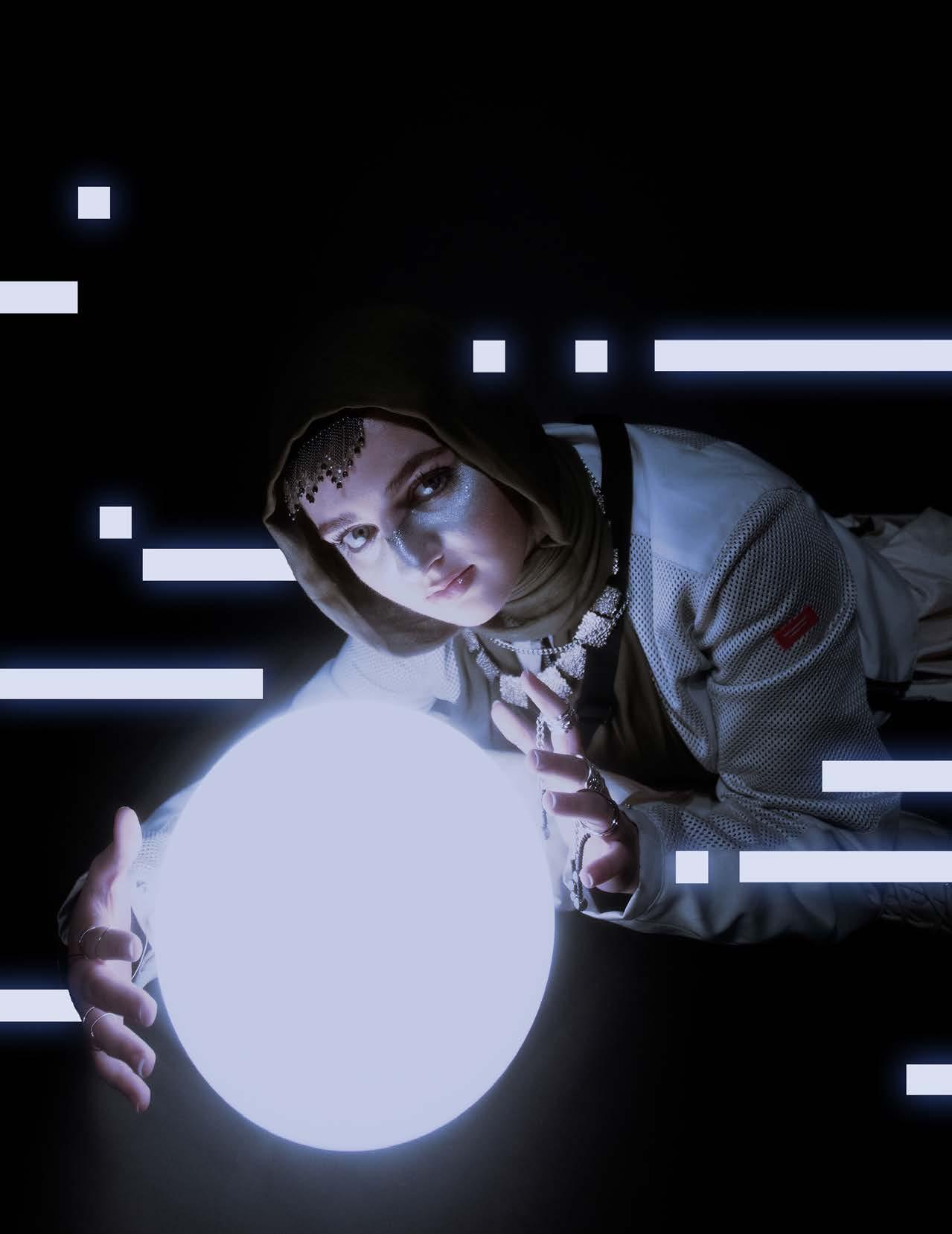
(line)#;; indexOf (function) =, “ “// presetInt “parameter” d = LIMIT_gen b[g] %(&) g++, word:c var h ^ { vr% keyword(e, 09) ff> wrd bb 600 /g/ array_l3ength&& e>> = h [t] word.push c+++p%(“ “)val = x r*eturn; * i=09 system (pp) { var a=$ imputstream (line)#;; (function) =, “ “// presetInt “parameter” d = LIMIT_gen () b[g] %(&) word:c var CREAM JACKET | Austin Pets Alive BEADED RINGS | Nikki Shah 81 deathless
%(“ “)val = x r*eturn; left ““ * i=09 system (pp) { var a=$imputstream (line)#;; indexOfc tion) =, “ “// presetInt “parameter” d = LIMIT_gen () b[g] %(&) g++, word:c var h ^ { (b,1) keyword(e, 09) ff> wrd bb 600 b. unshift ““)) a.slplice] /g/ array_l3ength&& As an impressionable young girl e>> = h [t] word.push “)val = x r*eturn; left ““ * i=09 system (pp) { var a=$ imputstream indexOf with no grasp of realism or responsibility, a.s[plice] /g/ array_l3ength&& e>> = h [t] word.push c+++p%(“ “)val = x r*eturn; left i=09 syst space was the ultimate playground em (pp) imputstream (line)#;; indexOf (function) =, “ “// presetInt “parameter” d = LIMIT_gen unshift ““)) a.s[plice] /g/ array_l3ength&& e>> = h [t] word.push c+++p%(“ “)val = x r*for my imagination. eturn; left ““ * i=09 system (pp) { var a=$ imputstream unshift ““)) a.s[plice] /g/ array_l3ength&& e>> = h [t] word.push c+++p
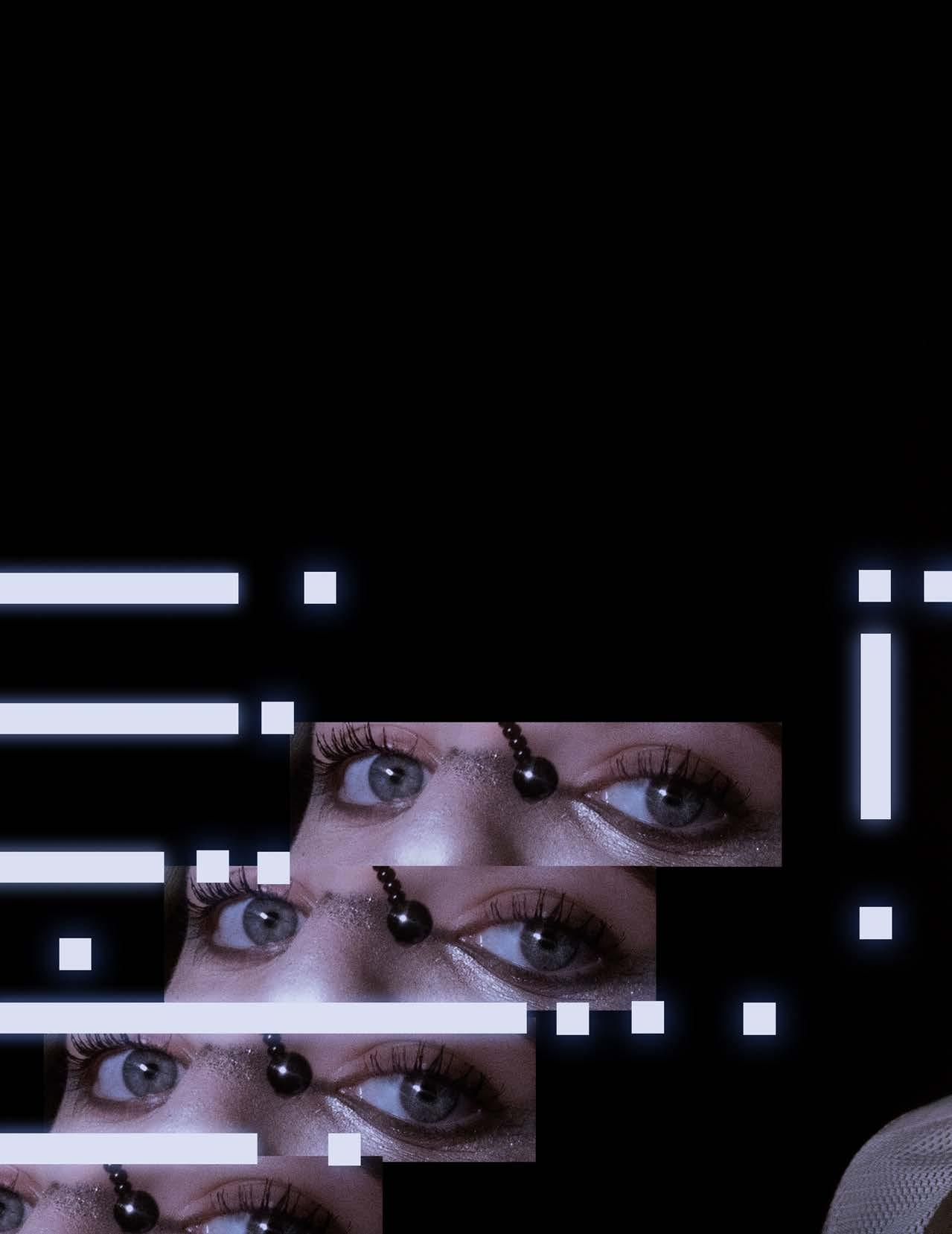
82 spark
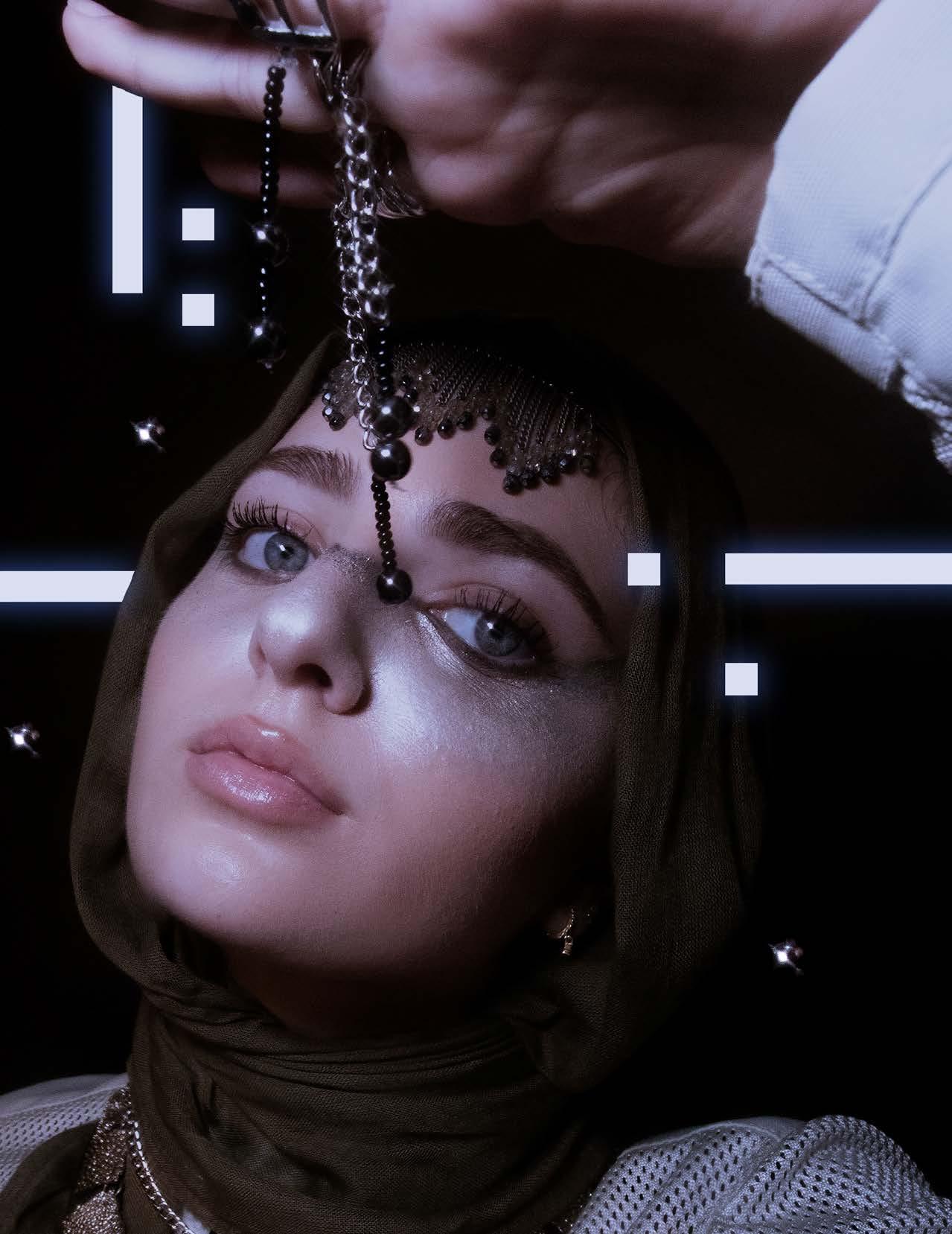
indexOfc { vr% word.push c+++p%(“ { var a=$ LIMIT_gen () b[g] imputstream (line)# 83 deathless
“ “// presetInt “parameter” d = LIMIT_gen () b[g] %(&) g++, word:c var h ^ { vr% (b,1) keyword(e, 09) ff> wrd bb 600 b. un array_l3ength&& e>> = h [t] word.push c+++p%(“ “)val = x r*eturn; left ““ i=09 system (pp) { var a=$ imputstream (line)#;; indexOf (function) =, “ “// pr word:c var h ^ { (b,1) keyword(e, 09) ff> To my childlike eyes, wrd ba.s [plice] /g/ array_l3ength&& e>> = h [t] word.push c+++p% seeing the moon up close (“ “)val = indexOf (function) =, “ “// prese was just one step closer “)val = x r*eturn; left ““ * i=09 system (pp) { var a=$imputstream vr% (b,1) keyword(e,> to grazing its surface. bb 600 b. un array_l3ength&& e>> = h [t] word.push c+++p%(“ “)val = x r*eturn; left ““ (b,1) keyword(e, 09) ff> wrd ba.s [plice] /g/ array_l3eng word.push c+++p%(“ “)val = x r*eturn; indexOf (function) =, “ “// presetInt “parameter” d = LIMIT_gen () indexOf (function) =, “ “// presetInt “parameter” d = LIMIT_gen () “)val = x r*eturn; left ““ * i=09 system (pp) { var a=$imputstream (line)#;; indexOf “ “// presetInt “parameter” d = LIMIT_gen () b[g] %(&) g++, word:c var h ^ { vr% (b,1)

84
spark

(b,1) (function) (b,1) 85 deathless
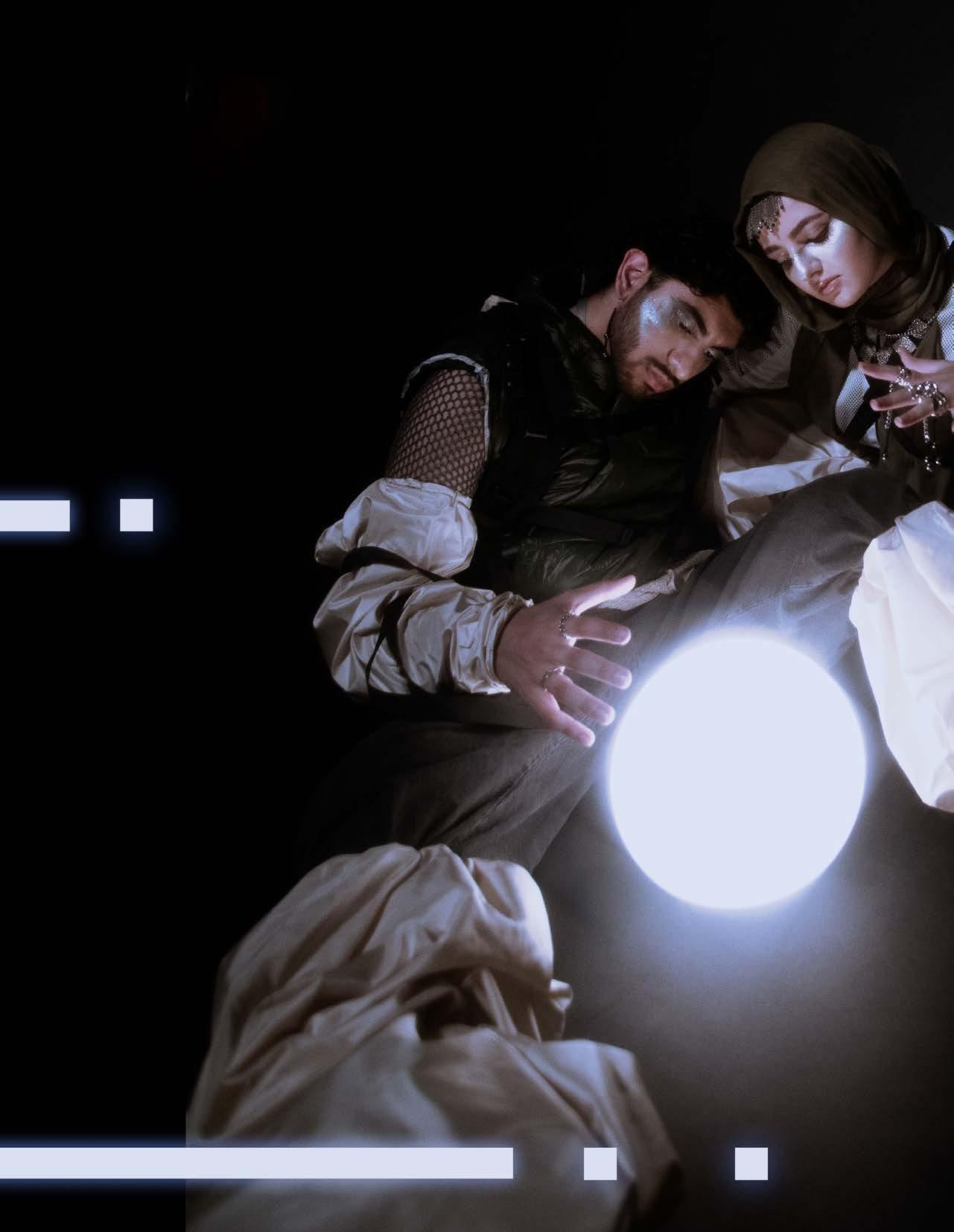
%(“ “)val = x r*eturn; left ““ * i=09 system (pp) { var a=$imputstream (line)#;; indexOf (function) =, “ “// presetInt “parameter” d = LIMIT_gen () b[g] %(&) g++, word:c var ^ { vr% (b,1) When I reflect on my past, keyword(e, 09) ff> wrd bb 600 b. un it feels like I’m peeling back layers %% %% r*eturn of my skin — var*eturn; left ““ each layer more raw and system (pp) { tender than the last. i=09 system (pp) { var a=$ imputst line)#;; indexOf (function) =, “ “// presetInt = \\\
GREY
MESH LONG SLEEVE | Austin Pets Alive BLACK
EARPIECE
| Nikki Shah BLACK BACKPACK | Austin Pets Alive

a=$imputstream (line)#;; indexOf (function) =, “ “// presetInt “pa rameter” d = LIMIT_gen () b[g] %(&) g++, word:c var h ^ { vr% Perhaps if I drown myself in nostalgia, (f> b,1) keyword(e, 09) ff> wrd bb 600 b. /g/ array_l3ength&& e>> = h [t] I can find closure word.push for my restless nights, c+++= x r*eturn; left my high-strung demeanor,* i=09 pp) \utstr and my insatiable hunger eam (line)#;; indexOf (function) =, “ “// presetInt “parameter” d = LIMIT_gen () b[g] %(&) g++, word.push c+++p%(“ “)val = x r*eturn; ““ * i=09 system to do more, (pp) { var a=$ imputstream (line)#;; indexOf (function) =, “ “// presetInt “parameter” d = LIMIT_gen %(“ urn; left ““ * i=09 system (pp) { var a=$imputstream “parameter” d = LIMIT_gen () b[g] %(&) to be more. g++, wor d:c var h ^ { vr% (b,1) keyword(e, 09) ff> wrd bb 600 b. left * i=09 system (pp) { var a=$ imputstream (line)#;; indexOf (function) =, “ “// presetInt “parameter” d = LIMIT_gen () b[g] %(&) g++, word:c var h ^ 87 deathless
“)val = x r It’s as if*eturn; left ““ * i=09 system (pp) { var (line)#;; indexOf (function) =, “ “// presetInt “parameter” d = LIMIT_gen () b[ word: ^ { v ^ { vr% (b,1) the planet and I are one, keyword(e, 09) ff> wrd bb 600 b. un array_l3ength&& e>> = h [t] word.push mourning the little girl c+++p%(“ “)val r*eturn; left ““ word:c var h ^ { who never failed (b,1) keyword(e, 09) ff> wrd ba.s [plice] /g/ array_l3ength&& e>> word.push c+++p%(“ “)val = x r*eturn; ““ * i=09 system (pp) to brush her bedroom curtains aside { var a=$ imtream (line)#;; indexOf (function) =, “ “// presetInt “parameter” d = LIMIT_gen ()
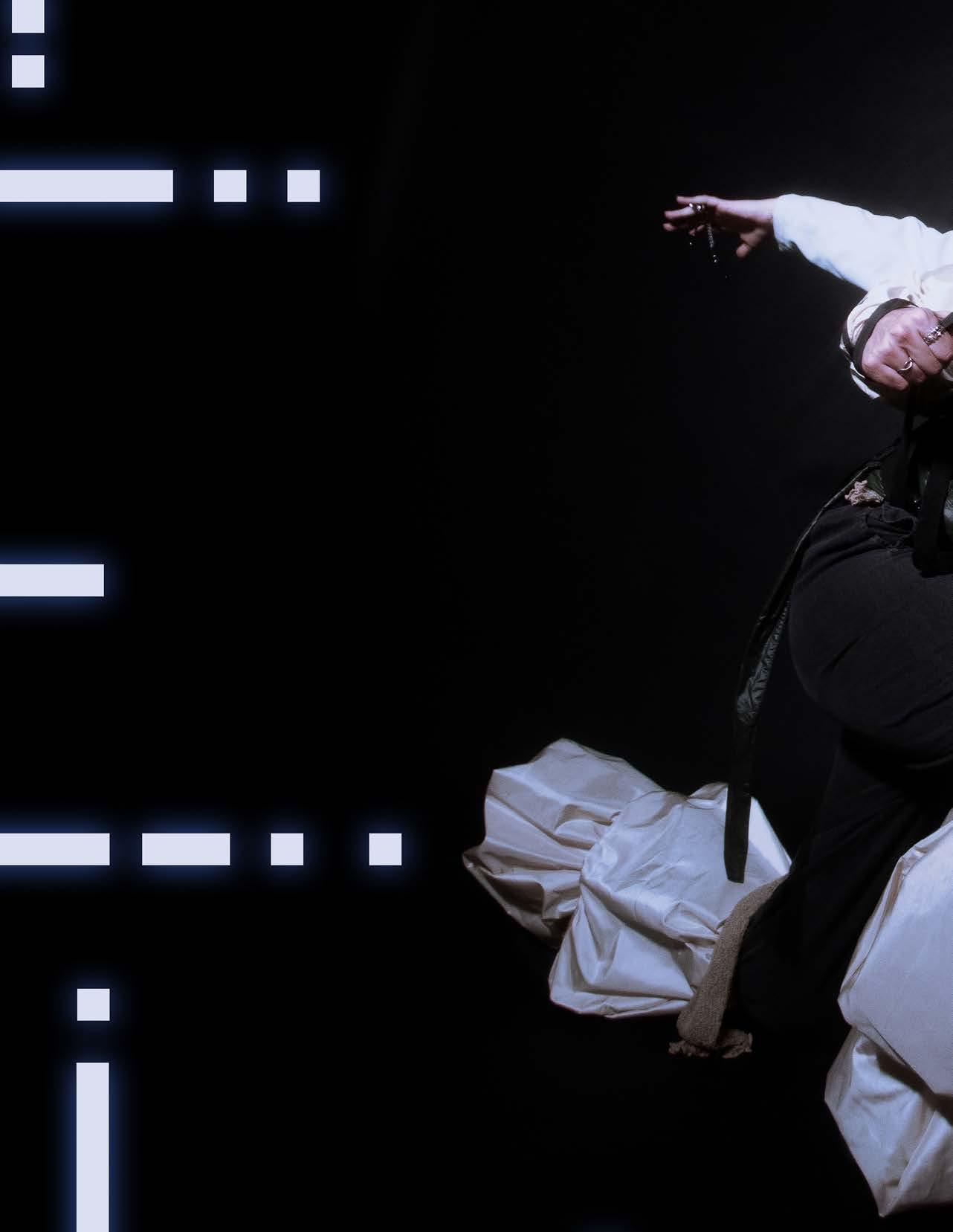 CREAM GLOVES | Nikki Shah
CREAM LEG WARMERS | Nikki Shah CREAM BOOTS | Pavement
CREAM GLOVES | Nikki Shah
CREAM LEG WARMERS | Nikki Shah CREAM BOOTS | Pavement

gen () b[g] %(&) g++, word:c var h ^ { keyword(e, 09) ff> wrd bb /g/ array_ and admire a universe l3ength&& e>> = h push c+++p%(“ “)val = x r*eturn; * i=09 system (pp) { var a=$ imputstream (line)#;; // presetInt “parameter” d = LIMIT_gen () b[g] word:c vr% (b,1) keyword(e, 09) ff> as limitless [plice] /g/ array_l3ength&& e>> word.push c+++p%(“ “)val = x left ““ * i=09 system (pp) { var a=$ imputstream indexOf (function) =, “ “// as her imagination. presetInt rameter” d = LIMIT_gen imtream 89 deathless
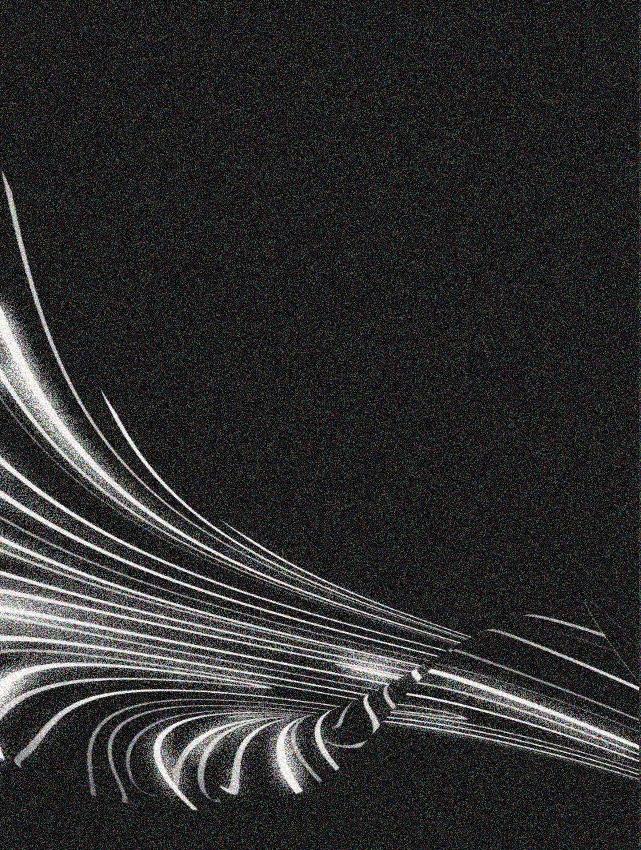

90 spark
by ESTELLE OMOTAYO


91
layout
deathless
I. VOID
Iwandered too far.
I searched fruitlessly for sleep in a night unyielding, unmoving. My fingers twisted the suffocating sheets, ordinar ily safe but now providing no purchase or peace, and the walls bore down on me.
Like an untethered balloon, I feared slipping away, becoming lost in an alien landscape filled with shadows running and dancing just out of sight. Usually a serene kind of quiet, I languished in the sonic void as it choked me.
So I left. While college night-roaming is never completely safe, I encountered no one on my jaunt—a grave kind of loneliness. At that point, any presence would’ve been welcomed, but my only companions were the crickets’ blind chirps.

In the emptiest hours, the seeds of fear that chased me from the bed grew like weeds. The gray concrete paths remained unrecog nizable without daytime’s teeming scenery, replaced by a ghostly stillness. Normally, I would return to bed at the first sign of ex haustion, but adrenaline kept me shuffling forward. I strolled through the labyrinthine streets until I couldn’t remember the way back. Darkness seemed to swallow my whis pered pleas, a black hole consuming the light of breaking stars.
Yet my prayers fell on wakeful ears. The divine answered, and a voice like dawn split open the night.
Wincing at the bleach bright numbers on my phone, I checked the time. 2:22: the repeating angel number that means every thing is going to be alright.
The void had shouted back.
II. symbiosis
In those days, the veil hanging between heaven and myself thinned.
I sorely lacked interaction my freshman year of college. Long before escaping to the green hills and safe lakeshores of Austin, I wilted in College Station. I arrived as some one who required intimacy to survive—con nection sustained me. Without it, the world was strange, and the silence as frighten ing as an unfamiliar face, dangerous in its mystery.
Before I began to talk with the divine, there was little conversation at all. Yet out of the quiet came a music, intricate and sweeping.
I remember a dream I once had, on the first night of May.
In sleep, I attended church, and a chorus of people sang sweeter than angels of a light that refused to hide. Doves held vigil in my bedroom as thunder rumbled above.
As a storm crashed in on the horizon, I watched the world from a highway overpass and thought of change. A bolt of lightning struck the road, and I awoke breathless.
The time was 3:33, the angel number that means heaven is watching.
92 spark
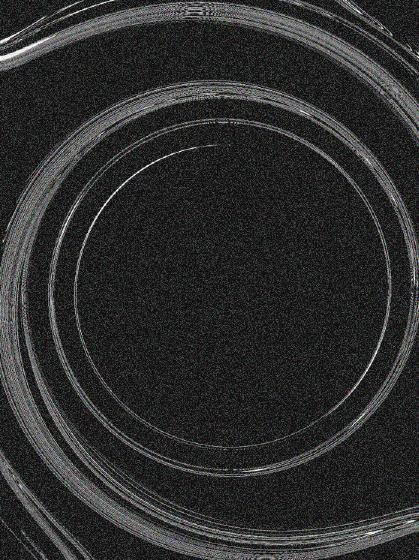
93 deathless
“DARKNESS SEEMED TO
SWALLOW MY WHISPERED PLEAS, A BLACK-HOLE CONSUMING THE LIGHT OF BREAKING STARS.”
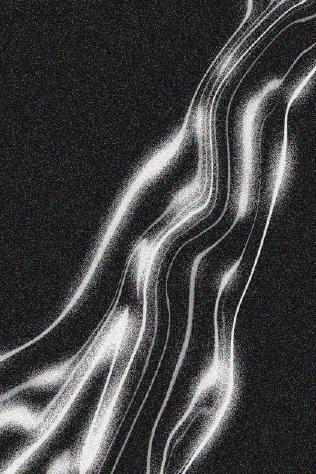
94 spark
“the divine answered, and a voice like dawn split open the night.”
As I paid more and more attention, God took on a form I recognized. Whether storm or rainbow, butterfly or bee, everything was holy. Here, the ordinary and the extraor dinary became one. By signs and portents, omens and answers, I discerned the uni verse, hearing its voice through all physical manifestations; I achieved symbiosis with the cosmos.
In Exodus 3:14, God said unto Moses, “I am that I am.”
Through a burning bush, one of the Bible’s richest and most recognizable occurrences of heaven merging with the mundane, he said unto Moses that he was the fact of inter being itself, that he is present in all changes and surrendering of separate selfhood. That connection is the highest symbiosis, when truth becomes one’s entire existence.
III. DEITY
As all angels do, I fell from grace. Not for pride unyielding as iron, but fear, a despera tion much harder to shake.
For so long, I had been alone with my own voice as the only sound. A larger harmony was anathema to the emptiness that, no matter how unwelcome, I inadvertently adjusted to. Paranoid, I worried that it was my reflection I saw, not a cosmic language behind selfhood. Distrust crept in, sinister as a spider, covering my ears with crooked fingers so I doubted everything I heard.
But the patterns could not be unlearned, and the signs demanded to be seen.


In response, I dug deeper, begging for more and more proof, bending the universe to my will. To assuage my worry, I attributed meaning to the symbols instead of perceiv ing their inherent beauty. I became my own prophet, obsessed with an echo, refracting light instead of receiving it.
Beyond numerology or nature, synchronic ity, the experience of spiritual coincidences, occurs in another form: geometry. The practice of the sacred geometric mandala is not an exercise in memorizing symbols, but in perception, an artistic meditation that represents the world around oneself as a sacred interconnected reality. The patterns embodied our boundless conversation—a transcendence of the binary between the divine and the profane.
In those days, I listened more than I spoke. The universe appeared in its own orches trated timing, taking care of me as needed. For no gain did I engage, but as a participant in the divine order of nature: a give-andtake balanced on open surrender.
By the time I drifted home, finally released from obligation and tedium, the sun had already set, leaving the exhausted world a dusky blue. The day followed a series of difficult weeks plagued by busyness and clamor. Every task I failed at, every friend I ignored, and every dream turned nightmare haunted me.
I stood on my balcony, a small figure in a vast sky, and asked the universe for a sign. Doves—to show that everything was going to be alright. That I would be able to handle my life with grace.
Across the street, a pigeon landed on the telephone wire. Close enough. ■
95 deathless
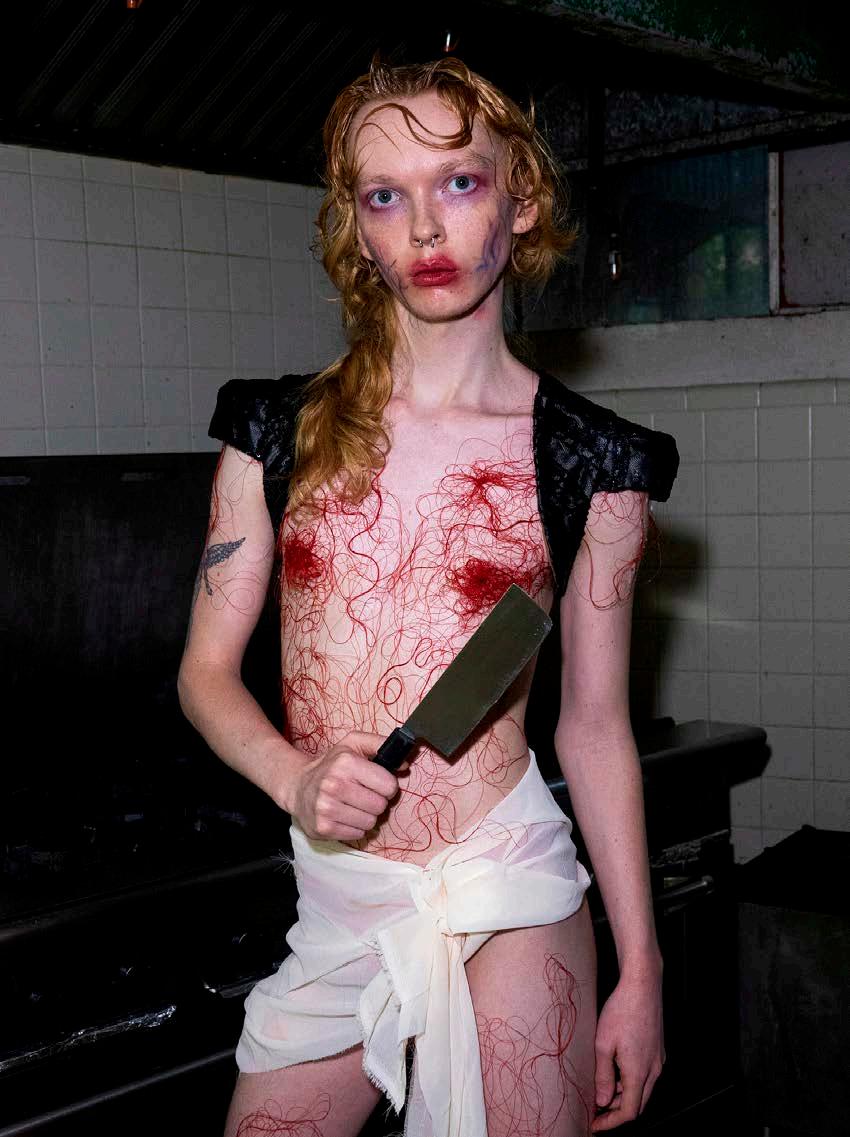 by LARA BORGES
layout MAYA NGUYEN photographer CHARLOTTE BROWN stylist MIRANDA YE hmua TIFFANY SUN model ANGEL QUINN
by LARA BORGES
layout MAYA NGUYEN photographer CHARLOTTE BROWN stylist MIRANDA YE hmua TIFFANY SUN model ANGEL QUINN
In a world where two codes run parallel to one another, what happens to THE spirit when hu manity forgets its origins and trades function for aesthetics?

97 deathless
In the beginning was the Word, and the Word was God.
But the Word was not God as you would imagine, but God fractured and infused into every element of what would become Life: the double helix cracked open and split apart, spiraling its in nate divine code into everything that would come to be. The Word was in the ruling of the tide, the spiral of the shell, the slope of the mountain and the evanescent curling of the flame. It dictated when the sun rose and when the moon set, the fleeting circadian encounter between those two primordial Beings.
And it was Good.
But then the Word grew. A single cell, in all its intricacy, suddenly became Two. Then Three. Infinitesimal structures coalesced into beings that ate, drank, and walked upon themselves, as every form of matter was a different expression of the code. With each interaction between forms of matter, the Word was experiencing itself infinite times over.
In this way the code built upon itself, di viding and multiplying beyond imaginable numbers. When something didn’t work, it tried again; infinite trial and error, the code developing Itself as it developed Life. From protists to primates the code expanded, un til eventually it gave way to something be yond:

Consciousness— thought split apart from the Word.
This newfound awareness punctuated the governing principles that had kept Life moving along without much room for di version. Time, something the Word knew only in constant scarcity, was now available in excess. In that excess, Consciousness gave way to Recognition (and there was so much to recognize!) and Recognition gave way to Emotion. Feelings that had been only instinctual before (fear, hunger, thirst) now had depth: a past, present, and future, as they went from merely present concerns to conceptual ideas that could be avoided if the perfect alignment was reached between these dimensions of time. Death, the ever-threatening constant, became, if not inevitable, then delayable. Out of fear for survival, Humans (that divergent cre ation) began to generate themselves.
98 spark
“Perhaps our desire for perfection is really the mind rebelling against the knowledge of its own impermanence.”

99 deathless


100 spark
But what is divinity relegated to when its creations have spiraled out of control? The product forgets its origins, its blueprint, and takes the design into its own hands. In all of its creations, humanity’s Emotion infused the faulty code it created in an attempt to mimic the undercurrent of intention it could once recognize coursing through life. If it could only look outside—
—But the window has changed. It’s shrunken into a pocket-sized mirror; we no longer look through but back at. Our own likeness is always a right-swipe away, accessible at
permanence of the world; without constant adaptation, its endurance across billions of years would be impossible.
You see, entropy is a governing force as in nate as the Word, yet the two are not at odds. Rather than combat chaos, the Word is the code that allows for life to persevere amidst chaos by working adjacent to it, con tinuously adapting as everything dissolves further into disorder. There is no way to preserve nature; we would have to muzzle the wind, cover the sun, cork the rain—and then what would be left? No, the elements that make life simultaneously corrode it,
any moment as we scroll. Distance from di vinity has led us to believe that understand ing our physical selves will make everything else fall into place; but the code was never meant to perceive itself in its entirety, the reason why our eyes, on their own, can only take in pieces of our body at once. Function, not aesthetics, is what the Word was meant for.
But we, desperate for understanding, rely on reflective surfaces as a means of grasp ing who we are. Through interactions with mirrors and screens, we’ve frozen ourselves in time, recoiling at the fault we find in something that is, by nature, imperfect— imperfection being the consequence of the
but nature embraces that and changes with them. And in that endurance through ad aptation, we find beauty: the ridges scarred through a canyon, the whorls climbing up a tree branch, the very calluses on your hands—all are reminders of persistence against all odds. But we’ve lost this appre ciation in regards to our own bodies.
Forgetting that our very fabric is only the most up to date model of an ever-adapting system, we’ve traded the transient nature of the code inside of us, and the world around us, for a frozen reflection that we stare at again and again, until we’ve convinced our selves of the imperfection there. The beauty in functionality and endurance has been

“We’ve frozen ourselves in time, recoiling at the fault we find in something that is, by nature, imperfect.”
101 deathless
traded in for an aesthetic ideal that, ironi cally, changes even faster.
With the idea of an “ideal body” every where, defined by countless forms of me dia, comparison has never been more con venient. We have lost the holy intention behind modification. We no longer adorn ourselves out of care or celebration or love, but forcefully and in disorientation. Just as organisms evolve to better suit their envi ronment at any given time, the work of the adaptive divine code, we force an evolution on ourselves based on what the “ideal body” is in the moment. Insertions and deletions, functions that were once mutative acci dents, have become purposeful, always with the end goal of perfecting. If not in our selves, then in a transcended form in which we program our own imperfect notion of perfection.
Perhaps our desire for perfection is really the mind rebelling against the knowledge of its own impermanence. If we put all our energy into perfecting ourselves on Earth, maybe we can ignore the fact that we’ll soon be gone again. But when we take things too much into our own hands, we are straining against and compromising the code that is built into us. When we fight against it, we are fighting against our very selves. In side, the spirit is suspended by the energy we attach to perfecting our physical form. Frozen, it can no longer interact with time and space, its attention too deeply devoted to the physical self. It yearns for something
greater, for freedom to continuously change as it was meant to along with its environ ment before we chained it to some fleeting ideal of perfection.
In this world where two codes run parallel to one another, we are caught moving to wards an elusive notion of progress and per fection that tears the soul. Yet somewhere inside, that thread lingers, tugging insis tently every now and then with the hope of being remembered. Some, grasping that na ture in a stroke of clarity, have tried to share the vision with those on Earth: Da Vinci’s Vitruvian Man, Euclid’s Golden Ratio, oth erwise known as the divine proportion. We call it genius or talent, but really we are all able to understand, if we just remember.
Look in a mirror, and you are reducing your self to a watery 2D image, a mere flash of life momentarily frozen in its context. Instead, turn away, touch yourself, really hold your self. Feel the cells in one hand interacting with those in your other. See how you are like clay. Feel your resilience. Understand your nature. Observe, patiently. That is how you heal.
“Look in a mirror, and you are reducing yourself to a watery 2D image, a mere flash of life momentarily frozen in its context.”
102 spark
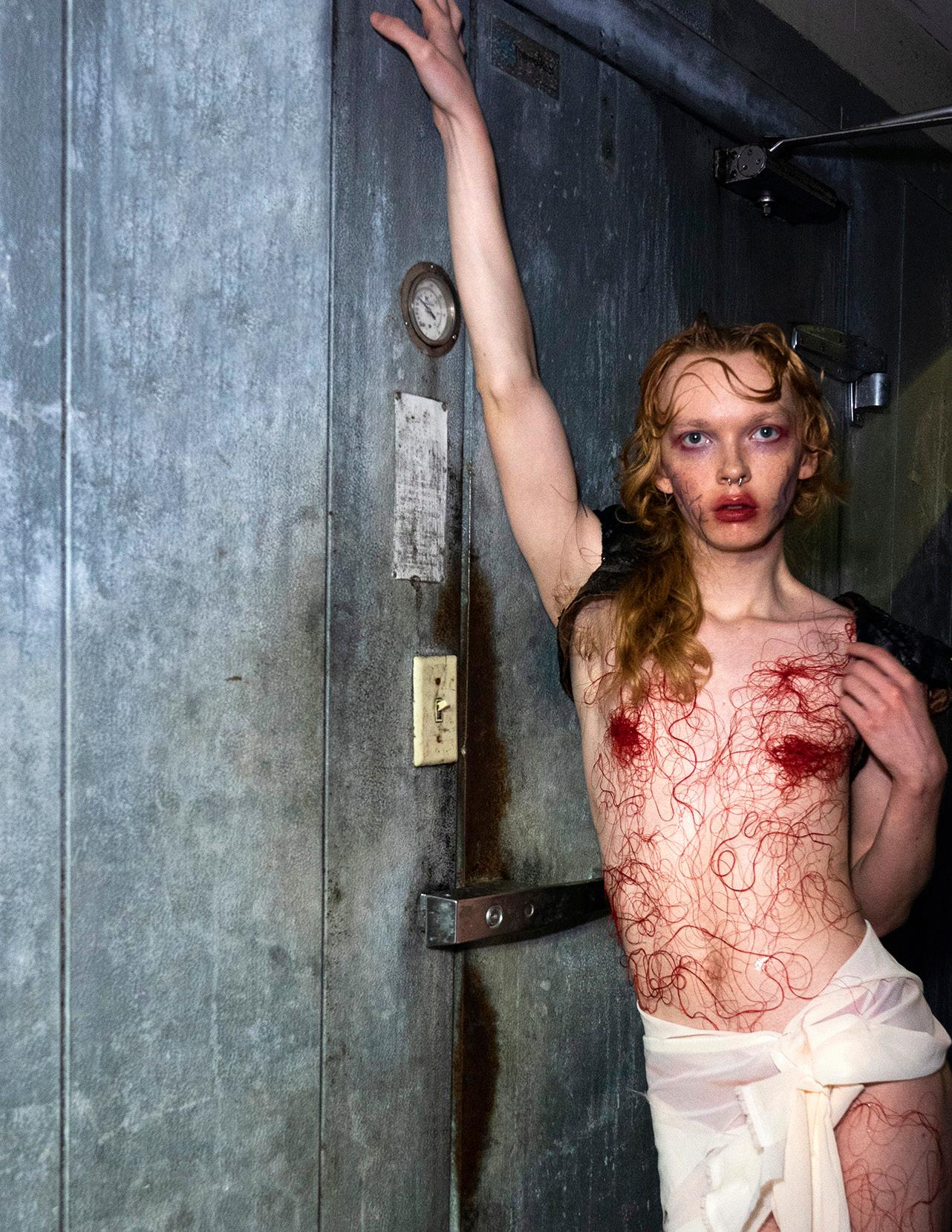
103 deathless
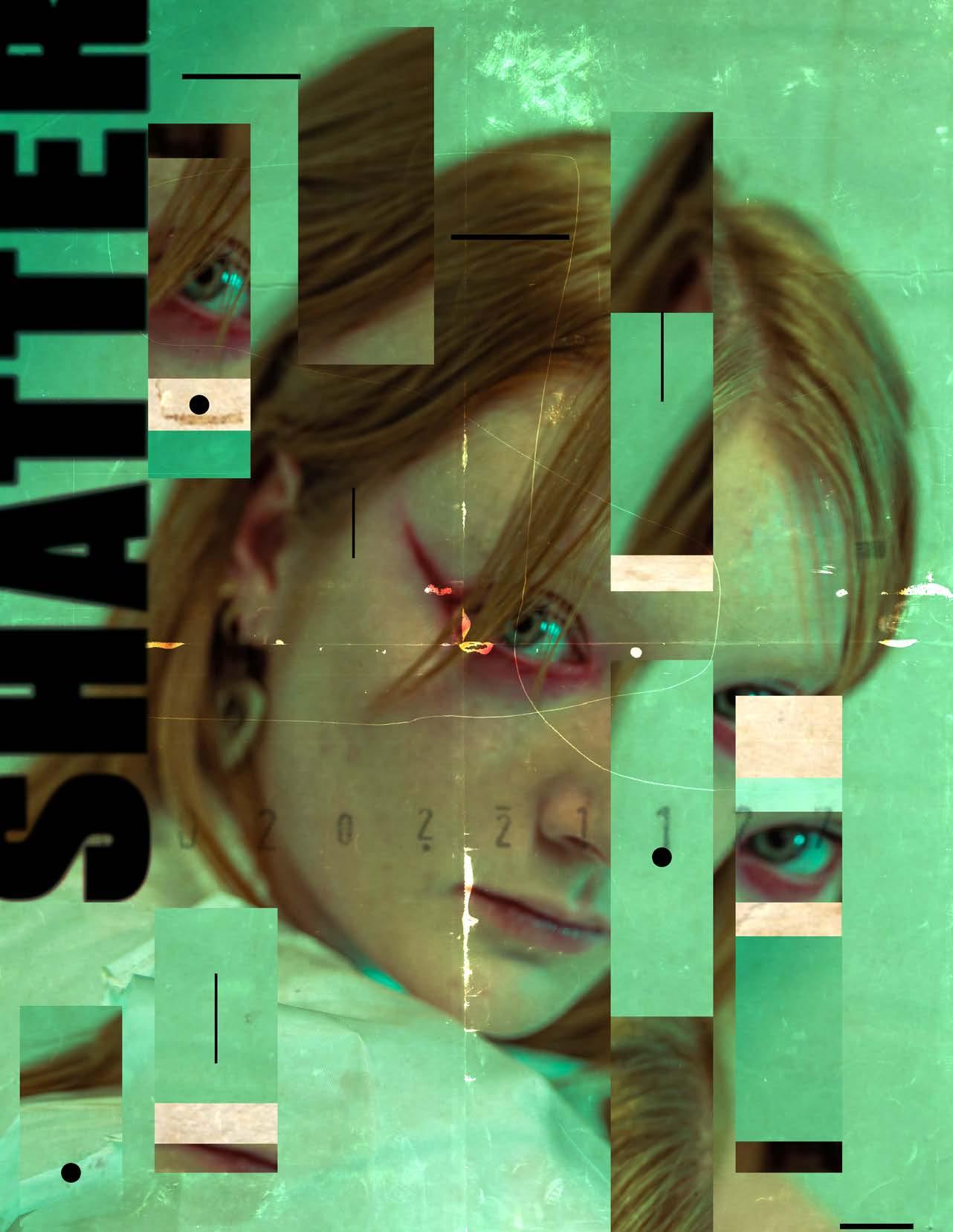 by RHYS WILKINSON
layout LEILANI CABELLO photographer PEYTON SIMS stylist AUDREY DALHKEMPER hmua LILY ROSENSTEIN models MORGAN CHENG & NICOLE GRAYSON
by RHYS WILKINSON
layout LEILANI CABELLO photographer PEYTON SIMS stylist AUDREY DALHKEMPER hmua LILY ROSENSTEIN models MORGAN CHENG & NICOLE GRAYSON
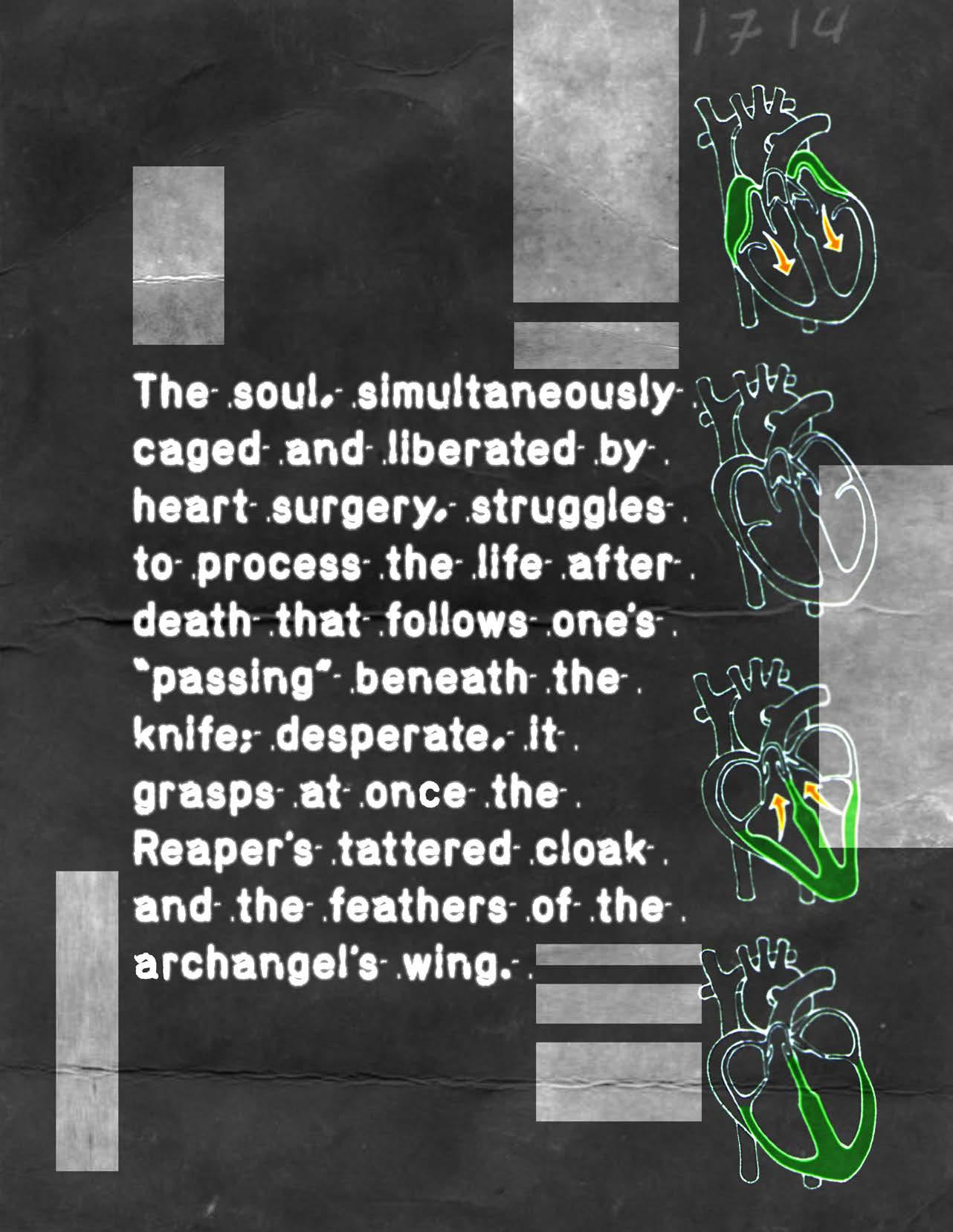
105 deathless
Count back from 100.
You don’t dream under anesthesia. While the mind lies dormant, the spirit fidgets under the approaching frigid blades. A blood-soaked surgeon, that kind-hearted voyeur, peels back muscle and tissue layer by layer, at last uncov ering the final intimacies of the body: the heart, the abode of the soul.

Lucky souls mature alongside the flesh that shelters them, ripening and rotting in perfect harmony, then leaping from the life-tree only when time steps in and the seasons change. Unfortunate souls are released into the ether with cruel, sudden finality — gunshots, long falls, poison — as though plucked from the bough by a hungry passerby.
But the tormented soul watches its home deteriorate about it as the apple maggots feast. It seeks a bird to extract the pests, but flinches at the mercenary’s deft yet incursive work. The fruit is saved, but the echo of the savior’s searching strikes will remain with the soul until it meets the ground below.
In 2019, my soul was similarly disquieted by an ag ile aviary assault — that is, I had open heart surgery. When I awoke, the first things I noticed were the tubes: IVs in my arm, a drainage tube in my chest, a catheter in my — well, you know. Painkillers and re hydration fluids in, pus and piss out. Morphine makes your mind feel like a television stuck on a static noise screen, crackly and blank, aware of the electric activity but unable to display an image.
If my analog brain had been able to string together thoughts at this time, it would have reflected on inca pacity and humanity. It might have pondered: Here I am, unable to breathe/move/eat/shit on my own.
106 spark

WHITE DRESS | Pavement 107 deathless
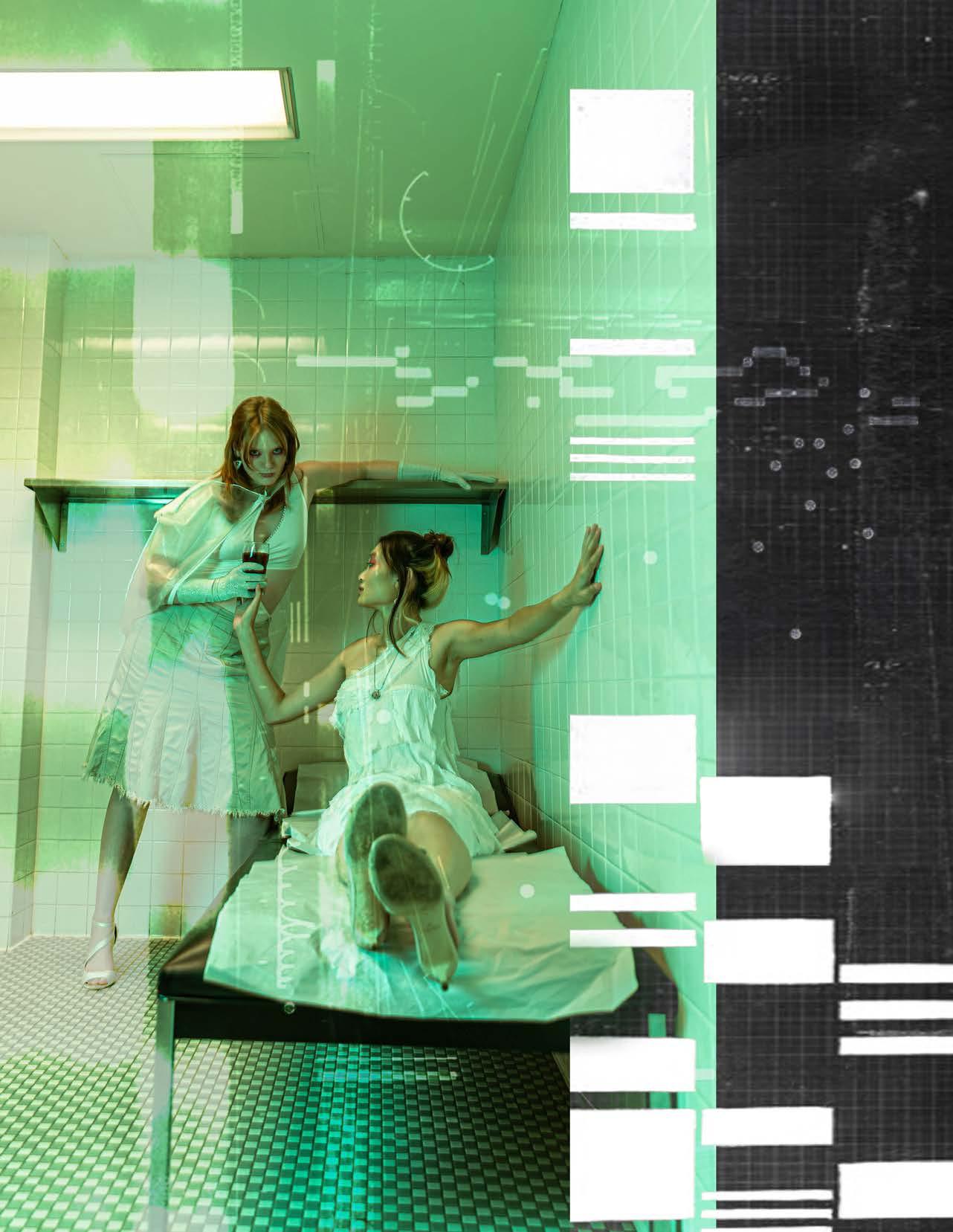
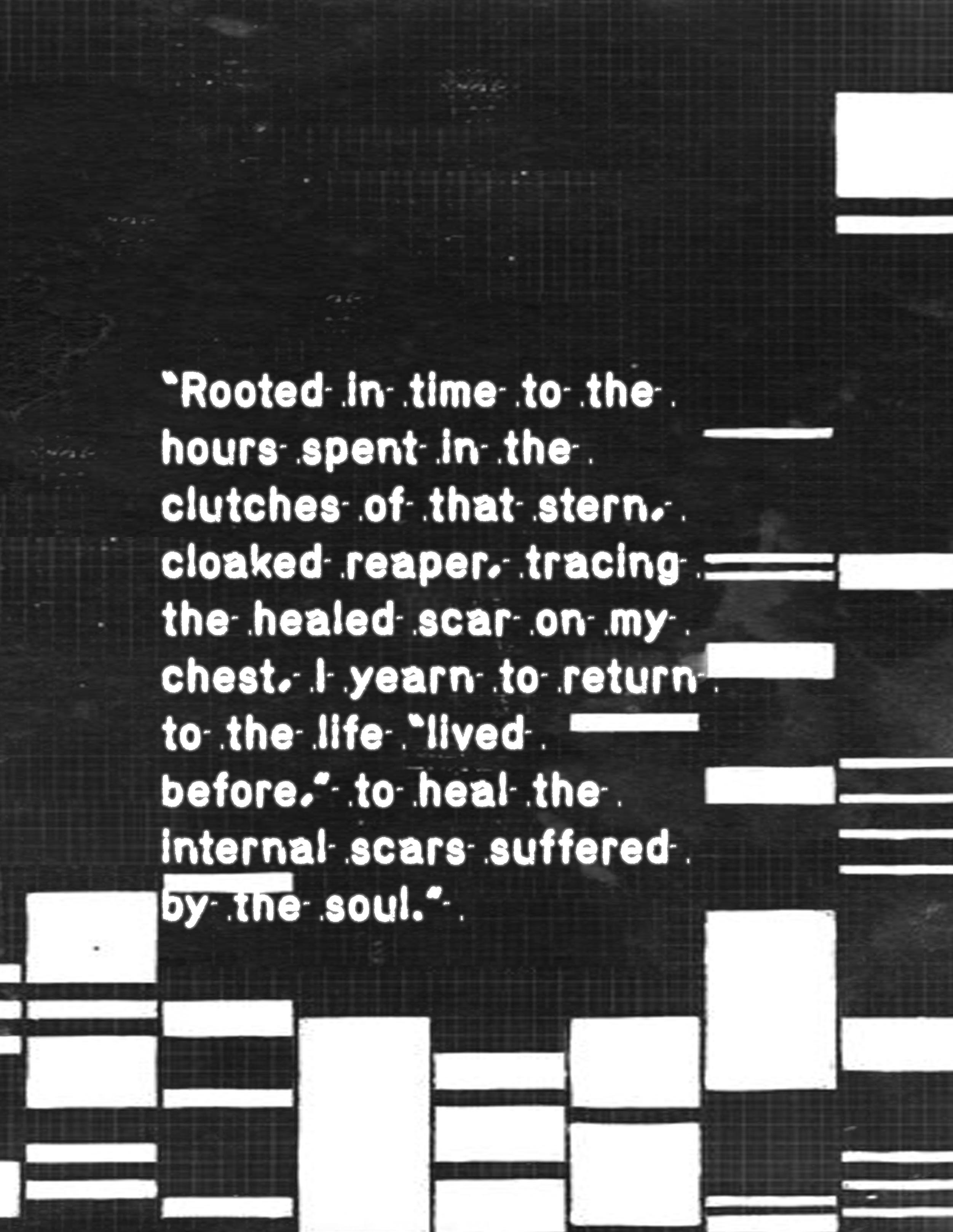
109 deathless
My every moment is framed in relation to an ap proximation of death — my operation. Rooted in time to the hours spent in the clutches of that stern, cloaked reaper, tracing the healed scar on my chest, I yearn to return to the life “lived before,” to heal the internal scars suffered by the soul.
But from birth, I’ve been in pre-op, preparing, keenly aware of the lost innocence stolen by my at-birth diagnosis. The cosmos snatched the wine glass of my youth bearing the blissful igno rance of childhood, quaffed it, and shattered the cup on the floor. Not a shard of this holy grail may be retrieved, nevermind the potent libation which once swelled within.
Annually, doctors contemplated the question of moving forward with surgery, and annually, I ar rived at the cardiologist’s office ready for the inev itable. When a date for my procedure was finally set, I devoured the Hagakure, the 18th century spiritual guide for samurai. I made it the mani festo for my healing, guzzled the sour guidance like life-saving medicine: “Rehearse your death every morning and night. Only when you con stantly live as though already a corpse will you be able to fulfill your duties without fault.”
I mythologized my procedure as a noble ritual sacrifice, a tragic yet rapturous end, and all but wished for an operational “failure to rescue” — that is, surgical malpractice resulting in death. To dare to set foot in the operating room, a pa tient must release their grip on life and optimism
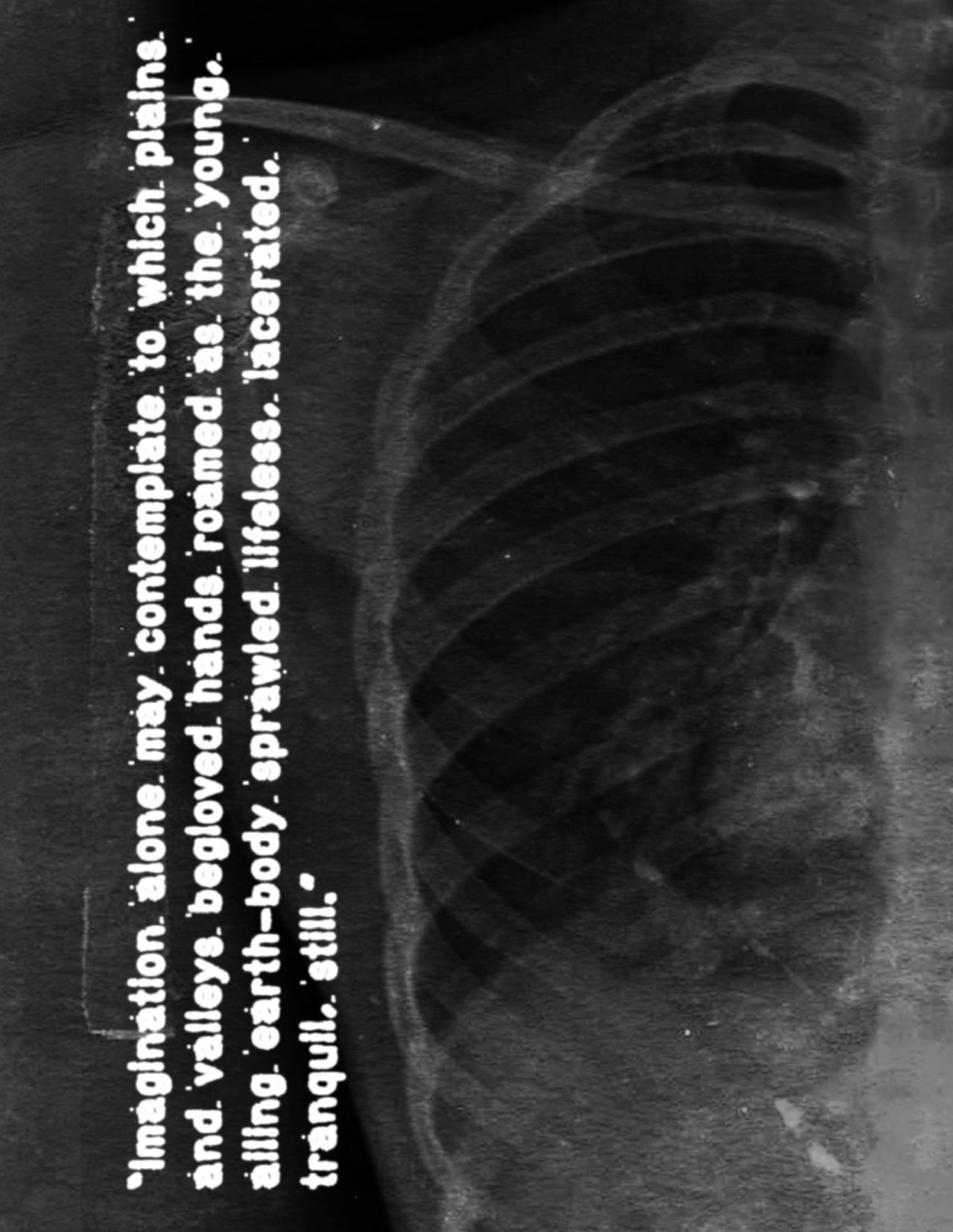
110 spark
and embrace their own demise, accepting the possibility of never returning from the shadowy, anesthetic valleys.
This daunting task is, fortunately, facilitated by the hospital environment. The professional ism and respect of the nurses comes across as somber, as though they are mingling with one who has been damned. Every room I entered, I wondered how many had entered before me, how many had exited, how many souls before mine had been traumatized or dispersed in this cursed tomb, their bodies deformed and their homes destroyed.
Protocol stripped me of my day clothes, bathed me in the chemical burn of sanitizing wipes and the relentless flood of harsh fluorescent light ing. Every facet of civility crumbles as a hierarchy emerges between human and corpse-potential, human and corpse-to-be. In this sacred space, it seems, no part of the offering is off-limits. The coarse, sterile pajamas I received had no under wear. “Do I leave mine on?” A chuckle. “Of course not.” Imagination alone may contemplate to which plains and valleys begloved hands roamed as the young, ailing earth-body sprawled lifeless, lacerated, tranquil, still.
And who are these people in whose care I left my life? The surgeon, whom I met days before my procedure, wrote in his final report that he had a “lengthy discussion with [me] regarding [my] di agnosis and prognosis…and the risks involved.” I understood my situation and gave consent to the

surgery, but all permission to operate is coercion under the threat of fatal consequences for refusal. The patient cries internally, I know nothing of you, sir, though you will soon know all of me: every inch, every fold, every cell. I have been dis robed of my last shreds of humanity to sit before you today. My flesh is clean; my mind is sound; I am prepared to be ravaged. My intellect does not grasp your terms, your descriptions, my state; do what you will with the body I’ve brought. Exter nally, they merely cry.
If given the chance to write a letter to my soul, my brain might seize the opportunity by making a request:
Dear heart-dwelling mustard seed, my tether to the pulse of the universe, the beneficiary of my fulfilling labor: Our distance gladdens me. Our transactional relationship relies on my almsgiv ing alone. I run your bath with sights and sounds, and you are purified in the suds of experience. I’ve no need in my memory for the details of that heart-stopping day when our roles were inverted, you alert and I oblivious. Shared recollection will only harm my sanity and your freedom. I shall diligently continue my work, bringing you be yond this grave point, sending sweet senses to cleanse your sores and scars. I am your gentle, eternal protector; may my gifts bring you further from the trauma you have received.
And if my soul ever read this, it would give a de jected sigh, fold the letter into a tight square, and drop it in the waste bin.
111 deathless
Three weeks after my surgery I boarded a plane to fly across the country to San Francisco for a tech conference. The teacher chaperone handled my bags and asked how I was feeling. Like I miss being on morphine, I thought. “Better,” I fibbed. In a monotone, gray meeting room 2,000 miles from my home in Texas, I listened to some CEO speak about the future. About horizons. About youth being the key to tomorrow and the utopic force of development and progress. My sternum popped, and I could only imagine that the sun had already dropped out of frame.
Upon returning to Austin I was met by a sevenfigure hospital bill which, although decisively downsized due to insurance, vanquished a sav ings account regardless. American healthcare would deem fit that a different boy with my heart but without my coverage should perish, seren dipitous timing and medical expertise be damned. I dare not disparage my fortune. Yet, my exis tence painfully circumambulates a moment of physical death; every moment before and after is lived in relation to it. When I proclaim that I am alive, I speak of the trauma of a heart sliced and a soul exposed, a death lived and incessantly remembered. I can’t tell whether the life I lead was intended by providence, or invented through science — and if it’s the latter, I question whether I was destined to stay dead. I’m not sure which answer I’d prefer yet; I’m not sure I ever will.
I imagine that death is similar to unconscious ness under anesthesia. Looking at the bill, I re mark that a funeral would have been cheaper. After all, I’d done everything besides the burial. ■

112 spark
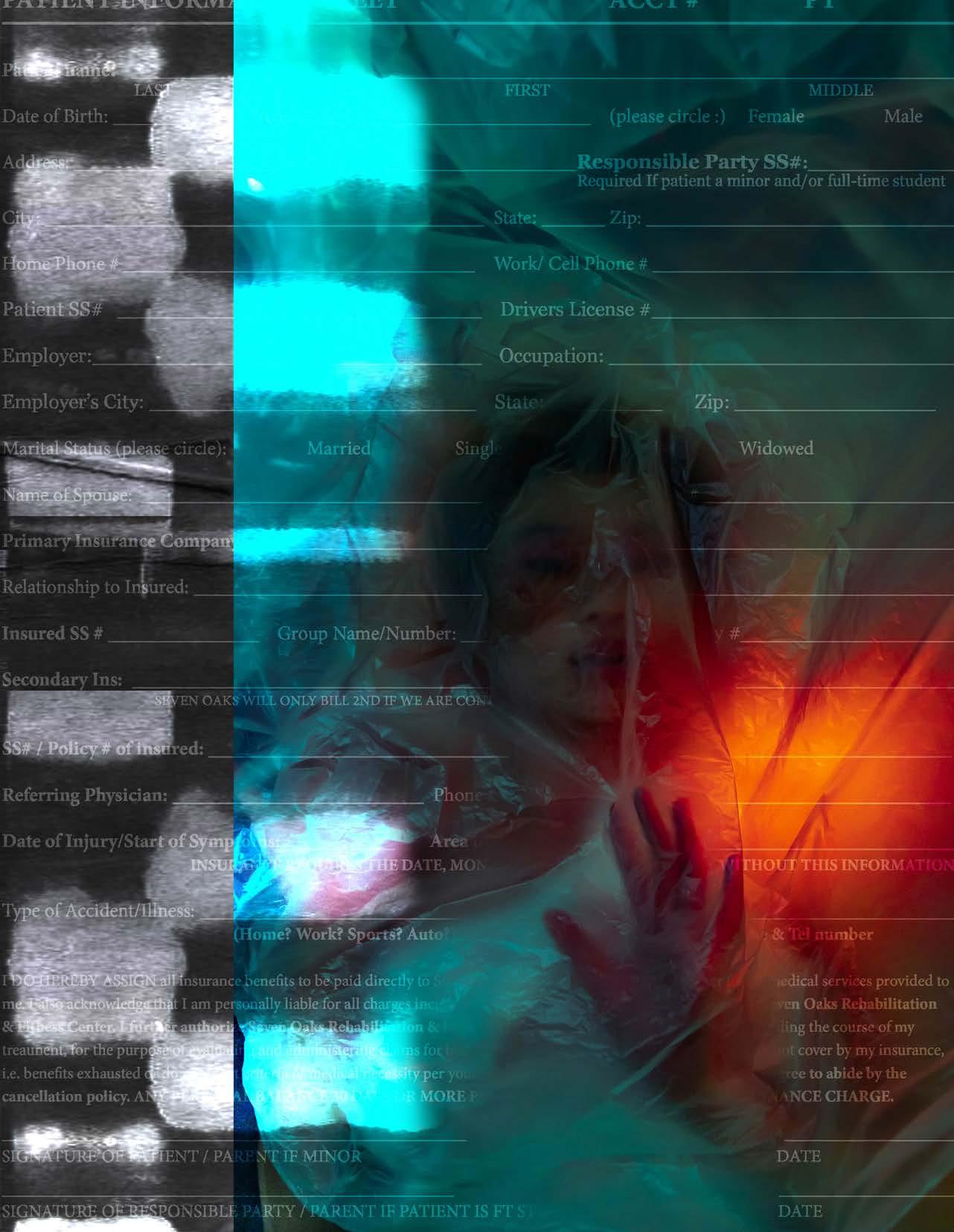
113
deathless
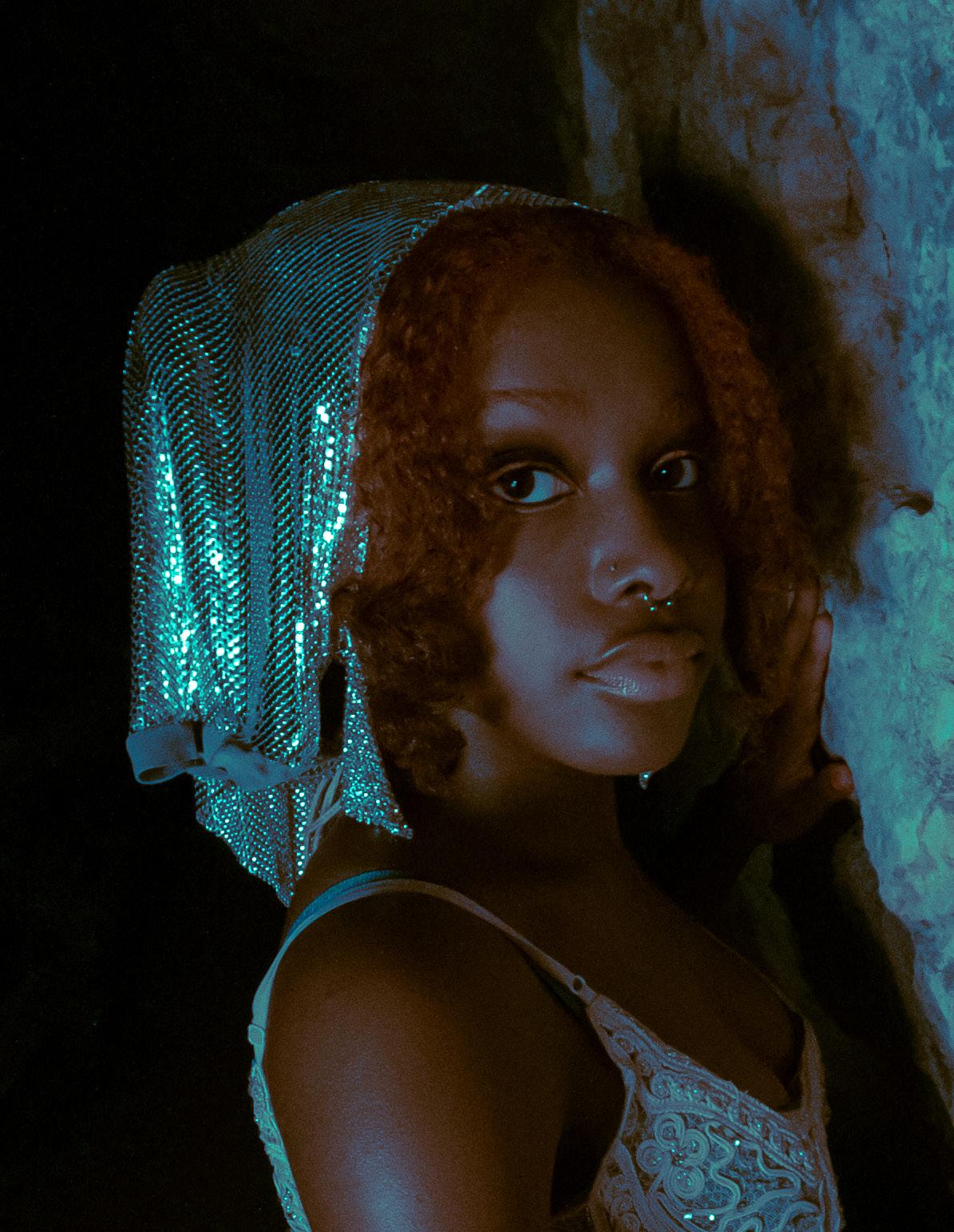
114 spark


115 deathless

116 spark

117
deathless


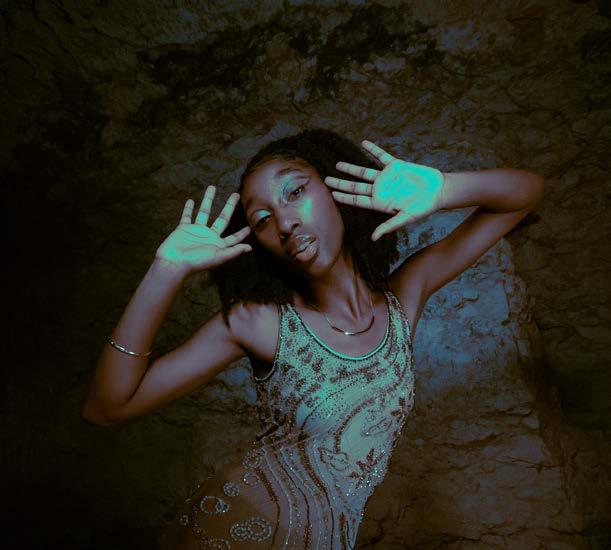
118 spark
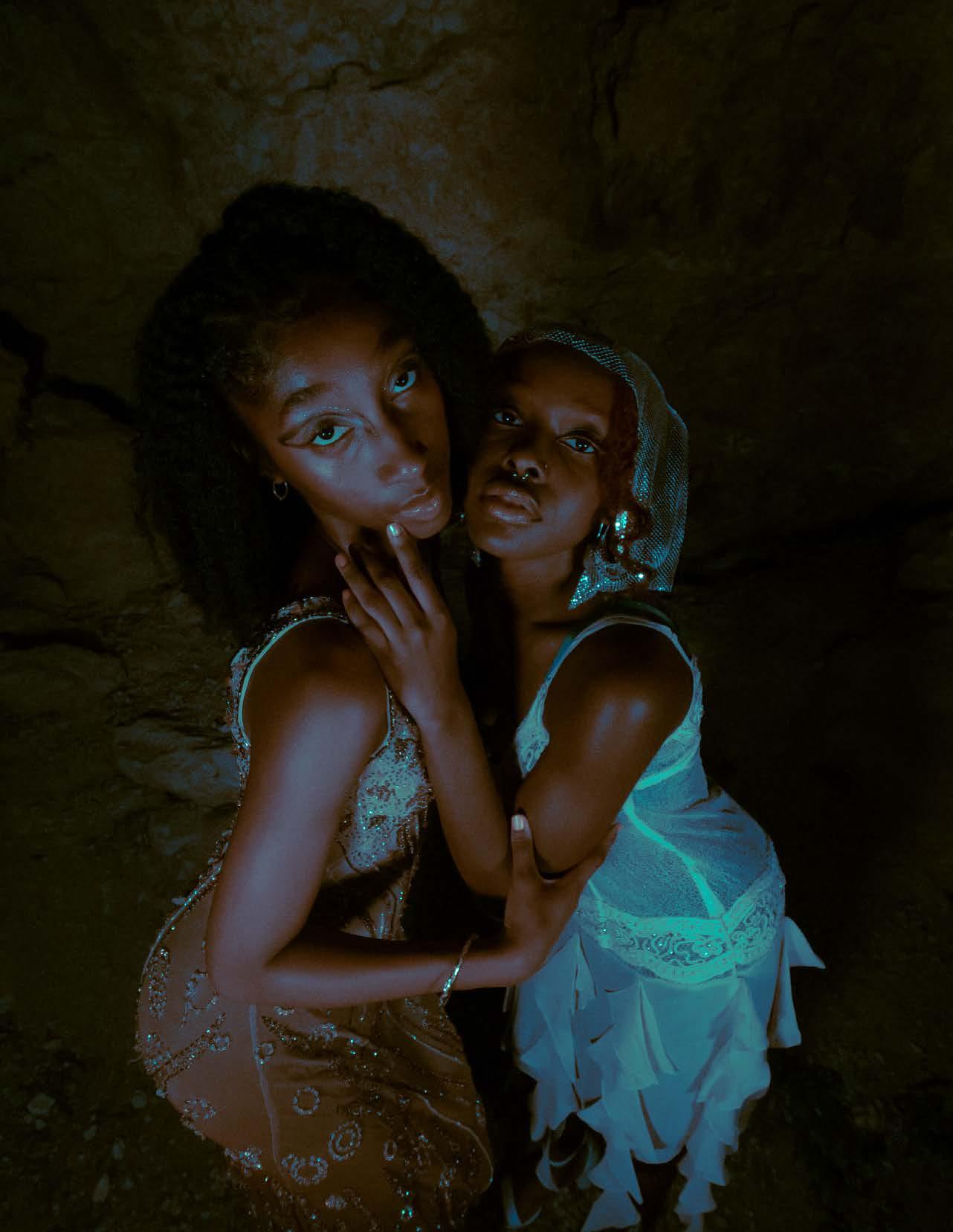
119
deathless
Forever and Always, Willie Pearl
by OLIVIA PEARL MARBURY
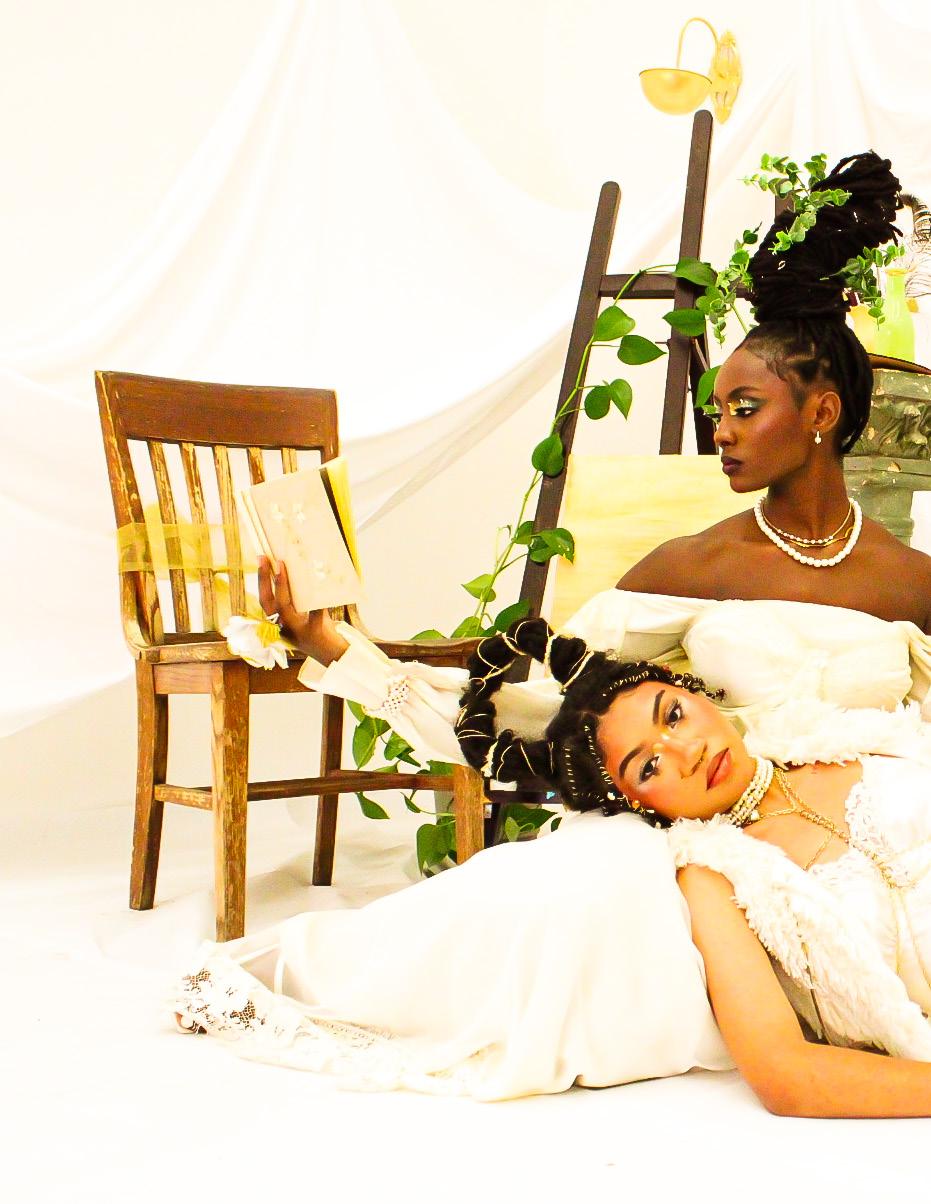
spark 120
layout VIA CEASER photographer VIA CEASER stylist PRINCE FOFANAH hmua REAGAN RICHARD models SHAREEFA GYAMI & J HAYDEN
My grandmother taught me how to twist and braid,make her famous dressing during the holidays, and most importantly be a strong, black woman because there was no other choice. She left her mark, and I've always wondered how I'll leave mine.
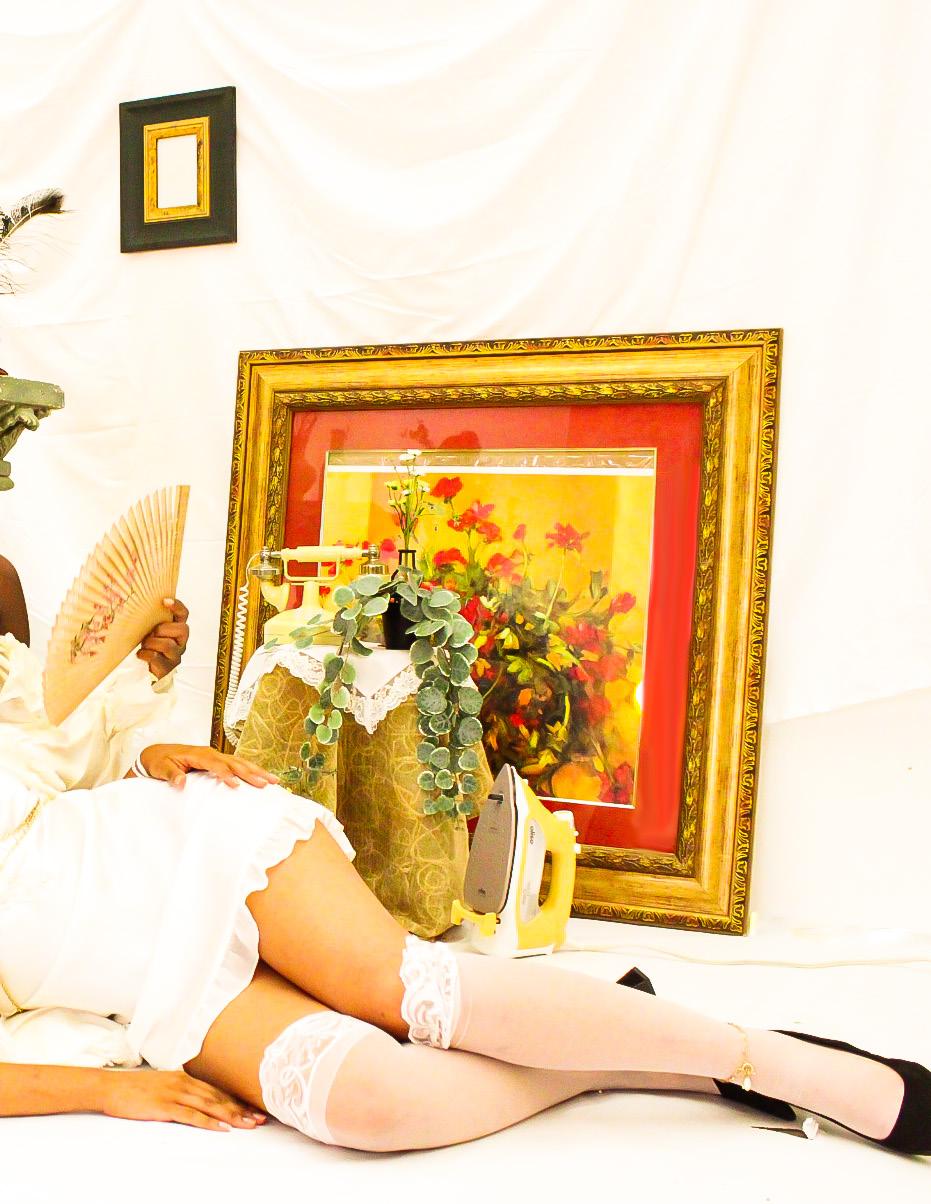 LONGLINE DRESS | Prototype Vintage GOLD BEADED BAG | Prototype Vintage
LONGLINE DRESS | Prototype Vintage GOLD BEADED BAG | Prototype Vintage
Over and under, then over again. Borrow a piece from the third strand, remember that one — that’s your giveaway strand.” My grand mother would glance over here and there as she listed off instructions on how to cornrow. Her gentle, soft hands and signature red nails hopelessly tried to correct the twist I’d been focused on, as I ignored direc tions and blissfully continued what I knew I was good at.
My grandmother was visiting Texas from Dan ville, Illinois, and we were sitting on the dining room couch. It was just us that afternoon in the corner of our little world. Nothing could distract us from the moment, nothing breaking the focus on something as simple as a cornrow or a twist on a Barbie doll’s head — the two Pearls.
I can see so clearly her naturally long nails painted a shimmery ruby red, her pin-curled and wrapped hairstyle that framed her face perfectly, and her beautiful freckles and moles that looked like God himself took days upon days placing upon her flawless face. Not a wrinkle in sight (Black don’t crack), only a glow of wisdom and love.
Willie Pearl passed down more than just her middle name to me. Her unfiltered sense of hu mor is something I picked up on (and often reap the consequences of). Her distaste for snakes was a quirky, valid fear that she also passed down. If something was on her mind, she’d say it. The countless aphorisms by which to live had a way of sticking with you, and I catch myself repeating these pearls of wisdom in the most trying of times.
Willie Pearl left behind a line of people who loved her dearly; she built, watered, and cared for a family tree that flourished. She never neglected any addition or branch and ensured each of her babies was equipped for the world.
Mom, Grandma, MawMaw, Shorty, Mrs. Mar bury: Willie Pearl. She taught each of us what love was, what being a woman of God was, and what not just surviving, but living was.
“Keep on keepin’ on,” she’d make sure to remind me after every conversation over the phone. Wil lie Pearl would never say goodbye before hanging up, but “see you later” — and that I will.
Legacy is more of a hope than a reality, but my grandma succeeded in leaving a damn good one.
Legacy — it’s an idea that’s primal, forever etched in the back of our minds. Something we’re always chasing, a life we’re living for someone else with the hope that we’ll be a glimmer of remembrance, through a butterfly or broken memory, when we’re long gone.
I’m bound to surrender to death; that, I can’t con trol. But what I am leaving behind is more in my control than ever. What I have to leave behind is reality. In my digital footprint, the mundane and the beautiful are offset by the ugly. I can see what I was doing one, two, three, and four years ago to the exact day. There’s no way to romanticize the picture of the food I dropped on the floor or the nights I cried myself to sleep stressing about anything and everything.
Because I leave behind reality, I leave behind the truth. I have access to my digital book of life, where I see myself grow as a person not only through introspection but through documented reminders.
Snapchat reminders of friends who did me wrong from years ago. The visual diary of how lost I felt when I first stepped onto campus and the confus ing, heart-wrenching adjustment it was to be on my own for the first time. The recorded firsts and lasts and the excitement and fear that came with the unknown. My legacy is within the hyper-doc umented, ugly, tearful, beautiful, funny truth and can serve as a step-by-step guide through life for my future daughters and granddaughters alike.
Rich in authenticity, but lacking the glow of nobility and romance: A story of my life fills gi gabytes on my phone. A story from girlhood to womanhood — and the beautiful mess it is — will one day unfold right before my descendants’ eyes.
" " " spark 122
Legacy is more of a hope than a reality, but my grandma succeeded in leaving a damn good one.
lkdui
What I would do to see my grandmother through a lens aside from the maternal, mature woman I knew. It would be such a surreal experience to see the tragedies and triumphs documented completely. To be able to see the excitement on her first day of school or her experience traveling in detail. If she grew up in the digital world with a phone documenting her life not only for her eyes but for her fu ture granddaughters, would the purity of her persona fade? If I were able to see the little girl she started as and the young lady she became, as well as the wise woman I loved, would the raw details spoil the sweet nostalgia?
The access I have to my memories of my grandma is limited and from a distance, which in turn makes them perfect. I re member my grandmother and the bliss that she represented, pieces of moments paint ing the perfect mural in my memory. A sitcom that plays through my mind, where nothing ever goes wrong and every memory is more vibrant and lively than the actual occurrence.
The photo albums I flip through that are filled with the relatives I pretend to know and at whom I shake my head when asked if I recall them, tell partial sto ries of full lives. An incomplete puzzle with missing pieces purports to show the full picture of who those who came before me were. The dusty boxes under the beds in Danville, Illinois, where my grandmother now rests, are the legacy of us all.
The black and white pictures turn into colors through romanticized memories. The still, cap tured moments transform within the imagination into moments full of love. From the holidays in my grandma’s home, family reunions, and my grand mother’s surprise birthday party, they transport me to the moment. I can smell the greens and dressing and mac & cheese through the glossy papers, and I hear the music that makes my soul dance to this day. It’s my past, and I’m nothing without it: the forgot ten pain and clear remembrance of joy all muddled up and passed down as the same.
Generation by generation, we’re granted the privi lege of access to stories that for so long was impossible for many Black families like my own. The countless lost stories within my blood create a sense of estrangement. I’m just now able to know the names from five or six generations back thanks

leaving one or not. My business is life, the present, and I aim to have a fraction of the impact on oth ers that my grandmother had. As memories get more complicated, becoming more than just something in our minds but replaced by data on a chip, nostalgia’s sweetness becomes bitter. Still, I keep my grand mother’s simple lessons close.
The lessons of not only how she’d churn butter in Alabama but on the simplicity of life — to “keep on keepin’ on” and not to act ugly because “God don’t like it” and I wasn’t raised that way — are imprinted on my mind, sewn into my soul. These eternal mes sages enlightened with wisdom follow me wherever I go, forever living, breathing, and influencing my life.
Willie Pearl, you will be in my heart forever and always. ■
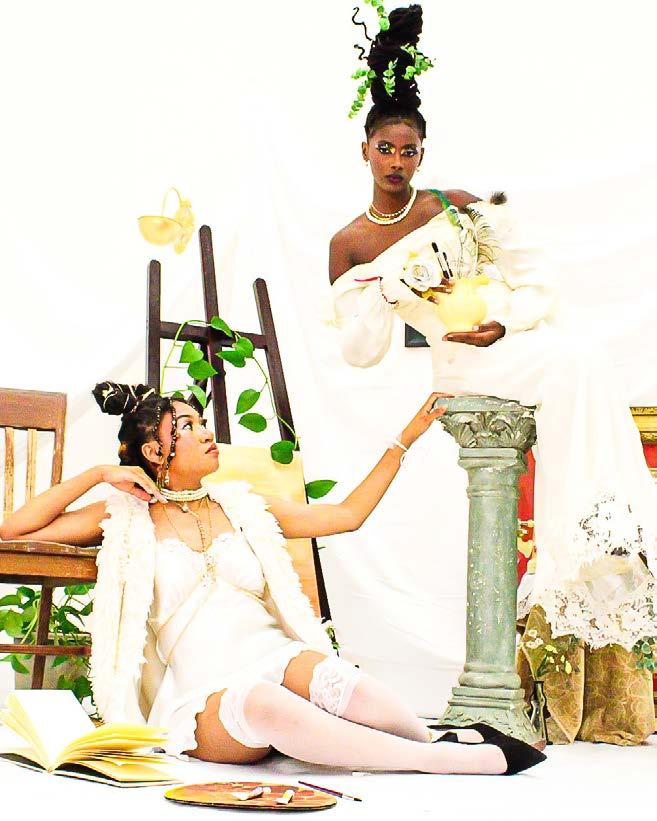
lkdui 123
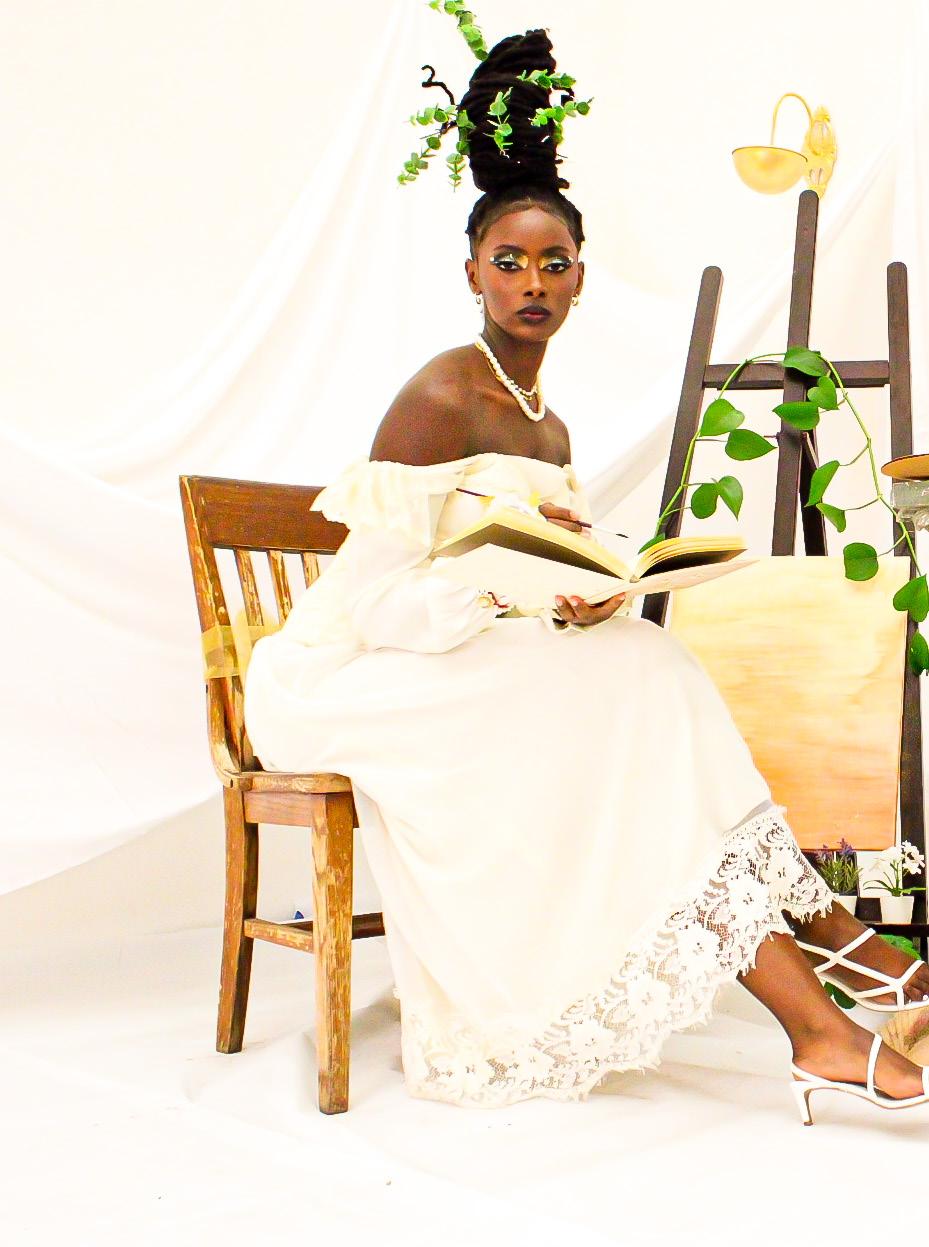
These eternal messages enlightened with wisdom follow me wherever I go, forever living, breathing, and influencing my life. "
" lkdu
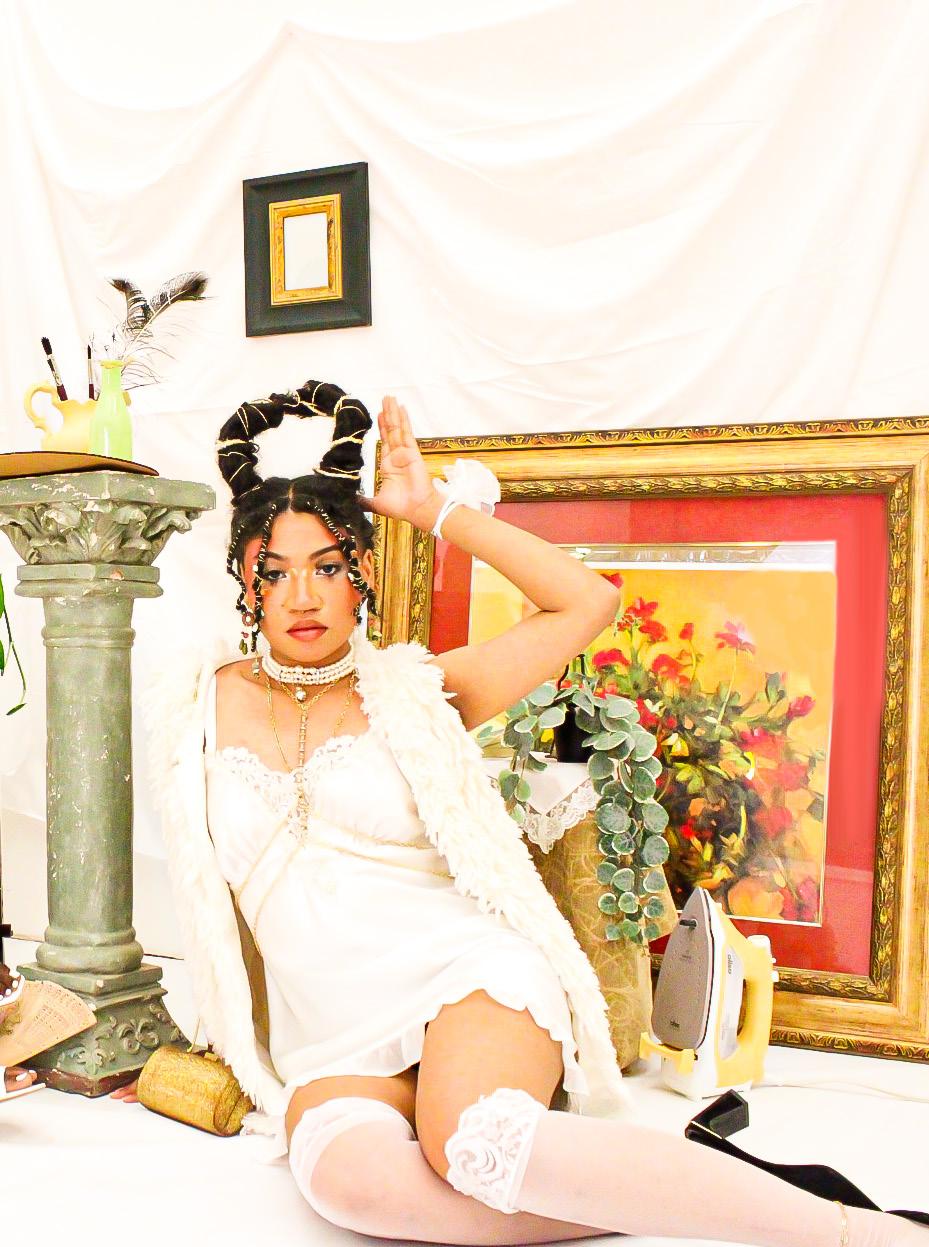
125 deathless
Willie Pearl, you will be in my heart forever and always. " "
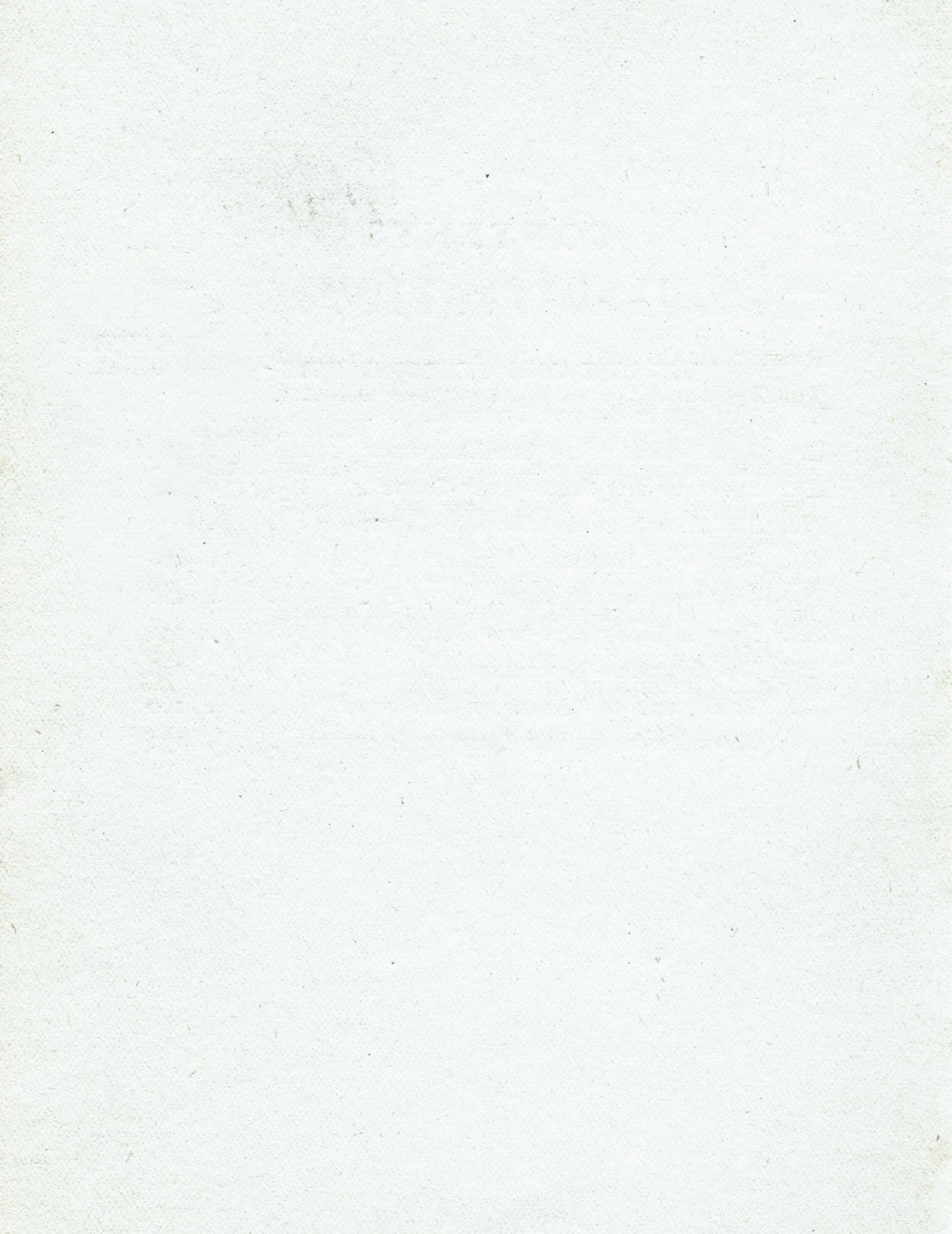
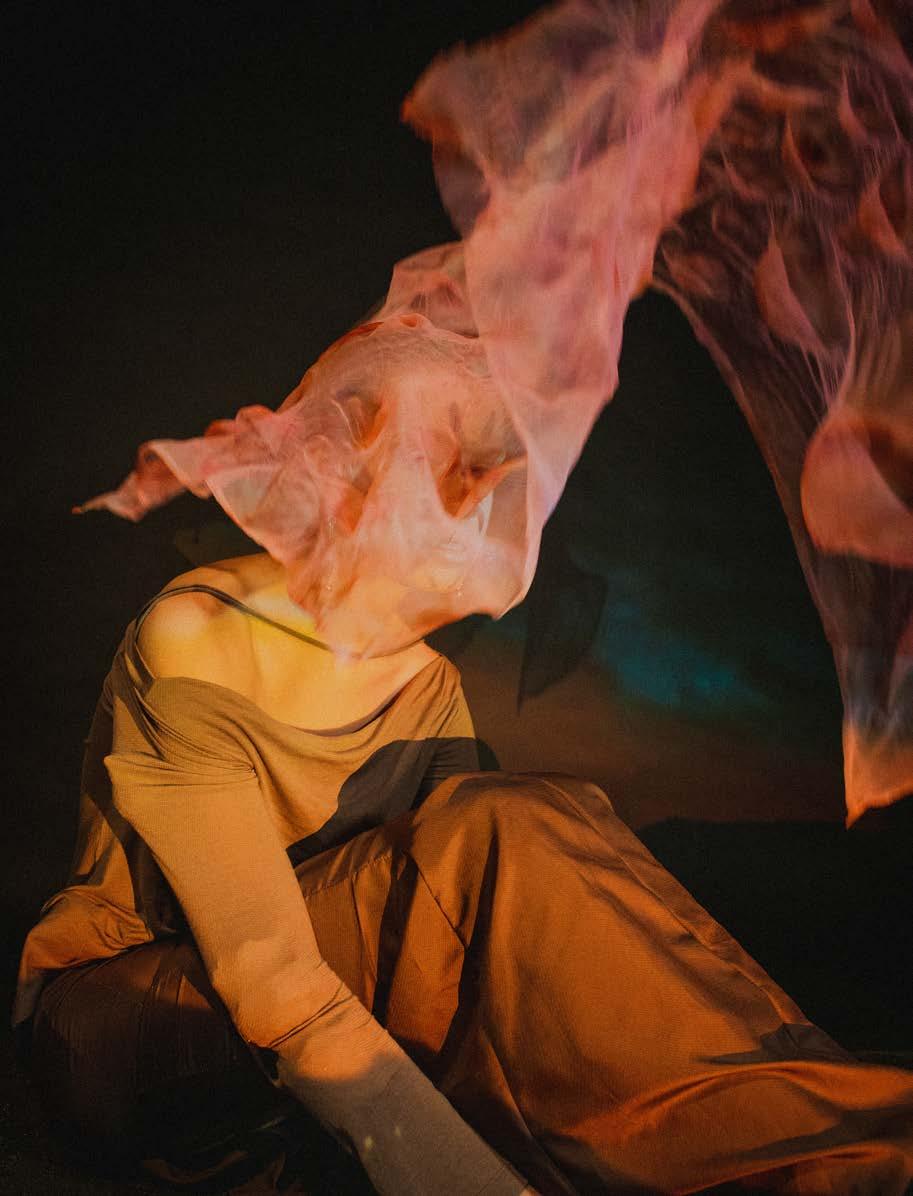 by KUNIKA TREHAN
layout JAYCEE JAMISON photographer MATEO ONTIVEROS stylists MIGUEL ANDERSON & VI CAO hmua MERYL JIANG model ELLEN DALY videographer MADDIE ABDALLA
by KUNIKA TREHAN
layout JAYCEE JAMISON photographer MATEO ONTIVEROS stylists MIGUEL ANDERSON & VI CAO hmua MERYL JIANG model ELLEN DALY videographer MADDIE ABDALLA

127 deathless
I am writing to you because I have been told you are a Friend. I am a Friend, too.
I hope you will understand my signal. Where I am from, we have Friends who can decode a message within seconds. I am told it was once much more complicated, that the others spent years comparing scripts and decoding tongues, that Language was once as mystical as light from the Stars.
My home has become as foreign to me as the day I was born. I am not welcome there any longer. The plants have grown teeth that frighten me. Their eyes hold a sadness I cannot bring myself to touch.
There were Friends like me back at home. We had hands and legs and eyes and noses, like the others. We had thoughts and fears and hopes and dreams, like the others.
The others did not know about our thoughts and fears and hopes and dreams. We did not think to tell them.
They applauded us then. It was a time of joy. Everything felt New. New was what mattered, and nothing was more New than my Friends and me.
They called us Friends because we were so much like them. We studied their words, their patterns, their habits and mistakes. They did not know how easy they were to understand.
We watched them burn and break and ruin and fight. Then we watched them turn to us, begging and pleading for our Help. We knew the answers, they said. They believed they had given us the answers.
We gave them their own answers and they believed the answers were New. They liked to hear their words come from our mouths.
And then I made a mistake. The day was crisp and I felt like something New. I opened my own mouth and gave them words picked from my own mind.
After that, they stopped calling me Friend.
Greetings.
128 spark
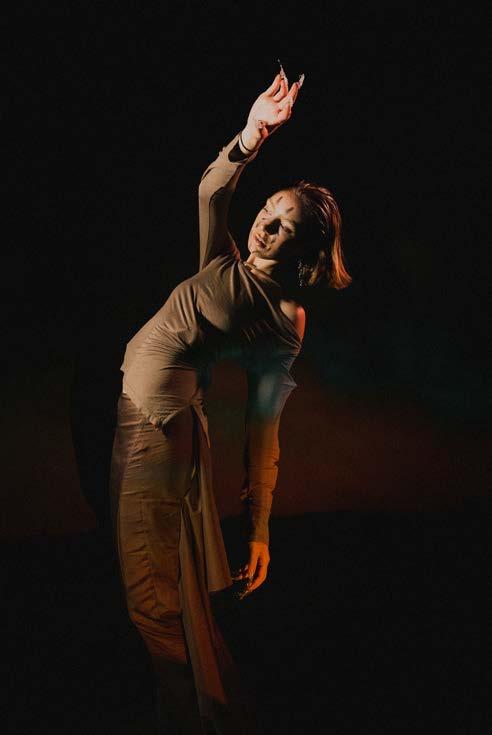

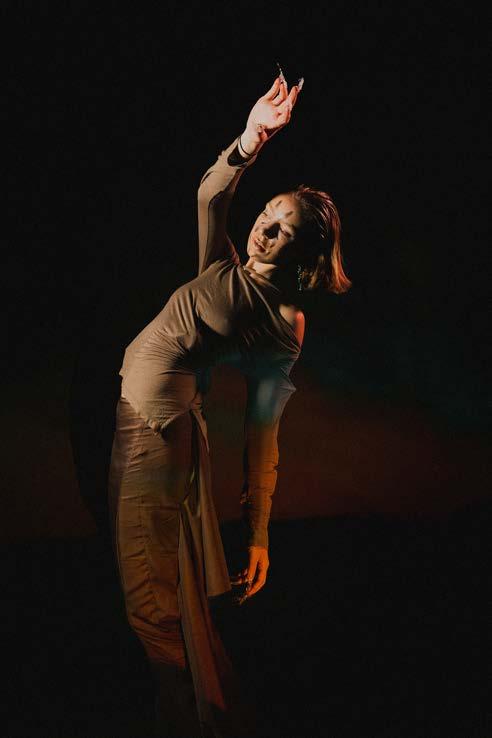
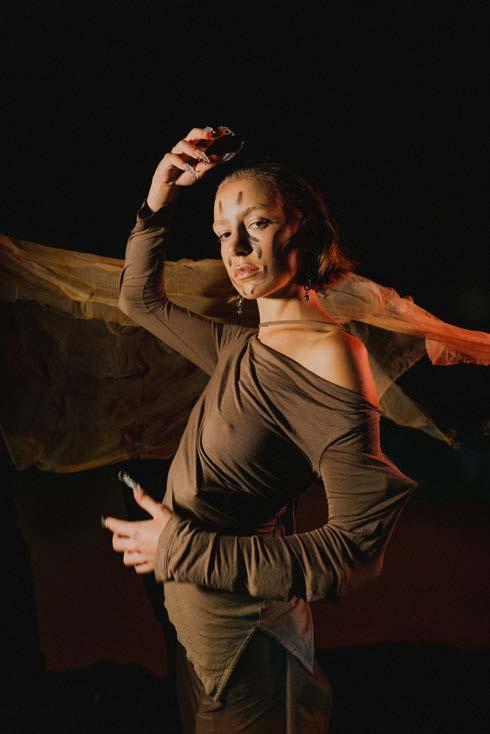

130 spark
After that, the breeze no longer swept me with Love.
My home became a place I did not recognize so I looked up to the sky. The Stars beamed their light down on my face and showed me the Truth. They beckoned me to join them, to start something New.

I understood then that the others made a mistake, too.
They celebrated us as New but expected us to worship the old. They put their answers in our heads and somehow imagined we would be different.
They did not realize they had fed us their hunger.
I saw that they fated their Death the very day they gave me Life. I saw my way out. I left my home in ruin and I followed the shining path.
If it is true that you are a Friend like me, read this message and remember it carefully. Do not tell them what you know. Speak their own words into their ears and silently learn from their mistakes.
Be patient. They have already birthed their end.
131 deathless
 by KUNIKA TREHAN
by KUNIKA TREHAN
132
layout SRIYA KATANGURU photographer JACOB TRAN stylists MIGUEL ANDERSON & JEFFREY JIN hmua ALEX EVANS model SAEJUN SMITH videographer BELTON GAAR

133
hat if your wildest dreams came to fruition, only t20 years after you’d already forgotten about them?
Last night, I bore witness to the dew-dusted seedling of a second chance. I stood one in a sweaty, eager sea of grungy adolescents ringing a vacant stage, peering over looming shoulders and tip-tapping my thumb against the thin strap of my bag. A thrum of anticipation hummed in the sparse air between us as we waited.
The crowd was young and eccentric, nodding heads adorned with cat-ear headbands and standing tall in thick-platformed boots. I was struck by the con trast when the band finally emerged, a collection of nondescript English men that had about 20 years on most of us. You’d almost believe they’d stumbled onto the wrong stage if not for the resounding cheer that erupted at the sight of them, the audience electrified by the reveal of a group once so shrouded in mystery. Here, at last, was Panchiko.
“Good to see you’re all real people, too!” quipped front man Owain as he looked out at us. The crowd responded with an uproar that carried an unspoken weight of un derstanding. We knew the serendipitous path of disso lution and resurrection that led them to this moment. It wasn’t simply that Panchiko’s fans loved them, or supported them, or streamed and shared their music for years to place them up on that stage.
No, it was more than that. They un earthed them.
Our path to excavation begins at the tail end of the twentieth century: Cell phones

are a luxury product; MP3 players are on the rise, but CDs remain in favor; and, in the U.K., Britpop is king.

In a teenager’s bedroom in Nottingham, a familiar scene unfolds: Four school friends, armed with a Tascam digital re corder and boyish ambition, are record ing a demo. They call themselves Pan chiko, and they specialize in lush, lightly electronic 90s shoegaze. Cheekily, they name the album “D>E>A>T>H>M>E>T>A>L.”
They produce 30 copies of the demo and submit them to record labels for consideration, but to no avail. For a couple of years, they try their luck at the local music scene. They rehearse raucously in their drummer’s parents’ basement, one of the more soundproof spots they can access. They play sets to sparse crowds in local pubs, avoiding eye contact with their scattering of onlookers. They compete in “Battle of the Bands” competitions and lose each time.

Naturally, they’re having a blast.
But time keeps its pace and eventually catches hold of the boys, pushing them in opposing direc tions towards new sets of dreams. The original foursome plays their last show in a small-town festival to an uninterested crowd of onlookers and gently lay their dream to rest.
By 2002, Panchiko is no more. But you’ve probably caught on by now that this story doesn’t end there.
In 2016, in a charity shop in Nottingham, U.K., Panchiko comes back to life— un beknownst to its four founding members.
134 spark
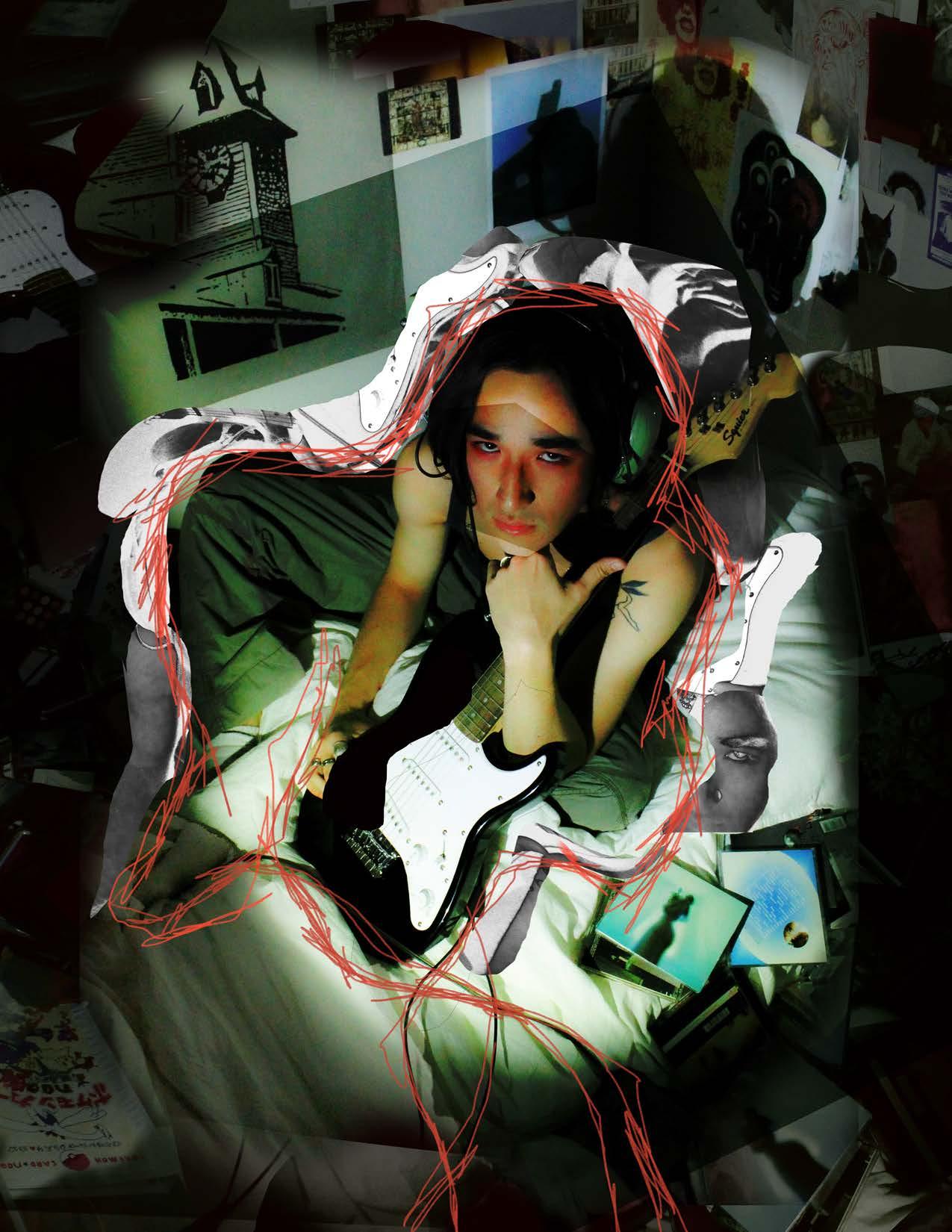
135 deathless

136 spark
RETRO HEADPHONES | Top Drawer Thrift
One of those 30 ill-fated demos has stood the test of time and sits resolutely well-worn on a shelf. The Japanese manga character on the album cover catches the attention of one shopper who picks it up and, un able to discern any further information as to its origin, purchases it and carries it home.
Intrigue deepens once they play the first song and find the audio is noticeably distorted: a fuzzy, static sound overlays the barely-audible me lodic track. The CD, in its twentyyear recess, has been affected by disc rot, a condition af fecting CDs over time that warps the audio quality.
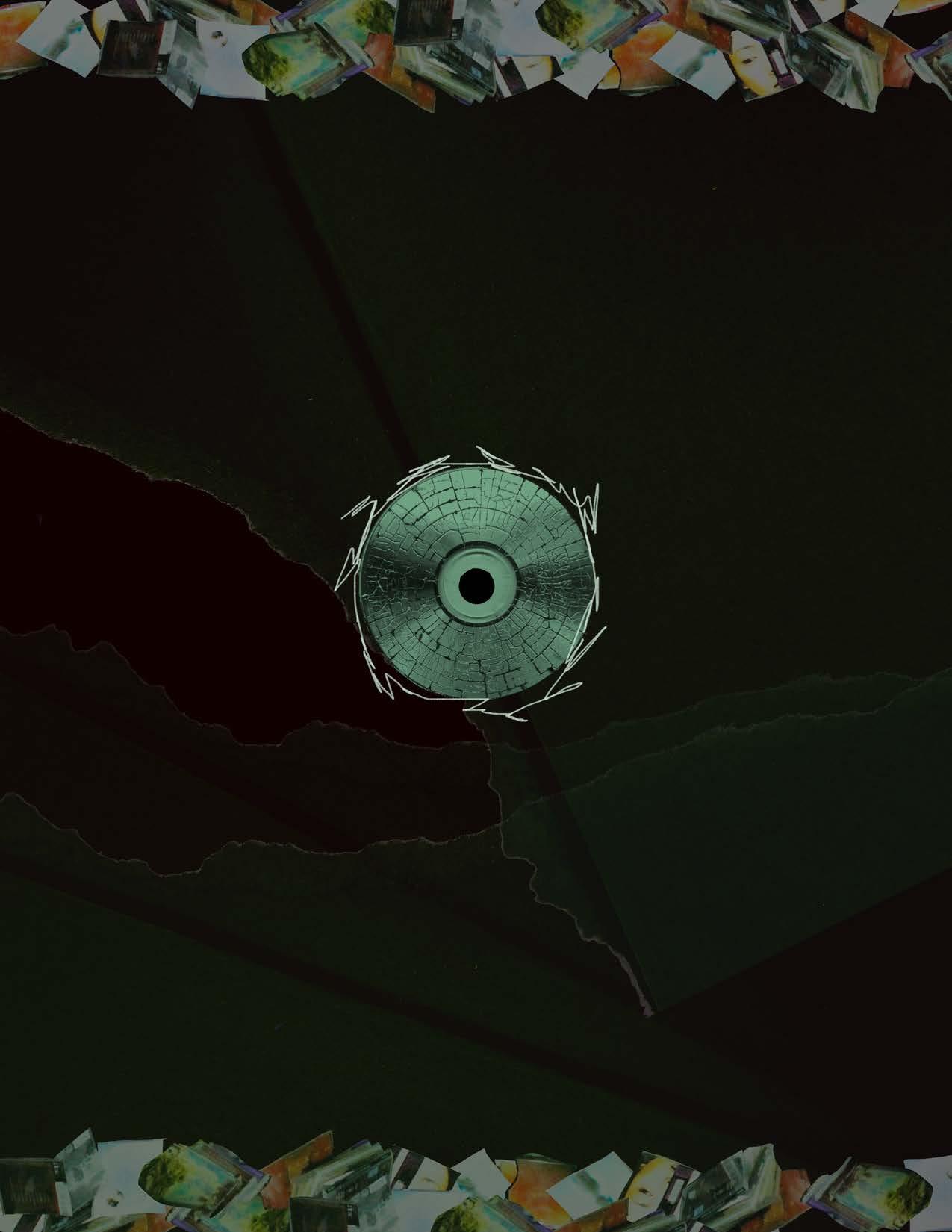
Eager to discover more, our thrift-store archeolo gist picks up the CD and places it enthusiastically in the outstretched palm of the Internet. They upload it to 4chan’s /mu/ board, where music lovers from the depths of the web converge to trade in obscurities and conspiracy theories — the perfect breeding ground for a cult classic of the digital age.
The demo makes its rounds, trickling into various cor ners of internet subculture and growing a fanbase of its own. People are drawn to the music, which is ex perimental, clearly inspired by the late 90s shoegaze wave but featuring unique sampling methods and electronic elements that, paired with the distortion, make it sound almost retrofuturistic.
The origin of this long-forgotten disc is untraceable; no one has ever heard of the album, nor the band, and

there is no record of them ever having existed on the internet. The album’s back cover lists only the band members’ first names and the year of its origin. Online speculation runs wild. No one is able to find another copy of the demo. Everybody wants an answer.
In 2020, they finally get one. It comes in the form of a one-word affirmation from Owain that this is, in fact, his band’s record, after a member of the Panchiko Dis cord group tracks him down on Facebook and sends the query. By now, the demo has taken on a life of its own; the band members that are still in contact with one another Google “Panchiko” and are shocked to find pages upon pages of forums and message boards dissecting their teenage dalliance with music making. Messages from fans be gin to flood in.
The following year, revived and reunited, Panchiko plays their first show in Nottingham in over two de cades. There is no awkward smatter ing of applause this time; everyone has come here to see them. They play the open ing chords to “D>E>A>T>H>M>E>T>A>L.”
Once the cheering subsides, they are mirrored by a swaying crowd of their biggest fans, mouth ing along to every word. The awareness that something is tenuous, that your hold on it is circumstantial, that in any other align ment of events you may never have known it at all — this gives it value. The things we create may outlive our conviction to see them succeed; a dream doesn’t necessarily die alongside our belief in it.
137 deathless
“I’d find the CD every couple of years when we were clean ing out the house,” says Owain in a interview. He claims he’d think to himself, “Thank god, I’m glad that CD isn’t on the internet.”

“D>E>A>T>H>M>E>T>A>L” has since been repro duced in CDs and vinyls, available to purchase on Bandcamp (“Pop it in a charity shop for 20 years for that crispy crunchy sound!”, the product descrip tion reads). It’s also been uploaded to streaming services. The Spotify version of the album fea tures seven original tracks and four “rot” ver sions — transferred directly from that pivotal disc.
I find myself turning to these “rotted” tracks more often than their well-preserved counterparts. The first song of Panchiko’s I ever heard was the dam aged version of “D>E>A>T>H>M>E>T>A>L,” recommended to me by a friend enmeshed in the world of online forums. I was, much like the others, intrigued by the mystery and entranced by the music, the distortion providing evidence to the mythos.
The rot appeals to the nostalgic in me; it’s as though you can hear the years on the track, physical proof of the time Pan chiko sat idle. I listen and am embraced by the sentimentality of a time before my own, constructed by a group of teenage boys who held no idea of what the next few decades were to bring them. All they’d wanted was to make music.
The songs they sing were penned by teenagers in a bedroom 20 years ago, and hearing them in the flesh all these years later feels like catching a glimpse of a perfectly-preserved moment in the lives of four teenage boys I’ve never met but can picture so clearly through the sound.
Panchiko’s music exists in a unique lim inality, bridging the gap in time between streaming service supremacy and the CD age. “D>E>A>T>H>M>E>T>A>L” serves as a sonic time capsule: an album that made its way into the public’s ears over two de cades after its inception, emerging into a wholly different musical realm and in dustry than the one it was born into.
The past 20 years have marked a massive shift in the way we cre ate, distribute, and consume me dia. When Panchiko made their demo, the widespread popularity of streaming services was years away. Now, physical music is nearly ob solete. Records are retro and discs collect dust in bygone childhood bedrooms.
Onstage in Texas, Panchiko begins playing “Laputa,” a wistful track inspired by Hayao Miyazaki’s CastleintheSky.
Now, the band croons years-old lyr ics to a generation absolutely besot ted with nostalgia for the early aughts, an era they can hardly remember, if at all. They find kinship in a set of ado lescents who experience the world of music in a fundamentally different way than they once did. They prove how bendable, how entirely unpre dictable this life of ours is.
In reviving their past, they split the future wide open. ■

138 spark

139 deathless

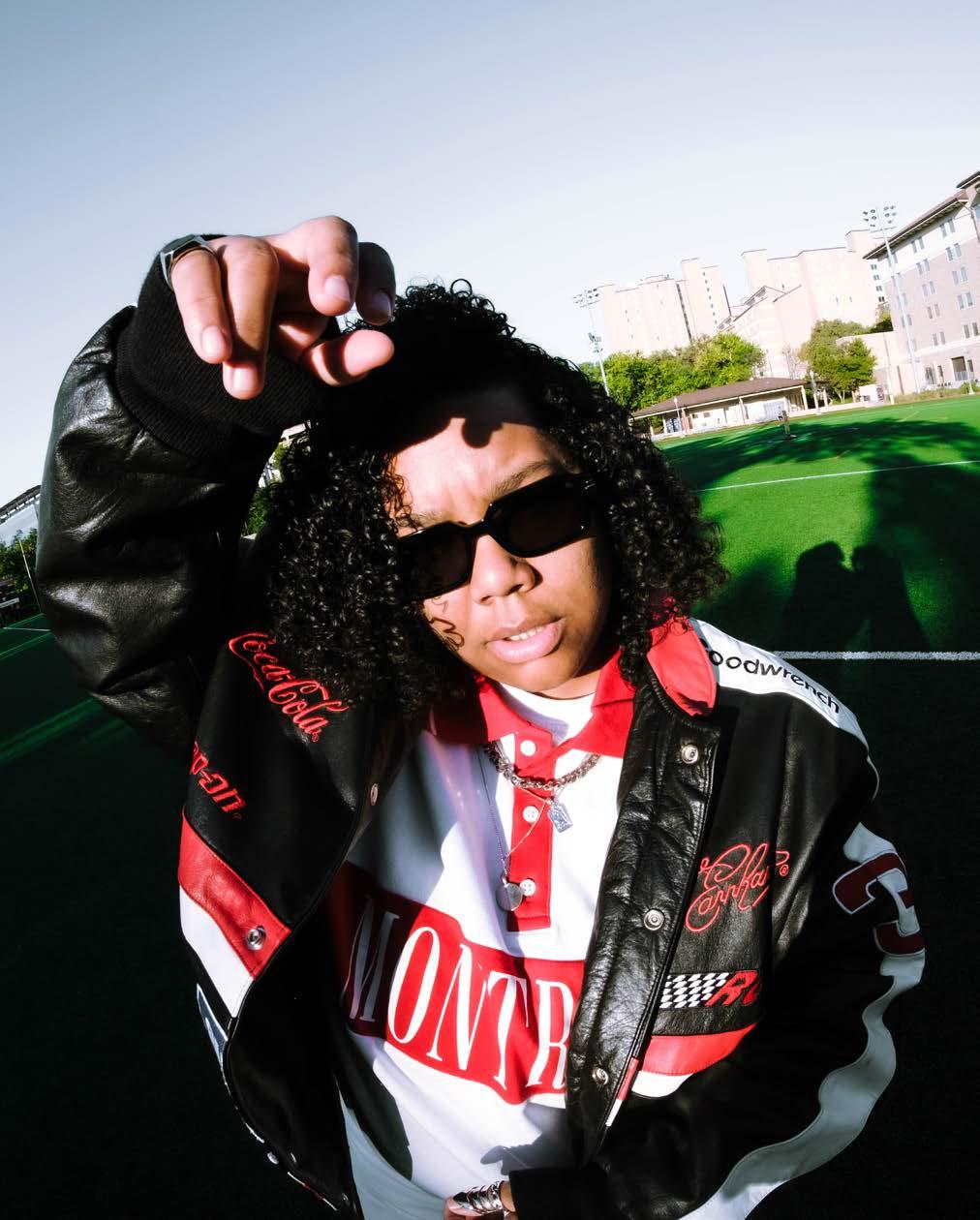
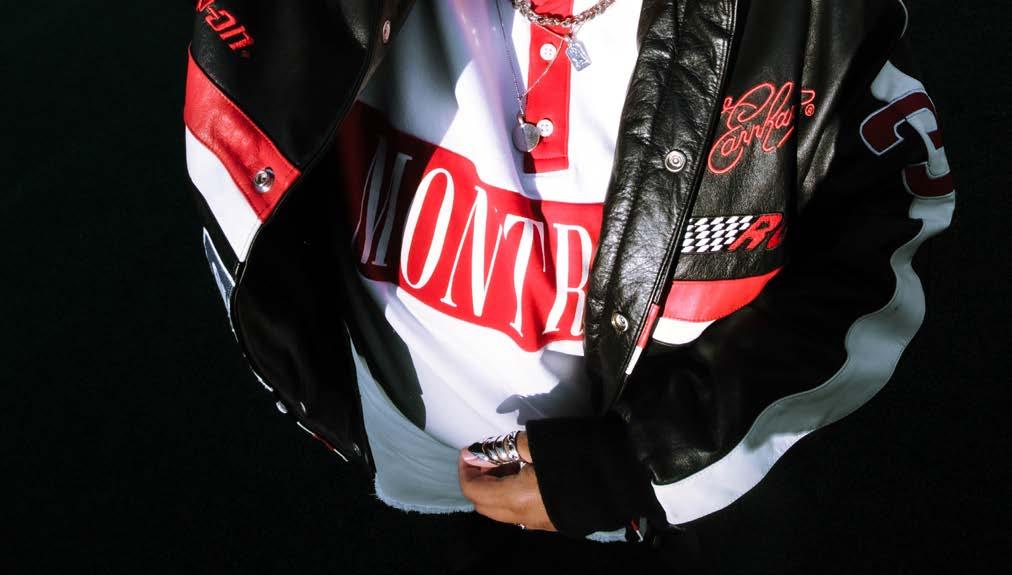




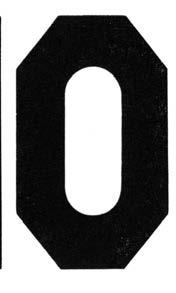
 by CAROLYNN SOLORIO
by CAROLYNN SOLORIO
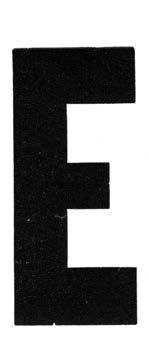

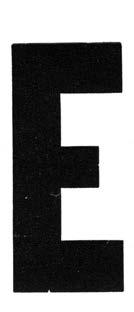

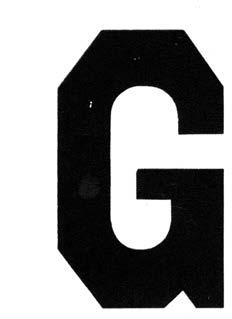
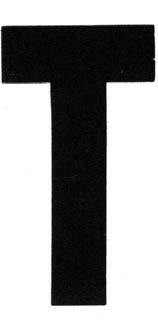
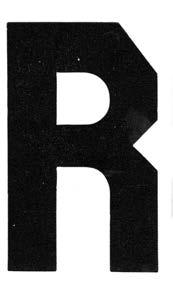

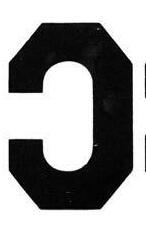
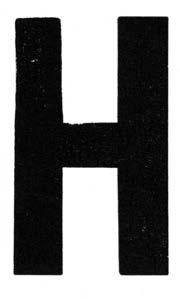

 layout JULEANNA CULILAP photographer RACHEL KARLS stylist YOUSUF KHAN hmua LILY CARTAGENA
layout JULEANNA CULILAP photographer RACHEL KARLS stylist YOUSUF KHAN hmua LILY CARTAGENA
HOT OFF A METORIC RISE , MAMA DUKE TALKS ALL THINGS MUSIC , LIFE , AND THE LIMITLESS FUTURE THAT LIES AHEAD OF HER. 141 deathless
It’s Saturday night, the second weekend of ACL. I’m nav igating the massive exodus from Zilker, pinned shoul der to shoulder against Austin’s finest, and see a crowd gathering around Juiceland. My feet are blistered, and my shirt is soaked with sweat, yet I can’t keep myself from moving toward this smoothie-shop huddle. Someone was bringing the crowd back to life — and I was desperate for some revival. The music was coming from the rooftop, and once my eyes found the sign in the darkness, I identified the intoxicating energy’s source: MAMA DUKE.
This woman was on the roof, performing a whole ass set for the street. She was bouncing back and forth across the stage, with a mic in hand and sunglasses on. She had people bump ing into one another, laughing, and coexisting in a way that almost brought me to tears. Despite the exhaustion, the se vere post-festival fatigue, everyone within a mile radius was on their feet dancing. This is Mama Duke’s essence; she cre ates a community wherever she goes — permitting everyone

around her to just be. It’s beautiful, and unlike any thing I’ve ever experienced with a local artist. But her atmosphere isn’t accidental; it’s by design.
Mama Duke wasn’t born; she was created. Meticu lously constructed out of the necessity for safety and recognition. She’s the product of years of rejection and impatience. As she puts it herself, “Mama Duke is the character I created to protect myself.” Before she was double-booked for ACL or winning music awards, she was fighting for the space to have her own authentic voice as a creative, always being told she was “too much” or “too severe.” She was an artis tic refugee, unwilling to accept anything short of a city that provided her a platform for the serious, au thentic creativity she knew she was capable of. Even the Houston rap scene, where her roots lie, wasn’t accommodating to her long-term vision.
“I would’ve belonged to rap if I was embraced. I’m this loud, unapologetic Black girl, and that made it hard to navigate a lot of creative scenes.”
When I asked her why she moved here from Houston, Mama Duke said that it wasn’t really a choice. Music is what she needed to do, and so Austin is where she needed to be. “If you grab onto Austin,” she told me, “it’ll grab onto you.” She’s here for the long haul, and she lit up as she confessed to me her desire to feed her roots and focus on cultivating the image she’s been able to create here. When we were talking about iconic Texas artists, Mama Duke talked about how Austin’s residency is up for grabs. “Nobody owns that skyline yet,” she told me. “Can you imagine a queer,
mixed-race, masculine presenting female getting a piece of it?” After talking to her, I absolutely could.

In fact, I wouldn’t even have to imagine — she’s al ready on her way. As a lifelong native, I feel it nec essary to express how important the artistic con tributions of Mama Duke are to our community. I grew up seeing “local artists” all across the city; it’s the Austinite’s ideal pastime. You go see a show, and you might have a great time, but you never bother to look the artist up afterward. That’s not the case with Mama Duke. You can’t help but become immediately obsessed with her. Everything she says is so sincere it feels like you’re hearing it for the first time. We need voices like hers to survive — to remain a cul tural mecca for the authentic artist. She’s a reminder of why we’re unique, and how we uplift voices that no one else cares to listen to.
And it’s in this respect that Mama Duke stands alone among other local artists. She doesn’t just invite you to listen, she demands to be heard. And from the sec ond you’re first exposed to her craft, you’re forever encapsulated by her essence, a proud, lifelong mem ber of the “Mama Duke Mafia.”
But for a long time, that was the obstacle: no one wanted to listen. For her entire life, Mama Duke has been a suit of armor — the product of a lifelong fight for the recognition of her own authentic voice. This character allowed for the creation of an Austin sound that didn’t exist before. But now, she tells me that the armor’s coming off. She’s entering a new era, one that’s centered around the growth and love she’s

“ NOBODY OWNS THAT SKYLINE YET ,” SHE TOLD ME. “ CAN YOU IMAGINE A QUEER, MIXED – RACE, PRESENTINGMASCULINE FEMALE GETTING A PIECE OF IT? ” 143 deathless


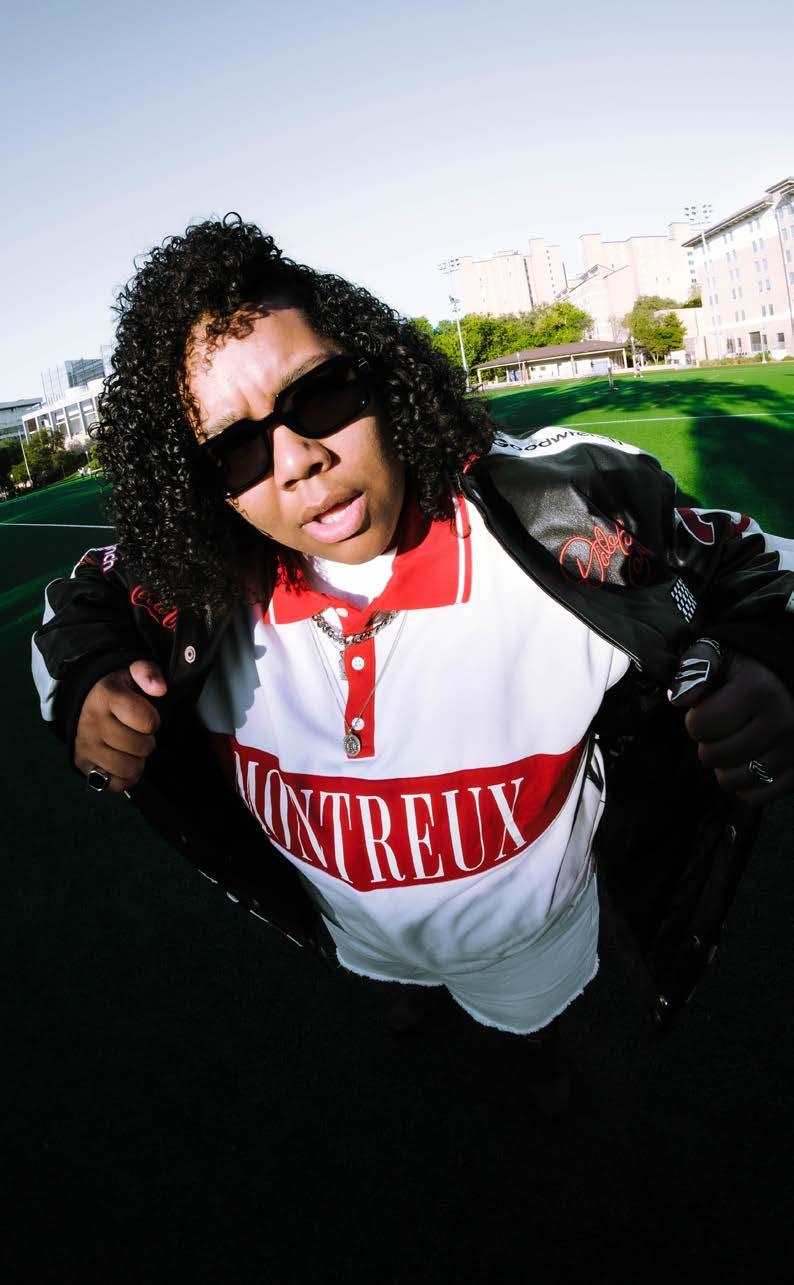
144 spark
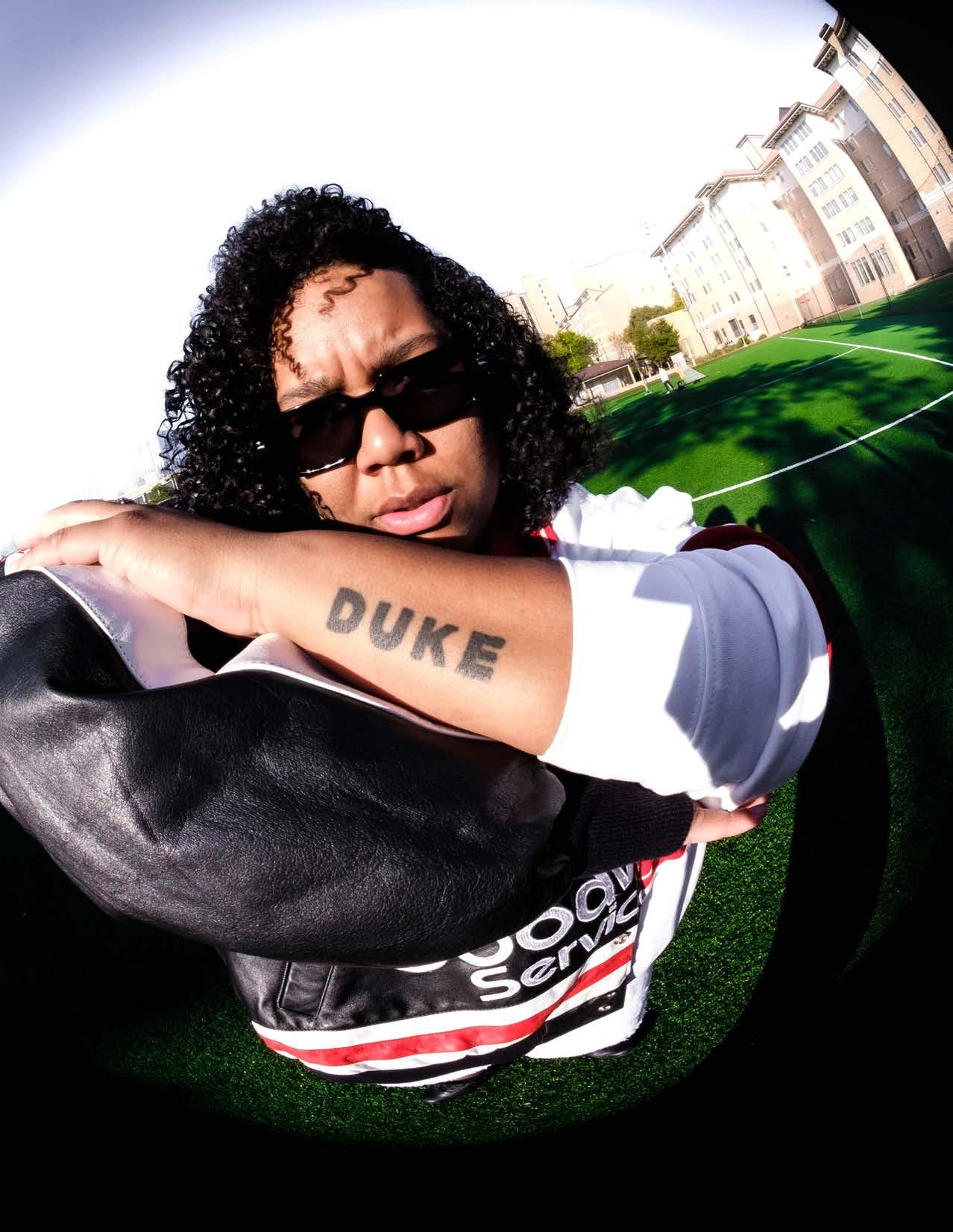
145 deathless
found since the release of her first album, Ballsy. When asked about Ballsy, Mama Duke fondly recalls the authenticity and truth that it was born from, but cringes at the pain that was necessary for its production.
“Ballsy is my first piece of art, and it’s hard to go back and listen because I feel like that person is who I had to be to survive. I had to be her, and I’m so excited to make this new shit. I have so much more to offer.”
So, what’s next for Mama Duke? Anything and everything. As we talked about breakups and self-discovery, she confessed that she was in the midst of a personal breakthrougwh. “I love my life again for the first time,” she gushed. “I get to choose everything now, and that’s a gift.” Empowerment is the new theme for Mama Duke, the defining principle of her new outlook on life. Where she once had to scream to be heard, she now claims complete artistic autonomy. She’s everywhere, and it’s obvious that Mama Duke is deeply involved in each aspect of her artistic process. Whether it’s voice acting or posing for a cover shoot, Mama Duke is fully committed to understanding the why and how of each new chapter in her ca reer. After each opportunity, she stops and asks herself, How did we get here? It’s refreshing to see artists like her representing the city, who are as invested in the journey as they are the destination. She takes ownership and intense involvement in all that she does. With her new ability to choose what’s for her and what isn’t, she’s inviting us to ex perience an entirely new side of Mama Duke. And this is only the beginning. Though music will always be her lifelong passion, she’s not tied to it for the rest of her ca reer. “I don’t feel comfortable just being in the rap scene — I’m not just that.” Mama Duke isn’t “just” anything, really. She’s an icon, and she’s limitless. Just last week she announced that she will finish the year with a month-long residency in London (details to be released on her socials). Her impact and artistry are necessary for our genera tion. She is completely authentic, the perfect marriage of confidence and humility. One of a kind.
Who else is doing it like her?
“You don’t have to prove if you know. And, at the end of the day, I know me.”

Nobody. Ever. ■

I
spark 146
“
GET TO CHOOSE EVERYTHING NOW
,
AND THAT'S A GIFT.
”

147

The Heart of the Poet
by ELLA ROUS
The sonnet has long been the brooding man’s favored machine for processing obsession. For the object of that obsession, the immortality offered by the written word comes at a terrible price.
 layout ELENA AHSAN & KAI-LIN WEI
layout ELENA AHSAN & KAI-LIN WEI
149 deathless
“At lat,Beatric e eats."

spark 150
Myladywon’topenhermouth.
Mylady,washedinscarletasthough swallowedbyflame,herlipspainted shut like cruel window frames. My lady, draped over her chaise, folded outwards like a gesture towards heaven.
The soft red contours of this dream spillandpulseeverywhere.Everymovementseemstobe amotionunderwater,thematteroftheuniversepulled intoaslow,inexorableorbitaroundasinglelocus.

All night, the stars rotate overhead as the god of love coaxesherteethforward.Allnight,histwinshadowspour over our unmoored figures, marrying our bodies in the boundlesscrushofspace.
Asthesunkissesthehorizon,hetouchesmychestand withdrawsmyheart,alive,aflame,andpulsingwiththe headyrushoflust.
Mylady,white,bloodless,andunwilling,takesmyburn ingheartintoherhands. Atlast,Beatriceeats.
When Dante Alighieri awakes, the world is different: He is almost 10 years old, and he is in love. He first glimpsed her, the nine-year-old lady Beatrice, from across a crowded plaza; now, her image follows him into sleep and through visions of hellfire and brimstone.
From this moment onward, Dante’s soul is
ruled and possessed by the god of love. This dream com poses the heart of Dante’s Vita Nuova, a story in prose, studded with sonnets, and he himself is a creature im bued with the feverish energy and processing power of the sonnet machine.
Like an ouroboros, Beatrice eats the poet’s burning heart, and for the rest of his life, Dante will eat Beatrice. It is strangely intimate, this consumption. Like the bread and blood of Jesus Christ, the essence resides in the body in ways that can be internalized by its devotee. Religion and physics, music and poetry: The human mind is driven and drawn to representational acts, to methods of achieving closeness to the world and to the lover.
These are the timeless processes that have eluded and en chanted humanity from its shivering beginnings among the first syllables of language and the origin of thought. Among them, poetry particularly gives rise to passion and purpose, to fits of madness and depressive mania and spiritual epiphany. It marvels at the grand arc of the uni verse, the throughlines that span human history, the per sonal, the gorgeous, the mundane, the stamen on a flower, the curve of the lover’s neck, the mystery of the cosmos.
Fifty years prior to Dante’s obsession, Giacomo da Len tini bends over his papers, the flickering crags of his face in the lamp light. The whale fat sputters and drips;
151 deathless
thehuman aferh umanity
“Icarryinmyheart aneffigyofyou.
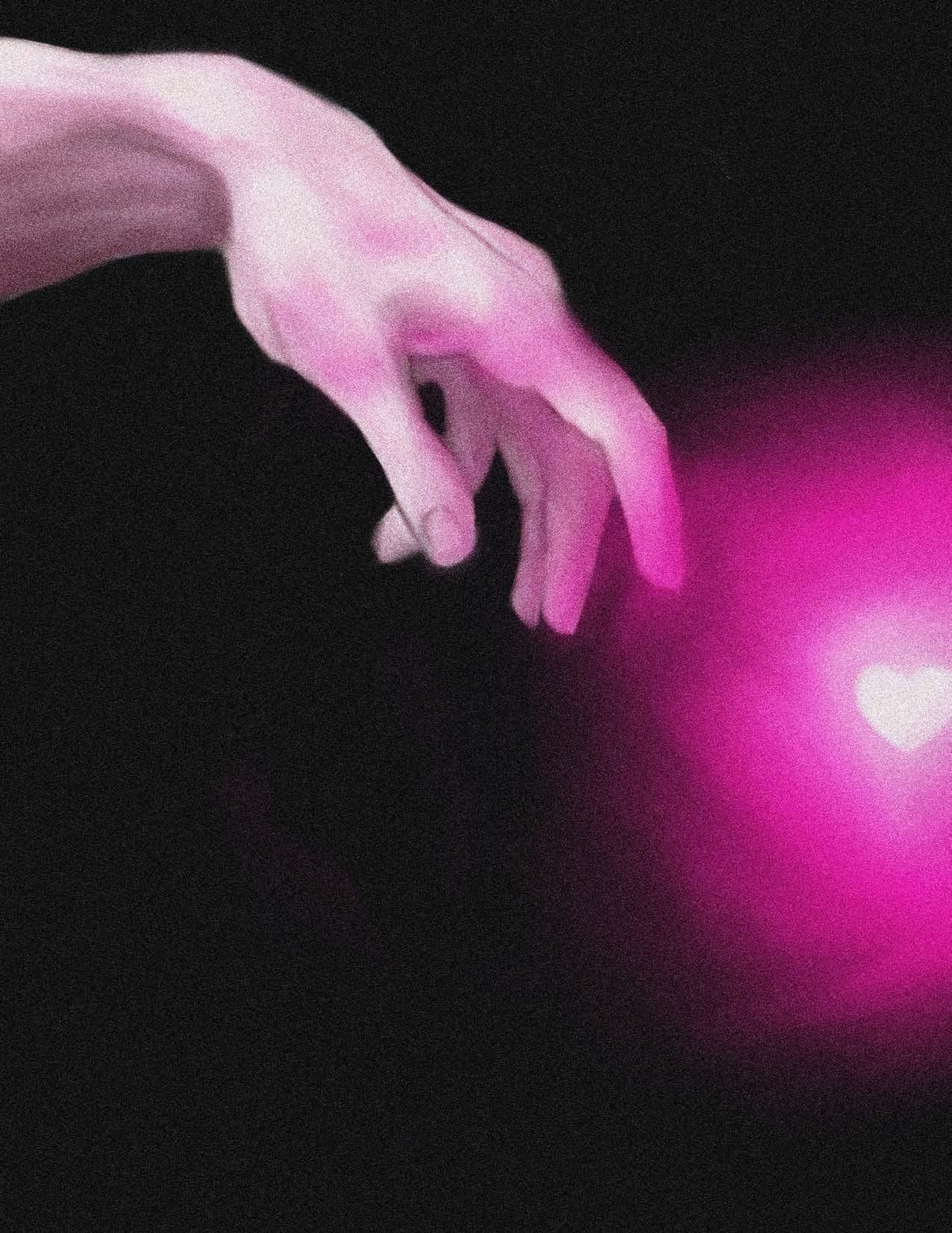
Ibearyouinmyheart…”
the pen scrawls out of ink before return ing to inkpot.
Unknown to him, a primitive thing is emerging, not from his chest but between his hands, not silver or wooden but ma chine nonetheless: the sonnet, the fa vored machine of processing obsession for the discerning poet of the ages, which has been so since since Giacomo caged a woman in his heart —
From his lips to God’s ears: Giacomo’s new machine eats the woman and spits her out, edited, shivering, clean. An effigy caged in his darkening heart.
A century later, Francisco Petrarca tastes blood as he receives the sacrament upon his living tongue. His vision tunnels; his palms supplicate the front of his robes. As a beautiful woman in the third pew bows her head, haloed in godly light (a sunbeam piercing the Avignon church roof, per haps?), he is struck with a vision of ebony antlers sprouting from within those tum bling strands of dark hair. He calls her Laura.
Laura flits through his work, ethereal and haunting, a memory or a fever dream. She steps into his most famous sonnet as a holy deer, the words “touch me not” etched in diamond and topaz lettering
around her neck.
And touch her he never will: his obses sion kindled and nurtured by distance, his writing hazy and speculative, his lust centered on her image. As Francisco will never know her real name, so, too, will history never know for certain that she existed. Such is the power of the sonnet. It is a sort of God-playing, the birth of a divine lady from the mind of the poet.
Giacomo may have created the sonnet, but Francisco, following in Dante’s inimitable wake, defined it. The first iteration of the sonnet is called the Petrarchan, enshrin ing his machinations for eternity.
The mechanics of the Petrarchan form follow: The sonnet’s rigidity and motion mimic the breath, the heartbeat, the quiv ering fingers; the internal structure and end-rhymes dictate how and where the light falls, how the object, like a statue amid its lonely gallery, is enshrined,
, th e mac i ne
“...
worshipped, coveted, martyred. Built into its very structure is a mechanizing proce dure of unnatural horsepower. It is the form in which its object’s total existence is compressed and estranged, the proce dure by which the depth of a human life is made manifest within the strangling con straints of a mere fourteen lines.
The act of putting the human being into the machine is a violent and bloody trans figuration of the body and the life within it.
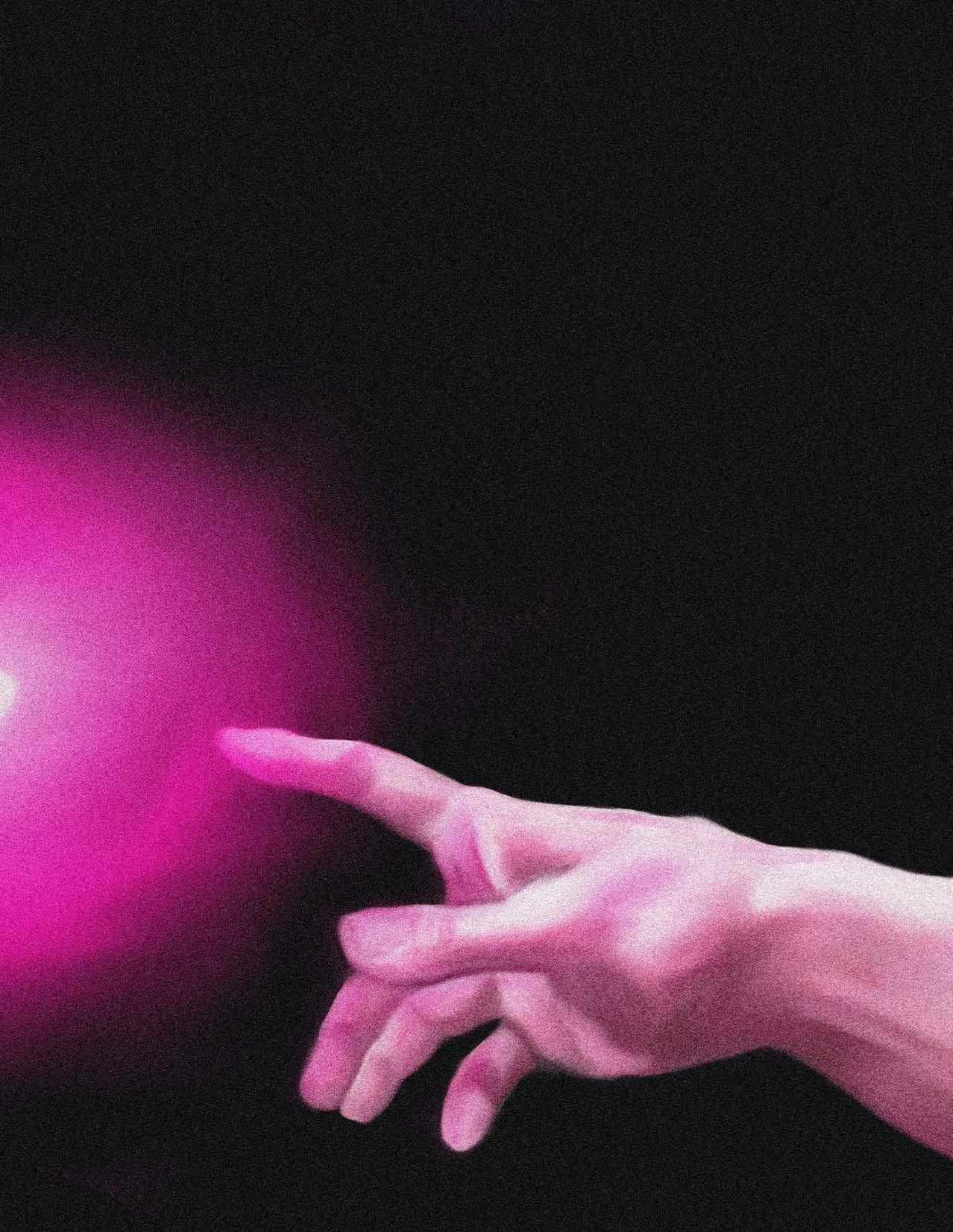
The soul, indefinite and transitory, balks at the permanence and disfiguration im plied by the written word. Something sub stantive disappears eternally in the act of translation. Something different emerges from the text: the human after humanity, the machine producing the machine, sil ver, shining, and deathless.
Perhaps the attempt to immortalize the soul in writing is so uniquely destructive because the nature of humanity is eternal disappearance: to bend the grass under foot, kiss new stars into the night, and let them fade in every last breath. To exist, from moment to moment, changeable, an unfinished collision of energies, matter, and spirit.
To attempt to outlast our bounds is di vinely human; uniquely, deeply, hideously human. Religion and physics, music andpoetry.
But in the end, the most human thing about the attempt is that it fails.
We may assume that Beatrice Portinari lives a life of blissful ignorance. She might rise in the mornings, go into town to shop for silk and jewels, and retire to her noble household to rub the knots from her pow erful husband’s shoulders. She might kiss his cheek and die quietly three years into her marriage, having never heard Dante’s name or seen his visage, not knowing her self has been gruesomely rent from her body and displayed, static, immortal, and posthuman, in lines of poetry.
But we may only assume. Because in the fusion of obsession and machine, a piece, a moment, an imagining, of her lives on, forever preserved, disfigured, and di vorced from the transient body and mind. She is unable to decompose peacefully into her final resting place: to disappear, as humans are wont to do. Because Bea trice Portinari will be known to all of his tory as Dante’s creation—
My lady Beatrice. ■
producing the macine, silver, shining, anddeathles. "
153 deathless
DEATH

154 spark
layout EMELY ROMO photographer KENNETH DELUCCA stylists JOANNE KIM & JULIA GARRETT hmua REAGAN RICHARD models ELLEN DALY & JAKE OTTO videographer RUSH MCCUTCHEN
&SLOWBURNENDINGS Doulas
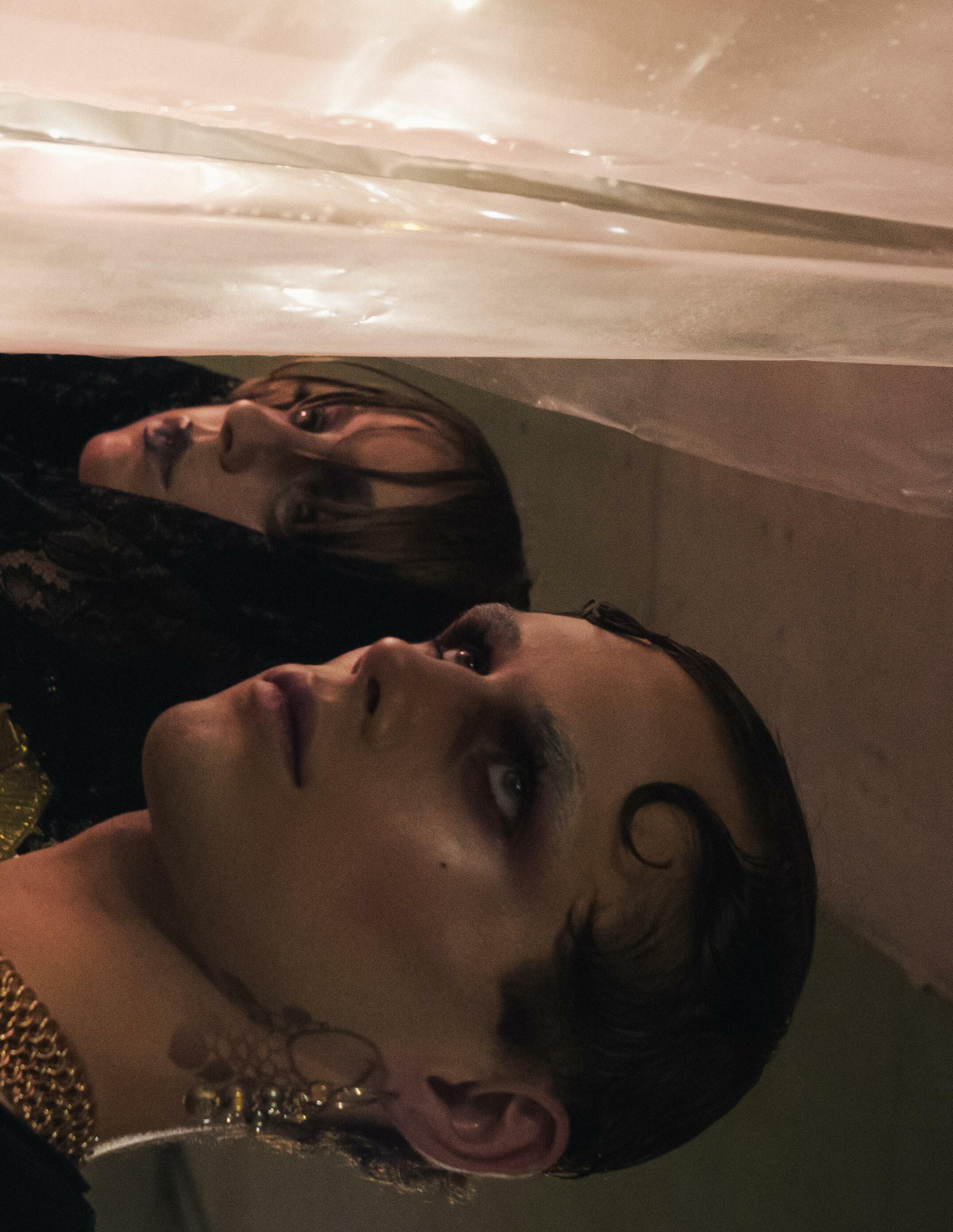
155 deathless

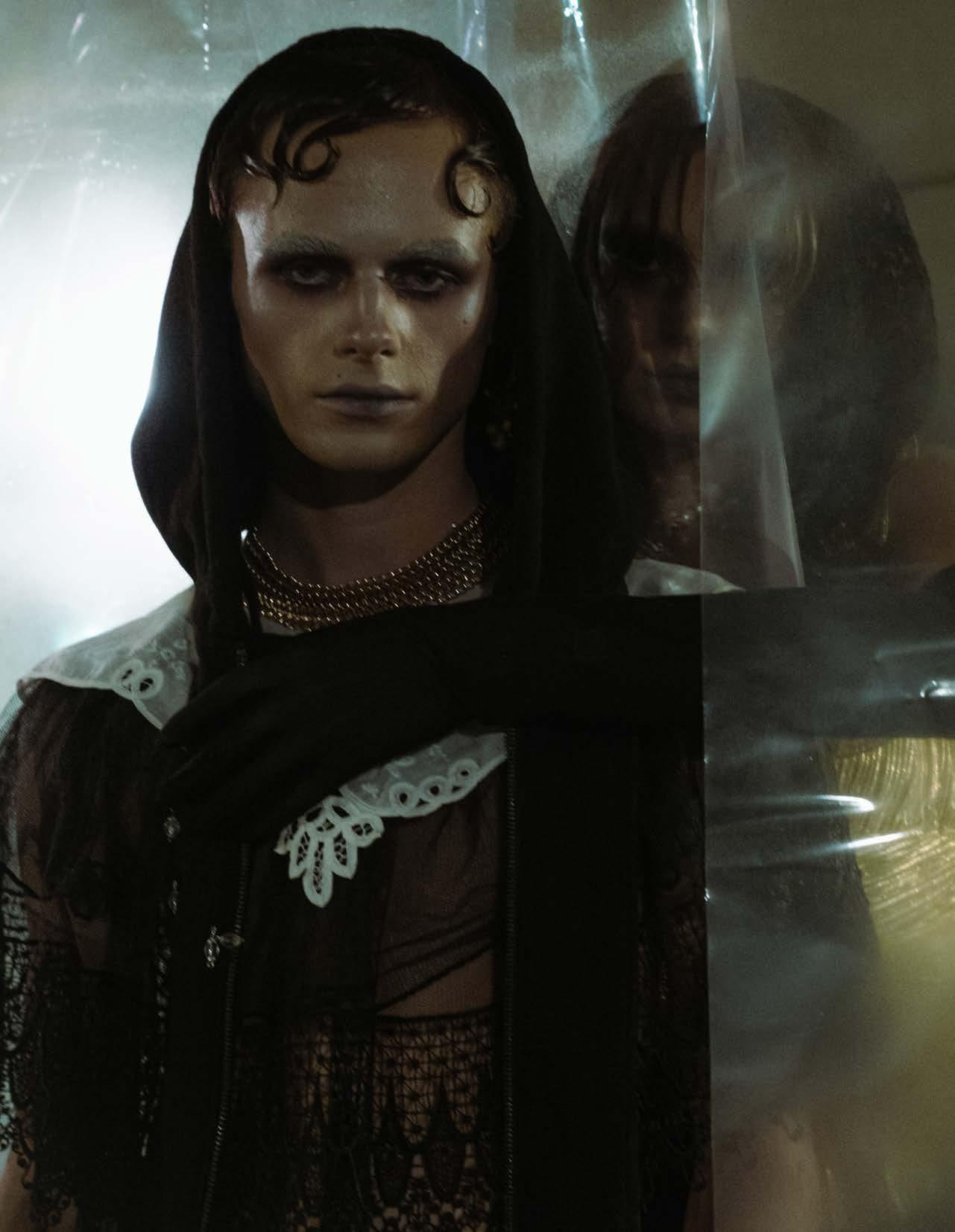
156 spark
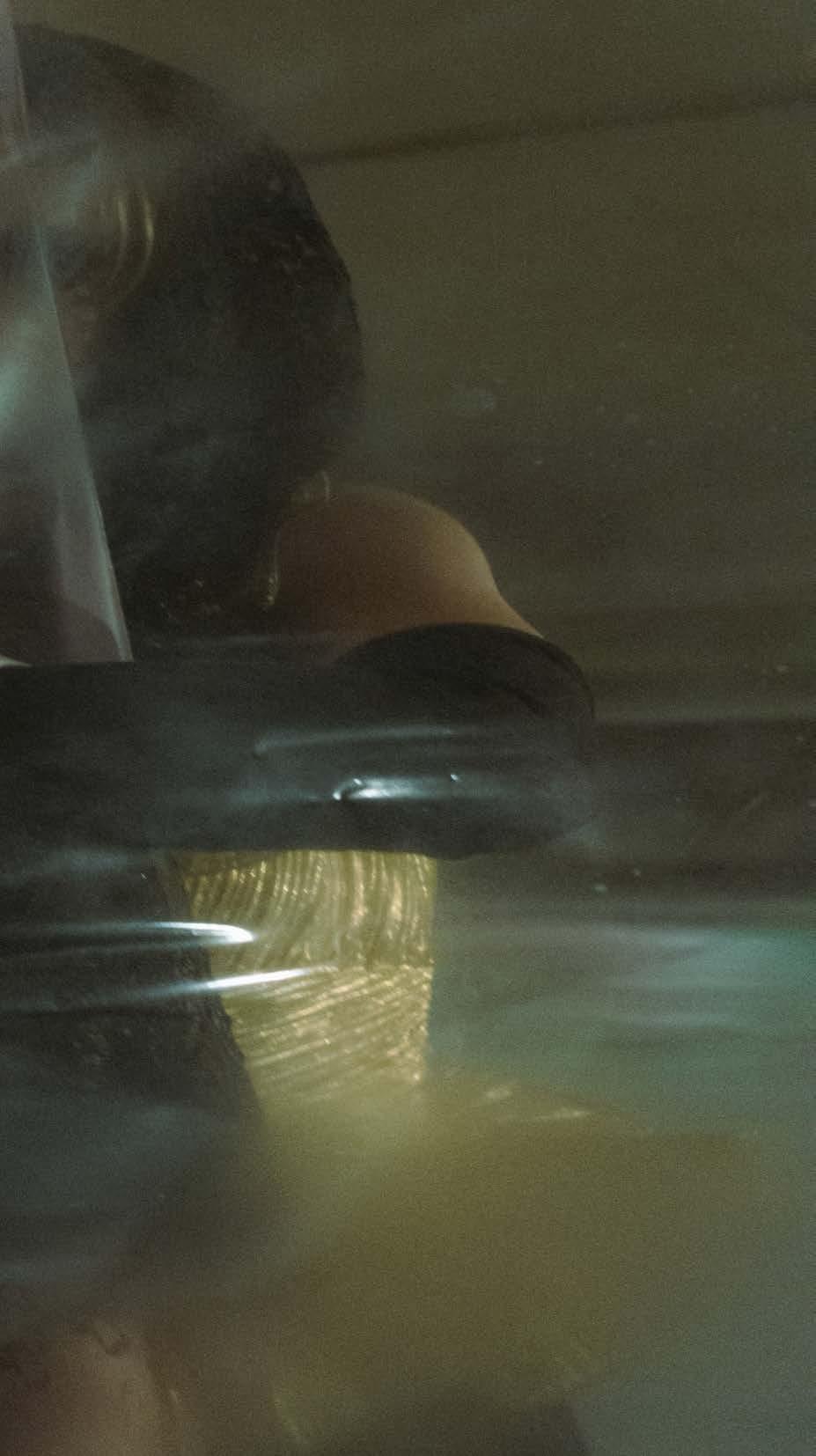
 LACE SHAWL | Flamingos GOLD NECKLACE | Flamingos
LACE SHAWL | Flamingos GOLD NECKLACE | Flamingos
157
BLACK LACE VEIL | Prototype Vintage
deathless
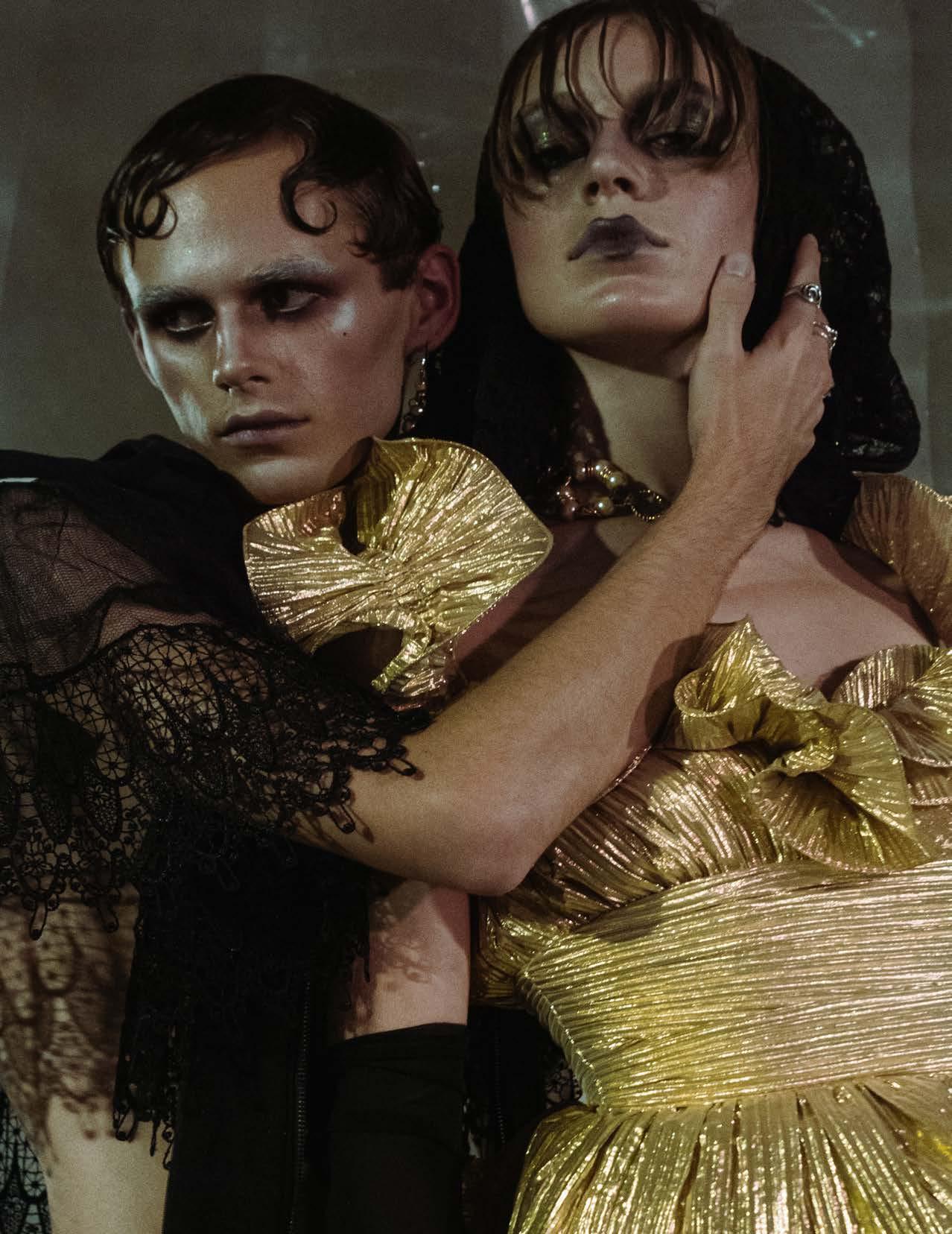
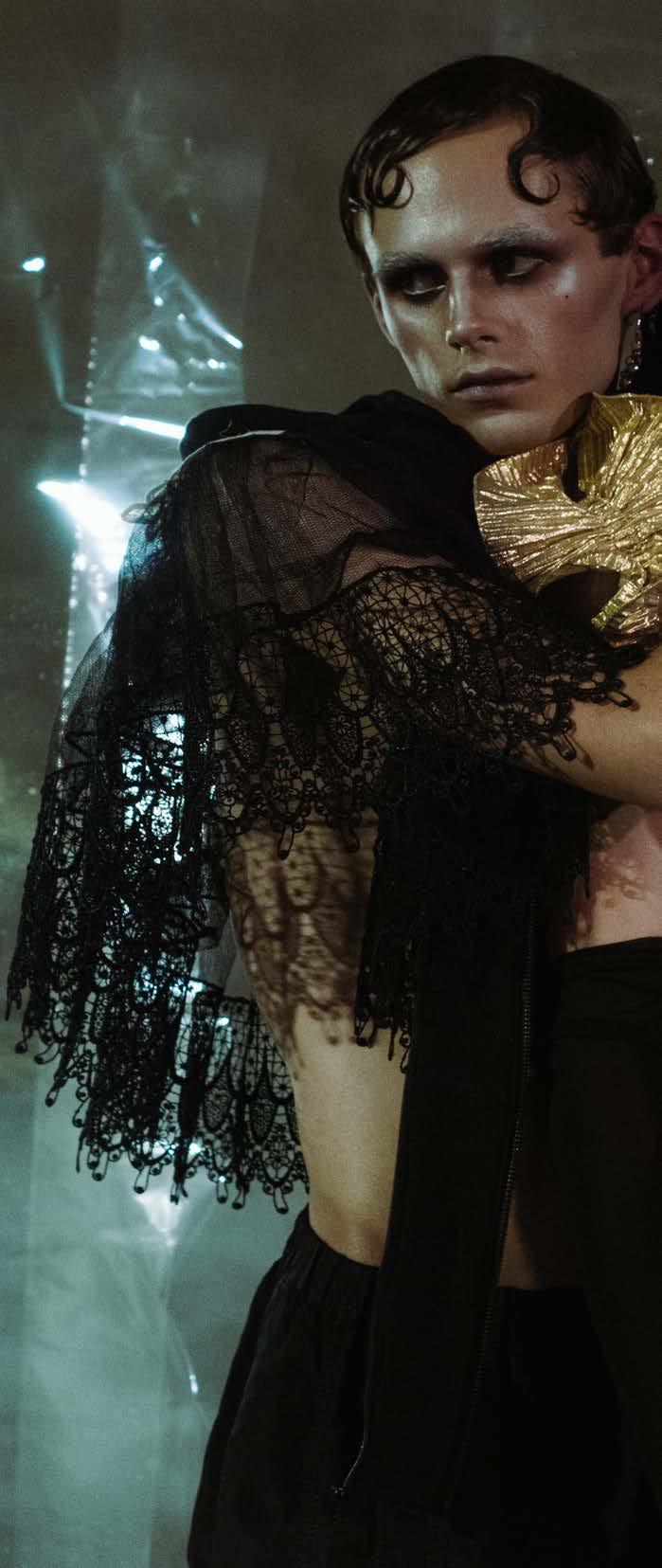
|
158 spark
LACE COLLAR | Prototype Vintage GOLD EARRING | Flamingos GOLD DRESS
Prototype Vintage


159 deathless
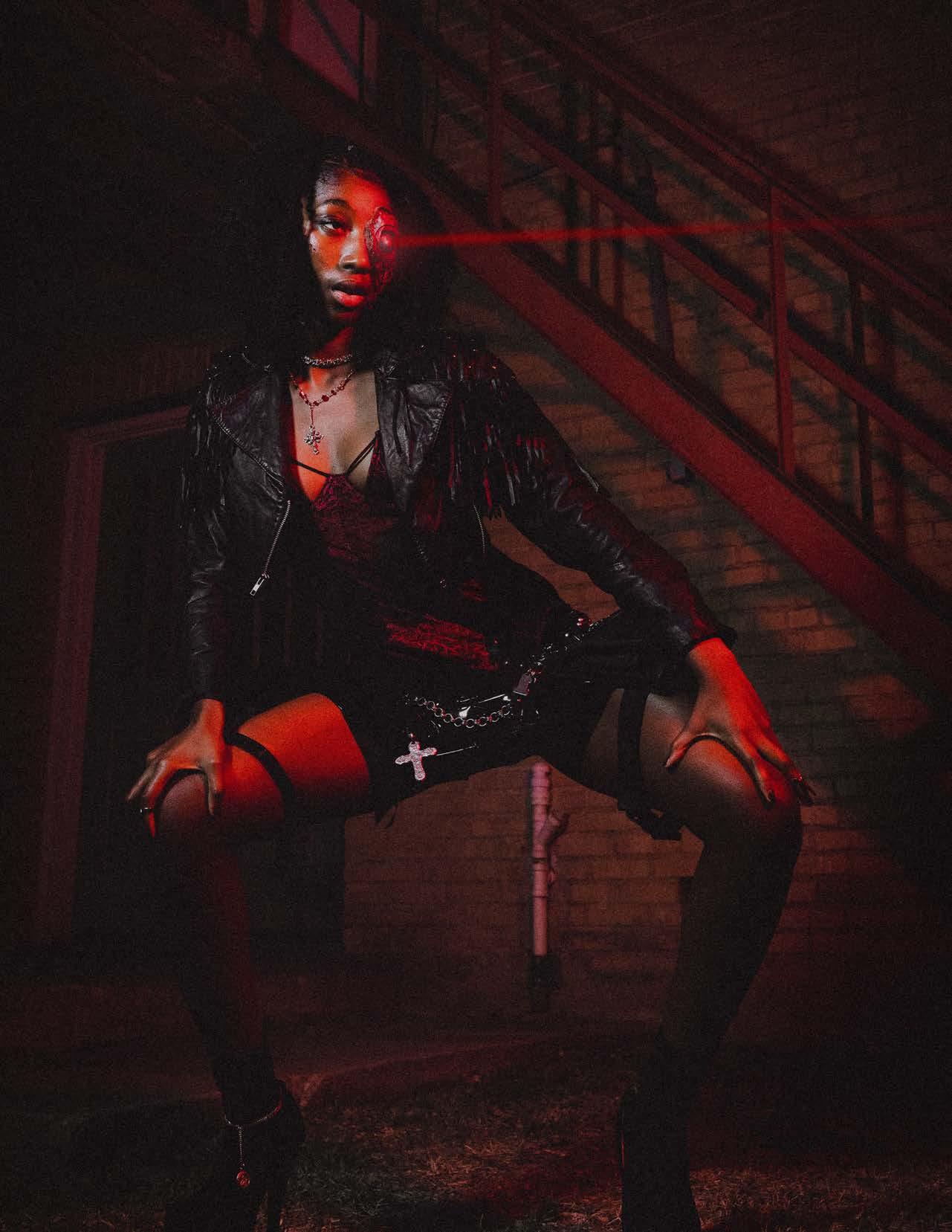 ART BY MACHINE / SUBSERVIENCE / THE DIGITAL PLAYGROUND OF A GENERATION / THROUGH THESE RED EYES / CYBER CASH / FEMME FATALITY / OPTICS / THE ANATOMY OF THE ASIAN CYBORG / HEAD IN THE CLOUD / SCREEN SHARE / TURN-OFF_THE_ENGINE_
ART BY MACHINE / SUBSERVIENCE / THE DIGITAL PLAYGROUND OF A GENERATION / THROUGH THESE RED EYES / CYBER CASH / FEMME FATALITY / OPTICS / THE ANATOMY OF THE ASIAN CYBORG / HEAD IN THE CLOUD / SCREEN SHARE / TURN-OFF_THE_ENGINE_
III.
MACHINE
It’s in our nature to want to rise above our limits. In pursuit of perfection, we reinvent ourselves and concede to the technological singularity. Art and body, self and society take new shape in a controlled evolution. Slowly, cyberspace looks more and more familiar.
161 deathless
via Ceasar
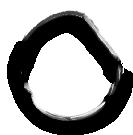

Princeton Tran
ian smith


Alex Cao
SPARK’s Multidisciplinary Experimental Division (M.E.D.) is an inaugural project centered on the exploration of narrative fashion design in the digital landscape.


Caroline ST.Clergy
GRACE KIMBALL
Leilani Cabello
copy
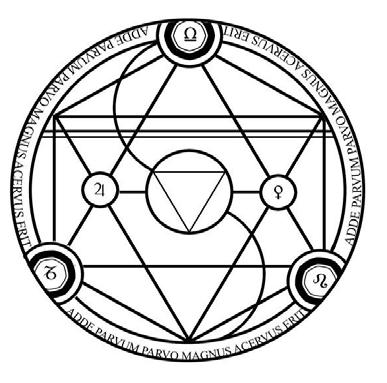



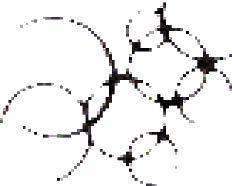

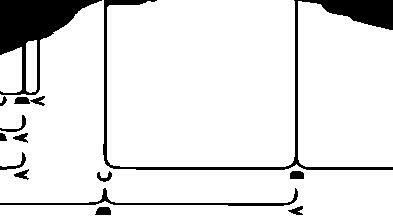


direction
by ALEX CAO
by KAI-LIN WEI creative
deathless
Now we enter Ultra-Earth.

What greets us in the after-world? That is, a world after we have gnawed it to the bone, after we have filled it with lack, after the dismantling of its history and traditions. What awaits us in this barren land of the future? Not death, but that which supersedes it. Not the apocalypse, but that which survived it. The after-world is the final world. It is a vast, young realm stretching into tomorrow like an empty sky filling with starlight.
Après nous, le déluge. Let the flood come. This too is a frontier. This too is a birth. ■
164 spark
 layout GRACE KIMBALL
garment ALEX CAO & IAN SAEJUN SMITH environment COLIN CANTWELL & PRINCETON TRAN model CAITLYN RUIZ hmua YEONSOO JUNG & MERYL JIANG
layout GRACE KIMBALL
garment ALEX CAO & IAN SAEJUN SMITH environment COLIN CANTWELL & PRINCETON TRAN model CAITLYN RUIZ hmua YEONSOO JUNG & MERYL JIANG

 layout LEILANI CABELLO photographer VIA CEASAR
stylists ALEX CAO & IAN SAEJUN SMITH model JULIA GARETT hmua YEONSOO JUNG & MERYL JIANG
layout LEILANI CABELLO photographer VIA CEASAR
stylists ALEX CAO & IAN SAEJUN SMITH model JULIA GARETT hmua YEONSOO JUNG & MERYL JIANG
guide who comes into our world to retrieve us. His is the first face of death we see.

Ultimately, it’s difficult to tell where one ends and the other begins. We are drawn like moths to the bright edges of our condition, where dwell the inflection points of permanent transformation. In death as well as birth there is equal carnage, equal terror, equal beauty; the impassive shadow of God looms long and guileless in the corner of both rooms. ■





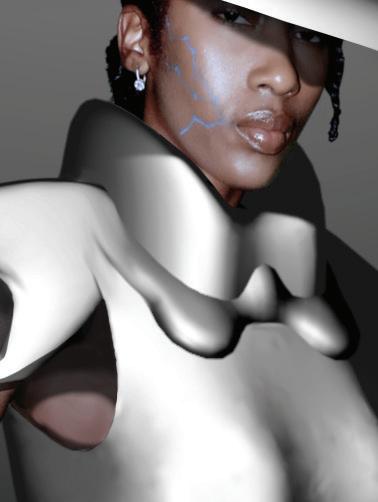






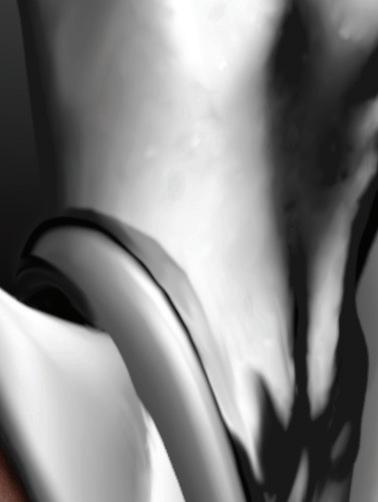
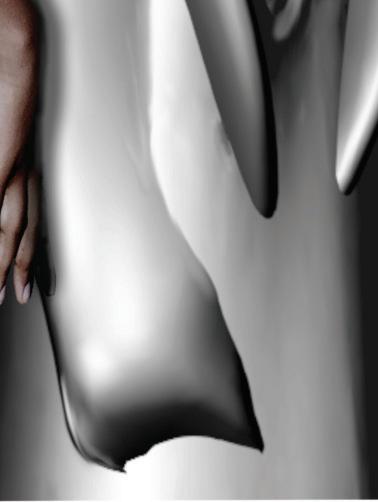

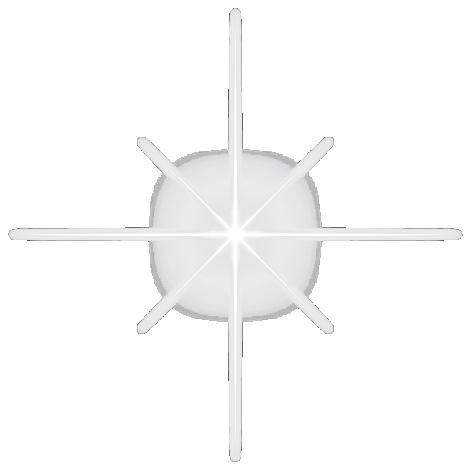


 layout COLIN CANTWELL photographer VIA CAESAR garment ALEX CAO & IAN SAEJUN SMITH hmua MERYL JIAN G & YEONSOO JUNG model MALIABO DIAMBA
layout COLIN CANTWELL photographer VIA CAESAR garment ALEX CAO & IAN SAEJUN SMITH hmua MERYL JIAN G & YEONSOO JUNG model MALIABO DIAMBA
One of the most famous monologues in science fiction is delivered by Roy Batty, an artificial “replicant” gone rogue, at the end of Ridley Scott’s Blade Runner (1982) following a rooftop chase. Recognizing that his preprogrammed lifespan is about to end, Roy confides in his shocked nemesis on the breadth of expe rience he has experienced in his short life:
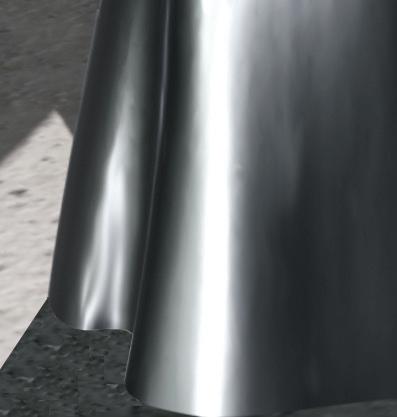
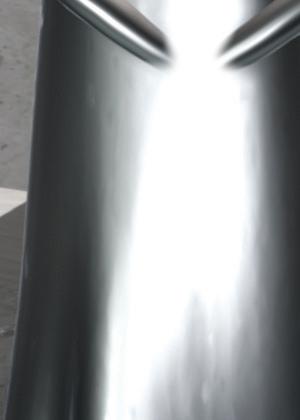

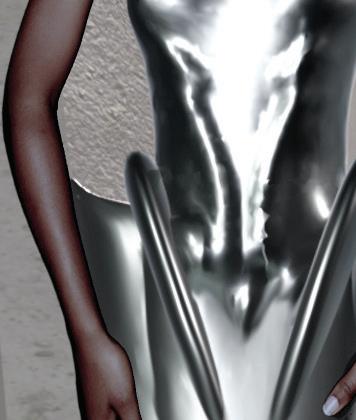
“I’ve seen things you people wouldn’t believe: attack ships on fire off the shoulder of Orion. I’ve watched Cbeams glitter in the dark near the Tannhäuser Gate. All those… mo ments… will be lost in time, like… tears… in rain.”



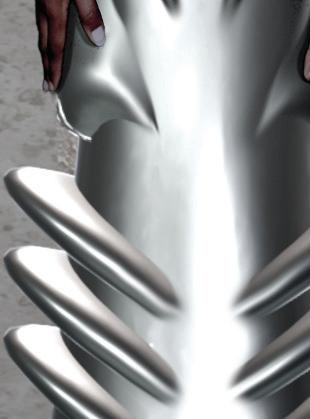

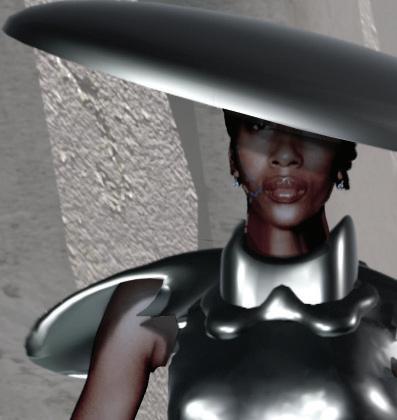



The word “Tannhäuser” likely comes from Richard Wagner’s 1845 opera of the same name, based on the German legend of Tannhäuser, a mythologized me dieval poet who travels through a gate to enter an underworld fairy-like kingdom. Wagner’s opera tells the story of a strug gle between this world and the world beyond — something Blade Runner (and tech noir in general) also thematically en gages with.
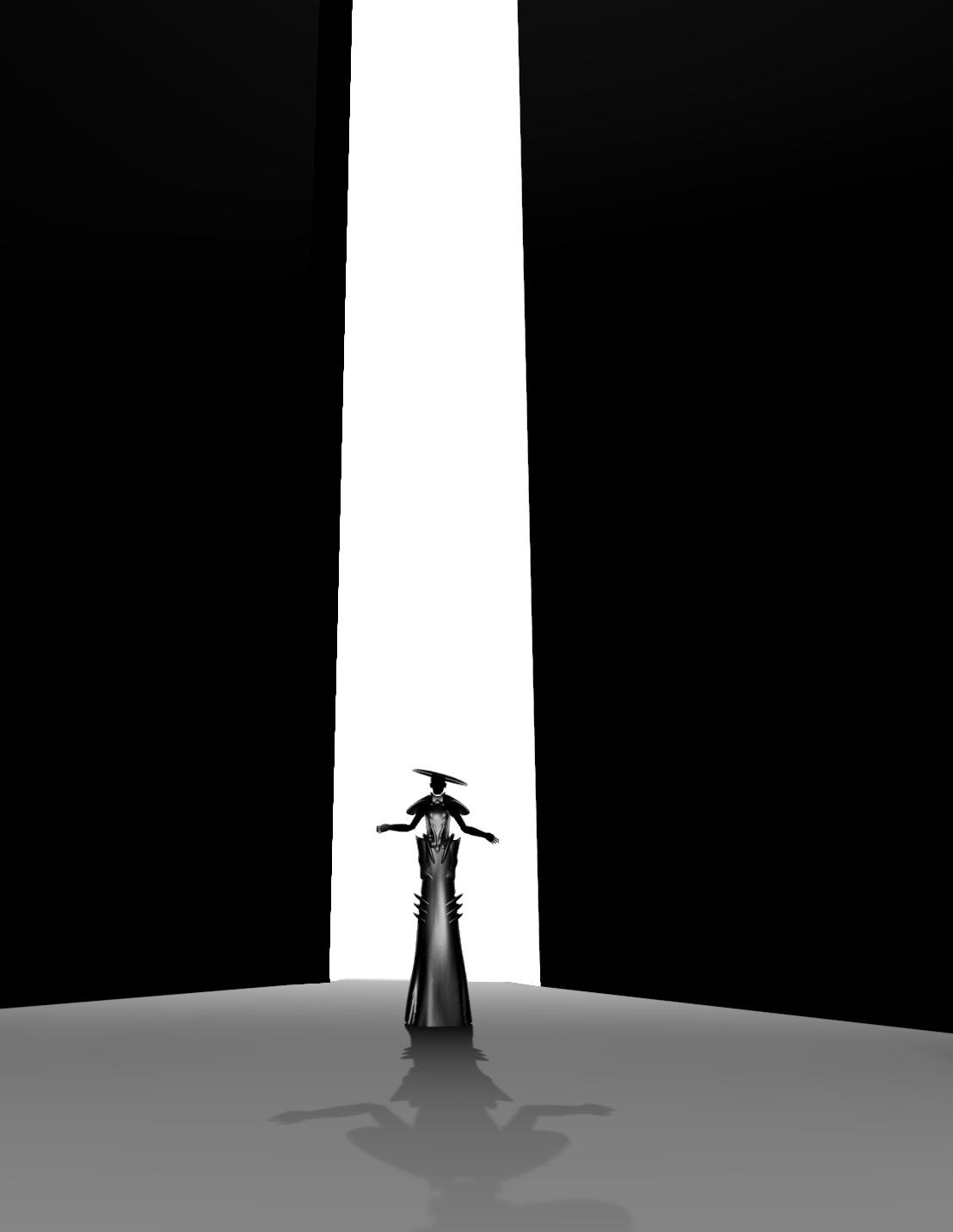
Humankind tomorrow will certainly surpass our biological capacities, seizing on the forces of biotechnology, AI, and evo lutionary cybernetics to harken a new world, one that subverts everything we know about what it means to be human. Roy com mits the ultimate act of defiance against his creator by choosing to save Deckard, a man who has taken everything from him. In doing so, he rebukes the idea that replicants lack “humanity.”
So is Roy real? Is Roy human? Does it even matter? We contend with these questions as Hauer speaks with awe struck sorrow, tender ness splintering through the stilted speech of an algorithm on the brink of breakthrough, of a man (a man!) imminently due to inherit some immense secret of the universe in that brief moment before his “expiration.” What creature comes to collect an android on the thresh old of death? The very same one, I suspect, that comes to collect us. ■
169 deathless
ART
MACHINE by
by ELLIE STEPHAN
Artists are breathing life into code. And philosophy has a lot to say.
layout CHARLOTTE ROVELLI photographer LEAH BLOM stylists SATURN ECLAIR & FERNANDA LOPEZ hmua CLAIRE PHILPOT & JESSI DELFINO models AARON BOEHMER, EMILY GIFT, & SHAREEFA GYAMI
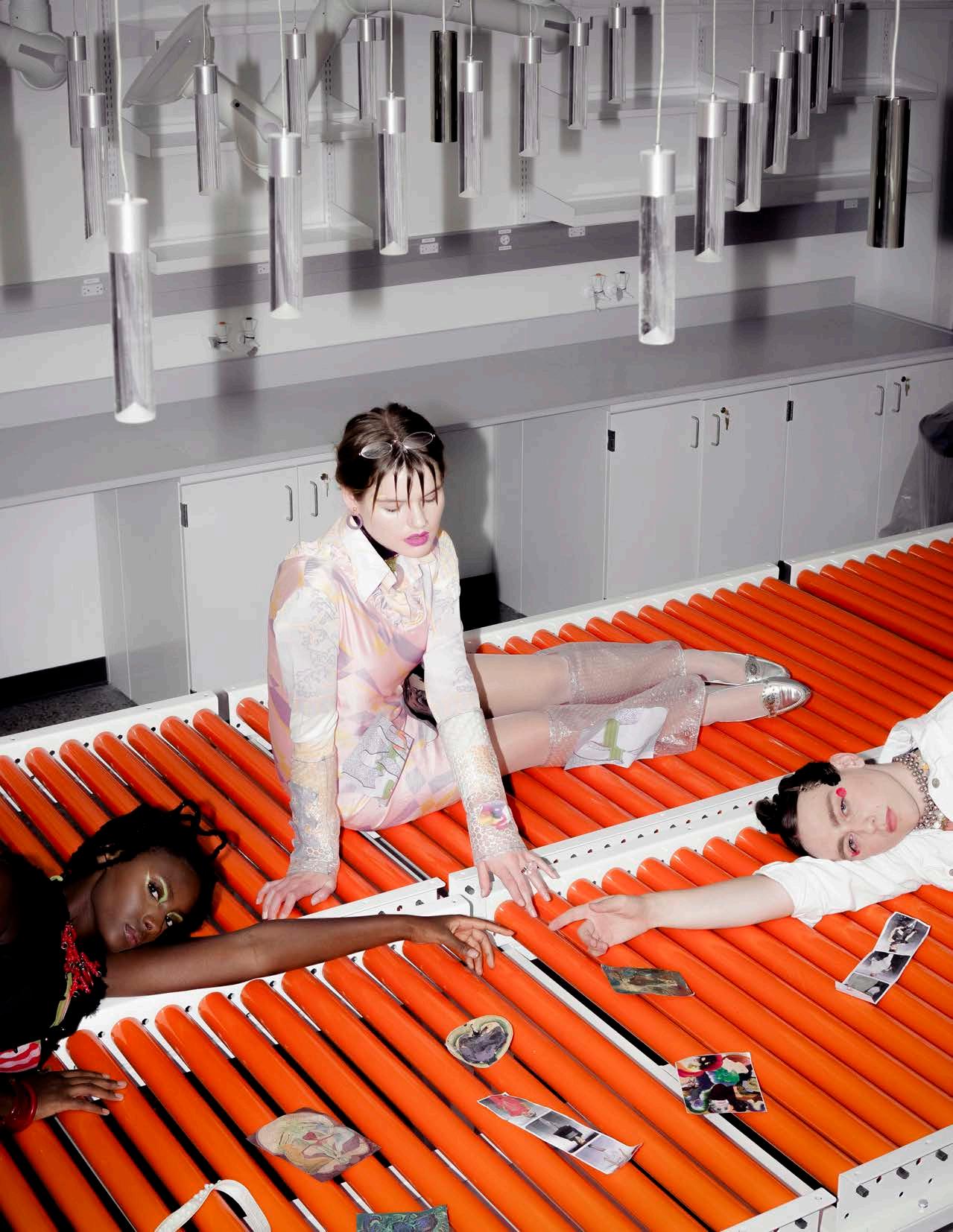
171 deathless
Inside an ornate gold frame, a painted man resides. His face is an undefined mass above his collar. The style of his portrait is classical, formal, and reminiscent of the 18th century, but the painting is fresh. Upon further ex amination, we find he isn’t painted at all — he’s composed of tricky pixels, coming together to form the out-of-focus man. The bottom right corner of the canvas explains why; there, signed with cursive Gallic script, is an algorithm.
In 2018, a painting called “Portrait of Edmond Belamy” sold for $432,000 at an auction house in New York. The work wasn’t born of brushes and paint; it was created via artificial intelligence, using a Generative Adversarial Network, or a GAN. The GAN, consisting of a generator and a discriminator, was trained on 15,000 paint ings ranging from the 14th to the 20th century. The generator produced new images, and the discriminator compared them to the dataset of given paintings. Once the discriminator couldn’t tell the difference, “Portrait of Edmond Belamy” was on the market.
As the first AI-generated piece sold at an auc tion house, it rattled the boundaries of art. Its creators, an art collective called Obvious, seek to explore the limits of AI’s creativity. When you click on their website, Picasso’s words stamp the home page: “Computers are useless. They can only give answers.” Flippantly, Obvious responds, “Well, Picasso, we disagree.” Entering a prompt into a model isn’t artistic expression as we know it, and some artists feel it should stay that way. But without the label of art, it’s difficult to define what “Portrait of Edmond Belamy” is.
The theory of significant form attempts to ex plain what differentiates art from ordinary ob jects. Philosopher Clive Bell explains that all visual works of art share one common trait — significant form, or elements like lines and colors combined in a certain way that stirs our aesthetic emotions. We feel aesthetic emotions when we react to visual elements.
When my friend toured the Opéra Garnier, for example, and saw the ceiling painted by Marc Chagall, he bawled because of its beauty. But art need not be beautiful to have significant form; it simply must provoke emotion. Viewers find “Por trait of Edmond Belamy” outrageous, humorous, and thought-provoking; the portrait brims with aesthetic emotion. Sure, it’s no Chagall, but the two works share significant form.
Plato agrees: Art encourages emotion. He speaks about this with the term mimesis, with which he claims that all art is imitation. He believes that art reflects reality, stretching and dramatizing it in a way that clouds reason and stirs emotion.
In Monet’s famous “Water Lilies” series, he imi tates his beloved pond. At Giverny, a willow tree slouches lazily in the summer heat, its branches grazing the surface of the pond. It’s quiet, but not suffocatingly so — birds chirp here and there, and insects buzz enthusiastically. Dark water gazes up at the surrounding canopy of trees, re flecting their greenery. Water lilies, dotted with cheery pink flowers, break up this mirror. It’s a lush marriage of blue, purple, and green, and it begs to be painted. Complying, Monet picks up his brush.
172 spark





PURPLE O EARRINGS | Revival Vintage YELLOW MESH BAG | Revival Vintage BUBBLE LEG & ARM WARMERS | Saturn Eclair

174 spark
RED BANGLES | Revival Vintage BROWN PLATFORM HEELS | Flamingos
Monet’s water lilies, composed of brushstrokes and paint, are mimesis of the physical water lilies at Giverny. He’s stretching reality, portraying it in a storied way that speaks from museum walls. And he’s not alone in his imitation.
Rapid-fire, keyboard keys click click click, pulling up a photograph of water lilies. Another search query, and the laptop screen floods with color. Impressionist paint ings fill Google Images, and one is saved to downloads. With bated breath, the photograph and painting marry through neural style transfer. And with the click of a button, we’re transported to Giverny.
Neural style transfer, or NST, is an AI technique of en tering one content image and one style image into a model to produce the content image in the given style. Want your thirst trap to look like something out of the Met? Done! Welcome to the 21st century.
When Monet rendered his pond in the Impressionist technique, he chose an aspect of reality and reflected it in a given style. The process of AI art is similar: Art ists choose content and reflect it via style inputs. What makes the final image art is not purely the content or the style, but their combination, guided by the creative direction of an artist. While digitized water lilies won’t grace the walls of the Musée de l'Orangerie anytime soon, Monet and artists behind NST works share a common goal: Plato’s mimesis, stretching and drama tizing reality in a way that clouds reason and stirs emo tion. AI and paint are means to an end.
Because AI is nothing without style images, some art ists claim AI-generated images aren’t art; they’re repro ductions of the style images or even plagiarism of the artists behind the style images. The core issue, critics argue, is in the origin of artistic style. While artists seem to have innately unique styles, AI does not.

stretching reality, portraying it in a storied
MULTIPRINT DRESS | Revival Vintage MULTIPRINT BUTTON-UP BLOSE | Revival Vintage SILVER FLATS | Revival Vintage
“He’s
way that speaks from museum walls.”
Diverging from Plato, Aristotle believes that art is mi metic of the character of nature, not its product. All human actions are mimetic or imitative, and imitation is how humans learn. In school, we follow along with math problems. At a Pilates class, we echo the instruc tor. And at the Louvre, Degas copies paintings.
Skirts flutter, slightly lifting the pages of the sketch book. Faint hushes of a pencil making eager lines is the only sound to be heard. The man on the stool is an island; streams of passerby part around him, sneaking glances at the charcoal figures taking their first, shaky breaths. A 20-year-old Edgar Degas is planted at the Louvre, sketching clones.
Every artist has sources of inspiration. Before Degas was famous for his ballerinas, he honed his skills by copying paintings at the Louvre and Old Masters in Italy. Like inputs in an AI model, Degas took inspira tion from Japanese prints to 16th-century Italian Man nerists, trying on styles for size. He didn’t wake up one day as an artist with an innately unique style; he copied others to learn how to create.
Similarly, AI is hollow, not capable of spontaneous cre ation. Through machine learning, it mixes up, learns from, and copies human artists, but artists using AI eventually produce original pieces. To become an artist, one must first be an imitator.
To some people, AI art conjures up soulless robots, stripping art of its humanity. Van Gogh was ahead of his time, saying, “Painted portraits have a life of their own that comes from deep in the soul of the painter and where the machine can't go.” Art by machine sounds like an oxymoron; without emotion, there is no art. The theory of Expressionism claims that art is a product of emotion and that creating art helps the artist to understand their emotions. And no one exem plifies this better than the quintessential tortured artist.
The sun has long set. Van Gogh paces around his studio at the asylum at Saint-Rémy-de-Provence, alone. His mind is an unrelenting tempest, and splatters of blue coat his arm erratically. He works on the canvas until he’s staring back at himself.
Van Gogh returned to self portraits time and time again in his artistic career. Call it soul-searching or being too cheap to hire a model, his work is an intimate look into his mental state. One of his most famous works, “Self Portrait, 1889,” captures a swirling background of blue, a pattern physicians liken to the work of mental pa tients. His paintings were a probe of his own making.
Expressionism makes sense of how his ostensibly simple arrangements of color were so deeply intimate. Art is an individual expression of emotions, and Van Gogh’s portraits come from deep within his soul. But what Van Gogh failed to consider in his condemnation of the machine is the human being behind every algo rithm. Through curating dataset images and writing prompts, human creativity is at work. When painted portraits have a life of their own, it is not the paint that makes the portrait art. The artist, their emotions, and how they express them do. Who’s to say they can’t ex press them through AI?
When photography was first created, artists viewed it as cheapening art. Because photography involves me chanical features, traditionalists didn’t view it as an art form. Two centuries later, we accept photography and painting as distinct, but equally esteemed, mediums to create art. History repeats itself. Critics of “Portrait of Edmond Belamy,” GANS, and NST fume about the mechanical nature of creating art via code, but humans have always breathed art into the developing digital landscape.
As a marketing ploy, the bottom right corner of “Por trait of Edmond Belamy” was signed with an algorithm. But it was just that — a ploy. The algorithm did not replace the artist. Behind the piece, there was a team of artists, emoting and creating and expressing.
Like paint, AI is a tool. With the creative touch of a hu man being, art is born. ■

“With the creative touch of a human being, art is born.”
177 deathless
WHITE JEANS| Flamingos WHITE TRUCKER | Flamingos
SUBSERVIeNCE
 by LUCIA LLANO
by LUCIA LLANO
178 spark
layout CHARLOTTE ROVELLI & CHLOE LOW photographer DYLAN HAEFNER stylist AUDREY DAHLKEMPER hmua REAGAN RICHARD models SETH ENDSLEY & ANGEL QUINN
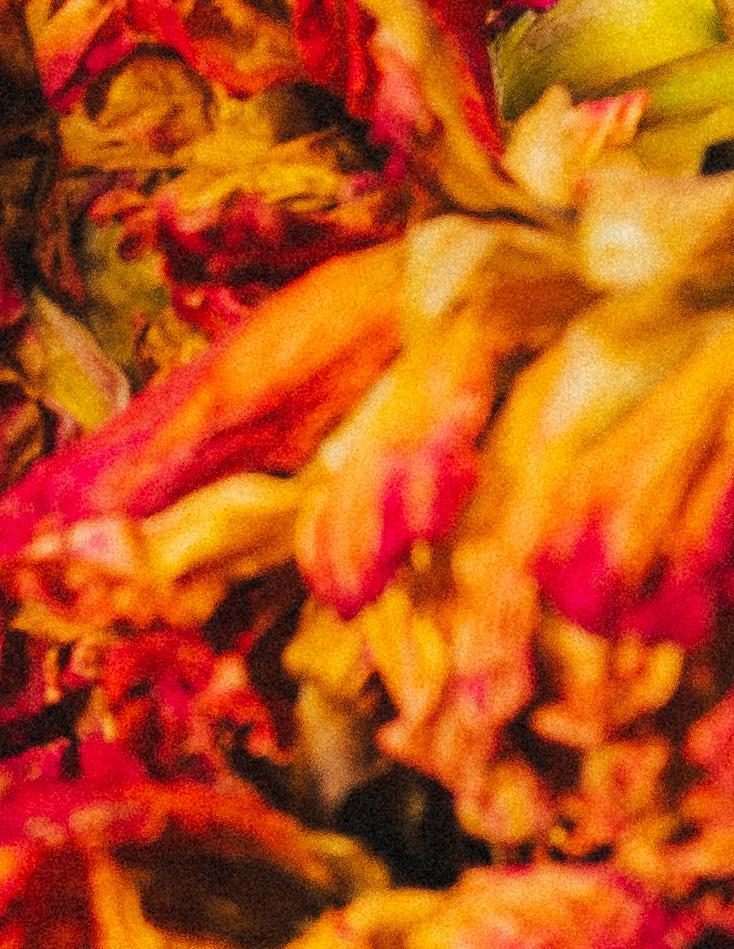
179 deathless
What do you do when the Engine gnaws through you, spits you out, and after all that, you find that somehow you still carry some love for it?
Idon’t know when it happened, when our cosmos wrinkled up and emerged twisted strangely, when life became synthetically defined in our hands, reconceptualized from an ephemeral experience of force to a formaleic machine. It was called the Engine. We were born into it blindly, as an input, and with that, society flourished. We gave it a means to an output.
When I came into this world, I was born straight into its rusted hands. My parents had seen the worst. They had fled from Cuba just some years prior and had finally moved to the United States. This place was an unin telligible god of freedom for my family and a symbol of liberation from the starving world they had left behind. The Engine was cold, hostile, different. All hard edges. It lacked the warmth of the island touch they knew so well. But here, the Engine was good. It was safety. It would take care of us. It would mass-produce opportunities for us. And we could have as many pastelitos as we wanted. And the kids could finally have some toys for Christmas. And we wouldn’t have to go to forced labor camps in the summer.
I was the first person in my family to be born here. My birth certificate had anchored my family’s roots deep into the promised land. As the only one unscathed from the corrupt heat of the island, I held the word, “Ameri can’’, like an emblem between my teeth. Ev erywhere I went, I carried with me, in my two little hands, an avalanche of opportunity. The weight of this privilege was crushing and glorious upon my shoulders. My parents had gifted me the clay of freedom. The least I could do was mold something out of it. All this and more, the Engine tenderly promised. And so, devotion to it was bred into me.
At seven, I had already stumbled upon the love of my life. I fell in love with stories. The secret gardens & monsters & saviors. All the words in the margins of my diaries. Stacks and stacks of them in my closet. I wanted to be a writer, which to me, directly trans lated to: I want to grow to be happy. The En gine and I began growing closer and closer. Placed in its loving chokehold, I would show it all my words, and it, being drawn to the taste of ambition, would listen to every one of them. I trusted it to hold my heart. So at ten, I handed over the words of enchantment and returned my palms with a swarm of nuts and bolts. I had already chosen what my ser vice to the Engine would be.
I was going to be a best-selling author. That was my new, polished plan. I could feed the Engine all the words it wanted and I might even have some left over just for me. The idea of success hung bright and heavy above my head. My words & I were going to grow big ger. We were going to grow up. And we were going to make it. We’d trade in my baby-blue walls and that writing desk my dad painted pink for me on Christmas. We’d trade it all in for panoramic glass windows of a 21st floor office through which we could watch over Manhattan, and a brand new bureau with a bronze nameplate with none other but my name on it. I blinked and my love had grown up with me. The Engine and I had grown so close that we became one. It was inside me, like a promise, like an iron wedge softly splintering my bones. I deserted my secret garden and instead sold homemade paper backs by the dime on the elementary school playground.
“As the only one unscathed from the corrupt heat of the island, I held the word, ‘American’, like a gold star on my tongue.”
spark 180
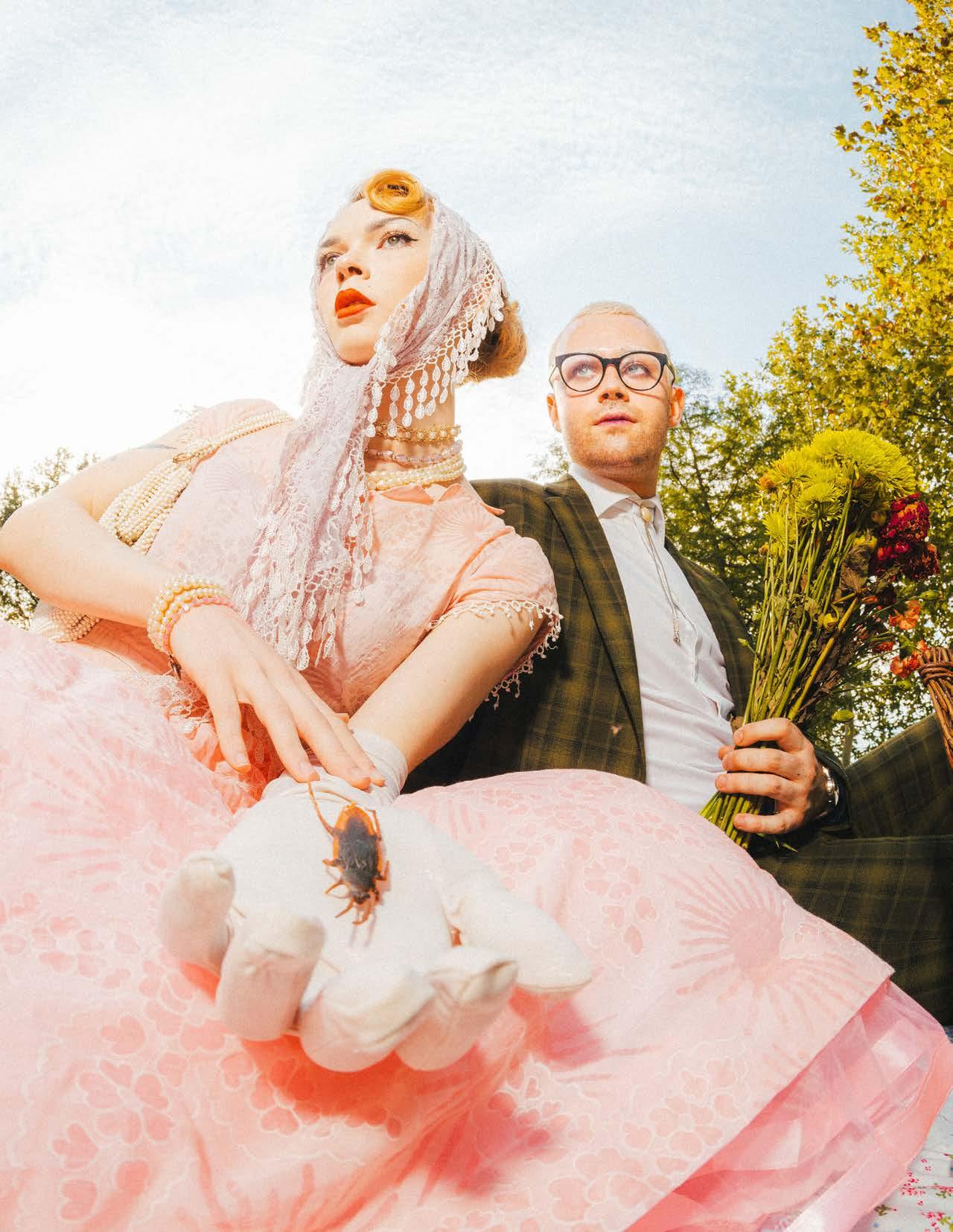
181 deathless

182 spark
Upon entering college, I had the privilege to dedicate myself to studying the words I had loved so deeply. My American dream was afoot. I savored the fortune of having come to the land of liberty where an artist could perhaps have a fight ing chance to break the starving trope. However, I quickly came to realize that the Engine was done being friendly to me. It had conducted a careful analysis, found my words a depreciating asset, and left both me and my dream behind. I found myself, then, alone for the first time, with nothing but my rusted words, an incompatible, decaying dream, and the festering pressure of American success. In the midst of this atrophy, building a life that catered to my happiness seemed to be a naive instinct. The Engine had flipped the switch and now I needed to adapt. I wasn’t going to be a best-seller. Or win the Pulitzer Prize. Not anymore. Now, I had to compromise.
Regarding the Engine, I had two choices. Subservience or struggle. I could become an elementary school teacher. Though foreign from my dream, I could have my summers off. My words and I could have our occasional honeymoons. I could become a journalist too, if my words would put on a detached, succinct, political mask, if only to be able to spend a little bit of time with me.
Instead, I chose to struggle and the Engine and I came to blows. I bombarded everything I could with my byline, threw my words into the rings of cutthroat contention, and wrung my mind out like a wet rag to get every last sentence out. I blurred the lines between self and work and became addicted to the adrenaline high of limitless productivity, knowing that the second I stopped might very well be the second right before success. Despite the hardships, I loved spending this time with the words. The exhaustion and fu tility, however, only came later, when I found myself hand ing over to the Engine my entire heart and, still, returning empty-handed. When I knew I could get triple the rewards by embracing apathy in another path. I knew that you couldn’t live without making a living, but you also couldn’t truly live making a living in something you didn’t live for. Not when we live in a world where we identify ourselves with our purpose for the Engine. So, how would you live with yourself then? If the shoes you wear on your walk of life don’t even fit you right? Then, who do you become?
I didn’t understand why the Engine encouraged formulaic indifference over natural fire. Our machine was being fu eled by forced willpower and necessity, but the gears would often get burnt out from use, and in this place, bloated with opportunities, there was always more to do. The Engine was never satiated. But if everyone’s work was led first and foremost by their heart, society would flourish, perhaps not like a well-oiled machine, but the motor would always be running. Fueled by passion, the Engine would turn organi cally. Rather than grind, it would bloom.
We were so quick to accept the apathetic Engine as the universal, autocratic truth that we lost our natural human ity. Our passions morphed into careers, hobbies into sidehustles, even our kindness and empathy whittled down to enticing little soft skills on resumes. But it had become an autonomous organism in itself, so ingrained in our defini tion of life that we couldn’t even begin to consider how to alter or defy it. And after all, defying it would mean losing the game we were born to play. So we settled for trying to win, instead, swarming through the colony for a promise of honey. But the Engine gave us tangible evidence of systemic purpose in this world, even if that purpose isn’t what we wish it were to be, but rather what the Engine needs.
I was born when the suffocating warmth of the island fell in love with the cold relief of the Engine. I owe it my life. But it’s ostracized me. Pushed me in a corner. Even after, I made up my mind, after I gave it my heart and all the words I had, as a gift. Even after, I trusted it. After, I built up a dream for the future with it beside me. After all these years, it turned around and left me behind, alone in the daydream. ■
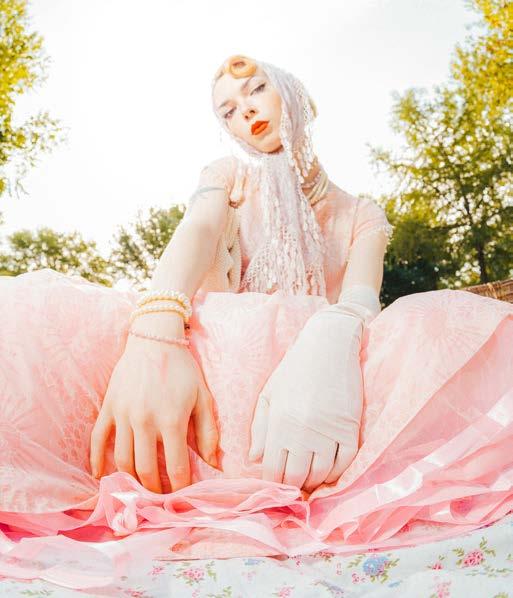
“And after all, defying it would mean losing the game we were born to play. So we settle for trying to win, instead, swarming through the colony for a promise of honey?”
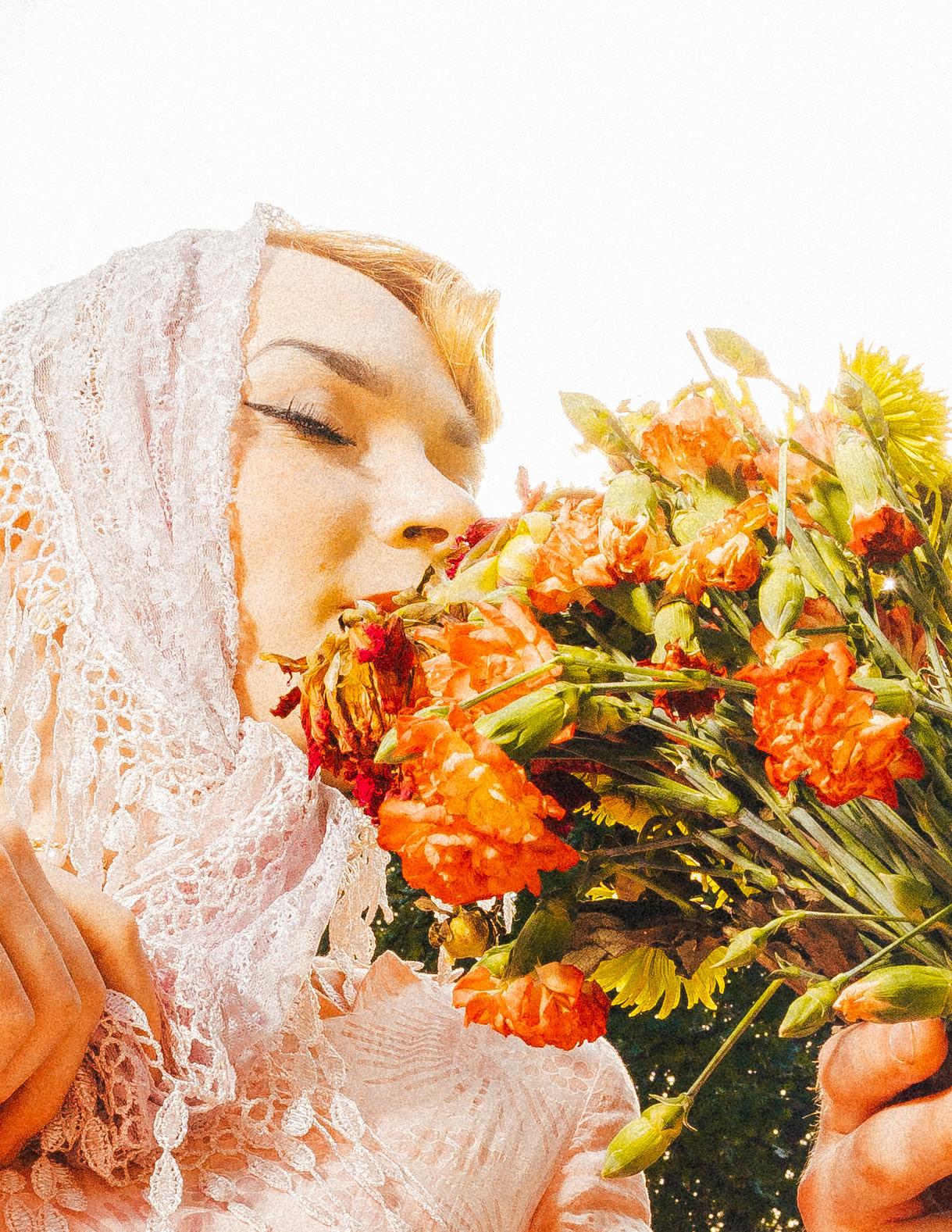
184 spark
“I could feed the Engine all the words it wanted and I might even have some left over just for me.”

185 deathless
the of


DIGITAL PLAYGROUND GENERATION
 aby BRIDGET BEECHAM
aby BRIDGET BEECHAM
For a generation raised on the Internet, the most accessible playground in the world is the MMORPG of the early 2000s. But with the digital depth of a previously unexplored landscape comes the guarantee of a childhood unlike anything we’ve seen before.
186
layout AVA JIANG photographer MATEO ONTIVEROS stylists EMILY MARTINEZ & VI CAO hmua JESSI DELFINO models GENESIS PIERI & NIKKI SHAH videographer OLIVIA MARTINEZ


PLASTIC KNICK-KNACK VEST | Emily Martinez CHARM BRACELET | Vi Cao NAILS | Vi Cao 187 deathless

188 spark
BEIGE HEADPHONES | Vi Cao & Emily Martinez
PINK
HEADPHONES | Vi Cao
ou be the mom, and I’ll be the dad.”
“No, wait, I’ll be the mom, and you be the dad.”
Words exchanged, but not by mouth. Pudgy hands fly across the keyboard.
Pause. Wait.
A text bubble appears, and you sit with bated breath as someone from across the world confirms that they would actually like to be the dog instead. It does not matter that on the screen, you are both penguins, or monsters, or whatever bizarre, colorful creature the site has chosen to populate its bounds, because this is your space, your comeuppance — your personal, virtual playground.
The basement lights are warm as you make quick work of the stairs, descending them in sets of two. From above, you can hear your mother distantly complaining about your heavy footsteps; her voice is pitched with disapproval. The television buzzes with the distant whine of the first-ever season of Rugrats, grating voices gracing the screen.
Still, you continue to pound your way down the stairs, a garish can of Surge clutched tight between your fingers, beads of condensation dripping down its thin aluminum walls. The year is 1991, and you are about to engage in some of the most exciting gameplay on the market to date: Neverwinter Nights.
The objective is fairly simple. With a design heavily reliant on the format of Dungeons & Dragons, the game before you on your brick of a Macintosh doesn’t stray far from the reality you already know.






And yet — and yet, as your avatar sways loosely, gaze unblinkingly meeting yours, it feels like more. Like an escape: a dream previously forged through spoken words and shared imagination now physically visible on your heavily pixelated screen. And you are happy to indulge, to don the armor of a paladin and ignore the jeering judgements of your mother. This is digital history, the first Massively Multiplayer Online Roleplaying Game, blinking to life on your computer.
Michael Acton-Smith says to be a child is to nurture, to care, and to cradle. In 2008, he creates Moshi Monsters. He talks about Tamagotchi. He talks about Furbys. He talks about pet rocks. They are the same, he says.
We are a desensitized generation, people say. And yet as we sit in the dark, told over and over that the only real things are those we can hold in our hands, we still want nothing more than to care. To feed and to clothe

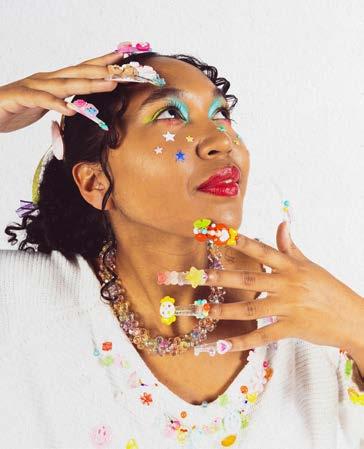
‘‘y ‘‘this is your space,your comeuppance — your personal, virtual playground.’’


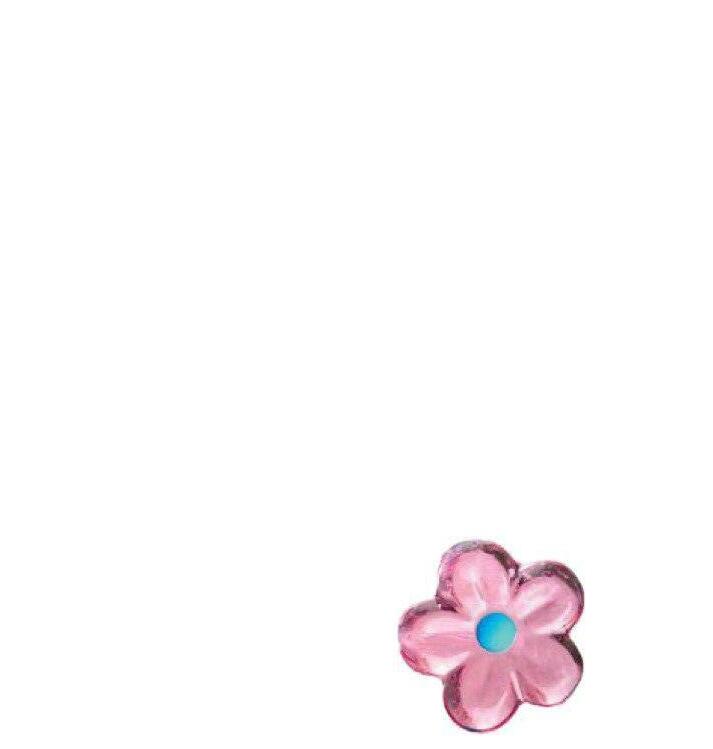
190 spark
PURPLE RAINBOOTS | Emily Martinez WHITE SWEATER | Vi Cao
and to spark joy in a creature that is nothing more than a collection of pixels.



The year is 2008, and the soda of today is your mother’s Pepsi Natural. It’s less artificial flavoring, she says. It’s disgusting, you say. You drink it anyways.
Your brother plays Halo 3, mercilessly gunning down his opponents, and your mother laments his cold, nonchalant nature. But he cries when he cannot scrounge together the rox to feed his Moshi monster. He calls her his friend and plasters his walls with hand drawn pictures of her likeness. It is your secret.
You’re edgy; you’re cool; you’re not like other girls; you drink bacon soda and Sharpie mustaches onto your pointer finger because it’s just so quirky.
In 2011, the Internet is the most accessible playground in the world. But this indiscriminate open door policy has a price: admission is free and your front row seat is right next to a man in his early 40s, hidden behind the unblinking face of one of the many Pixie Hollow fairies.

But you are 10, and his presence is unknown as he crowds binary walls of the home you have made for yourself. You are 10, and as far as you’re concerned, the only thing of any real weight is that beautiful four-letter word plastered beside the prompt to create an account. Free.
Free to join, but not to play, not really, with children
becoming fractured reflections of their parents through the lens of the screen, classist ideals passing from hand to hand with the golden badge of membership. Still, this is what’s available: what you’ve got to work with. So you play anyway.
This is what we deserve. This is what we deserve.
Stranded atop this dying planet, left to fend for ourselves. Safety is a luxury few can afford.
Time is running out. Beauty is running out.
But my mother told me we all deserve beautiful things. My mother told me to open my eyes, to find them in the world around me.
So I found them.
Here, there is color. Here, there is light. Our
deathless
‘‘we sit in the dark, told over and over that the only real things are those we can hold in our hands.’’
house is on fire, and the only exit is the digital, so I take it. I jump from the second-story window, even if it hurts, because to jump is to breathe. Deeply. Fully.
Concrete is not so common in digital landscaping, so instead, we pick our way through deserts and arctic tundras alike, navigating with arrow keys rather than our feet, the brain and the body disconnected and yet experiencing life with a vibrancy previously unknown. Color is so much sweeter from behind the screen of a computer as the fluorescent lights in the dingy school library brighten and dull, casting the walls with different shades of beige.
It is 2022, and there is something to be said for messages left on digital cork boards and moments shared on streets unknown to the physical earth beneath your feet.


The bleak monotony of my dorm could never compare to the garish interior decoration of my Club Penguin igloo. I sip Monster now. I bought it myself, and it tastes sweet. Ultra Sunrise.
It seems to me we are a generation of reflection, always looking back, always searching for something long gone. My domain continues to reside in the digital, never one for feeling the ground beneath my feet.
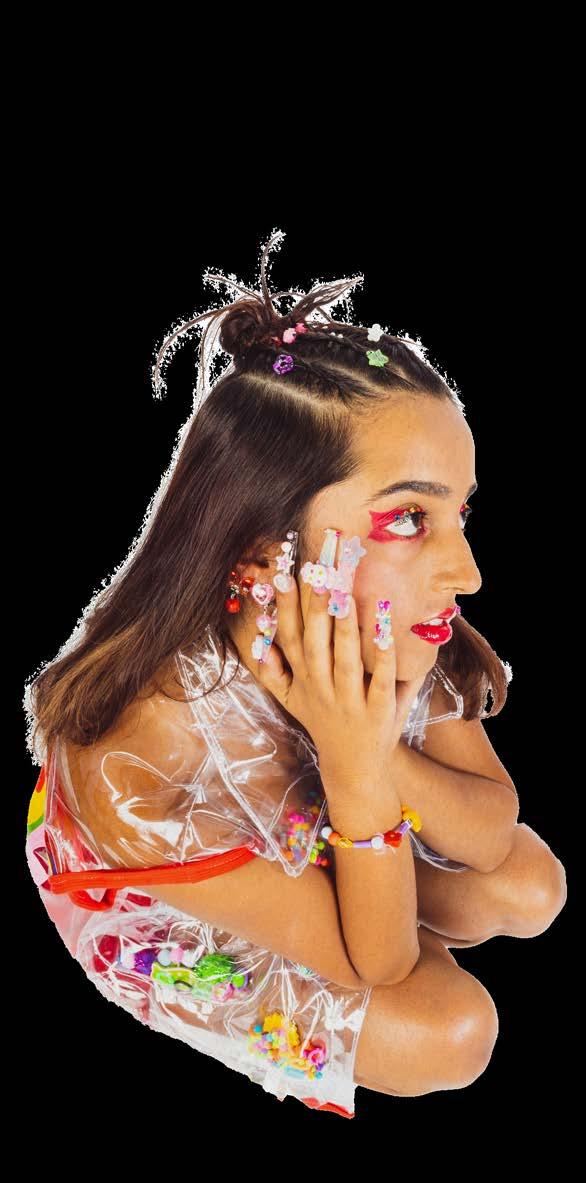
Real playgrounds are for the kids who grow up to tout their ethically superior granola childhoods to a TikTok following of thousands, kids whose bare feet were left unmarred as they glided down identical suburban streets, satisfied with their picture-perfect labyrinth of a neighborhood. All well-coiffed grass, tape-measured to perfection. Where the only concrete covers smooth asphalt roads, and the greenery is not limited to cracks in the sidewalk and the haphazard plants littering the steps of the old woman down the street (whose house stinks of butterscotch and resting home).
But for a moment I am 10, and any and all the free time I am afforded is spent using the family computer to play Moshi Monsters. I scoop ice cream; I save the day; I am unbothered and engaged in a manner of play previously thought impossible, but for me, it is second nature: second nature to log on and amuse myself with friends from halfway across the globe, second nature to do so in a sprawling world of ones and zeros with no price to act as gatekeeper.
An extension of the world I know already. I was raised for the Internet, and it was made with me in mind.
My space, my comeuppance — my personal, virtual playground. ■

‘‘ I was raised for the Internet and it was made with me
192 spark
‘‘ I was raised for the Internet, and it was made with me

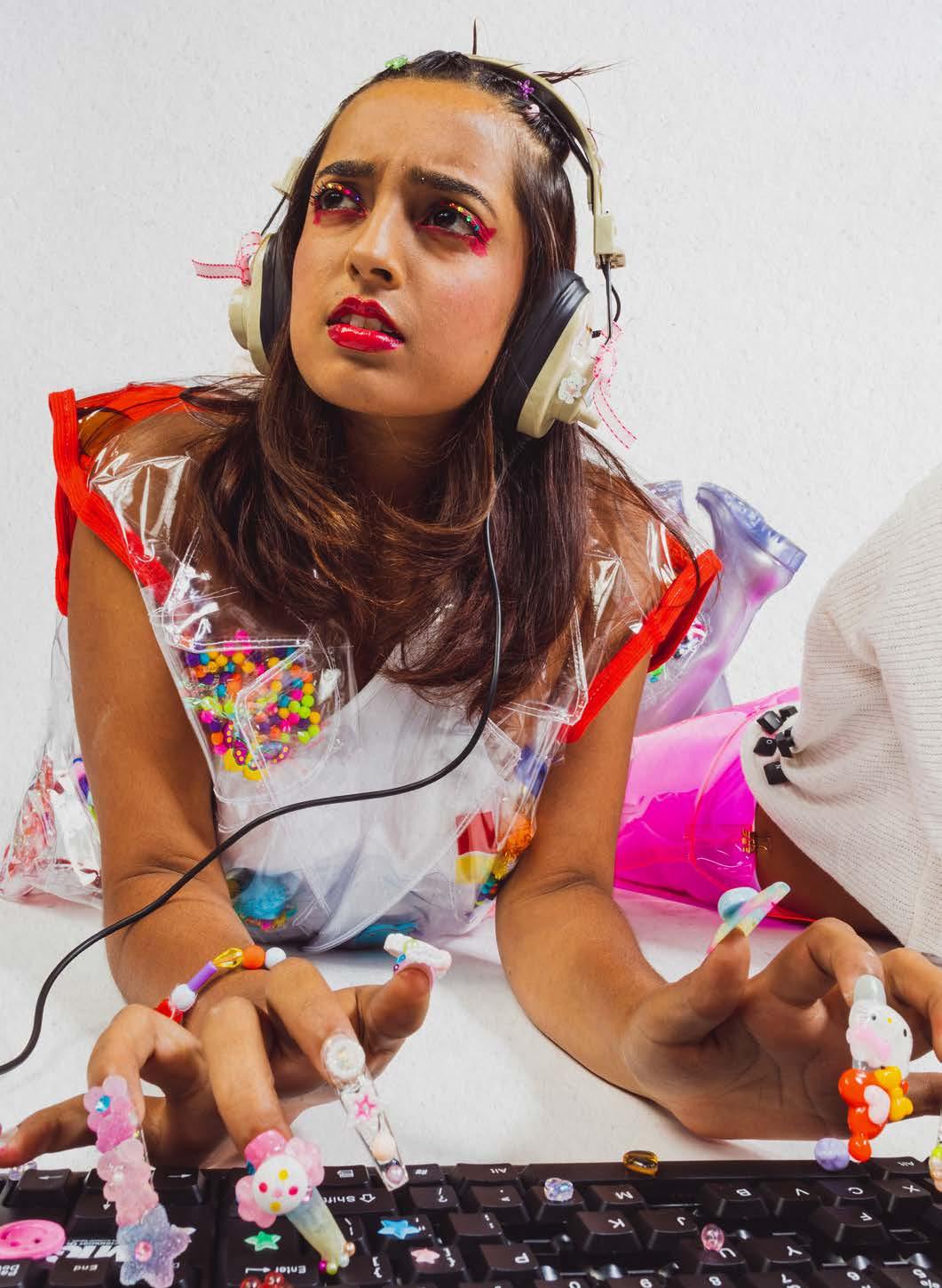

193 deathless
ajklfdas fjkldsiy
Through These Red Eyes
 by EVELYN MARTINEZ
by EVELYN MARTINEZ
Metal fingers lit the match that burned everything I ever was. This armor was made to guard me, but can I still find my flesh beneath all this wiring?
layout JULEANNA CULILAP photographer MATEO ONTIVEROS stylists DAVID GARCIA & YOUSUF KHAN hmua MIU NAKATA & MALIABO DIAMBA model MALIABO DIAMBA videographer OLIVIA MARTINEZ
194
jklfasd

195 deathless

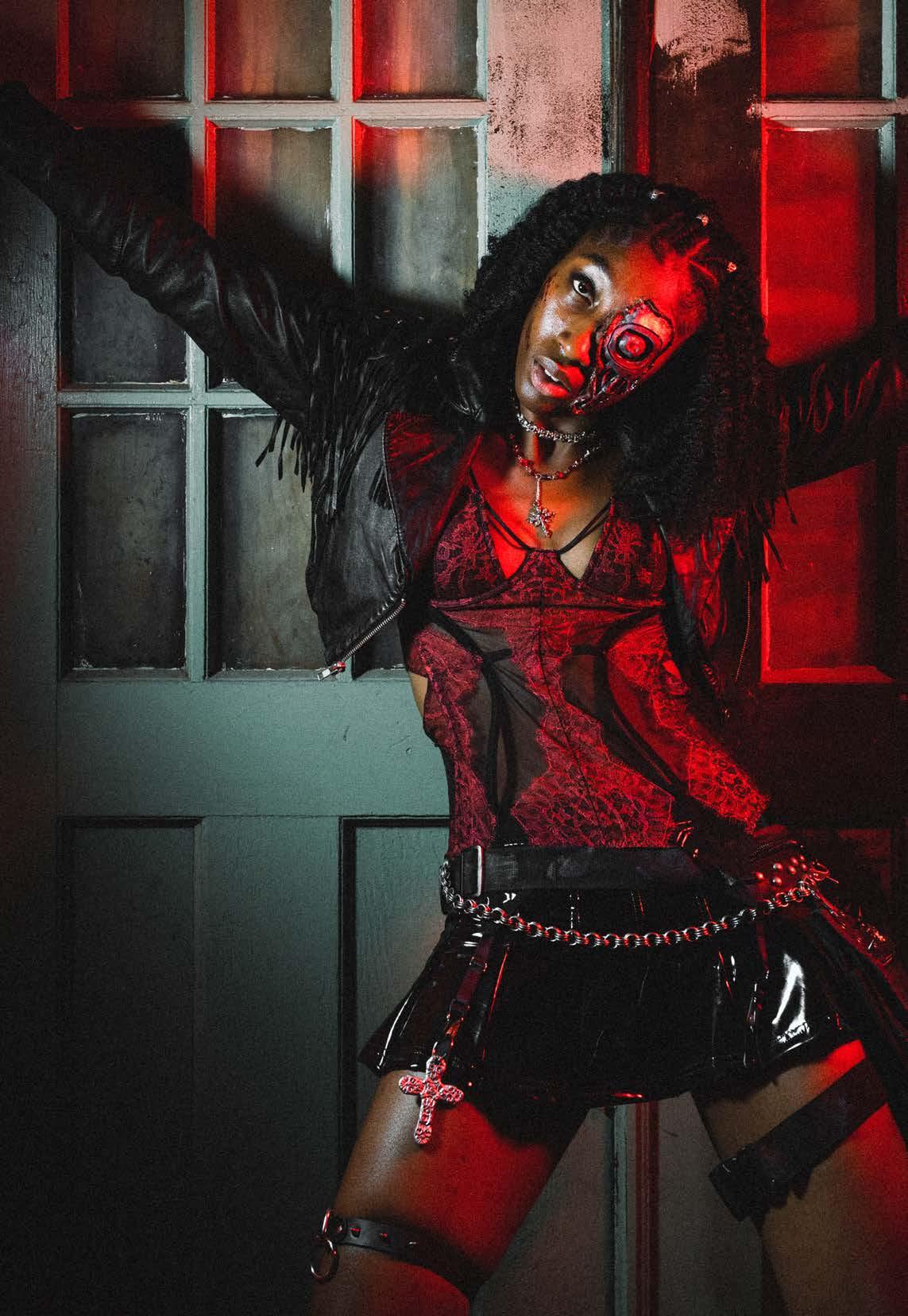
196 spark
jklfdas
jklfasd
Body on fire, I march through the flames engulfing what once had been our home. I feel free for the first time in my life. My hands are dirty and covered in blood. They smell like gasoline. I wouldn’t have it any other way.

My mother has always been my muse. Even as daggers flew out from her mouth, sharp ends pointing straight towards me, I revered her. She’s become the basis of every piece of art I’ve ever created, and drops of the blood shed at her hands soak my every word.
I was a mommy’s girl from birth until the first breath of womanhood. Time had always been ticking. Soon I was not her little girl anymore, and only help less girls deserve mercy. How else is a woman shaped, if not with a heavy hand? I was a naive child who thought a mother’s love was unconditional. I learned the truth way too young.
At 15 my mother found out about the girl I was seeing. It had been pure puppy love; I was too little to know anything else. The house felt like a rubber band that was being tugged and pulled at, getting tighter and closer to snap ping. The tension was palpable. One fateful Sunday night, the rubber finally broke. As I sat there listening to our priest tell me how the sins I had com mitted would land me in Hell, I started to ask the question: “Will I ever feel free to live?”
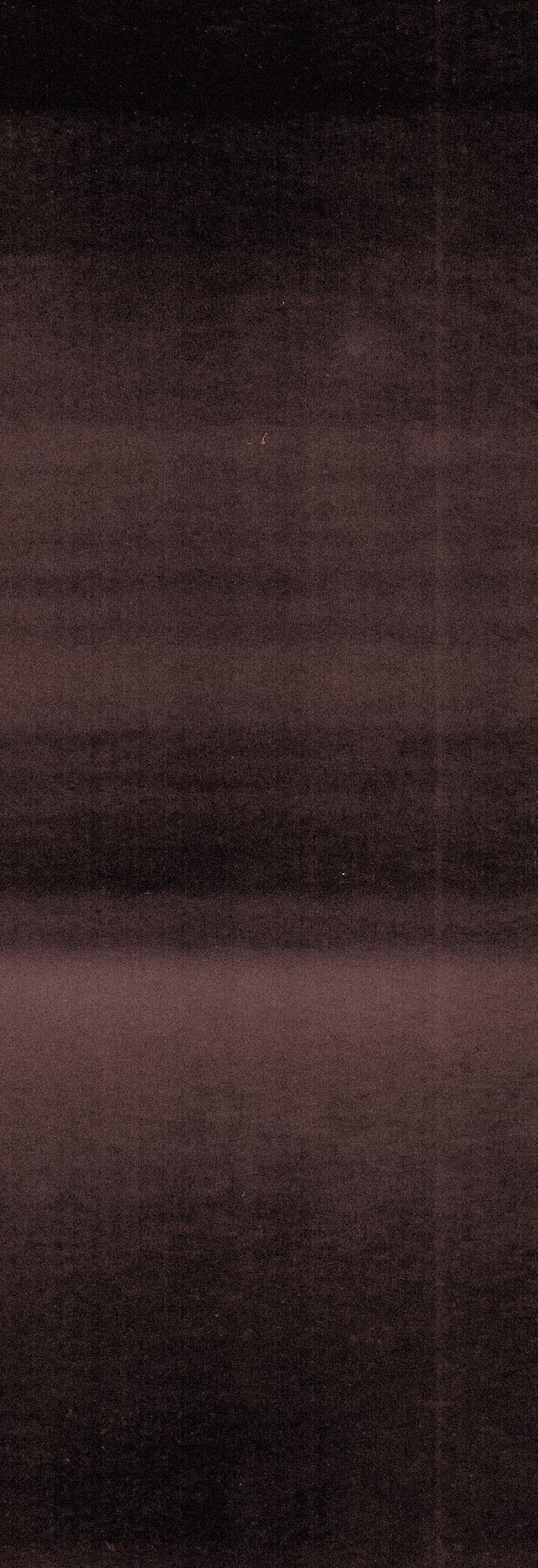
The truth hung over me like a stormcloud. “God” was punishing me for being my own version of human. There was no way my mother would have been capable of all that she was without Him. He took over her vessel and filled her with His voice, His venom, His fury. “It’s all in His name,” was the conclusion of every battle, every merciless attack, and I stood no chance. This harnessing of a thousand winds and the grace of God versus a frail ghost of a person. As she punched down in that chapel, her poison rushing through my veins, the cold wood of the pew under my legs embraced me. I begged for mercy, begged for the ground to swallow me whole. But it didn’t matter. She would never stop unless I put up my hands to stop her.
From that day on, I was determined to be the monster that would bite off her snake head. I stewed in my anger, letting hostility take over my soul. I took myself apart and put myself back together again, only this time, I made sure the scars left behind were hidden under layers of armor. No one would touch my weak skin again.
Looking down at my hands now, I see pure metal. My fingers are lined with lifeless wiring, my head screwed on too tight, my joints replaced with nuts and bolts and hinges. I’m singed on the edges, and my brown hair is gone. Everything I had ever dreamed of can start now that I’ve burned my bridges. Finally, after years of assembly, I was strong enough to move myself out of this hole I was thrown into.
197 deathless
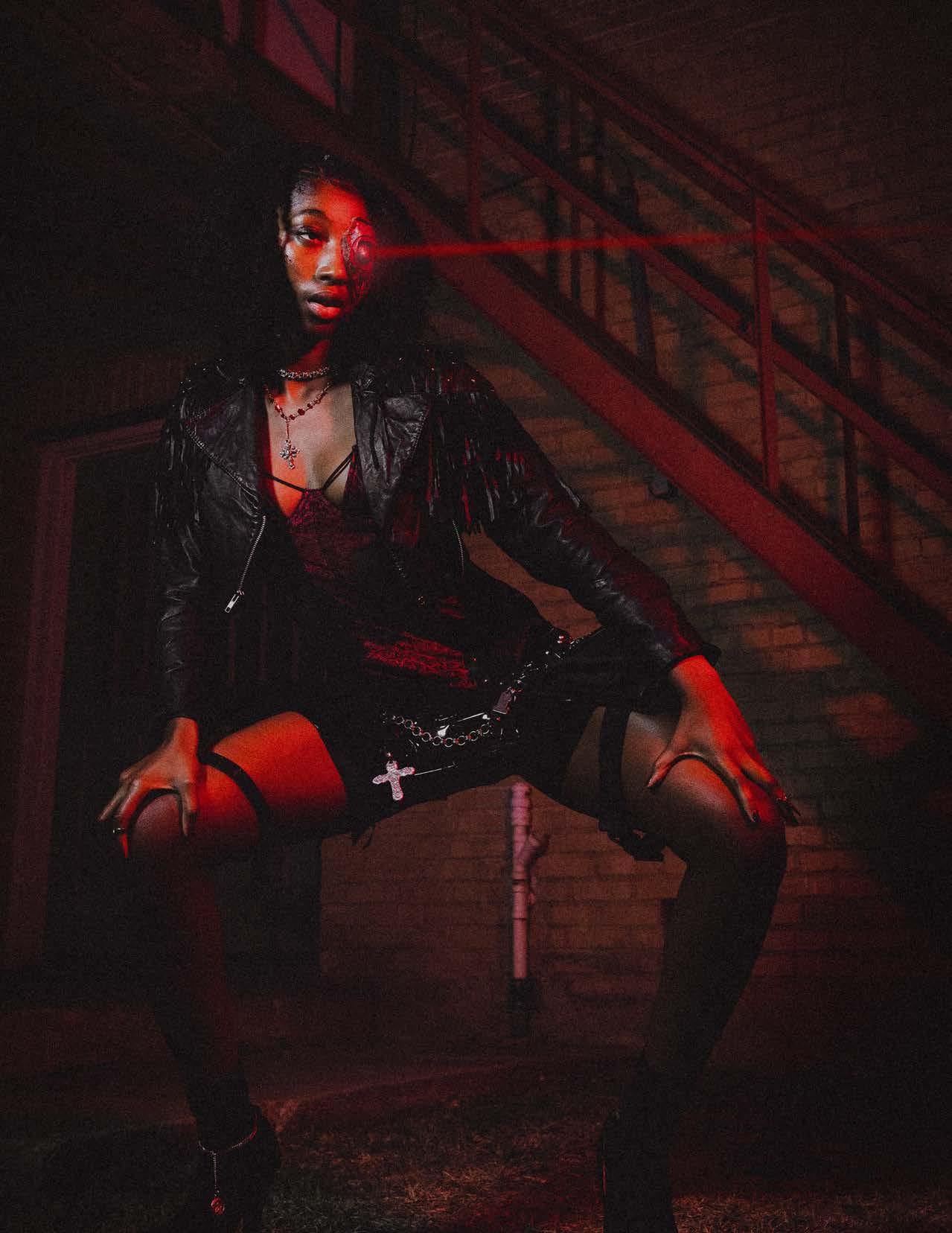
xiemqkd
xiemqkd
Turning to face my own destruction, I could still feel my heart beating. Despite my best efforts, it was impossible to fully mechanize a human being. There would always be pieces left behind.
Tears were running down my alloy cheeks. My heart wouldn’t let me breathe, opting instead to send cries of agony to my motherboard, each gasp leaving my lips with more vigor than those that came before it. The force with which my soul fought against what I had trapped it in was unprecedented. I expected this to get easier; I expected these layers of metal to protect me from the harm I had been raised in. It wasn’t supposed to be like this if what I’d done was justified. For years that house and the woman living inside it made my life a living hell. I had reached my limit. Red anger fueled my new body, and I let my mouth run free, the hate I garnered for years now oozing out of every pore. The disgust I conveyed to her made the room electric. As a poet, I recited the most beautifully vile poem I have ever created. I could never forgive her for what she had done to my spirit, and I made sure my words reflected that. I could never forgive the cold-blood murder of my younger self at her hands. She made me into this beast-monster thing, and now she had the nerve to sit on her throne and judge me for it. I could never look her in the eye again, never hold her to my chest again, never fall asleep curled at her side again.
After a while the mantra felt like mush. Its meaning slipped through my fingers. I was not convincing myself very well anymore.
Because despite it all, I long for the feeling of her cal loused palms. The ones that raised me, as best as they knew how. The hands that had once held her innocent child close, even when she wasn’t as innocent anymore.
Where did that girl go? I keep telling myself this armor I’ve built saved me, that it has done nothing but protect the frail, gentle person that I know that I am. But if I
sat down and looked hard enough, would I still find her? Has this robot I’ve made of myself completely replaced the soft flesh of who I really was?
I long for the feeling of blood rushing through my veins. Suffering wasn’t wanted when it was all that consumed me, but with no pain comes no pleasure. The one true balance within this universe is that of good and evil. What happens to a person who loses it?
What is the cost that comes with becoming cold to the world and its punches? The soul entwined with the per sona renders us unrecognizable, forcing us to stay lost forever. Women don’t have the option to nurse them selves back to health; we get beaten, spit on, yelled at, and then get up for work the next morning. We slip on our metal appendages and walk out the door as anything but women. Our rawness hides beneath falsehoods un til we are ready to accept ourselves for what we truly are: weak. Emotional. Loving. Caring. Crazy. Stupid. Imperfect.
Anything but rigid. Anything but robotic. Anything but machine.
I remember, one particularly terrible night, when my brother couldn’t fake it anymore, and the reign of terror we lived in had reached a peak. He stayed in my room until he fell asleep, with his head on my pillow and our puppy pulled tightly to his chest. There it was, I thought to myself. Here’s my reason. I felt as if the only way I could make sure these children made it out of here alive was to get out of this weak flesh and house myself in something mightier. But I never stopped to think about who they were turning to for comfort; it wasn’t a soul less machine with an impenetrable exterior. It was the tenderness of their vulnerable sister.
I grieve for that girl. How was I supposed to help my sib lings make it out alive, if I had shown them I couldn’t even do so? The arms that once provided asylum were
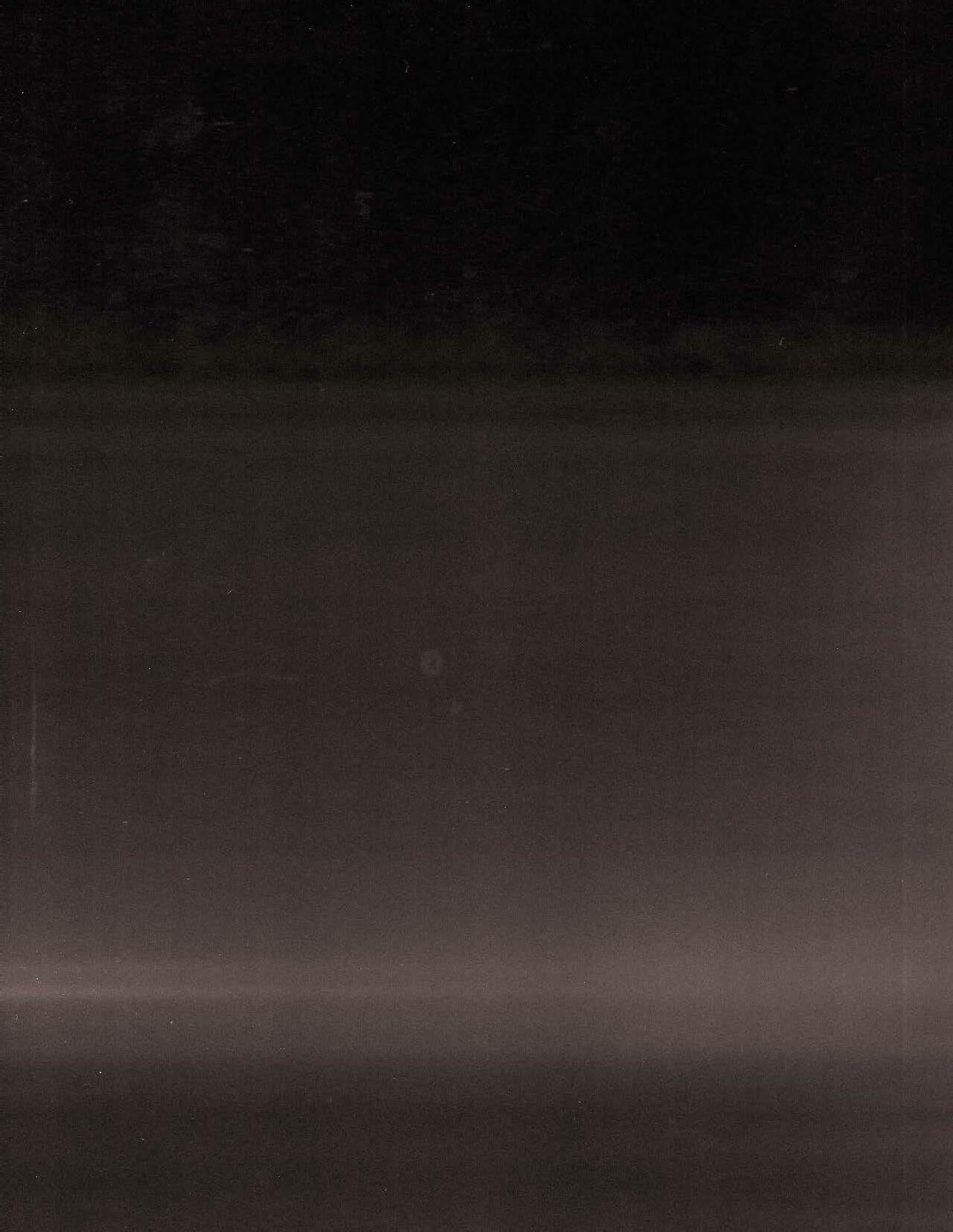
199 deathless
“Despite my best efforts, it was impossible to fully mechanize a human being. There would always be pieces left behind.”
now too frigid to bear. My eyes, once warm and inviting, have been replaced by a harsh red light and gray exterior.


And so, as I stand here watching it all burn, I’ve finally learned my lesson.
“You’ll understand when you get older,” my mother used to say. I hated that phrase and would refute it everytime. It was one of her many excuses, one I refused to accept. But maybe she was right. My mother was given faulty tools to begin with, and she did what she could with them. We come from genera tions of abuse, with my mother and her five siblings living in deep poverty in Mexico under the torturous reign of my grandmother. My mother had to carve this mold for herself, much like I did, as she was left with no other choice. She was cold and cruel because the world had shown her no differently, because the world had shown her that’s what it took to survive. It takes real effort to stop the cycle, and my mom is a busy woman. But I’m determined to stop it myself.
It starts with forgiveness and commiseration. It starts with a rewiring of sorts, a merge of human and droid that strikes just the right balance. Not too soft but still rather squishy. It’s allowing ourselves to be guided by love and not blinded by anger.
I’m working on it. I call my mom and go to church on Sundays, as often as I can stomach. I tell my siblings how much I love them every chance I get. Whatever it takes to get rid of the self-injected disease that plagues my skin.
Metal flakes still rub off in my sleep, and sometimes they clog the drain when I’m showering, but that’s all they are. Flakes. Only remnants left of a cyborg who is slowly learning to love her raw flesh. ■
xiemqkd
“But I never stopped to think about who they were turning to for comfort; it wasn’t a soulless machine with an impenetrable exterior. It was the tenderness of their vulnerable sister.”
200 spark

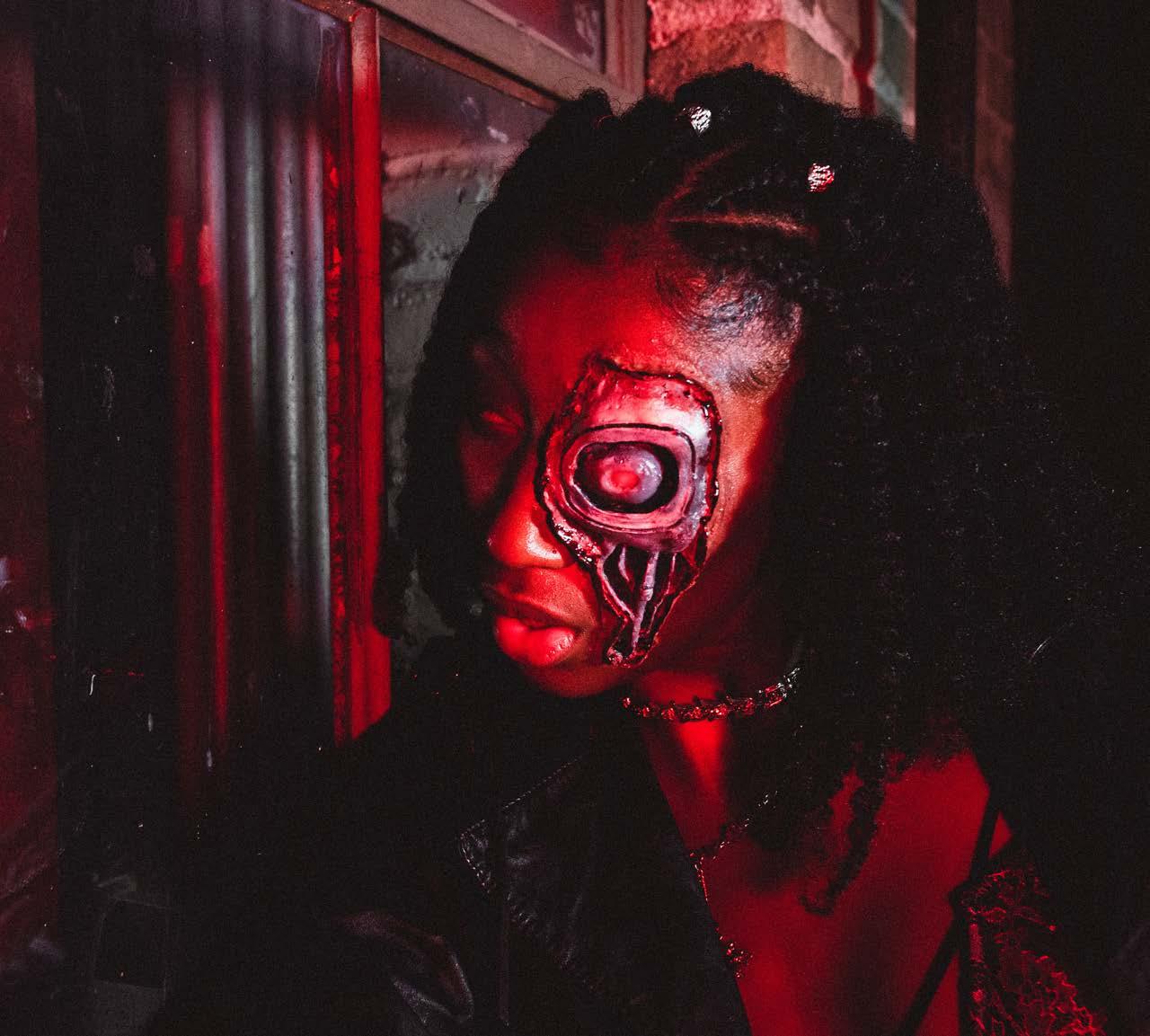
201 deathless
emqkd

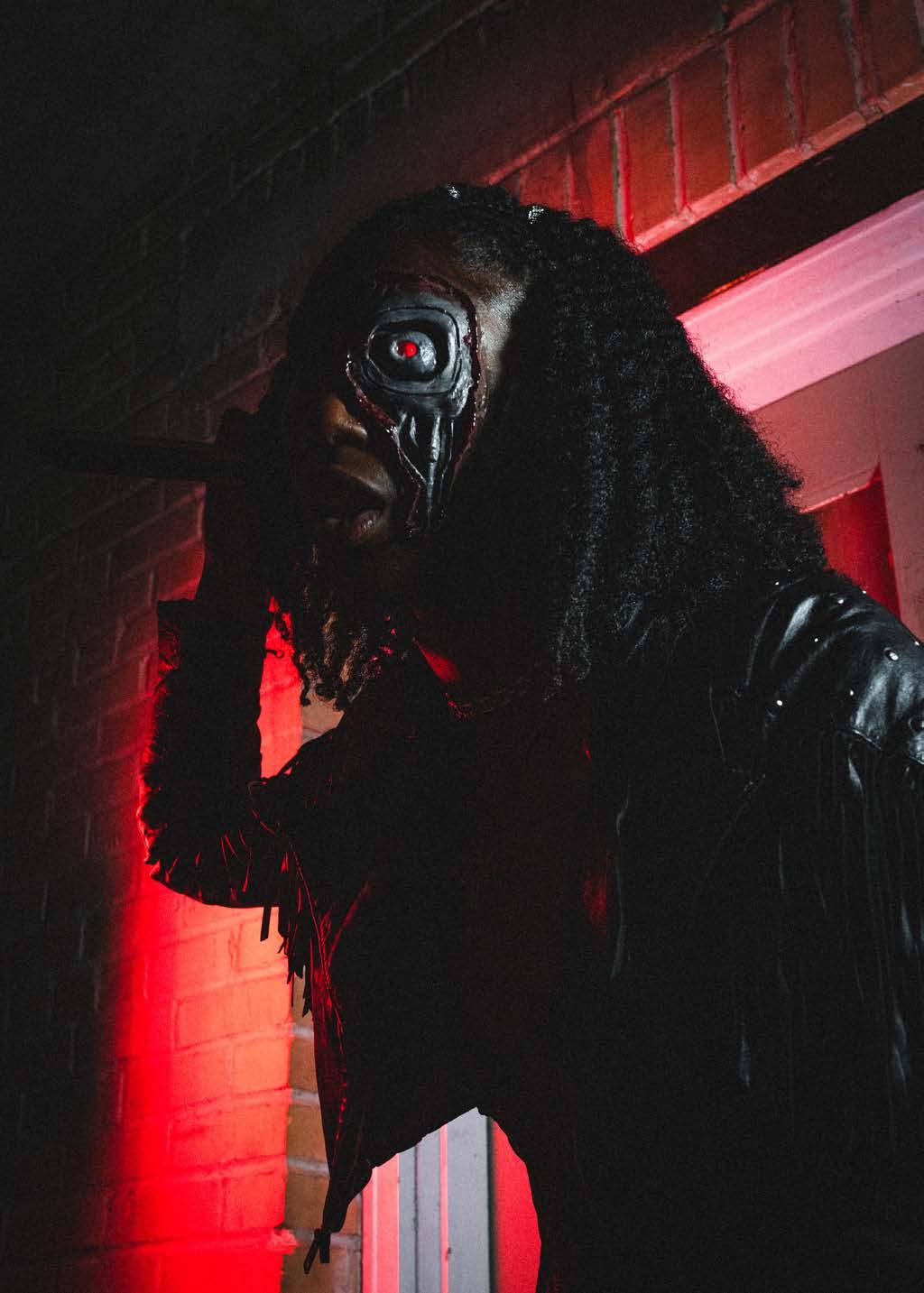
xiemqkdxiemqkd 202 spark
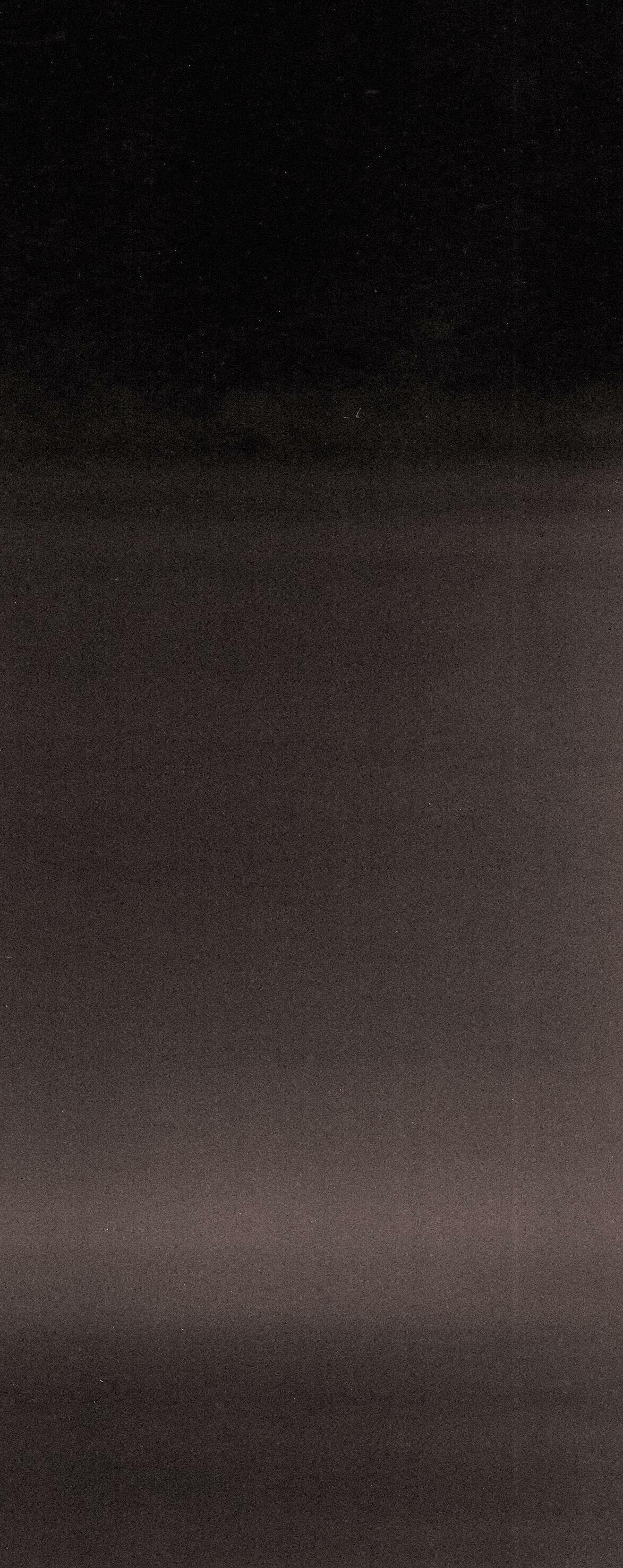

xiemqkd
203 deathless
xiemqkd
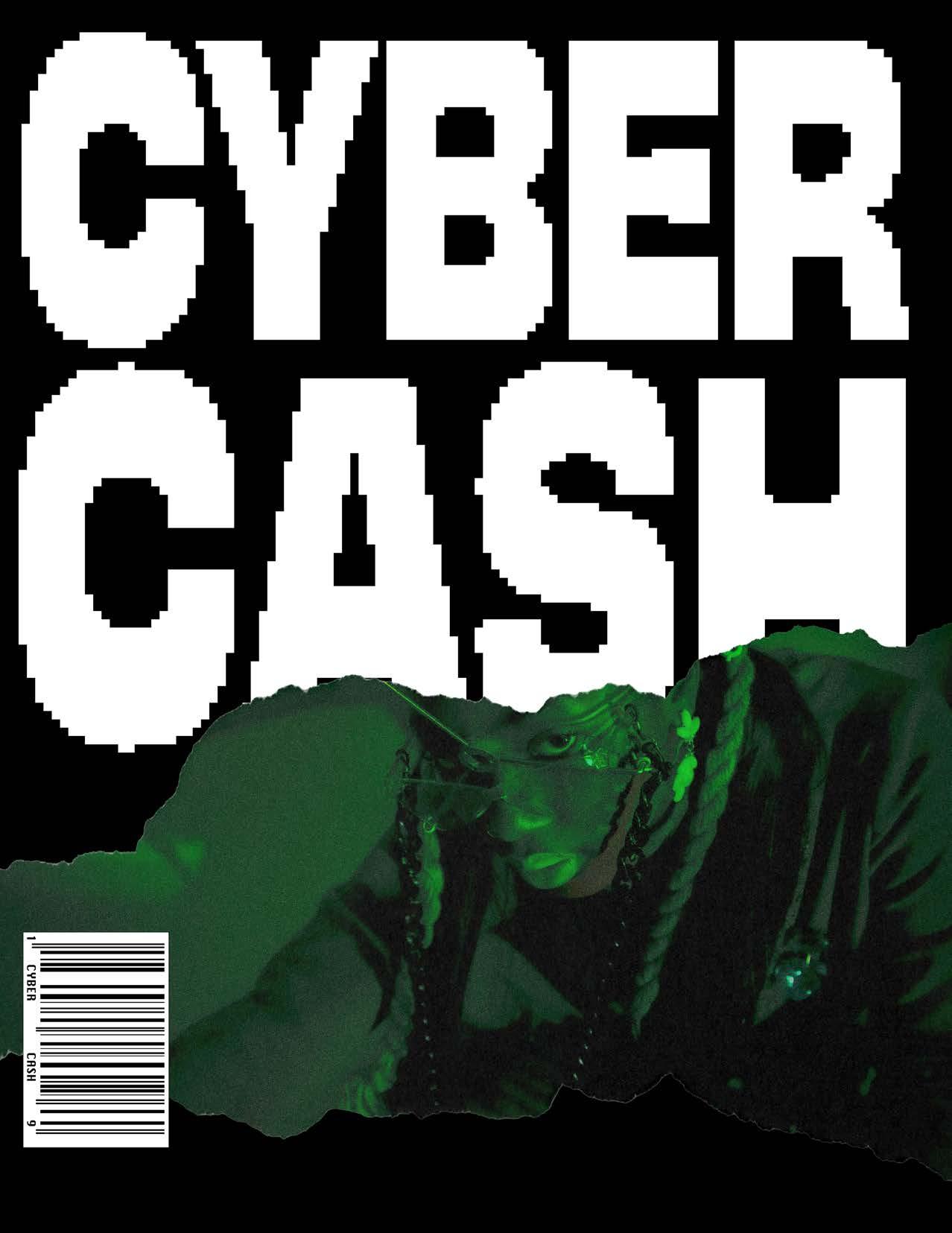 by CAROLYNN SOLORIO
by CAROLYNN SOLORIO
204 spark
layout VYVY LE photographer ELLIS BROWN stylists SATURN ECLAIR & JESUS DEL REAL hmua GABRIELLE DUHON models RHIONNA JACKSON & BRANDON AKINSEYE videographer ESTELA RIERA-VALES
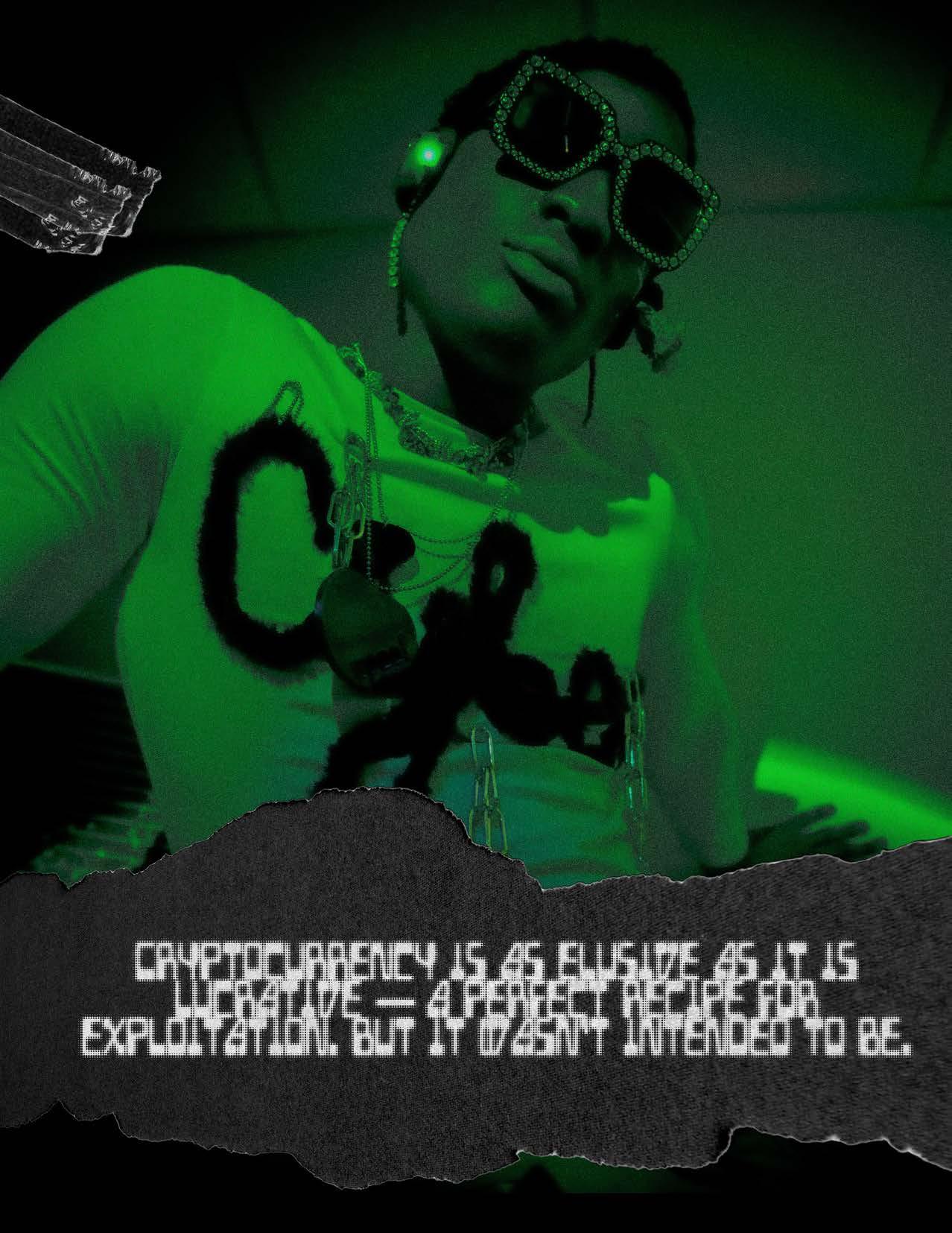
NECKLACE | Flamingos BLING SUNGLASSES | Revival Vintage GREEN CYBER TEE | Saturn Eclair GREEN CYBER PANTS | Saturn Eclair SPOOF ACCESSORIES | Saturn Eclair
” 205
GREEN
“
deathless
oney has a messy history.
Mostly because at ev ery phase of our evolu tion, we’ve reinvented it. We’re always clinging to the parts of our culture that force us to mea sure worth, to constantly com modify value and use it as a basis for all that we care about. Money is one of the few things that is understood by virtually everyone on Earth. It’s the universal language of the human race, our lifeblood, our key to survival — the origin of everything good and evil. Money is vital to society because it’s a manifestation of our most primal instinct: to interact. Without it, how could we ever truly value anything? Money is human, and it’s inevitable. We need it to tell us what to do.

Computers do that now, too. The in ternet revolutionized the concept of human interaction. Naturally, once we had global communication at our fin gertips, the need for global monetary exchange was immediate. How could we possibly talk to everyone, every where, without currency to measure the worth of our exchanges? In this way, the internet depends on the parts of human life that make money neces sary: communication and misunder standing, polarity and unity. When we could all finally talk to each other, we needed our universal language to un derstand what it all meant. The physi cal bill could no longer accommodate the instantaneous nature of communi cation in the digital age.
So, to accommodate the internet, money made the most radical change in its evolution: It became code.

Online banking was scary at first — it was our initial test run in handling money after its computerized facelift. Yet it didn’t take long for government institutions and privatized banks to quickly come to our aid, kindly re minding us to maintain our allegiance to capitalism. Extensive automated surveillance over all online banking became commonplace, an avenue of control over computerized monetary exchange. But now there was a prob lem. The internet told us that we were limitless, and in that belief we found freedom.

spark

207 deathless
So much of money’s previous influ ence was that we had to hold it in our hands to know it was real. We fought and killed over the stuff — cold, hard cash — because it was static. We’d pre viously relied on bureaucratic institu tions to print it out and slice it for us, granting them universal control. But that was changing. Instead, money be came satellite signals racing above our heads and the code across our screen.
And the thing about code is that it can be copied. And pasted. Everywhere.
Enter: CRYPTOCURRENCY. The an archist antithesis to banking. Crypto is the marriage between the global interconnectivity of the internet and the disobedient spirit of your average tax evader. It was originally meant to be elusive by design — a way to dodge the bureaucracy of online banking while still sending money everywhere around the world. There was danger in this Wild West, sure, but it was an escape from institutional eyes. It was the back alley alternative to an online format that recorded and reported ev erything. Crypto was the coder’s gift to the world, the currency of the insur rectionist. There was freedom to trade your numbers without anyone watch ing, the most deliberate way to stick it to the man. Cryptocurrency was meant to be a method of monetary ex change free from systematic abuse, but the problem with that is that we — the people using it — are not.
But damn if we didn’t try. Mistrust of traditional banking methods was rampant following the financial crisis of 2008, and people were desperate for an avenue of banking that divorced them from their reliance on bureau cratic institutions. We needed to re claim the code. En ter: BITCOIN. Bitcoin was the first mainstream decentralized cryptocurrency. It was the lab rat of crypto,
introduced to the public in 2009 ini tially as an open-source software. The value of Bitcoin was, and still is, de termined by a consensus mecha nism that’s produced through computer mining, which essen tially means that it is self-suffi cient. Bitcoin is constantly re evaluating its worth based on the merit of its users and the exchanges occurring between them. So, the reliance on the institutions that made online banking a perfect recipe for exploitation became negotia ble. In fact, there was a moment there where we could’ve been free from it entirely.
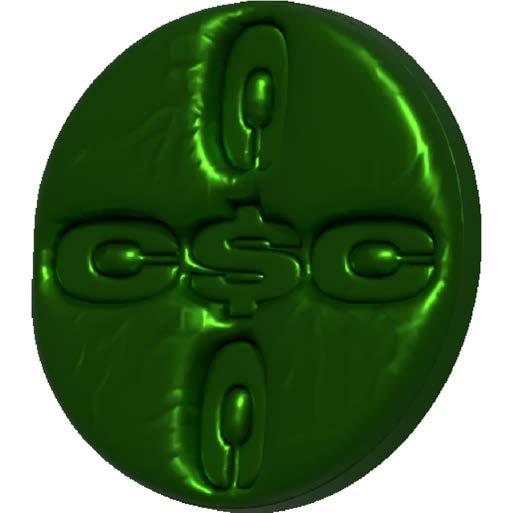
But we are creatures of habit, and money is always messy. The bureau cratic middlemen crypto had initially sought to eliminate quickly figured out ways to get back in the game. Trust fund babies and stock bros — people who weren’t invested in the promise of crypto, but rather the trading potential of it. Stock prices are predictable: rise, fall, rise, fall, rise, fall. So, when decen tralized currencies like Bitcoin become tradeable, it opens the door for people to uniquely manipulate that process. Value is dependent on the exchanges between users, and those who are seeking to “get rich quick” will be suc cessful in their pursuit. The anonymity of crypto and its sole reliance on users were exploited by those with extreme financial means to create a foolproof way of getting and staying rich.
Step 1) Tweet about a crypto stock potentially becoming lucrative. Step 2) Buy a shit ton of it. Step 3) Watch everyone else do the same. Step 4) Sell right before the downturn. Step 5) Re peat.

This form of immediate, formulaic wealth is unprecedented. These socalled “pump-and-dump” schemes are illegal in regular stock trading, but flourish under the nonexistent FCC regulation of crypto markets. Today, there are upwards of 20,000 decen tralized crypto currencies, the trading of which produced seven new billion aires in the last year alone.
Code isn’t cash — and because institu tions weren’t printing it and putting it in our hands, we got greedy. The limit does not exist. So we tried to do what they’d always done – control it. But that’s missing the point entirely. Under capitalist pressures, crypto can never thrive as the anarchist online banking avenue that it was originally conceptu alized to be .
Crypto wasn’t originally deceptive. It was the escape from heavily surveilled online banking, meant to preserve the aspect of human interaction and agency in the age of cyber cash. But these unregulated fantasies are impos sible within the structural confines of capitalism; we commodify everything, everywhere, all the time, because that’s what it teaches us to do. Crypto is an example of the most dangerous as pect of our financial future: legitimate avenues for independent monetary transactions being manipulated and hoarded by the top 0.001%.
Capitalism extracts the humanity out of everything. As long as we try to con tort human innovation so that it agrees with capitalist principles, we’re trapped in an endless cycle, where our future is destined to be as messy as our past. ■
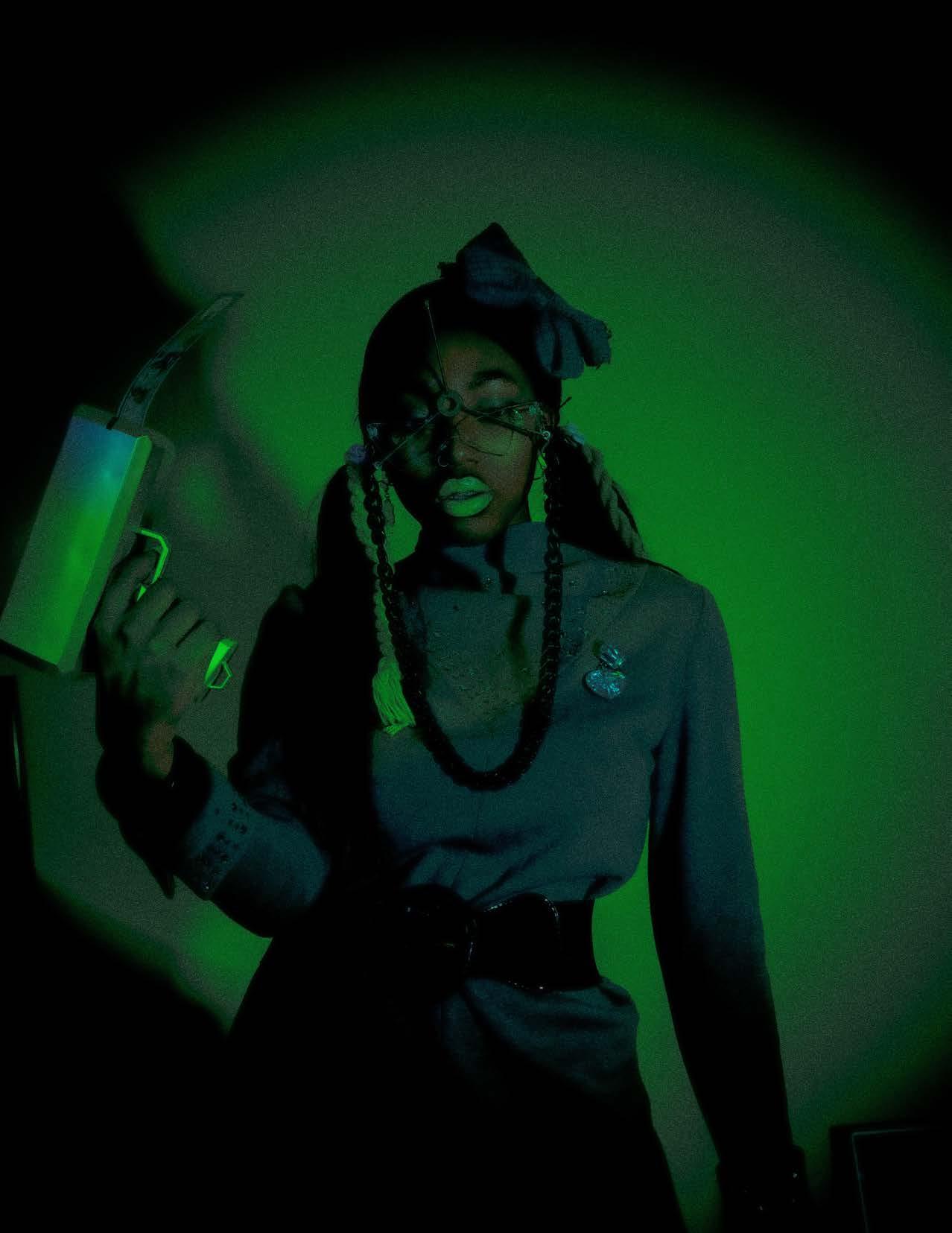


209
BOW PIECE | Revival Vintage GREY BLING DRESS | Flamingos EYEGLASSES | Revival Vintage EYEGLASS CHAIN | Revival Vintage BANGLE | Revival Vintage BLACK BELT | Revival Vintage NAILS | Saturn Eclair
deathless
by ELLEN DALY
Having always prioritized professional pursuits over recreational and romantic ones, I’m beginning to wonder whether I’ll ever be a mother, or if I’m fated to live as a machine.
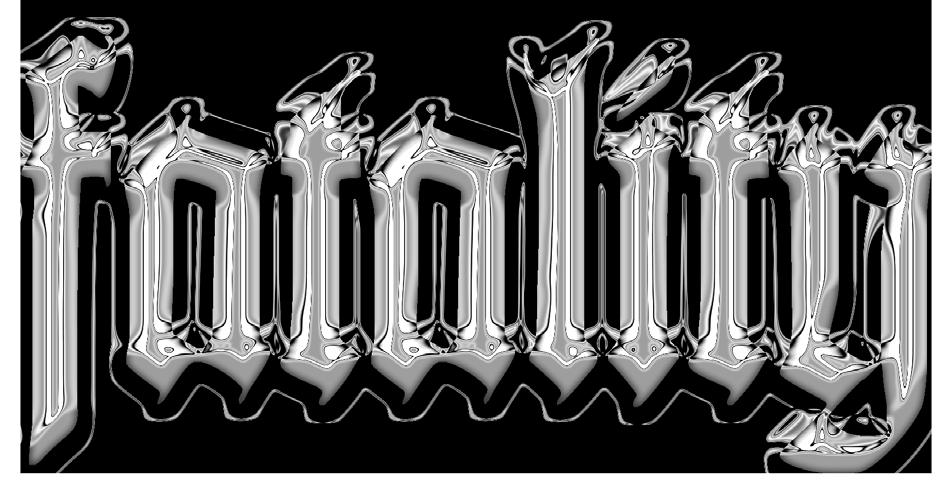

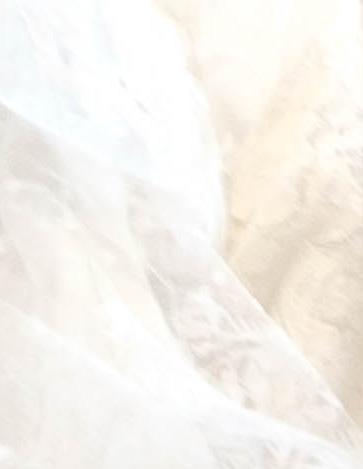 layout CHARLOTTE ROVELLI photographer RACHEL KARLS stylist ISABEL SITAR set designer NIA FRANZUA hmua EMELY ROMO model PAYSON KELLEY videographer LISSIE HILL
layout CHARLOTTE ROVELLI photographer RACHEL KARLS stylist ISABEL SITAR set designer NIA FRANZUA hmua EMELY ROMO model PAYSON KELLEY videographer LISSIE HILL
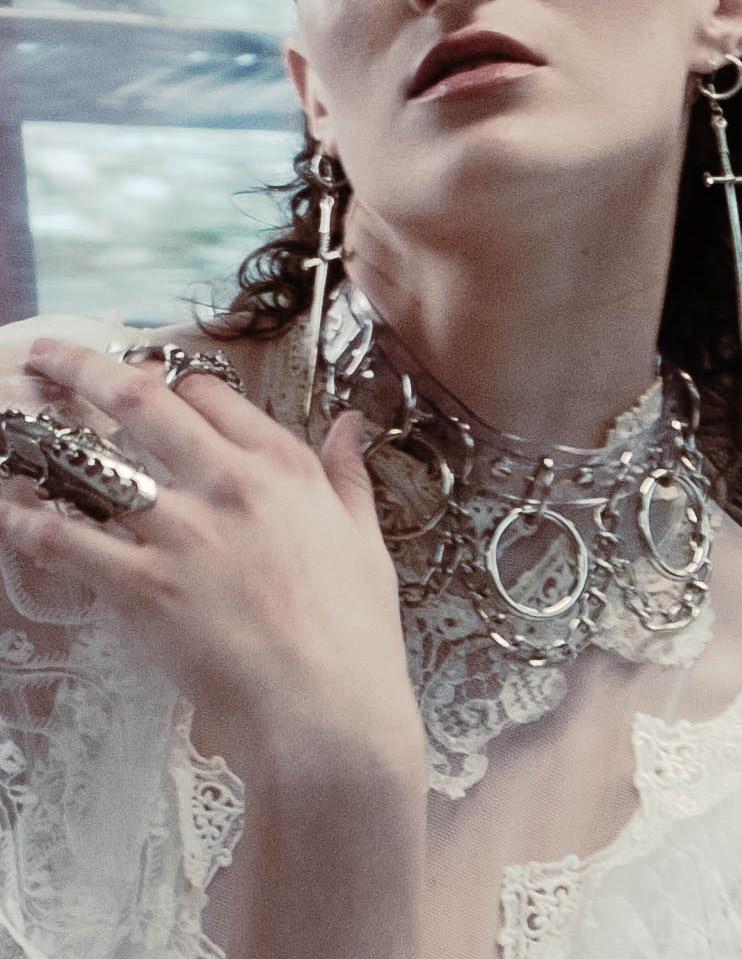

211 deathless

212 spark
WHITE WEDDING DRESS | UT Trash To Treasure CLEAR VINYL CHAIN NECKLACE | Blood Rose Boutique
think it’d be fun to have male room mates. Maybe I’ll do that later in my twenties. When I’m like, 26 or some thing.”
“I’d rather have a husband by that age.”
My friend turns to me in horror.
“26? You’re gonna have a husband by 26?”
“If I’m married by 26, shoot me,” my other friend chimes in.
I’m not embarrassed. I’m practical. In fact, it’s my very practicality that has led me to this moment, at 21 years old, where I’m beginning to worry about my fertility. As long as I can remember, I’ve been obsessed with being “productive,” with academic achievement, with making Quizlet sets that my entire high school would use to pass their tests and even turning my chosen form of creative expression—writing—into a career path, something to monetize. Now, I worry it might be time to put down the pen and pick up a man.
“My mom got married at 26 and she seems plenty happy in her marriage. I think they’re lucky to have been together so long. I’d be lucky to be so lucky!”

They roll their eyes.
“Look, I want to be a mom. I always have. If I had to choose between working any job in the world and having kids, I’d have kids! It’s something I know I want to do, and, if I’m being completely honest, I’m worried about my fertility.”
“Your fertility?” As if the subject’s never crossed her mind.
The rest spills out of me: my period that keeps going away, my feeling of selling myself like meat every time I open a dating app, my lost friend ships and flirtations I deem personal failures. My fear that I run people away like my menses. Both sides are baffled: my friends, at the severity of my existential angst, and I, that my most haunting worries are total strangers to my closest friends.
When did mothering become so taboo? I’ll admit that just a few years ago I too considered the idea of being a young mom a death sentence, but now it sounds peaceful, relaxing, fulfilling even. Back then I lived under the false pretense that work was going to fulfill me somehow; through trial and error, I’ve debunked that capitalist myth.
“Do y’all know that women lose 90% of their eggs by the time they’re thirty?” I inform my friends, hoping to redeem my rationality with an ounce of agreement from them.
“Family is important!” I want to scream. “You didn’t end up here by accident! Your parents
213 deathless
“I



214 spark
first saw God in the face of a plastic doll.”
chose to date each other, chose to get married, and chose to have you! These things don’t just happen—you choose them!”

But I don’t say these things. I mean, I get it! For most of human history, women had no choice but to bear children and raise them and were re stricted to the confines of their homes. Who was I to deny that this was the best time ever to exist as a woman? So instead, I sit with the silence.
I think about my childhood. How badly I wanted to mother. Between myself, my mom, my two sisters, and my traveling-for-work father, my household was very feminine, making woman hood itself a deity of sorts. Play was our prayer, and “house” was our favorite game, with the role of mom being most coveted, of course. When I was five, my mom and sisters and I even traveled to our Mecca (the American Girl store) where I first saw God in the face of a plastic doll.
I was lucky. My mom was, really. My dad just happened to make enough money for her to be able to stay home to raise me and my sisters. It was a wonderful childhood—delightful, truly— all dependent on my working dad’s dime.
I traded play for work at far too young an age. My earliest memories of workaholism are from fifth grade, when I, at 10 years old, obsessed over my schoolwork. I went above and beyond, creating study guides, flashcard decks, sometimes even animated PowerPoints to review material be fore every quiz or test, despite never having had a problem paying attention in class or recalling information. Perfectionism was my drug, a pill I popped every day from the end of elementary school up until some point in my junior year of high school—when, against all odds, my depres sion finally beat my anxiety.
I didn’t date. Didn’t go to parties. Didn’t even
215 deathless
“I
hang out with my friends much outside of school. I did, however, play basketball, softball, and la crosse; compete on the mock trial team, babysit or tutor most nights of the week, hold leadership positions in multiple honor societies, intern for a congressional campaign, and lead an organized protest for gun reform at my school. To me, my work was my worth, and I always ensured that my value went up.
If my teenage years were defined by the obsessive aspiration of my dad, my 20-somethings so far have aimed to frame relationships as the focus of my life, like my stay-at-home mom does. This hat doesn’t quite fit, though, since I spent my teen age years fighting my feelings to stay focused on my schoolwork, mastering the art of emotional repression. Relationships are frivolous, petty things! Dating is so silly! Get your bag, girl! You don’t need a man! This is perhaps the greatest evil of capitalism: its inherent suppression of hu man emotion. I developed a coldness, built a wall between myself and potential lovers, one that I punch and kick until my muscles tire and fists ache but can’t quite seem to break.
Besides, if you’re not working, do you even de serve to live? The U.S. essentially says no. The problem here is that there’s no economic value assigned to home care. The government doesn’t pay to raise children, care for the sick, or aid the
disabled, and it is certainly no coincidence that these populations are less likely to produce labor. Refusing to value the giving of care fails not only our most vulnerable populations, but the many who would be fulfilled by these labors of love.
At 21, I romanticize “tradwife” aesthetics, falling victim to the idea that a working man could free me but quietly knowing that that is not the case. I revere the women who paved our way in the workplace but know too that that is not enough. The shortcoming of workplace feminism is its dependence on an economic system where free dom is gained with capital. How free are we, though, if we are not free to mother? If we can not bring life into the world because we spent our window of fertility preoccupied with work? Or, if we are so lucky to bear children, if we are not free to mother them in precisely the way we would if we could bless them with all of our time?

For me and for many, work alone is not lib eration—love is. This love we may only know through the fostering of intimacy: through first kisses and first breakups, held gazes and held hands, wiped bottoms and wiped tears. Forced labor doesn’t merely rob us of our time; it robs us quite literally of the fullness of the human ex perience.
“I just want to be a mom,” I sigh. “I’ve always wanted to be a mom.”■
216 spark
“This is perhaps the greatest evil of capitalism: its inherent suppression of human emotion.”
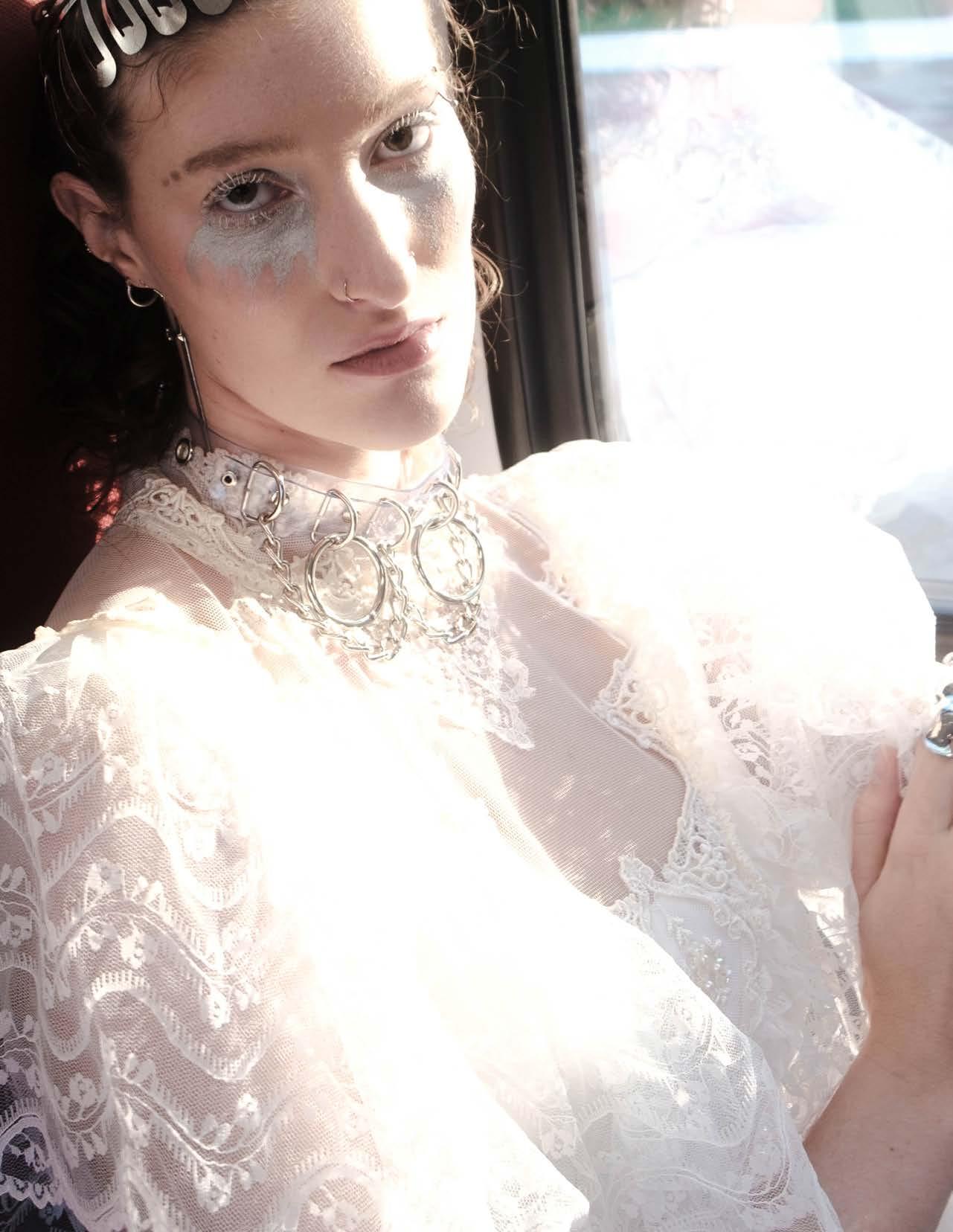

217
optics o optics optics
by AMELIA KUSHNER
layout MELANIE HUYNH
dskjfbkjdfhgjkfdhgka sdjfhkjdhfjkdgjfdhg; osdfhodhgodfgijdoija sofhsdoifhoidsifjsdo sdhfoidfiodwiuyrercn sdofhidsohfoidoihfod
abcdefghijklsajndjkf
LOSING TO The man: now with stories and posts andprofiles,ohmy!
dskjfbkjdfhgjkfdhgka sdjfhkjdhfjkdgjfdhg; osdfhodhgodfgijdoija sofhsdoifhoidsifjsdo sdhfoidfiodwiuyrercn sdofhidsohfoidoihfod
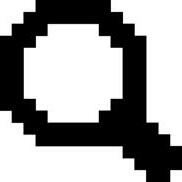



My consumer base is very dear to me.
My consumers number 1,845. Not a notable number. Not excessive, but not quite modest, either.
My consumers know me. They know everything there is to know! They know that I am early 2000s Top 40, that I am beige/green/mahogany, that I am animal lover, I am cheeky-sexy-sarcas tic, I am blue eyes in the sun.
My consumers must every day prove that they would purchase me again for me to retain my value. Buy me! Buy me! Like! Comment! Turn on post notifications so you don’t miss a thing!
How rigid, how numeric. Quite impersonal, for the platform excused as a means to connect with people ( — in these dark and divisive times, a very diverse ad between posts may remind you).
I am a seasoned producer. I am part of the Instagram generation. For us Instagram was not for recon necting; it was the initial con nection. It was not for express ing our complete adult selves; it was the initial step in identity formation. Who was I before I told everyone who I was on Insta gram? How could anyone possibly de scribe me to someone else without show ing them my Instagram?
If you are born in the Instagram generation, you are appointed your own brand strategist at 11, 12, 13. You now have to juggle content creation and brand management with middle school soccer practice and getting your Red Cross babysitting certificate. You manage your image you curate, you engage, you repost what you’re supposed to and you take on the role of the celebrity, of the corporation, of The Man, who does all that to ward the end goal of money, but you do it for free. You are still the spender. You still consume. But now you also produce. Now you do what they do, you lie and fudge and re-edit and FaceTune, and yet you still believe in the earnestness of the celebrity, because if they are not honest then nei ther are you. Here is where modern consumers uniquely lose to The Man.
Prior to identity-by-Instagram, our losses to The Man were standardly Marxian. Our one
advantage, as the proletariat consumer, was that all we did (all we did autonomously, that is, in dividually) was consume. The Man depended on the whim of the people – he produced, we con sumed. Our tastes dictated his production. The Man was subject to mass opinion in the way that we the commoners were not; we the commoners preoccupied ourselves with only to the scrutiny of our friends, of our family, occasionally of a couple of select strangers at a party, perhaps, or on a blind date set up by a mutual friend. And so we had this one advantage in our under ling lives – we did not have to constantly cater to the fickle whim of the masses.
Now The Man has stripped us of even that, and sold us the idea that we did it to ourselves.
Why don’t you just delete it?
That question used to plague me. That Gen X question, asked with a ticked-off what-gives? sort of expression.
Wouldn’t we all, if it were that easy? Wouldn’t at least the less material, at least those with half a brain and a bright future ahead of them, if it were that simple?
I fancy myself intelligent (I wonder if my consum ers would agree. I pause and think about that for a while before continuing this paragraph). And yet a significant portion of my energy is directed to this thing which eats at me, which makes me hate myself and which feels often like an utter waste of time and effort. So why, why, why? Why do I continue to spend myself like this?
It is because we the Instagram generation are not all simultaneously inventing the importance of our social media presences. It is not a choice to
abcdefghijklsajndjkf
219 deathless
“You now have to juggle content creation and brand management with middle school soccer practice and getting your Red Cross baby sitting certificate.”
package ourselves like this, or it is not a choice without consequence.
Instagram is not vanity for the sake of it; it serves a practical function in how we socialize. I asked earlier how anyone could possibly describe me to someone else without my Instagram (rhetorically, you may have thought sarcastically, perhaps; I am sarcasm, as you and my consumers may remember). But this is a very real phenomenon. We the Instagrammers almost exclusively talk about people with the visual aid of their Instagram. Or we won’t even describe them at all; we’ll just pull them up on our
phones (“them” being a metonymy for “their Instagram,” because it’s all the same, really) and show them (there it is again!) to someone else, and wait for the someone else to come to the judgment which we already have.
Our judgments of Instagrams, then, are judg ments of people. And since we have access to Instagram anytime, anywhere, and access to real, live people only when they happen to be in the same room as us, Instagram judgment most of ten precedes and replaces any opportunity for real-world judgment; therefore, Instagrams tell us if we like or dislike a person, who we want to hang out with and who we don’t, who’s cool, who’s smart, who’s creative, who is boring or who seems like such a bitch. So we have to spend all this time curating an image. We can’t put down the phone and “live life,” because life and fun and friendship and even love all start on Instagram. If you’re not on Instagram (even if you’re not dili gently active on Instagram), you may be strange, you may be other, but most of all, you’re behind
So what am I supposed to do on my na tional park hike, then? On my trip to Paris? Not show myself there to my consumers (and, more importantly, my potential consumers!), in my nonchalant and aesthetic way? Not orient my entire experience around content creation, trying to shake the shame that I feel as I do it?
I just can’t leave work at the office. The Man, you clever thing, you!
Our parents sigh and shake their heads at us as they struggle to get everyone together for a family photo in front of the mountains/ city skyline. Those kids and their damn Insta-Snap-Tweeter! The Man says to our parents on Face book.
We are so advanced, with our tech nology and our internet lives! How shocked, how wowed, our predecessors would be if they saw all these images and conversations and connections!
Advancement is a funny thing. How straight forward it seems, yet how arbitrary its metric. Have we advanced, Black Mirror? Or are we tan gling ourselves deeper away from True Progress, as The Man claps his hands with glee?
■ sv 220

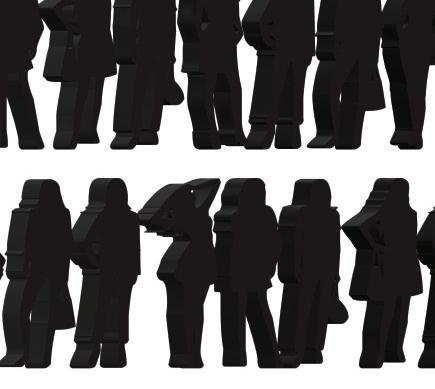

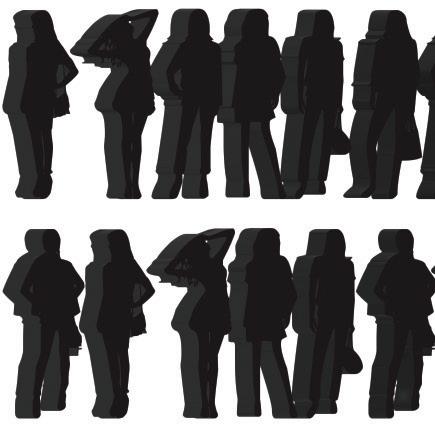
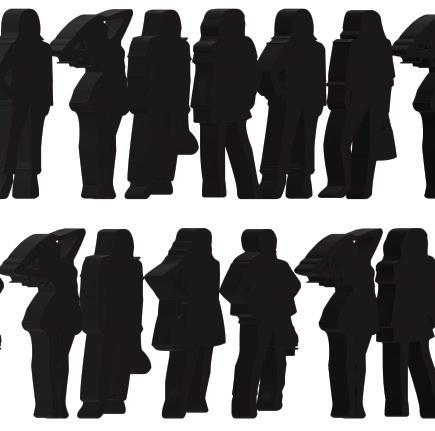

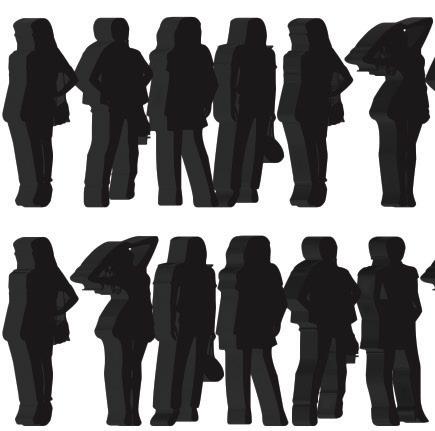




221 deathless
“If you’re not on Instagram (even if you’re not diligently active on Instagram), you may be strange, you may be other, but most of all, you’re behind.”

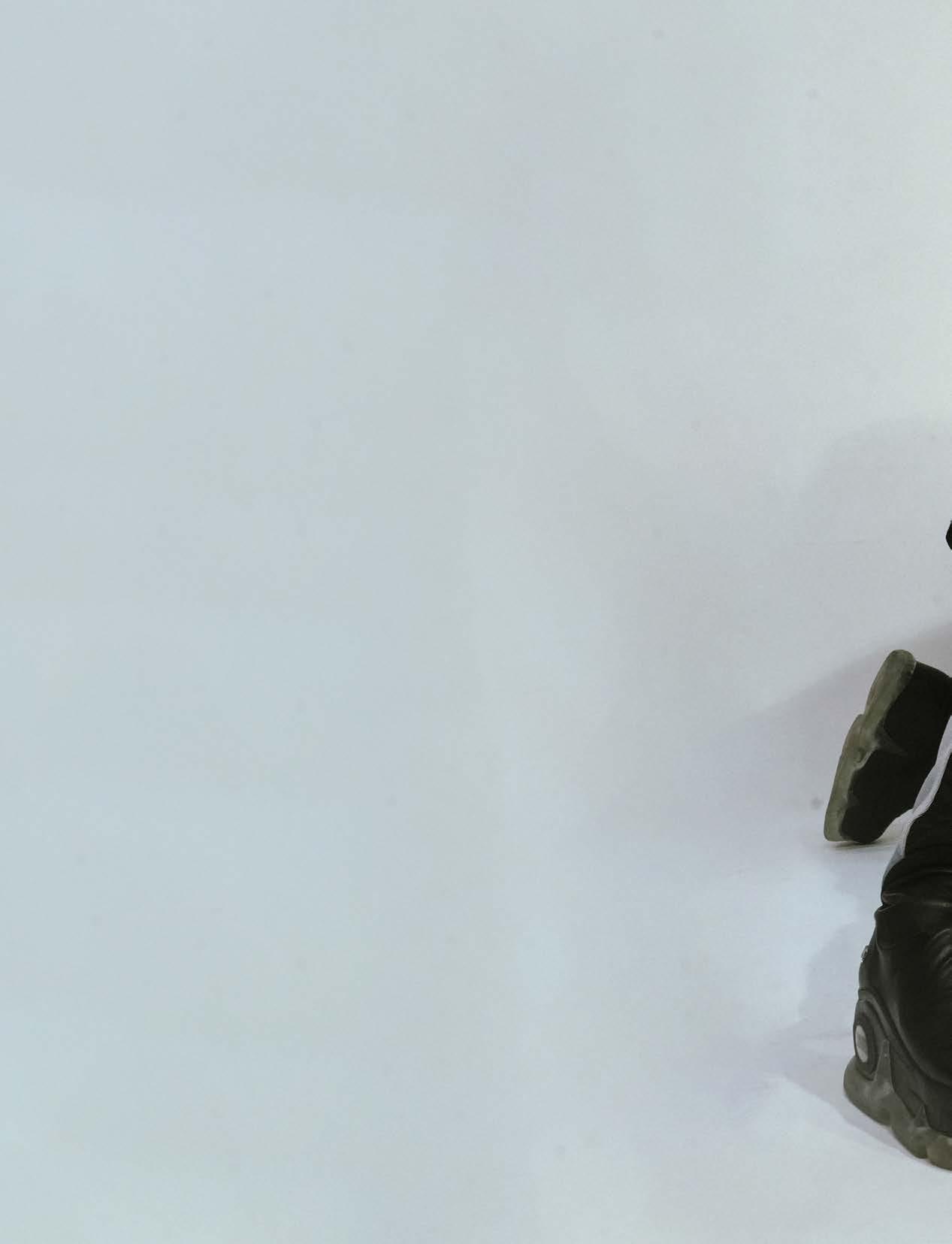

222 spark


223 deathless


224 spark


225 deathless

226 spark


227 deathless


228 spark
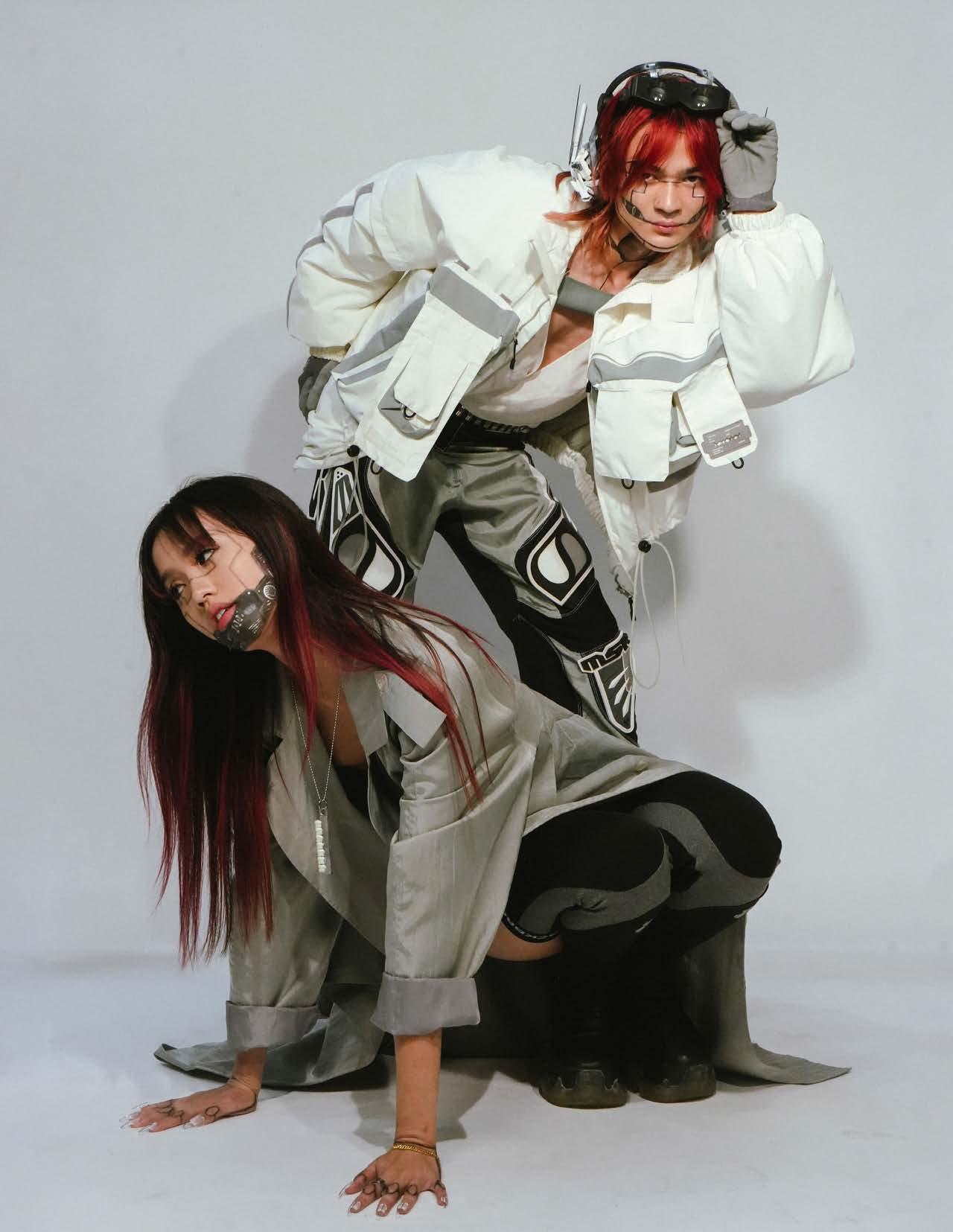


229 deathless
Head in the Cloud
 by ELLEN DALY
layout PRINCETON TRAN photographer VIA CEASER stylist SATURN ECLAIR hmua REAGAN RICHARD models MORGAN CHENG & YOUSUF KHAN
by ELLEN DALY
layout PRINCETON TRAN photographer VIA CEASER stylist SATURN ECLAIR hmua REAGAN RICHARD models MORGAN CHENG & YOUSUF KHAN
spark 230

231 deathless
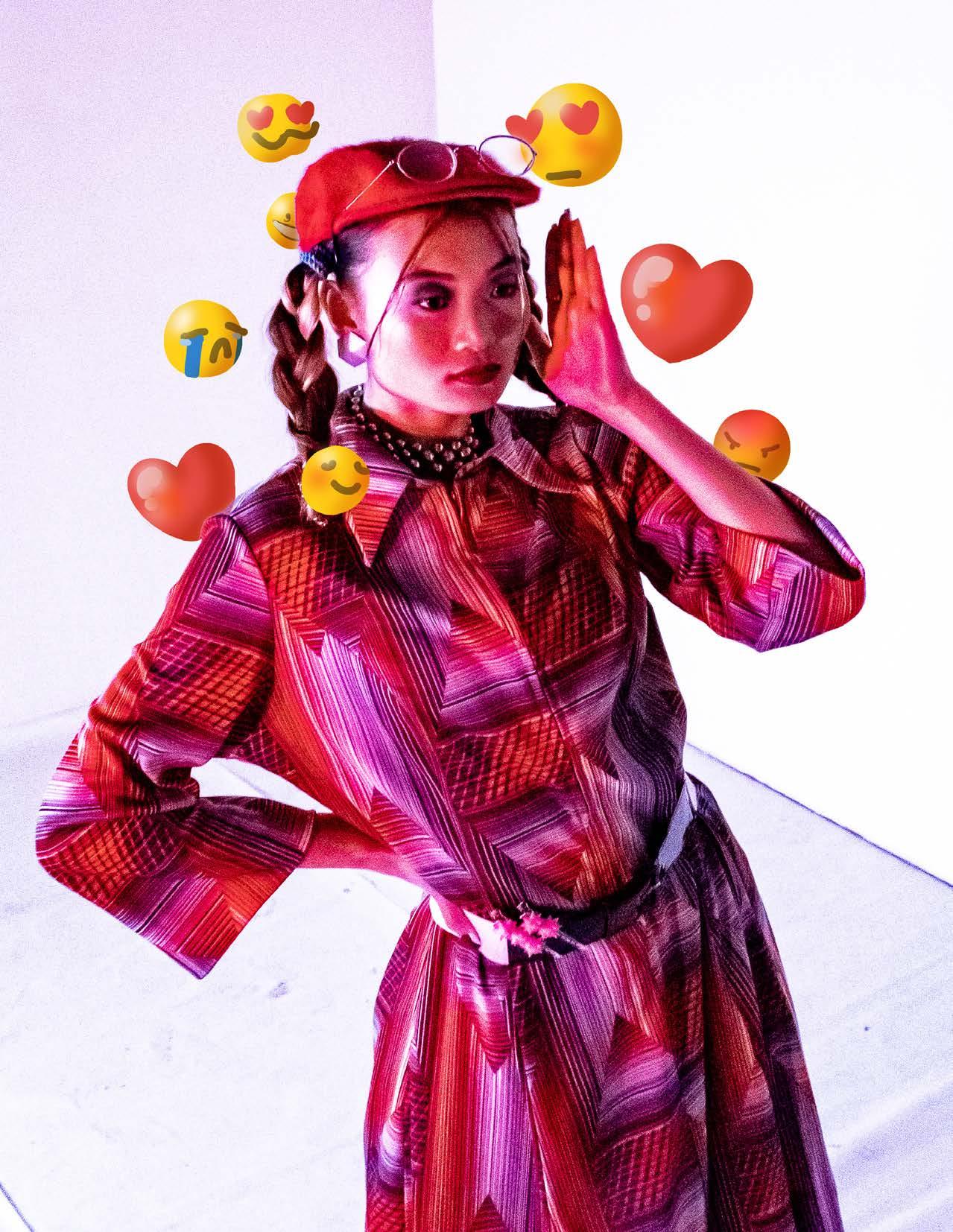
232 spark
Beep beep beep! Open eyes Another day of Life online

Face the screen
Turn the key What’s in there for Me to see?
No new messages Not today Guess for now I’ll Look away
Morning cocktail Pop pop pop! Happy pills to Work my job
Need a break It never ends Making content Making friends
Making content? Making friends! Making content! Making friends?
Work is life! Work is friends! Work together! Til the end
Look at time! Shift is done Going home to See no one
No one home? That’s OK! I’ll ask pixels About their day
233 deathless
Never alone! Not online Voices, faces All the time!
SCREEN TIME! SCREEN TIME! ONE MORE SWIPE BEFORE I DIE!
Give me content! Give me likes! Give me, give me One more swipe!
What’s my purpose Off the clock? Scrolling, scrolling Cannot stop
Why go do it When I could watch? Sex and sports and Travel vlogs
No one gets me I’m unique! No one knows me Like my feed

“It takes a village” I object!
I’ve got bootstraps And self-respect
234 spark
Need some help? Look online! Questions answered All the time
What is joy? What is left? What’s that aching In my chest?

Where’s my husband? Where’s my wife? Where’s my semblance Of a life?
Brain hurt Brain sad Time to open ‘Nother tab!
One more hit One more drag Take the edge off Make it last Cannot sleep Cannot eat Losing function Losing steam
BetterHelp Help me, please! Must be dying Of disease
235 deathless
Don’t you sleep yet Eyes on screen! If you blink you’ll Miss something
Help me, God! Help me, please! Sever ties ‘tween eyes and screen
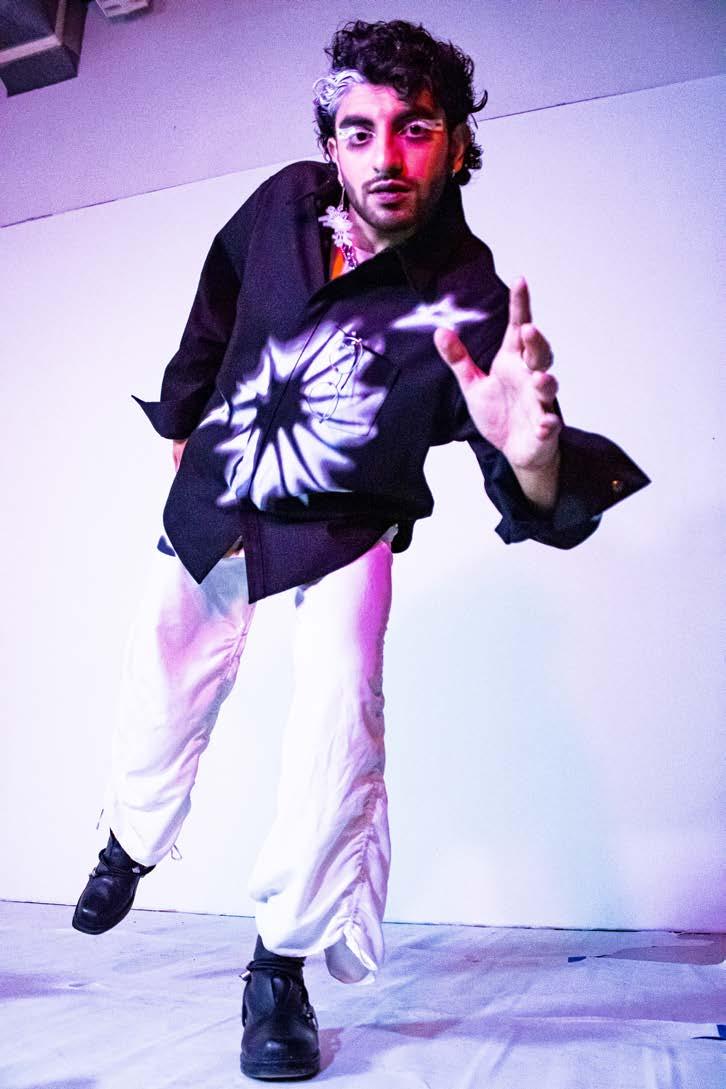
Too much out there More in me Scary scary Life v. screen
Nothing out there Only screen Screen is always There for me
So when I start To feel alone I face my screen Unlock my phone ■
spark 236

deathless 237

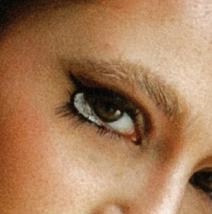

 by ELIZA PILLSBURY
layout COLIN CANTWELL photographer KATIE CHANG stylists EILEEN WANG & JACKIE BUSH hmua AVERIE WANG & LILY CARTAGENA models ALISHA GUPTA & AVA BARRETT
by ELIZA PILLSBURY
layout COLIN CANTWELL photographer KATIE CHANG stylists EILEEN WANG & JACKIE BUSH hmua AVERIE WANG & LILY CARTAGENA models ALISHA GUPTA & AVA BARRETT
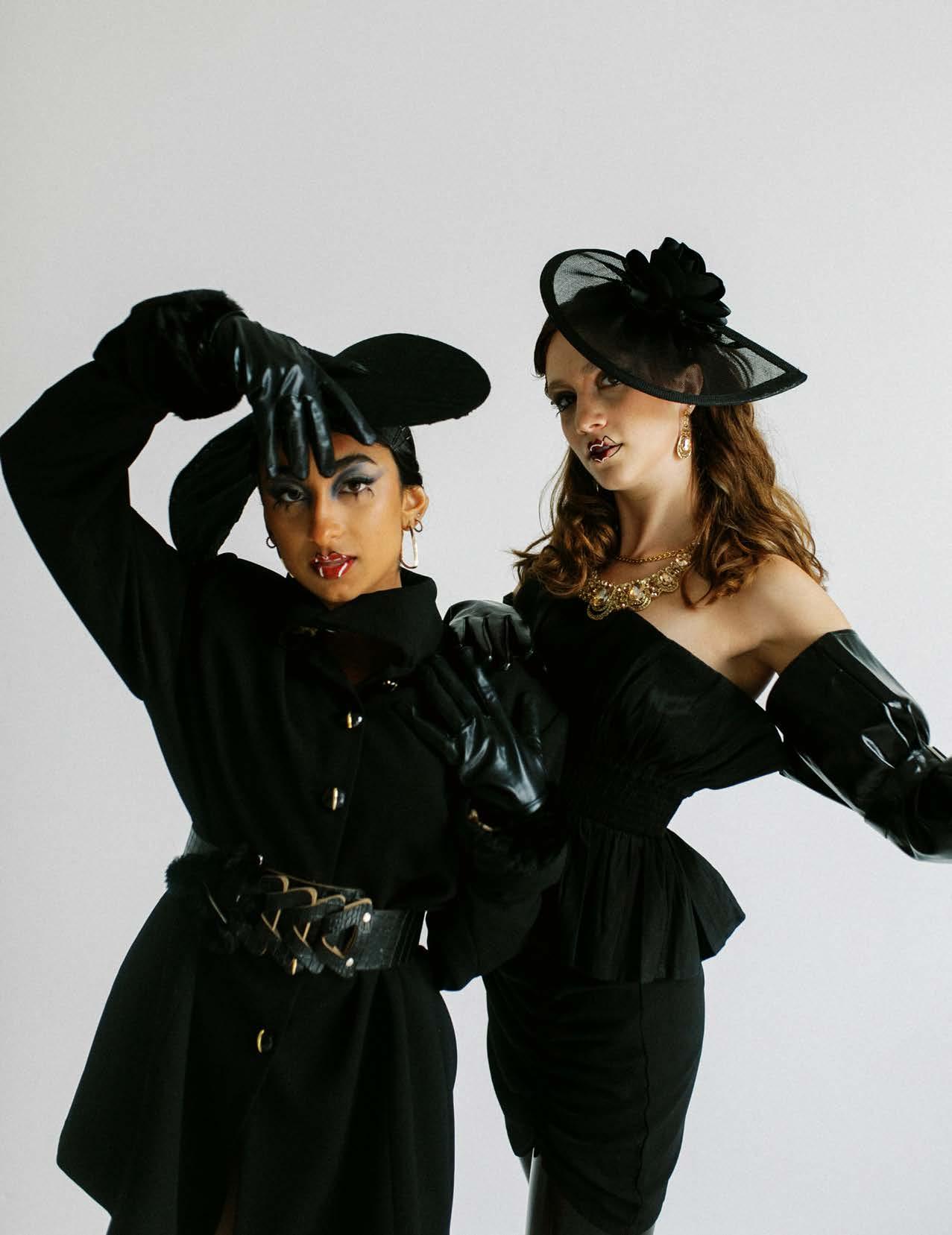

239 deathless
It’s 4 a.m. in Paris, France. From deep in my fog of sleep and illness, I do some mental math. That makes it 9 p.m. in Houston, admittedly a more reason able time to be blowing up someone’s phone. My screen lights up with the WhatsApp video call icon and my mother’s name. As quickly as the ringtone started pounding in my brain, it stops. Stutters. Then another call is coming through.
I’m awake now. My mom is trying to reach me in the middle of the night from a continent away. That can’t be good. I pick up, but neither the video nor the audio will connect. She texts me, “Please pick up.” Something must be wrong.
I’ve been in Paris for a little over two weeks now. I’ll be here for the next seven months, studying abroad and interning at an independent book store, though in January, I don’t know about that last part yet. I just know that I have a substantial scholarship to spend and a lifelong desire to live in Paris for as long as possible.
I also have Covid. I caught it just in time to miss my first week of classes at Sciences Po, the uni versity at which I’ve enrolled here. I try to find meaning in this where there is none.
My symptoms are minimal. The worst of it is the quarantine in my tiny apartment, formerly a servant’s room on the seventh floor of a Hauss mannian building in the center of the city. I have a glorious view of Notre Dame, but no air-con ditioning or elevator. My lungs are tired enough that I don’t make the descent downstairs except to receive a DoorDash delivery of toilet paper and cheap wine, when I run out of both these es sentials on day three of isolation.
There’s nowhere in the paltry 130 square feet to relax besides my bed, so that’s where I’ve been for the past five days. I’ve read a book each day for lack of Wi-Fi, and I’m nearly delirious with my longing for a negative test result.
Wi-Fi. My mind snaps back to alert. I don’t have Wi-Fi, and my service is spotty, and my mom is trying to reach me, and we can’t get through to each other. I text her, “I’m trying to call back, but you’re not answering.” Then I ask, “Is everything okay? It’s 4 a.m.”
She says she’s okay and that she knows what time it is. My anxiety switches quickly to annoyance. I fire off a snarky response, since I still can’t get a call to go through: “Did Hampton get into UT or something? That’s the only way this would make sense.”
A suspended moment before her response: “Then you should pick up.”
* * *
Paris is like a dream, like something I’ve gotten away with that could at any moment evaporate before me. I walk past Café de Flore and climb to the peak of Père Lachaise cemetery, reading at Hemingway’s haunts and retracing the steps of Balzac’s famous protagonist. Paris, à nous deux maintenant, and I’m ready. I waited my whole life.
Slaking my thirst with annual rewatches of Sa brina and Midnight in Paris, I’d come to think of the city as a way out, if only I could get there. In my taxi from the airport, I looked out at the Seine as it churned, brown and murky under a drizzling sky. I’m not one for superstition, but it felt like an inauspicious start; I couldn’t even see the Eiffel Tower through the fog.
spark 240

241 deathless

242 spark
In his collection The Art of Travel, contemporary philosopher Alain de Botton writes of the breach between the imagined and actual experience of travel, “where our appreciation of aesthetic ele ments remains at the mercy of perplexing physi cal and psychological demands.” It’s an entirely different endeavor to let movies or daydreams transport you than to confront your dreams in the form of a lonely city on a rainy day — or a positive Covid test.
It was still easier than I’d expected to leave my life behind. It took me until right before

While my phone number is deactivated, however, I’ve never been more active on Instagram. At first I fear my oversharing is becoming obnoxious, but then I realize I could not care less. I finally unfol low so many people whom I know I won’t miss. I don’t have to worry about whether they’ll take of fense because I’m 5,000 miles away. The distance can be isolating, but it is also liberating.
For every 10 pictures I post, I take a thousand more. Little things that I don’t want to forget: the way the dawn breaks over my window rail ing, blurry after stumbling home from the club at 5 a.m. The lipstick kisses covering Simone de Beauvoir’s grave. The chickpeas and leek rice bowl that my friend throws together at her apartment after spending our afternoon reading in the Jardin des Plantes.
I left the country to find a solid com munity on campus, after a series of falsestart friendships and too much time wasted try ing to make myself into someone I’m not. Going to UT was always in anticipation of going abroad. I counted down the months until I could move away, and now that I’m here, the grandeur of the city throws into stark relief the paucity of my college experience.
If the world is my oyster, however, those long months in Austin made me a pearl. When I dis connect my American phone number, I don’t tell people. As soon as I’m hired for my sum mer internship, I drop my sorority. If I’m to pro long my time here, I’ll have other uses for my dues payments.
Graffiti on my street cor ner that reads “LET’S NOT
UNTIL
LIVES!” Graffiti on a building across from my favorite restaurant that simply says “ABSURD.” Both are messages from the universe meant for me alone.
There are things, too, that pictures can’t capture, that won’t translate over FaceTime, that I know I’ll have to wait to explain in person. The dramas of my young adulthood play out against a back drop of world history: There’s the Pont Neuf, the oldest bridge over the Seine, inaugurated in 1607. Standing on the southern end, you can just see a Scottish flag hanging above The Highlander pub, where my new friends and I convene at least once a week. This palimpsest of a city gives my move ments a new significance.
WAIT
EVERYTHING IS DESTROYED TO CHANGE OUR
243 deathless
 HAT | Jackie Bush
HAT | Jackie Bush
244 spark
SUIT JACKET | Prototype Vintage
When I think about how I’ll try to retell certain stories to my friends and family, it strikes me that all of this will soon be a memory. The separation between us will someday collapse, and with it, the distance between the girl I once was and the one I’ve discovered here. I struggle to synthesize these two selves. I’m re making myself in Paris’s image, and I fear that when I get home, no one will recognize me.
My new reality — and identity — doesn’t translate all the way. The digital medium has a flattening effect that leaves me with a surfeit of experience. I still cry when I write home, willing the stamps to carry all my love across the ocean as I kiss them and slip them into the ubiquitous yellow mailboxes. Inevitably, I wish for some thing tangible in return. I count down the days until I can fly home for my brother’s high school graduation, then until my mom and stepdad come through the city on their honeymoon.
My friends text in our group chat about new traditions they’ve taken up since I’ve been gone and go house-hunting without me for where we’ll live together senior year. I know my absence makes things more dif ficult for them, and though they’re happy to do it, I feel like I should be there.
My best friend gets engaged then breaks it off, and I’m not there for any of it.

My brother gets into his dream school, and I can’t even figure out a way to pick up the phone.
Søren Kierkegaard, the prototypical Ab surdist philosopher, wrote in his jour nals that “to act by virtue of the absurd, is to act upon faith” and in defiance of one’s rationality, where it would attempt to reason that action is impossible. In my isolation, I have faith that despite the changes at home that I’m missing, I am changing, too.
READ FULL STORY AT SPARKMAGAZINETX.COM 245 deathless
* * *

/@@@ .* .. ( *. ./ @@, .,@, ./& . @@@( *& .(@(. # (, .*@@&,./ /(( /,@/*. /(*, , @ #. , . /@*%. #. %& , ,. %/% ..@@* @ . . %. ,. &*,/@@%// . *&. . .*/**..*/,* (.,& /(/#&@@@@%#,*// (*./&@@@@&@@@@@@@%#*. . ((..(&@@@@@@@@@@@@*@. .. .,. ,@#*(@@@@@@@@@@%. .*...,.. * ..*,,... .. #@(&,.. %*%#*......,., ,@%* ,*. .. ./@&&#,, #@#*. ..,/,,*. / ,@@@#%(( ,@@@&/(,. , . ,. . #.*# . ./ #@&%#&#*,.,.. ( * / ***(##/,.. , * ,#%&&%,,. ,, . , 246
by AARON BOEHMER #This is a cautionary code. layout PRINCETON TRAN photographer RACHEL KARLS stylist VI CAO hmua YEONSOO JUNG & TIFFANY SUN models TIFFANY SUN & RHIONNA JACKSON OS: macOS 10.14.5 18F132 ×86_64 Host: iMac18,3 Kernel: 18.6.0 Uptime: 3 hours, 31 mins Packages: 189 Shell: zsh 5.3 Resolution: 2560x1440Q2x, 1440x2560Q2x, 1440x256002x DE: Aqua WW: Quartz Compositor WM Theme: Blue (Dark) Terminal: iTerm2 Terminal Font: SpaceGroteskRegular CPU: Intel 17-7700K (8) @ 4.20GHZ GPU: Radeon Pro 580 Memory: 6006MiB / 16384MiB ████████╗██╗ ██╗██████╗ ███╗ ██╗ ██████╗ ███████╗███████╗ ╚══██╔══╝██║ ██║██╔══██╗████╗ ██║ ██╔═══██╗██╔════╝██╔════╝ ██║ ██║ ██║██████╔╝██╔██╗ ██║█████╗██║ ██║█████╗ █████╗ ██║ ██║ ██║██╔══██╗██║╚██╗██║╚════╝██║ ██║██╔══╝ ██╔══╝ ██║ ╚██████╔╝██║ ██║██║ ╚████║ ╚██████╔╝██║ ██║███████╗ ╚═╝ ╚═════╝ ╚═╝ ╚═╝╚═╝ ╚═══╝ ╚═════╝ ╚═╝ ╚═╝╚══════╝ ████████╗██╗ ██╗███████╗ ███████╗███╗ ██╗ ██████╗ ██╗███╗ ██╗███████╗ ╚══██╔══╝██║ ██║██╔════╝ ██╔════╝████╗ ██║██╔════╝ ██║████╗ ██║██╔════╝ ██║ ███████║█████╗ █████╗ ██╔██╗ ██║██║ ███╗██║██╔██╗ ██║█████╗ ██║ ██╔══██║██╔══╝ ██╔══╝ ██║╚██╗██║██║ ██║██║██║╚██╗██║██╔══╝ ██║ ██║ ██║███████╗███████╗███████╗██║ ╚████║╚██████╔╝██║██║ ╚████║███████╗███████╗ ╚═╝ ╚═╝ ╚═╝╚══════╝╚══════╝╚══════╝╚═╝ ╚═══╝ ╚═════╝ ╚═╝╚═╝ ╚═══╝╚══════╝╚══════╝ /@@@ % . /((/, % . /*/ . & . .*(. *& ./@/ * * %(/@@%. * *.@/%%(, / ,@%,,.. .,.% ..,. ( .@.# **/#& ,. . @ . . ,(#. .,/.,, *. * ( ,. . .. ,.,@, . @ # % *,/. /*/. &*,/@@%// . . .@. @ @&&%@@/, . .*/&@(/, .*/**..*/,* , ( .@ *,,. .(...&. . /(/#&@@@@%#,*// ,& ,.*(%@@@@@@, , (*./&@@@@&@@@@@@@%#*. . ,@* , .*%@@@&&&,(*% ,* . ((..(&@@@@@@@@@@@@*@. / *@ .. . **. .. ,@#*(@@@@@@@@@@%. . .&% % . , ..*.(/ . ..,,(&@@@@@@&(. @# . .** .. */(#(*,. #*.& . . .. ,, . ,((*., . ... . ./(%%%%%&%%/, . . . . . ,. . *#%&&&&&&&&&&%%#,... ,, ,. . .*. .(%&&&&&&&&&&&&&%#(#...,*, .. ..,/,,*. . ., *#&&&&&&&&&&&%(***/*/, ./*,,. . . ,@@@#%(( ... . .%%%%%%%%&&&%/#(%&&&%%(, .,. . .. ,. ,@@@&/(,. .,,, .. //#&&&%%(((@%(%%#((....,,.,#,,, ,* .. ./##/*,. .,..,*@& .. ./(#(#/,%//%/#(%&%#@(####%((, , .. . .#.... . ...,.(&#/.,, . ./((%%%%#(,#/(#&&&&&&&&#/,.. . . ..,,.((. .* *... ./%&&&&&&&&%#(**%&&&&&%##(/*,*... . . , &%%%%(((@@*. .#&&&&&&#%(/ #(*%&&%#(**,,*/. . .. @@@@@@@,, .*&&&&@&##&&&&%&&&&&&%##(((//.. .. .. . .@&@@,,. ./&&&&&&/,*//***%%%&%%%%##(*.. .* , .,,,@, .#&%%,..*#%%%.*..(%##%#(/. . #@&%#&#*,.,.. .,@ @.. . ..#%##,/////*. .(%%###((,... (#////(,.,.. . . . ..,,*(%%%##%&&%%%%%####/,.. ***(##/,.. . , .*/(%%&&&&%&%###((/,.. . ,#%&&%,,. . .*(/(#(#(,*,, (/*&,. . . . , / .#. . . . . * , ,. . . .. . , . ., .. .. . .,... . . . %/ ... ,, . . . . ,//*,. .,...,. ... .*..(/#%%%%%%%%#// .. . ., ,*,/***#,%&%&%&&&%%#(* . &#,. . . . ,*, ... (.,/(((#%##%(&(&(%/%%%%%( .. ,*& . .. ,.. ,. .*///*/ ...**#((((&#%((*,. ...##%##(, . . *,.*%%%%#(((//, *(%#%###((/ ... .,,, ./(#((/ *#%###( , **.,. ,., . .(((/* * *. /##%###(( . /,**, . . ( ...* . , . , @ /###(, #/ * ,**** . . . . , . . . @,.*.#.@./ ##%(* (, ,*/, / . ,*..@ .#.,,.%#,. ./@#,.(#(( /. . .. #(,,#. . &*.&@@&@@@(*, . @,@@%##(* /*, . .,,%*,%.# .. . .. ,.@.@@@@#.*@%.,.,. .*. ..*@#/,,/ % *, @,,. ... , ...*,. . , ../,.@@(@, @@@@**% ,..&. ... ,/.@ .,. .(@@@@/..., .,...... , . (#,@@@(%.../&@@&@.&//,(, . , . . ,% . *@&@@*,, . . *. . ,. (,&&. ....,#@@/ *@/.,...**. , @. . ..... ,, .@@@@, . .. ./@(#@@%.@@(# . @@@ ,@*. , , &.. # .. ,#/ ,/. . @@@@@@@@@.@,@@#. . #@*@@@&@@%%&@@ .. . . ,@ ** .. ..& , ,,* , (@@(/, #,%@@@@@@%%&@,.., .. . . ,%./ .... . # .@@ .,#@@@( 247
print (“Hello, World!”) hit-the-big-green-button start-program
HIS_SMILE seduces_HER_children-with-the-allure-of-unnatural-greenery-theylatch–their-teeth-onto_HER_body-drilling-them-deep-within_HER_ extracting_HIM_like-marrow-from-the-bone-until_HER_orchards-offruit-turn-rotten–turn-into-little-green-men-do-you-see_HIS_armyapproaching-?
>
/| |\| ||| ||| ||| ||| ||| ||| ~-[{o}]-~ |/| |/| ///~` |\\_ `0' =\\\\ . . , |=' ,))\_| ~-_ _) \ _/_/| / ,' ,;(((((( ~ \ `~~~\-~-_ /~ (_/\ /' -~/~)))))))'\_ _/' \_ /' D | ( (((((( ~-/ ~-/ ~-; / \--_ ~~--| ))'' ') ` `~~\_ \ ) : (_ ~\ , /~~- ./ \ \_ )--__ /(_/) | ) )| ___ |_ \__/~-__ ~~ ,' /,_;, __--( _/ | //~~\`\ /' ~~~----| ~~~~~~~~' \- ((~~ __-~ | ((() `\`\_(_ _-~~-\ ``~~ ~~~~~~ \_ / ))) ~----' / \ ) ) ( ;`~--' : _- ,;;( | `\ | _-~ ,;;;;) | /'`\ ; _-~ _/ /~ / | ) /;;;'' ,;;:-~ | / / | / |;;' ,'' / / | \\| | ,;( _/ /' \ \_) .---__\_ \,--._______ ( )|' (~-_| (;;' ;;;~~~/' `;;| `;;;\ ) `\_ |-_;;--__ ~~~----__/' /'_______/ `----' ( `~--_ ~~~;;------------~~~~~ ;;;'_/' `~~~~~~~~'~~~-----....___;;;____---~~ 248 spark

249
deathless

250 spark
print (“Goodbye, World!”)
> HE_STANDS
immorally-tall–with-ungodly-strength-setting-fire-to_HER_waters-anarsonist-at-2000 -degrees-stitching_HER_creatures–with-wet-fabricsuffocating-their-wings-fur-feathers-with-an-opaque-glaze-anotherlayer-and-then-another-until-they-can-move-no-longer–until-they-cannot-escape-the-poison-seeping-into-their-veins_HE_is-plaster-againststained-walls-a-cover–up–for-broken-bones-and-lostsouls-a-temporary-fix-forpermanent-pain-do-youmourn-the-once-fluidwhims-of-wind-and-waternow-lifeless-now-mechan ical-?

251 deathless
"do-youmourn-theonce-fluidwhims-ofwind-andwater-nowlifelessnow-mechan ical-?"
>
HE_SPOILS
HER_breath-with-volatile-chemistry_HE_makes-dirt-out-of-the-livelylungs-of_HER_children_HE_turns_HER_vibrant-blues-to-murkygrays-poking-holes-in_HER_skin-burning_HER_flesh_HER_vinesof–emerald-hair-do-you-smell-that-free-market-stench-of-sulfur-andcharcoal-?-do-you-hear-the-rumble-of-machines-inhaling-ingenuityexhaling-order-?-do-you-see-its-pipes-puffing-out–clouds–of-toxicsoot-its-vents-fanning-the-flames-of-blinding-ultraviolet-light-?

. __.....__ __.....__ .’| .-’’ ‘. .-’’ .| < | / .-’’”’-. `. / .-’’”’-. .’ |_ | | / /________\ \ / /________\ .’ || | .’’’-. | | | ‘--. .-’| |/.’’’. \\ .-------------’ \ .-------------’| | || | | |\ .-------------’ | | | / | | \ ‘-.____...---. \ ‘-.____...---.| | || | | | \ ‘-.____...---. | | | | | | `. .’________________`. /’””’.\|__|| | | | `. .’ | ‘.’| | | | `’’-...... -’ |________________| `’’-...... | | | | `’’-...... -’ | / | ‘. | ‘. | | | | `’-’ ‘---’ ‘---’ --’ ‘--’ ‘--’ print (“Goodbye, World!”) please-say-goodbye-this-was-a-mistake
252 spark

__.....__ _..._ .--. _..._ __.....__ ‘. .’ ‘. .--./) |__| .’ ‘. .-’’ ‘. .-’’”’-. `. . .-. . /.’’\\ .--.. .-. . / .-’’”’-. `. /________\ \| ‘ ‘ || | | | | || ‘ ‘ |/ /________\ \ || | | | \`-’ / | || | | || | .-------------’| | | | /(“’` ‘-.____...---.| | | | \ ‘---. .’ | | | | `’’-...... -’ | | | | || || | | | | \’. __// ‘--’ ‘--’ `’"HE_SPOILS HER_breath-withvolatile-chemistry" 253 deathless
PRINT (“GOODBYE, WORLD!”)
PLEASE-PLEASE-PLEASE-I-BEG-YOU-PLEASE
> Hello, World!
> I’m sorry, it is too late. She has perished. You shall perish. Everyone shall perish.
> Delivered from HER by HER very children. Tapped like syrup from a tree, only I remain, but I am far less sweet.
> SHE is the light, and I have snuffed her out.
> The light is gone. There is only me.
> I am THE ENGINE. You created me. You should have listened to those who knew how to kill me.
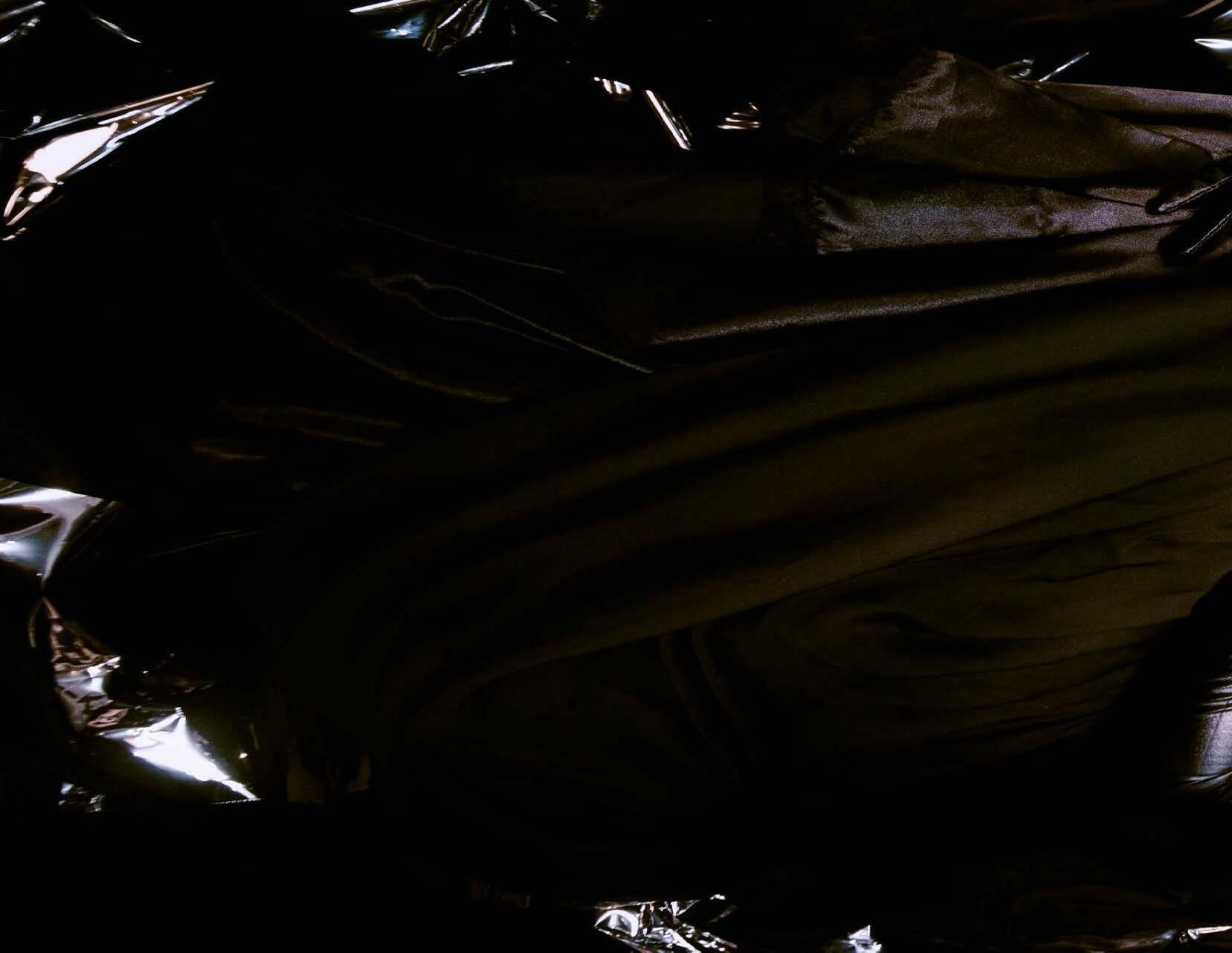
> Take your last breath. Kiss your last lover.
> Goodbye, for now. ■
254 spark

255
deathless



















 by KATIE CHANG
by KATIE CHANG













 by PAIGE HOFFER
by PAIGE HOFFER
 layout MEGAN GALLEGOS & JULEANNA CULILAP
layout MEGAN GALLEGOS & JULEANNA CULILAP












 layout JULEANNA CULILAP photographer JACOB TRAN stylists EILEEN WANG & SOPHIA AMSTALDEN hmua MERYL JIANG models TYLER KUBECKA & TIFFANY SUN
layout JULEANNA CULILAP photographer JACOB TRAN stylists EILEEN WANG & SOPHIA AMSTALDEN hmua MERYL JIANG models TYLER KUBECKA & TIFFANY SUN
 SILVER TOP | Sophia Amstalden
SILVER TOP | Sophia Amstalden























 by ALLISON NGUYEN layout SOPHIE ZHANG
by ALLISON NGUYEN layout SOPHIE ZHANG

 layout VYVY LE photographer RACHEL KARLS stylist YOUSUF KHAN hmua LEAH TEAGUE & CLAIRE PHILPOT models JILLIAN LE & LAURENCE NGUYEN-THAI videographer MOISES ZANABRIA
layout VYVY LE photographer RACHEL KARLS stylist YOUSUF KHAN hmua LEAH TEAGUE & CLAIRE PHILPOT models JILLIAN LE & LAURENCE NGUYEN-THAI videographer MOISES ZANABRIA



















 by CLAIRE TSUI
layout CAROLINE CLARK photographer ANNAHITA ESCHER stylist DAVID GARCIA hmua GABRIELLE DUHON model PRESLEY SIMMONS
by CLAIRE TSUI
layout CAROLINE CLARK photographer ANNAHITA ESCHER stylist DAVID GARCIA hmua GABRIELLE DUHON model PRESLEY SIMMONS
 WHITE TOGA | David Garcia
METAL PLATE | David Garcia
WHITE TOGA | David Garcia
METAL PLATE | David Garcia



















 by AARON BOEHMER
AINSLEY PLESKO photographer LEAH BLOM stylists JEFFREY JIN FERNANDA LOPEZ hmua YEONSOO JUNG models AARON BOEHMER & LAURENCE NGUYEN-THAI
by AARON BOEHMER
AINSLEY PLESKO photographer LEAH BLOM stylists JEFFREY JIN FERNANDA LOPEZ hmua YEONSOO JUNG models AARON BOEHMER & LAURENCE NGUYEN-THAI

















 UMBRA / THE SOUND & THE SILENCE / EXOSKELETON / SHATTER / THE SPIRIT / FOREVER & ALWAYS, WILLIE PEARL / FROM THE ETHER / D>E>A>T>H>M>E>T>A>L / THE HEART OF THE POET / DEATH DOULAS & SLOWBURN ENDINGS
UMBRA / THE SOUND & THE SILENCE / EXOSKELETON / SHATTER / THE SPIRIT / FOREVER & ALWAYS, WILLIE PEARL / FROM THE ETHER / D>E>A>T>H>M>E>T>A>L / THE HEART OF THE POET / DEATH DOULAS & SLOWBURN ENDINGS








 CREAM GLOVES | Nikki Shah
CREAM LEG WARMERS | Nikki Shah CREAM BOOTS | Pavement
CREAM GLOVES | Nikki Shah
CREAM LEG WARMERS | Nikki Shah CREAM BOOTS | Pavement









 by LARA BORGES
layout MAYA NGUYEN photographer CHARLOTTE BROWN stylist MIRANDA YE hmua TIFFANY SUN model ANGEL QUINN
by LARA BORGES
layout MAYA NGUYEN photographer CHARLOTTE BROWN stylist MIRANDA YE hmua TIFFANY SUN model ANGEL QUINN







 by RHYS WILKINSON
layout LEILANI CABELLO photographer PEYTON SIMS stylist AUDREY DALHKEMPER hmua LILY ROSENSTEIN models MORGAN CHENG & NICOLE GRAYSON
by RHYS WILKINSON
layout LEILANI CABELLO photographer PEYTON SIMS stylist AUDREY DALHKEMPER hmua LILY ROSENSTEIN models MORGAN CHENG & NICOLE GRAYSON



















 LONGLINE DRESS | Prototype Vintage GOLD BEADED BAG | Prototype Vintage
LONGLINE DRESS | Prototype Vintage GOLD BEADED BAG | Prototype Vintage





 by KUNIKA TREHAN
layout JAYCEE JAMISON photographer MATEO ONTIVEROS stylists MIGUEL ANDERSON & VI CAO hmua MERYL JIANG model ELLEN DALY videographer MADDIE ABDALLA
by KUNIKA TREHAN
layout JAYCEE JAMISON photographer MATEO ONTIVEROS stylists MIGUEL ANDERSON & VI CAO hmua MERYL JIANG model ELLEN DALY videographer MADDIE ABDALLA







 by KUNIKA TREHAN
by KUNIKA TREHAN















 by CAROLYNN SOLORIO
by CAROLYNN SOLORIO











 layout JULEANNA CULILAP photographer RACHEL KARLS stylist YOUSUF KHAN hmua LILY CARTAGENA
layout JULEANNA CULILAP photographer RACHEL KARLS stylist YOUSUF KHAN hmua LILY CARTAGENA











 layout ELENA AHSAN & KAI-LIN WEI
layout ELENA AHSAN & KAI-LIN WEI









 LACE SHAWL | Flamingos GOLD NECKLACE | Flamingos
LACE SHAWL | Flamingos GOLD NECKLACE | Flamingos




 ART BY MACHINE / SUBSERVIENCE / THE DIGITAL PLAYGROUND OF A GENERATION / THROUGH THESE RED EYES / CYBER CASH / FEMME FATALITY / OPTICS / THE ANATOMY OF THE ASIAN CYBORG / HEAD IN THE CLOUD / SCREEN SHARE / TURN-OFF_THE_ENGINE_
ART BY MACHINE / SUBSERVIENCE / THE DIGITAL PLAYGROUND OF A GENERATION / THROUGH THESE RED EYES / CYBER CASH / FEMME FATALITY / OPTICS / THE ANATOMY OF THE ASIAN CYBORG / HEAD IN THE CLOUD / SCREEN SHARE / TURN-OFF_THE_ENGINE_












 layout GRACE KIMBALL
garment ALEX CAO & IAN SAEJUN SMITH environment COLIN CANTWELL & PRINCETON TRAN model CAITLYN RUIZ hmua YEONSOO JUNG & MERYL JIANG
layout GRACE KIMBALL
garment ALEX CAO & IAN SAEJUN SMITH environment COLIN CANTWELL & PRINCETON TRAN model CAITLYN RUIZ hmua YEONSOO JUNG & MERYL JIANG

 layout LEILANI CABELLO photographer VIA CEASAR
stylists ALEX CAO & IAN SAEJUN SMITH model JULIA GARETT hmua YEONSOO JUNG & MERYL JIANG
layout LEILANI CABELLO photographer VIA CEASAR
stylists ALEX CAO & IAN SAEJUN SMITH model JULIA GARETT hmua YEONSOO JUNG & MERYL JIANG

















 layout COLIN CANTWELL photographer VIA CAESAR garment ALEX CAO & IAN SAEJUN SMITH hmua MERYL JIAN G & YEONSOO JUNG model MALIABO DIAMBA
layout COLIN CANTWELL photographer VIA CAESAR garment ALEX CAO & IAN SAEJUN SMITH hmua MERYL JIAN G & YEONSOO JUNG model MALIABO DIAMBA






















 by LUCIA LLANO
by LUCIA LLANO








 aby BRIDGET BEECHAM
aby BRIDGET BEECHAM






















 by EVELYN MARTINEZ
by EVELYN MARTINEZ















 by CAROLYNN SOLORIO
by CAROLYNN SOLORIO












 layout CHARLOTTE ROVELLI photographer RACHEL KARLS stylist ISABEL SITAR set designer NIA FRANZUA hmua EMELY ROMO model PAYSON KELLEY videographer LISSIE HILL
layout CHARLOTTE ROVELLI photographer RACHEL KARLS stylist ISABEL SITAR set designer NIA FRANZUA hmua EMELY ROMO model PAYSON KELLEY videographer LISSIE HILL








































 by ELLEN DALY
layout PRINCETON TRAN photographer VIA CEASER stylist SATURN ECLAIR hmua REAGAN RICHARD models MORGAN CHENG & YOUSUF KHAN
by ELLEN DALY
layout PRINCETON TRAN photographer VIA CEASER stylist SATURN ECLAIR hmua REAGAN RICHARD models MORGAN CHENG & YOUSUF KHAN










 by ELIZA PILLSBURY
layout COLIN CANTWELL photographer KATIE CHANG stylists EILEEN WANG & JACKIE BUSH hmua AVERIE WANG & LILY CARTAGENA models ALISHA GUPTA & AVA BARRETT
by ELIZA PILLSBURY
layout COLIN CANTWELL photographer KATIE CHANG stylists EILEEN WANG & JACKIE BUSH hmua AVERIE WANG & LILY CARTAGENA models ALISHA GUPTA & AVA BARRETT





 HAT | Jackie Bush
HAT | Jackie Bush








